100 Figures Who Shaped the NFL’s First Century

You could easily fill out a list of 100 influential people in football’s history just with great players, coaches, owners and commissioners. But the NFL’s story ranges beyond the field and the front office, and pro football has been shaped not just by the stars who rule the record book, the X’s and O’s experts who cooked up its strategies, or the power brokers who turned it into the most dominant sport in America. There are also unorthodox, sometimes unfamiliar personalities who injected color into the game, rogues who worked outside the rules and brought disrepute, and figures from related fields—media, medicine, money—who profoundly transformed pro football, and our experience of it. This list is not meant to be definitive, and you could compose another, with a whole host of new names, that would be valid and compelling. Omissions should not be considered slights. Rather this is meant as a mosaic, a picture with 100 pieces from which, when they’re fit together, an image of the NFL at the century mark emerges.
Capsules by Ben Baskin, Andy Benoit, Mitch Goldich, Jonathan Jones, Kalyn Kahler, Robert Klemko, Mark Mravic, Conor Orr and Jenny Vrentas.
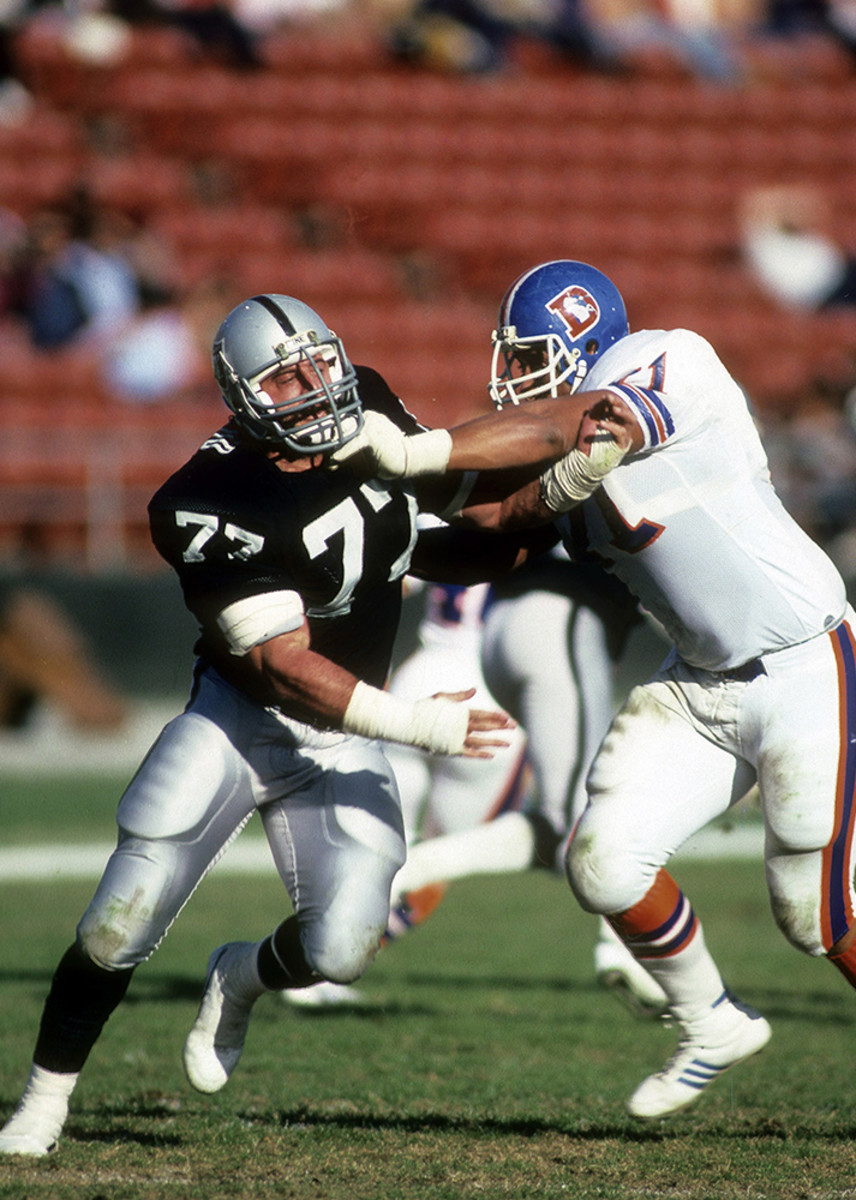
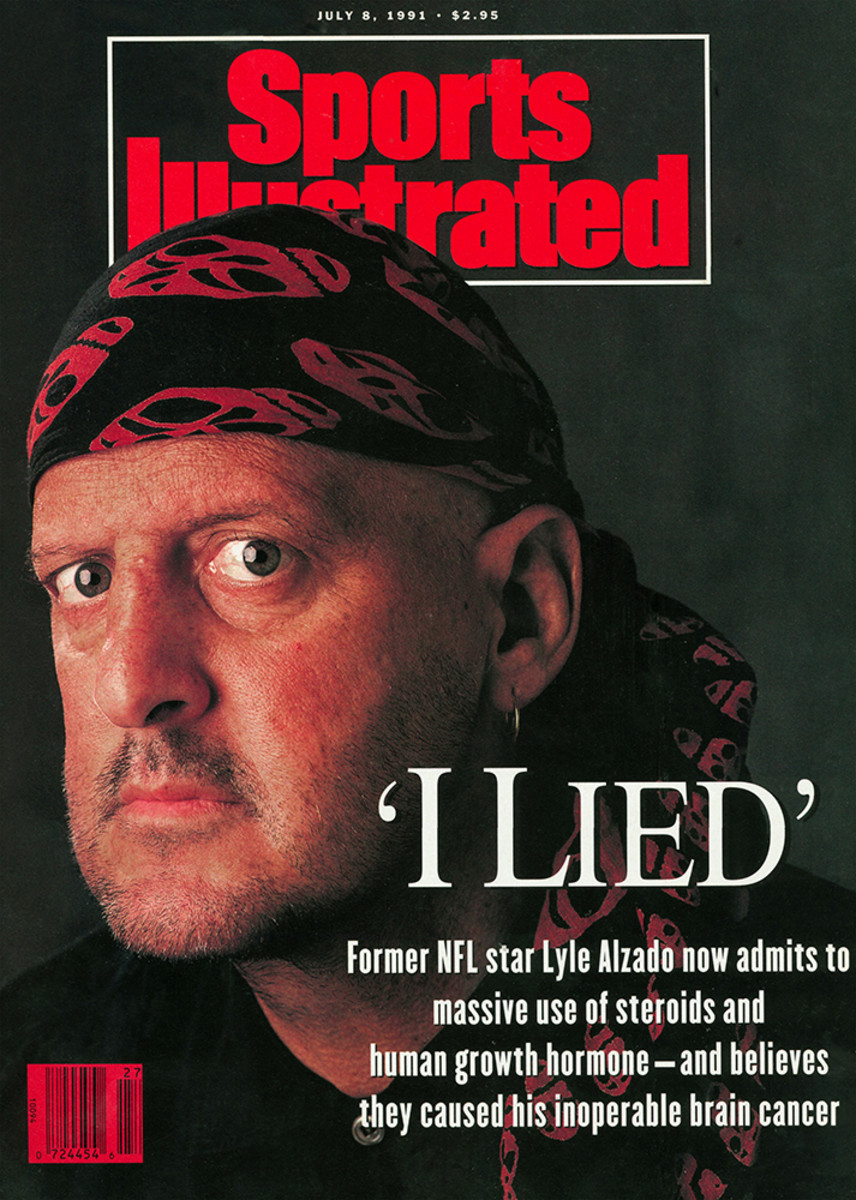
Lyle Alzado
Defensive wild man who admitted to PED use and blamed it for the brain cancer that killed him
Lyle Alzado terrorized opposing quarterbacks during his 15 seasons (1971-85) with the Broncos, Browns and Raiders. The defensive end was not only one of the most feared players in the league—a two-time All-Pro and AFC Defensive Player of the Year in ’77—but he was also one of the fiercest and most violent, prone to random outbursts of anger. In one famous incident, Alzado ripped the helmet off an opposing lineman and rifled it at him. The play caused the NFL to adopt the so-called “Alzado Rule,” where the removal of an opposing player’s headgear would result in an ejection and possible fine.
With a rippling 255-pound physique, Alzado was also the paragon of fitness in the league. But after retiring and being diagnosed with brain cancer in April 1991, he admitted he had taken anabolic steroids from 1969, when he was in school at the now-defunct Yankton College, all the way through his failed NFL comeback attempt in 1990. As he underwent chemotherapy, Alzado became an outspoken advocate warning of the dangers of steroids, believing that the drugs caused his disease, although there was no proof this was true.
As a Raider, Alzado was a Los Angeles celebrity, the perfect match of player personality and fan base, as he helped lead the team to a Super Bowl win in the 1983 season. But his tenacity on the field was not natural; Alzado once estimated that he spent as much as $30,000 a year on steroids. And with his series of well-publicized physical altercations after retirement—once accused of brandishing a gun after a road-rage dispute, another time accused of attacking a female deputy marshal who tried to serve him papers—as well as his cancer diagnosis and outspoken nature, Alzado brought increased attention to the potential harms of steroid use.
A few months before Alzado died at age 43 he said: “If what I've become doesn't scare you off steroids, nothing will.”

Dr. James Andrews
Orthopedist who revolutionized joint surgery, saving countless athletic careers
During the Wild West days of athlete injury and recovery, Dr. James Andrews broke through to establish himself as the world’s most prominent surgeon for high-end performers. With a client list ranging from Roger Clemens to Adrian Peterson, Andrews’ steady hands have been the guiding force in some of the most prominent surgeries in modern sports history.
Especially in the NFL world, where a torn ACL was once a career-ender but is now understood to be a year-long recovery, Andrews is known as an industry leader. Doug Williams, Bruce Smith, Donovan McNabb, Sam Bradford, Dalvin Cook—all took their serious knee issues to Andrews. Peterson might have been Andrews’ most remarkable patient. The Vikings All-Pro blew out his knee on Christmas Eve 2011 and had surgery six days later. The following year he came within eight yards of the single-season rushing record.
In 2013 The MMQB’s Jenny Vrentas wrote a first-hand account of Andrews as he operated on the knee of former Giants safety Stevie Brown. The details of the operation, which involves a drill and gallons of saline solution, shed light on how routine Andrews has made a complex procedure seem. Quite simply: He is the man who can put athletes back on the field sooner. And while he refused to take credit for the turnarounds of many football, basketball and baseball players (as well as golfers, and professional wrestlers such Shawn Michaels, C.M. Punk and Rey Mysterio), there is no doubt a vast gulf between the way we see these injuries now and the way that they were viewed just a few decades ago.
It’s nearly unfathomable to think about the advances that joint surgery and subsequent recovery have taken over the years. Career-ending knee and shoulder injuries used to be all too commonplace across sports, robbing football of some of its greatest names in their athletic prime. Andrews has been at the forefront of giving players a second life in a sport that often seems hellbent on showing them an early exit.
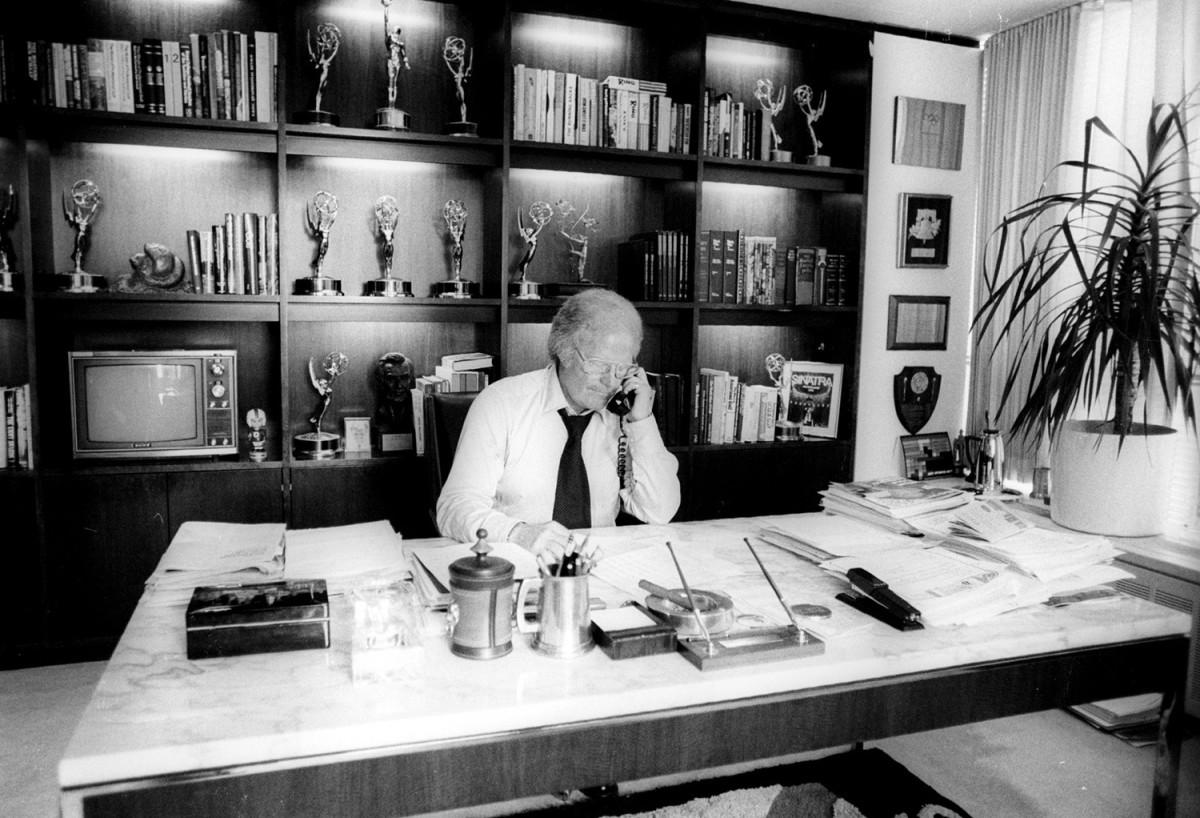
Roone Arledge
Creator of Monday Night Football
The NFL wouldn’t be where it is today without a few visionaries on the television side. Consider Roone Arledge, a long-time ABC executive, one of them.
As the inventor of or creative force behind tentpole programs such as the foundational and long-running Wide World of Sports, Arledge was a legend at ABC and ABC Sports. News coverage, campaign coverage and breaking news all bore his fingerprints, evident by the dozens of Emmy awards he pocketed, the auditorium named after him at Columbia’s prestigious school of journalism, and the recognition he received from the Pro Football Hall of Fame.
While Arledge’s most exceptional work might have been the coverage of the terrorist kidnappings and murders at the Munich Olympics, which, according to his obituary, changed forever the expectations of the modern television viewer, who had been accustomed to hanging by for the nightly news, the creation of Monday Night Football was seminal in raising the image of the NFL in the American consciousness. From there came Howard Cosell and Don Meredith, and the idea that a weekly matchup could be the all-consuming campfire that a collective country might settle around, not unlike a favorite sitcom or news program. (Gamblers loved it, too, as a last chance to get even for the week.)
While the sport’s popularity and MNF itself has ebbed and flowed throughout the years, with divergences down the road including comedian Dennis Miller and sports columnist Tony Kornheiser, Monday Night Football remains a league standard; a rite of passage for any first-time head coach or player cementing his status under the league’s brightest lights.
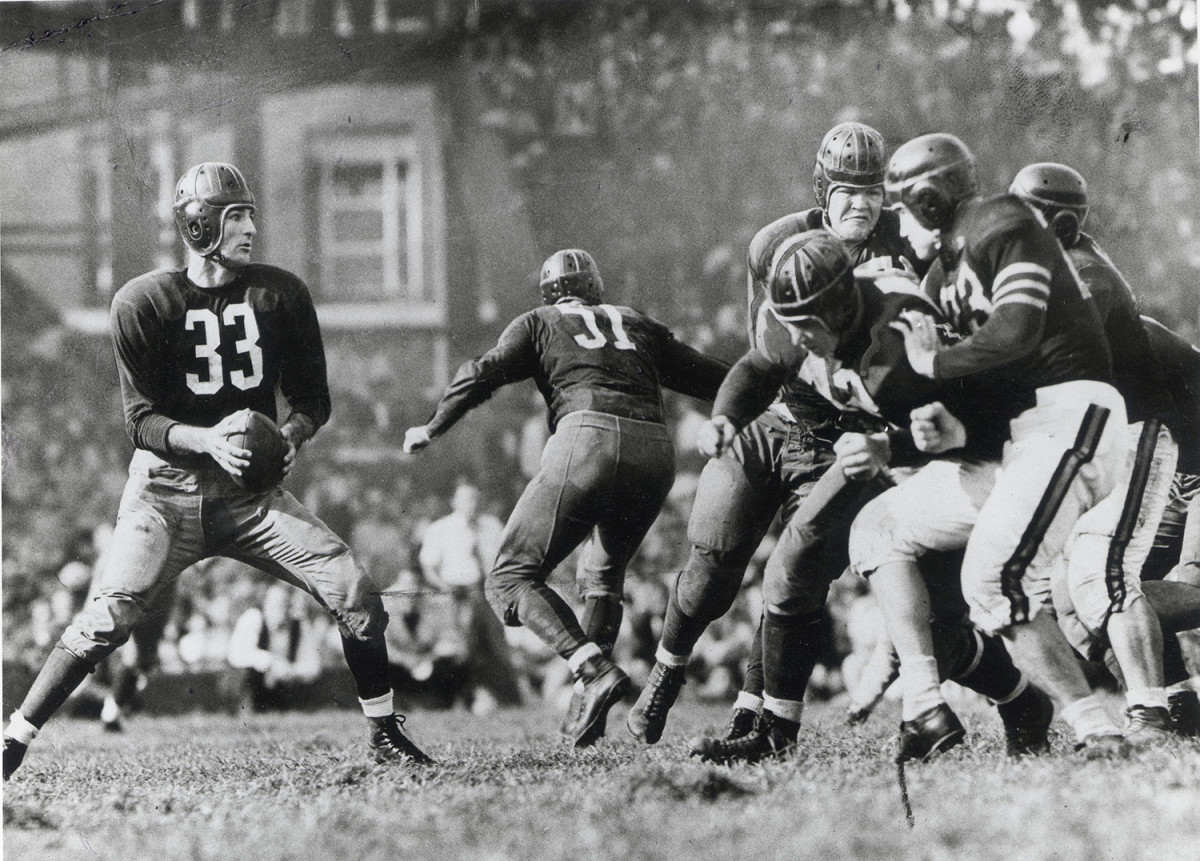
Sammy Baugh
Biggest star of the ’30s and ’40s
Before the days of Peyton Manning and his milquetoast insurance ads, there was football’s true dual threat—or in the case of Sammy Baugh, quadruple threat.
Baugh could act, as he did in starring as Tom King in King of the Texas Rangers, but he could also play safety. And punt. And, most notably, reinvent the game as a downfield-slinging quarterback.
No quarterback has more seasons leading the league in passing (Baugh is tied with Steve Young for that honor). No quarterback has more years with the league’s lowest interception percentage. Baugh’s rambling style was the model for quarterbacks who would come to change the face of the game decades later, with their ability both to move the pocket and to torture defenses by elongating the play. A three-sport star at TCU (football, baseball, basketball), Baugh initially sought a career in baseball before getting drafted by the Redskins, leading the team to a championship in his first season.
A lifelong signal-caller in Washington, Baugh elevated the game at a time when the actual football was puffier and harder to throw. That didn’t stop him from loading up on touchdown passes while the rest of the league was still coughing up dust, leaning on the strength of the run. Patriots coach Bill Belichick compared Baugh to both Tom Brady and Ed Reed, for his ability to move the ball on one side of the field, then stop it on the other. He finished his career with 31 interceptions for 491 return yards, along with 187 passing touchdowns and nine rushing TDs.

Odell Beckham Jr.
Quintessential player of the social media age
Odell Beckham Jr. catapulted to fame as a rookie when he made a one-handed catch while falling backwards on Sunday Night Football in 2014. That catch launched Beckham into a stratosphere of crossover digital-age fame that previously only NBA players had really reached. The LSU product has a huge presence on social media, and has influenced young NFL fans with his signature hairstyle, unique fashion sense and outsized personality.
Beckham’s brand centers around his refusal to conform to the league’s expectations that players will fall in line, not be distractions and not speak out about their team. He set off a firestorm of news and social media reactions when he discussed the Giants quarterback situation and his thoughts on his team in a taped interview on ESPN during the 2018 season. Beckham doesn’t hide his emotions, and his uninhibited reactions are the reason he’s a bigger social media presence than any NFL player before him. His appeal, however, transcends the NFL, and he’s as likely to turn up at runway shows and or a fashion shoot as he is to spark the latest hot-button issue on TV shout-fests. Beckham has been suspended for fighting with rival cornerback Josh Norman, he’s taken out his in-game frustrations on a kicking net, he’s wept, he’s been fined for celebrating a touchdown by mimicking a dog urinating, and his trade from the Giants to the Browns in the 2019 offseason will test whether a move from New York to Cleveland might actually make an athlete a bigger national star; if anyone can pull it off, it’s OBJ. Beckham has become the quintessential sports personality of the social media age, an athlete a younger generation of fans can relate to.
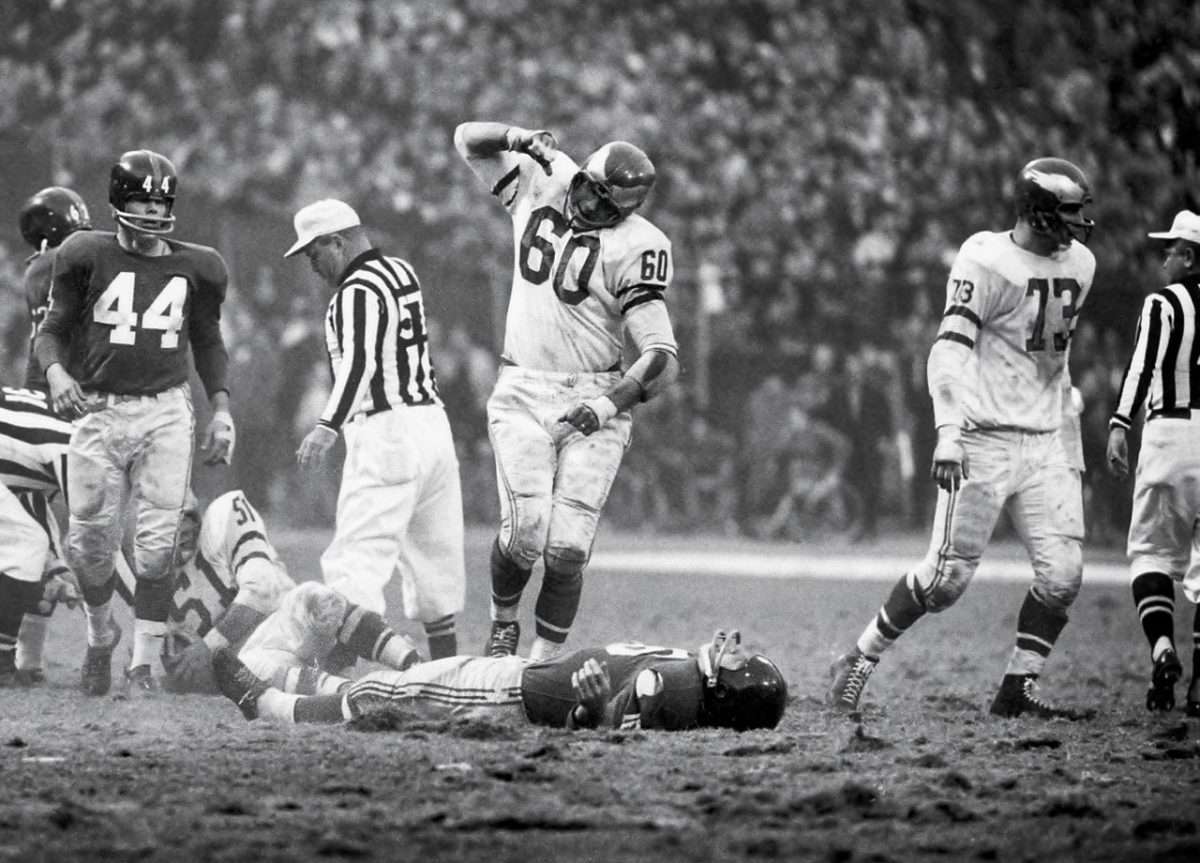
Chuck Bednarik
Last of the great two-way players; central figure in an iconic NFL photo
Chuck Bednarik is described on his Hall of Fame plaque like so: “Rugged, durable, bulldozing blocker, bone-jarring tackler.” For the man known as Concrete Charlie, perhaps one of the most apt nicknames in sports history, it is a description that harks back to a bygone era in the NFL, when Bednarik the linebacker roamed the middle of the field looking to deliver crushing blows on opposing offensive players, and Bednarik the center battled in the trenches, looking to deliver crushing blocks on opposing defensive players. In the offseason, the NFL’s last great 60-Minute Man would, fittingly, sell concrete.
Bednarik was a six-time first team All-Pro and a two-time NFL champion and, despite being better known for his ferocious play as a defender, was voted as the NFL’s all-time best center in 1969. While others, such as cornerback/receiver Deion Sanders, would play on both sides of the ball after Bednarik, none would do so at such physically demanding positions as the longtime Eagles great. When fans bemoan the (somewhat) safer game we see today, it is the halcyon era of Bednarik and his brand of brutal, old-school, smash-mouth football they’re pining for.
Nothing epitomized that era better than John G. Zimmerman’s 1960 Sports Illustrated photograph of Bednarik standing over the motionless body of Giants running back Frank Gifford. It was the closing minutes of a November game at Yankee Stadium, with Philadelphia and New York battling atop the Eastern Conference. After Gifford caught a pass from quarterback George Shaw, there was Bednarik to deliver one of those patented bone-jarring tackles; the ensuing damage knocked Gifford unconscious, caused a “deep brain concussion” (in a time when concussion was a somewhat foreign word), sent the running back to the hospital for several days and out of the NFL for nearly two years. While Bednarik long maintained he was not celebrating the hit and Gifford never blamed him for the injuries, the image of the linebacker looming over the motionless body, fist pumped in celebration, entered into NFL lore.
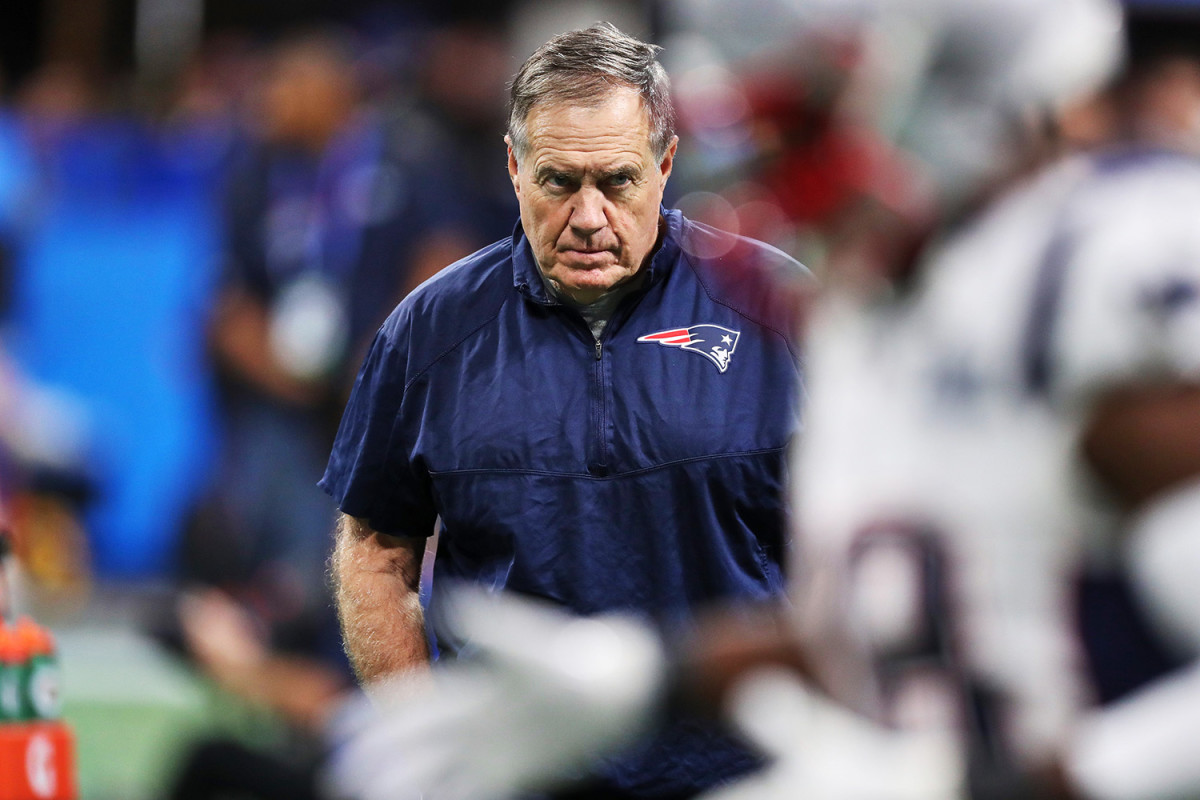
Bill Belichick
Mastermind of a two-decade dynasty in New England
Bill Belichick will go down as the greatest coach in NFL history, and think of all the presumption that quashes. He was never the hot young coach. In fact, he was the antithesis of an exciting hire in New England: a 47-year-old retread coach with a career record of 36-44. He wasn’t known for a revolutionary trademark scheme. He wasn’t a particularly charismatic public orator. He was often gruff with the media. He showed little to no dramatic leadership flair. In central casting, Belichick would sooner be pegged a tax attorney than an NFL head coach.
And yet, if Bill Belichick were to retire tomorrow, his six Super Bowl titles as a head coach and eight total as an NFL coach would both be records. So would his 10 consecutive division titles. And nine conference titles. And 13 conference championship game appearances. And so on and so on.
Belichick’s successes emphasize something about pro football that is understood, but not fully appreciated: It is the ultimate sport of strategy and scheme. You might hear a really well-schemed football game likened to a chess match. But in football, the piece all move simultaneously, not one at a time. The movements are not constricted to individual squares and, most importantly, not everyone’s pieces are the same. Imagine chess if one player’s bishop were different from another’s. Or if one player had a pawn that, if used in certain ways, could be more powerful than a rook.
This is what football coaches think about, and none better than Belichick. He is a master at identifying and leveraging individual players and their attributes. Which is why his Patriots teams have never had one clear identity. Belichick finds smart, uniquely gifted players and shapes his scheme around them—and for their opponent—each week. Some of his Patriots teams have evolved more in a month than most NFL teams do in a year.
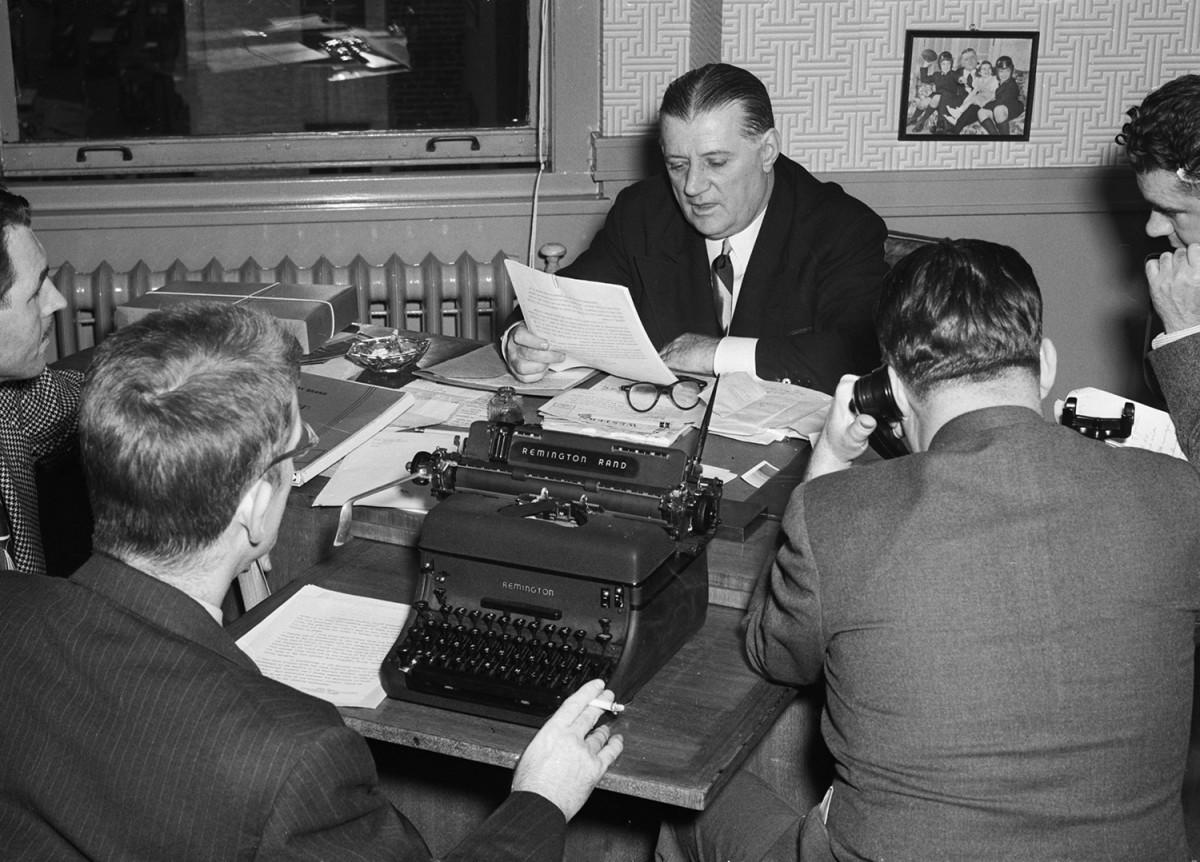
Bert Bell
Post-war commissioner who pulled the league from obscurity
Bert Bell, who saved a fledgling league from devouring itself, was a football lifer. A quarterback, a soldier, an owner and finally a decision-maker, Bell did everything from selling tickets to pumping up footballs; a reminder of when the game was controlled by the pure of heart, with their only interest in increasing its visibility and viability.
Over several conversations with his son, Upton, a few years back, we learned that Bell not only empowered the NFLPA and began tailoring a television schedule to culminate with big games at the end of the season, but he was an early champion of the draft. Fearing that the league would eventually become a few deep-pocketed super-teams, Bell told colleagues “I still worry about all the have-nots.” His legacy includes anti-gambling rules and sudden-death overtime, both essential to the integrity and watchability of the sport in his era and beyond, not to mention the merger of the NFL with the AAFC, bringing some of football’s most important franchises—the Browns, 49ers and Colts—into the fold.
Bell could be described as a lot of things, but Sports Illustrated football writer Paul Zimmerman might have put it best. He was a “fan,” which was obvious and a driving factor in nearly every decision he made. As the league, and sports business in general, grows more callous and corporate by the day, Bell is a reminder that there were once people like us in seats of high power. Back when the game was building a foundation that still stands today.
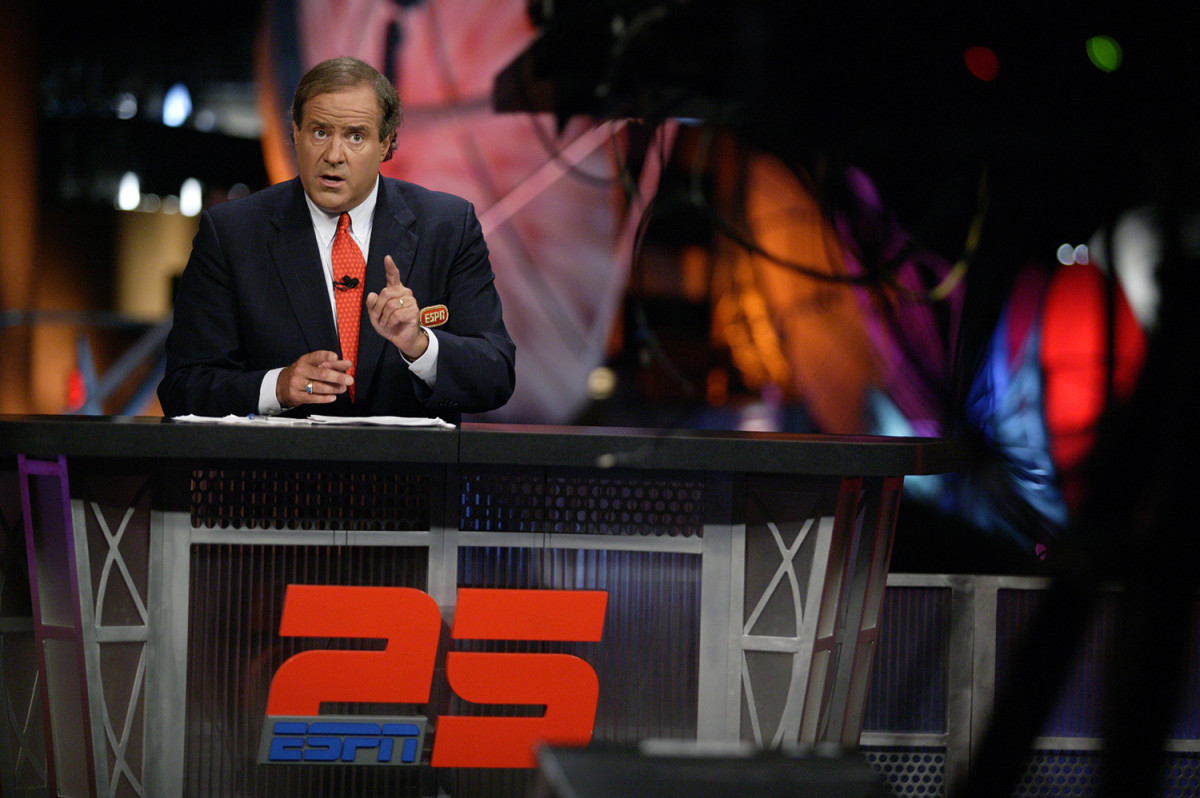
Chris Berman
Face of ESPN’s NFL coverage during the cable net’s dominant years
We don’t need football in order to live, and most of us don’t need it in order to prosper. And yet it can consume a significant place in our lives. Why do we invest so much into watching, playing and discussing the game? Because it’s fun. Simple as that.
On television, perhaps no one has more explicitly brought out the fun in football than former ESPN anchor Chris Berman. Big, loud and genial, he vibrantly trailblazed how the NFL is presented on TV. From 1985 to 2016 he was a mainstay on ESPN’s Sunday morning and Monday night pregame shows, but he shined brightest on Sunday evenings, hosting NFL Primetime with former Broncos linebacker Tom Jackson.
In the late ’80s and early ’90s, well before the Red Zone channels and just before the internet and prominence of DirecTV’s Sunday Ticket, Primetime was many fans’ richest connection to the NFL. Berman and Jackson took viewers around the league, presenting each game as its own story, with full narratives and analysis, while the best plays were shown over the enchanting Sam Spence tracks of NFL Films. Berman amplified the theater with sound effects and some of the best nicknames going: Andre “Bad Moon” Rison; Curtis “My Favorite” Martin; Eric “Sleeping With” Bieniemy; Reggie “A Stately” Wayne “Manor.” And, of course, there was the catchphrase (a tribute to predecessor Howard Cosell) that became popular not just in the sports world, but in the greater American lexicon: He! Could! Go! All! The! Waaaay!
Remarkably, Berman’s schtick did not compromise his dignity and journalistic chops. His one-on-one sitdown interviews were some of TV’s best, and he would shrewdly pick and choose spots to opine on some of the NFL’s political issues. But all of this, frankly, came second to the most important part of Berman: He made football fun.
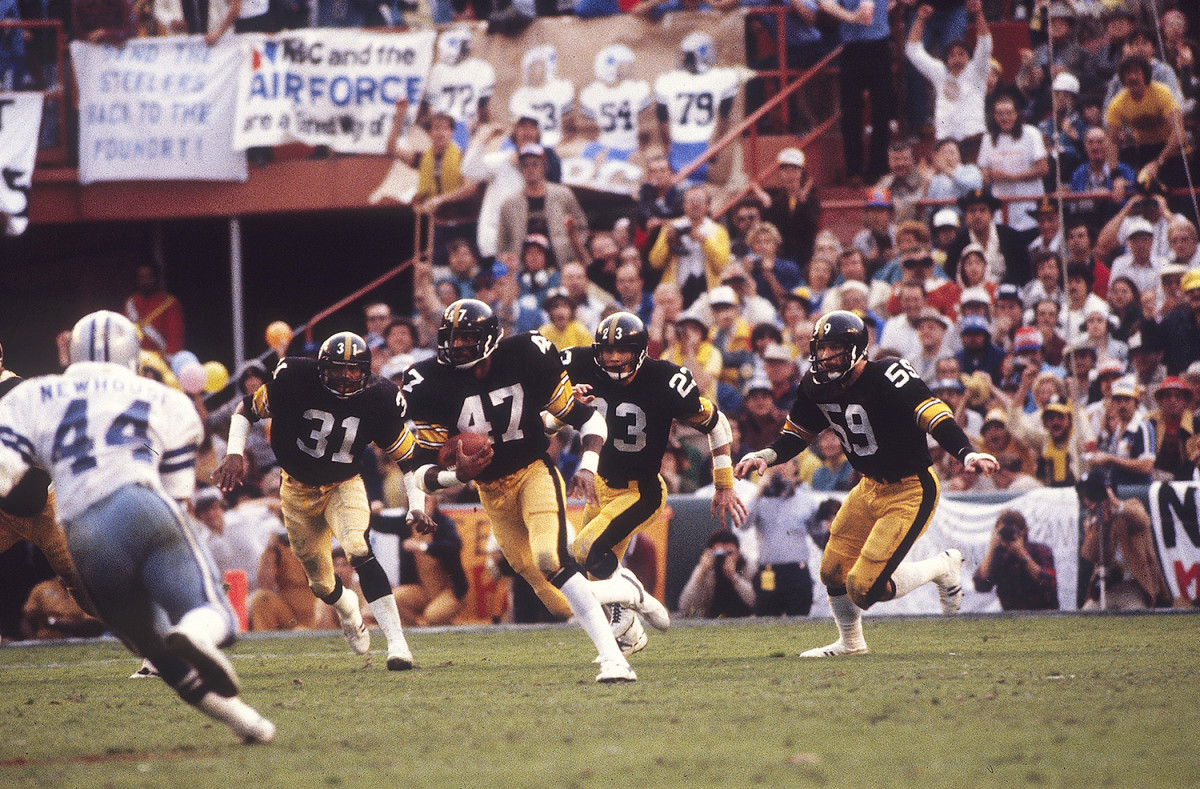
Mel Blount
Hall of Fame Steelers cornerback whose physical style forced rules changes that opened up the passing game
One of the distinguished few NFL players who forced a rules change meant to slow him down, Hall of Fame cornerback Mel Blount created a legacy as one of the best defensive backs in NFL history over 14 seasons with the Steelers. In 1978, the league introduced what was informally known as the “Mel Blount Rule,” limiting contact between a receiver and defensive back to within five yards of the line of scrimmage. Like Night Train Lane before him, the 6'3", 205-pound Blount took the bump-and-run technique to new heights, manhandling opposing receivers on the fearsome Steelers defense that contributed to four Super Bowl victories in his time. “They really were trying to legislate the game to slow the Steelers down, especially on defense, because we were basically dominating the game,” Blount later told NFL Network. “I think any time a player can have such an effect on the game that they name a rule after you, it’s an honor, and it’s something that my kids can read about.”
Blount was a two-time All-Pro, five-time Pro Bowl selection and, on a defense loaded with future Hall of Famers, the 1975 Defensive Player of the Year. Despite his physicality, he missed just one game in 14 season. Former teammate Dwayne Woodruff told SI in 2009, “Mel could play in the NFL today. And he could play in the NFL tomorrow.”
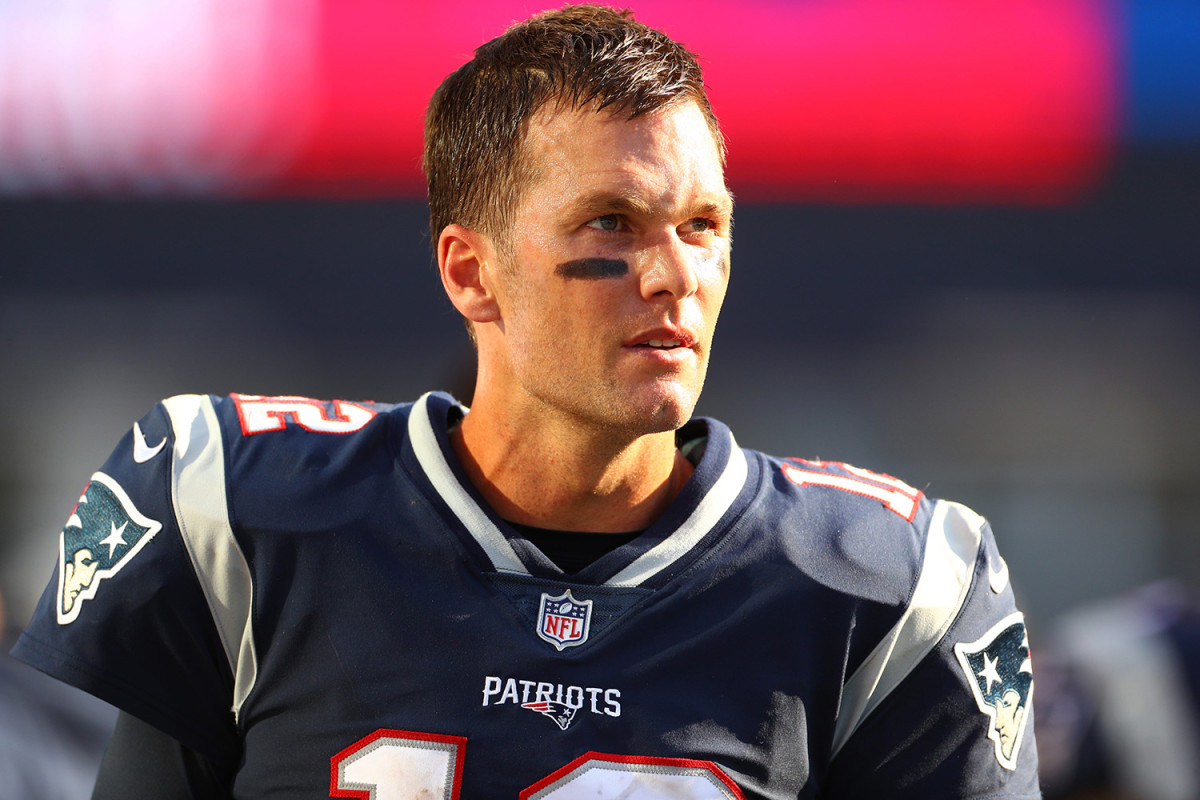
Tom Brady
Six-time Super Bowl-winning Patriots quarterback
No athlete’s career arc comes close to Tom Brady’s. The 199th overall pick in 2000 has long been known as the NFL’s all-time greatest draft steal. That label eventually gave way, in many minds, to the NFL’s all-time greatest player. Brady’s record in Super Bowls alone, 6–3, is better than many a great quarterback’s entire postseason record. He has six rings despite a 10-year title drought in the heart of his career, meaning Brady has spearheaded dynasties in two different eras: the early 2000s (three titles in four of the waning years of the “run the ball and play defense” era) and late 2010s (three titles in five years during the NFL’s pass-obsessed era). Split his NFL life down the middle, and you’re left with two first-ballot Hall of Fame careers.
More impressive than what Brady has done is the way he has done it. He has won in various systems with various supporting casts, many predominantly comprising role players. Remarkably, the attributes behind his greatness are still overlooked. Everyone talks about Brady’s football IQ, and indeed it’s off the charts. But his arm, though not scintillating like an Elway, Favre or Mahomes, is stellar. And Brady’s mobility, not out of the pocket (obviously) but in the pocket (where it matters most), is second to none.
Brady also might one day be viewed as a pioneer in personal fitness. His evangelism for his TB12 dieting and workout methods (lots of veggies, and muscle flexibility over strength) can draw snickers, but the results—for him—have been staggering: Almost 42, Brady looks as good physically as he did at 32.
Brady also represents how reactionarily a public image is formed. In the early 2000s he was the boy next door—the underdog who kept beating the bigger, faster, stronger guys. But as Brady kept winning, the public’s envy and fatigue took over, and in some quarters outside of New England, Brady began being seen as an almost villainous superstar. The 2014 Deflategate scandal/conspiracy (depending on whom you ask) solidified those love/hate perceptions. But now, after he has accumulated too many rings to fit on one hand, the respect for Brady—even from the haters—has mounted so high that the only fitting approaches to him are respect and awe.
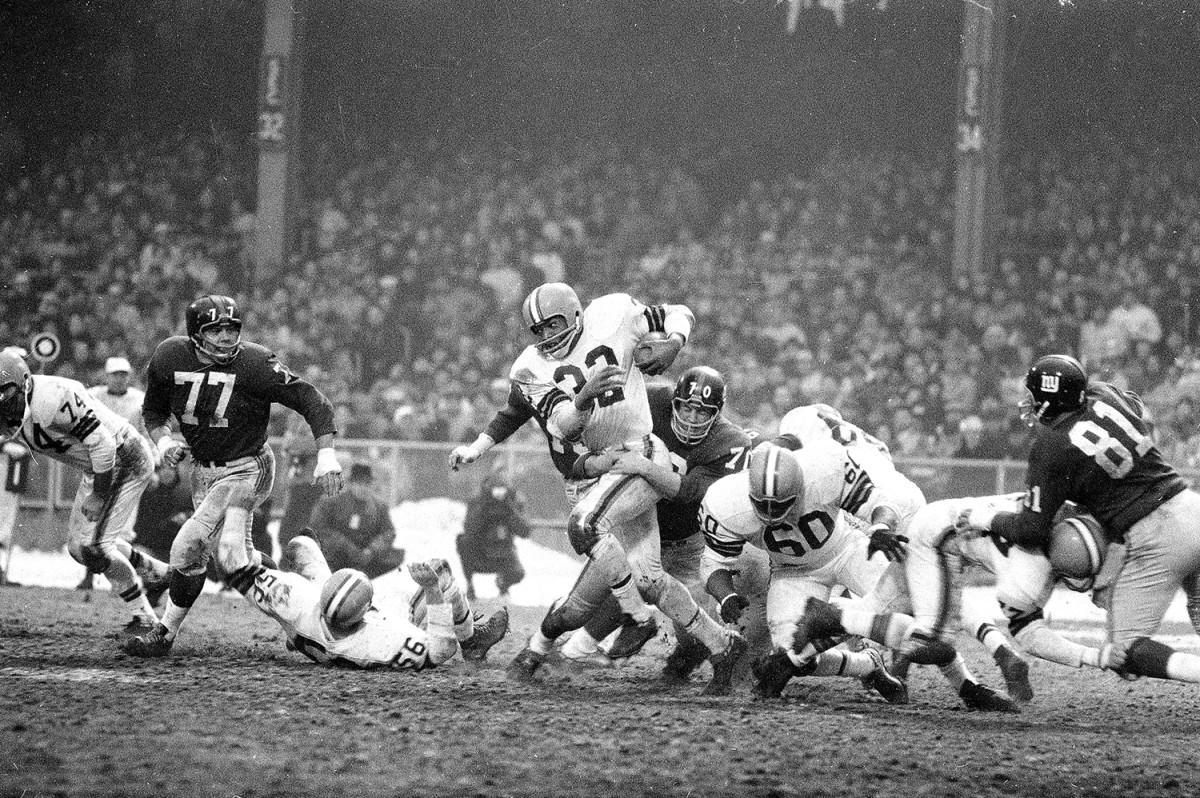
Jim Brown
Dominant ’60s running back and prominent activist who retired in his prime
Jim Brown is regarded by many as the greatest pro football player ever. The fact that he left the game at his peak is only further evidence for the argument.
In just nine NFL seasons, the Browns back racked up 12,312 yards while averaging an astonishing 5.2 yards per carry. He held the NFL’s career rushing record for 19 years—still the longest any rusher has held the title—and despite retiring in 1965, was in the top 10 in career rushing yards in the NFL for more than 50 years. Today he remains the only player in NFL history (with more than three seasons) to average more than 100 rushing yards per game in a career.
Brown led the NFL in rushing yards in eight of his nine seasons. Three times he was named NFL MVP. He never missed a game in his career. He led Cleveland to the 1964 NFL title, the Browns’ most recent championship. And he served as a black sports icon in the 1960s during the civil rights movement.
Brown’s retirement following his MVP-winning 1965 season shocked the sports world. Embroiled in a contract dispute with Cleveland owner Art Modell while on the set of The Dirty Dozen, Brown told SI’s Tex Maule, “I quit with regret but not sorrow.” He went on to have a successful acting career, though across the decades he faced numerous charges related to domestic violence.
He has served as an NFL ambassador for much of his post-playing career. Any number of players have called Brown the greatest ever, but take it from Bill Belichick, who’s known as a history buff. “Jim Brown is in my opinion the greatest player that ever played,” Belichick, the former Browns coach, said in 2016.
If you want to know Brown’s running techniques, who better to hear it from than the man himself? In 1960, he taught us all how he became the best rusher in the NFL in this SI spread.
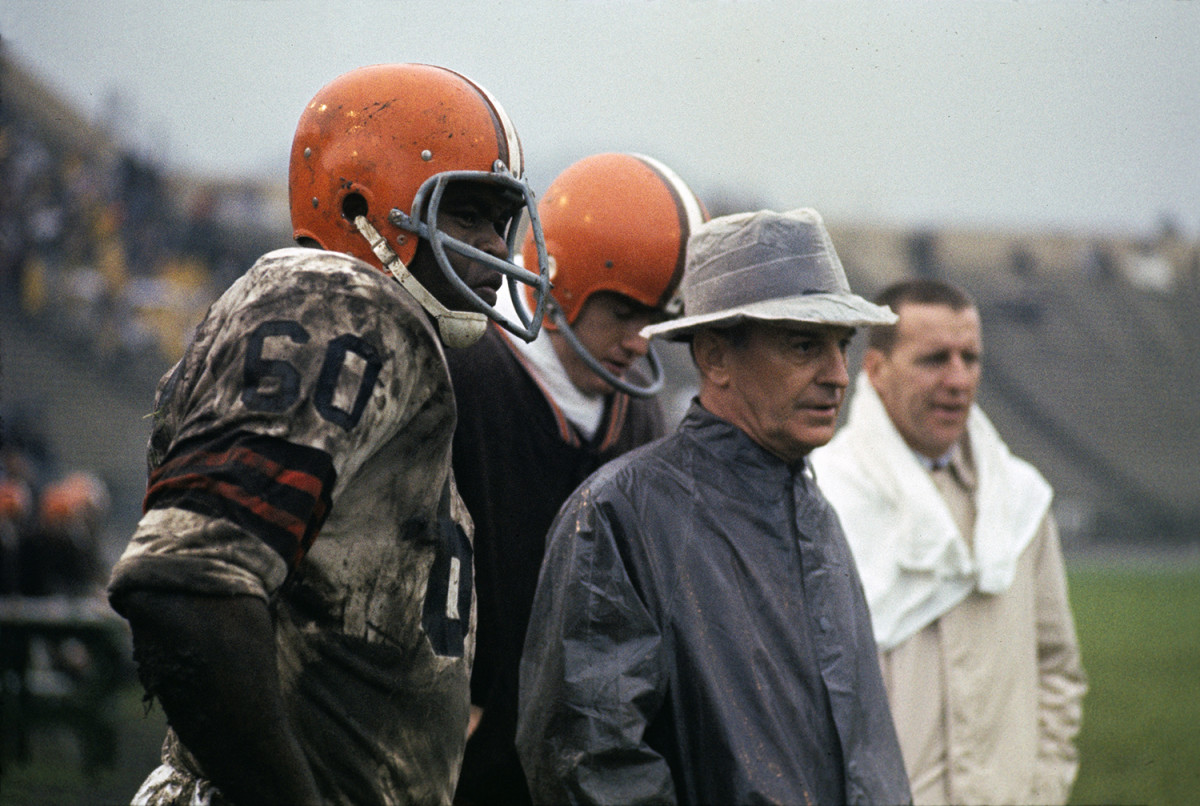
Paul Brown
Dynastic and innovative Browns coach; later founder of the Bengals
Considered by many the godfather of modern football coaching, Paul Brown’s biography could extend for hundreds of thousands of words. But put simply: The familiar machinations with which the majority of successful coaches operate in the NFL today can almost all be derived from the behavior of Brown.
Before Brown, film study was not the norm. Nor was scouting as we know it today. Nor was hiring a coaching staff and deploying it across distinct areas of expertise. Of course, these are only the surface-level concepts that he gets credit for. Brown is to coaches what Chuck Berry is to guitar players; it’s far easier to find the things coaches do today that did not originate from one of Brown’s methods. Any time you think there exists a new sound or groove, it’s best to rewatch Brown’s A Football Life to make sure it wasn’t stolen.
With a tree that spawned the careers of Bud Grant, Chuck Noll, Don Shula and Bill Walsh among countless others, Brown led by example. Even if that example sometimes caused players to recoil—he was notoriously aggressive when it came to contract negotiations, and players remember him for a dictatorial streak—it was difficult to argue with Brown’s success. In 1946, the former Ohio State coach took over the fledgling Cleveland Browns of the All-America Football Conference and proceeded to win all four AAFC titles, then another three when the Browns migrated to the NFL. A seismic change in professional football came when Brown, who operated as the de facto GM of the team, split with Cleveland and its new owner, Art Modell, in a power struggle. Five years later Brown returned to football in Cincinnati, where he invested in the AFL’s newly formed Bengals and served as coach, GM and principal owner. Brown worked in Cincinnati until his death in 1991, eventually passing ownership of the franchise over to his son, Mike.
Despite all of his renowned success, it’s easy to trace Brown’s roots back to the genesis of his coaching career as a relentless competitor. Even though he won championships, revolutionized coaching and introduced some of the most cutting-edge play concepts of the time, he would view beating the Browns in 1970, the first year of the AFL-NFL merger, as one of his most satisfying victories.
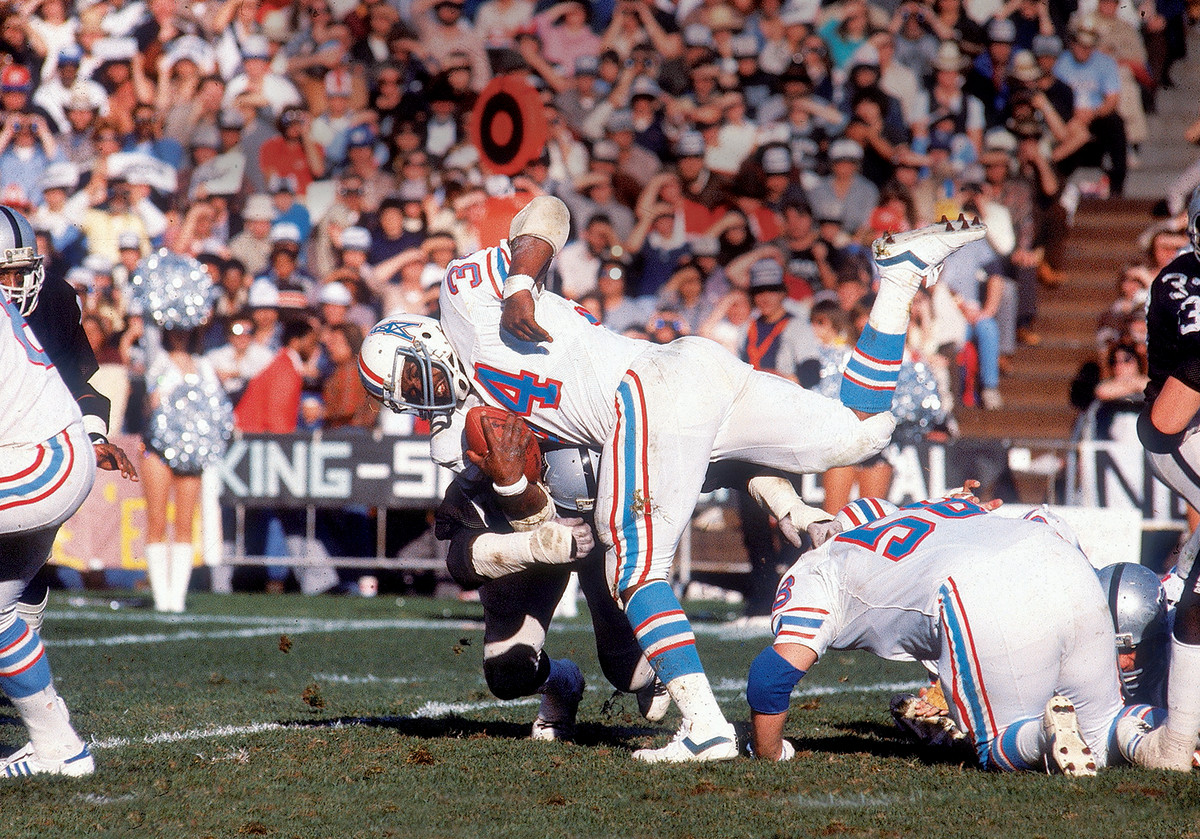
Earl Campbell
Transcendent power-runner whose curtailed career highlighted the game’s physical toll
Before there was Marshawn Lynch or Adrian Peterson, there was the NFL’s consummate power back: Earl Campbell.
Once a No. 1 overall draft choice out of the University of Texas, before going on to a glowing NFL career that featured five Pro Bowls, three first-team All-Pro nods, an MVP award and three offensive player of the year awards, Campbell started life as a young worker on his family’s rose farm in Texas.
He grew up idolizing linebackers, which made sense when he was handed the reins as a running back in high school and never looked back. He became the face of the NFL’s physicality on the field, and its consequences off it. In 2012, he told reporters that the ailments he suffered from, including significant nerve damage, were almost certainly correlated to his playing style and heavy workload as a player.
Campbell finished his career with more than 2,000 carries, including four straight seasons of 300-plus attempts at its outset. While those numbers may eventually blend into the background (his career statistical comparisons are closer to those of Shaun Alexander, Clinton Portis and LeSean McCoy), Campbell is viewed by lifers of the game as one of the purest representations of a classic running back in the Jim Brown mold.
Campbell played his entire career with physical ailments aggravated by some band-aid surgeries. Whatever pain he was inflicting on his opponents was probably being felt doubly by Campbell, who struggled for a time with painkiller addiction following his playing days and was diagnosed with spinal stenosis in 2009. Some of Campbell’s greatest physical feats may have been overcoming the wave of side effects that hit him after the game. That being said, to see him romp into the end zone in the traditional NFL Films slow motion is to marvel at a work of art that will endure.
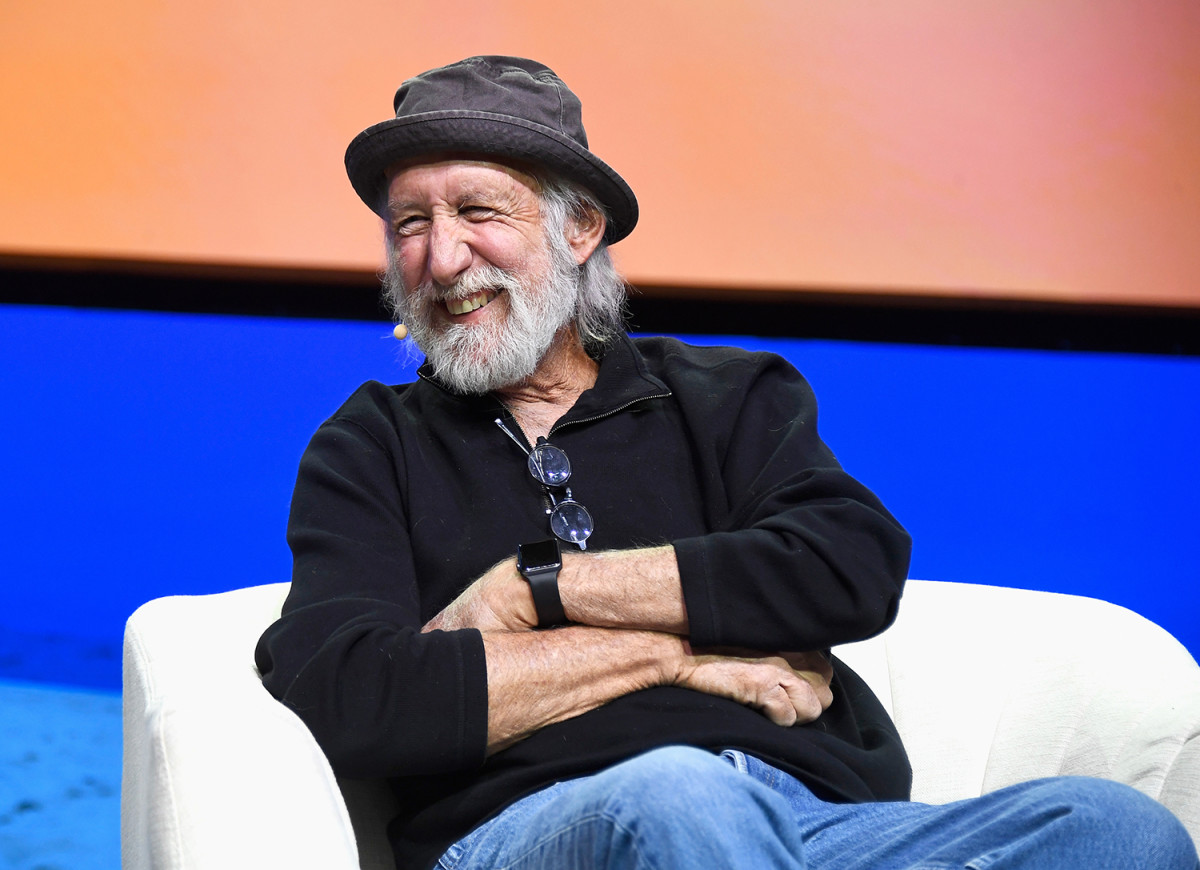
Lee Clow
Creative mind behind Apple’s revolutionary “1984” Super Bowl commericial, which transformed advertising and the NFL championship broadcast
Midway through the third quarter of Super Bowl XVIII on January 22, 1984, Pat Summerall sent the CBS broadcast to commercial. What came next transformed television history.
Scene: An army of gray-clad drones shuffles in lock-step as an ominous voice intones portentously about the control of information. Cut to a young woman in white tank top and red shorts carrying a sledgehammer and pursued by gray-clad troopers. As a giant face on a screen in a bleak auditorium harangues the audience—“our Unification of Thoughts is more powerful than any fleet or army on Earth!”—and bellows out, “We shall prevail!” the woman spins and hurls the hammer. The screen explodes, unleashing a blast of wind that sweeps over the slack-jawed drones.
“On January 24th, Apple Computer will introduce Macintosh. And you’ll see why 1984 won’t be like ‘1984.’”
To introduce the groundbreaking Macintosh computer, Apple founder Steve Jobs wanted something dramatic and unexpected. He turned to Chiat/Day creative director Lee Clow, a star in the advertising world, who devised a 60-second spot that drew on the dystopian aesthetic of George Orwell’s 1984, enlisting Ridley Scott (Alien, Blade Runner) to direct at a cost of $900,000, and pegged it for the Super Bowl, the most watched program on American television.
The ad ran just once nationally, on that Super Bowl broadcast, but the impact was instantaneous. The next morning the talk was more about the mind-blowing commercial than the Raiders’ blowout of the Redskins, and the “Super Bowl ad” phenomenon was born. In the years to follow, the commercials became phenomena in themselves—from Spuds McKenzie to “Nothing But Net” to “Dilly Dilly”—drawing huge non-football audiences to the game and generating massive (free) media coverage for sponsors. “Our vision was more about the idea of how the world was going to change because of computers—not that we were changing the Super Bowl that day,” Clow told Bloomberg Newsin 2014. “But it did create a phenomenon where people started designing advertising specifically for the Super Bowl. … In the advertising business, you don’t often get to be a part of something that important, that world-changing.” Macintosh changed the computer industry; “1984” changed advertising, and the NFL.
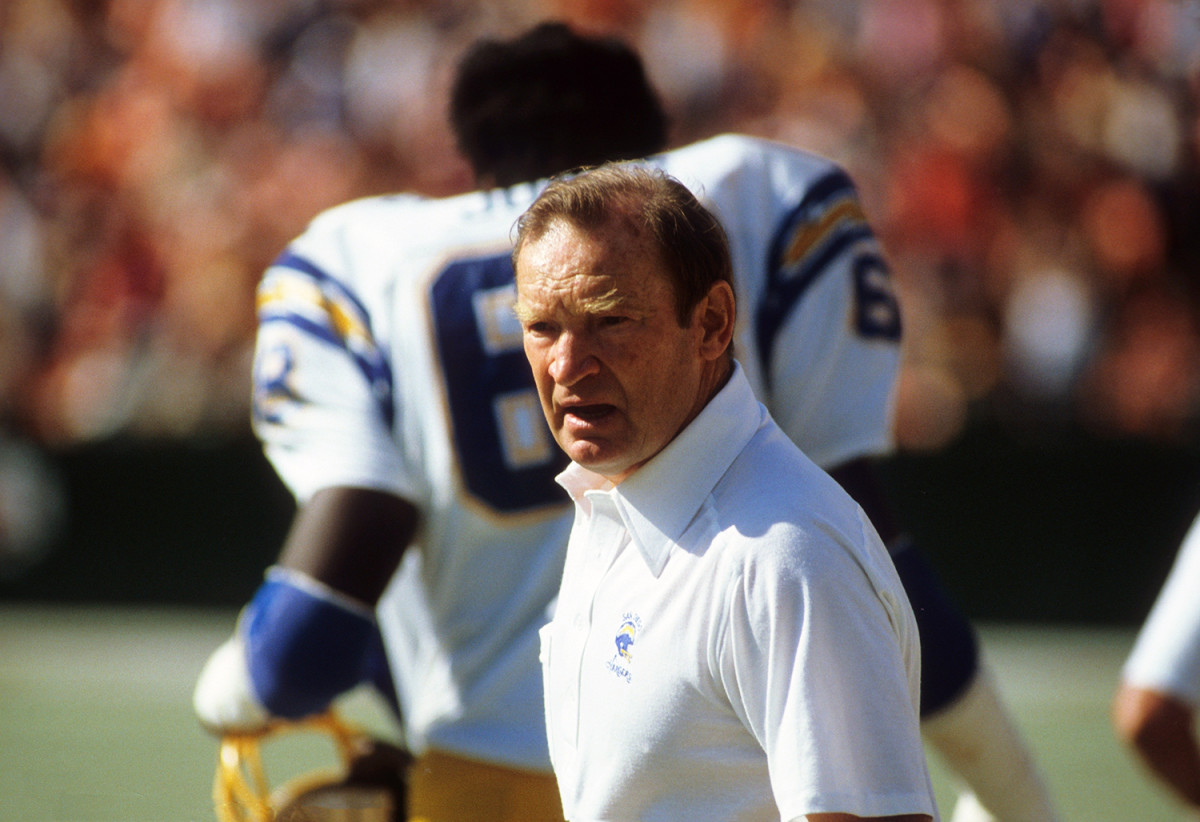
Don Coryell
Passing-game genius who forced defenses to adapt in the game’s constant strategic ebb-and-flow
Some of pro football’s greatest innovators, especially on offense, have come from the college ranks. There’s perhaps no better illustration than Don Coryell. A journeyman at small colleges from 1950 to ’60, Coryell was the head coach at San Diego State from 1961 to ’72 before joining the St. Louis Cardinals in 1973. In ’78 he moved to San Diego, where he had his most famous stint, with the Chargers for nine years.
Coryell’s understanding of how to weaponize a downfield passing game dated to his time at San Diego State, where necessity was the mother of invention. As he explained several years after leaving there, according to the San Diego Union Tribune and San Jose Mercury News, "We could only recruit a limited number of runners and linemen against schools like USC and UCLA. And there were a lot of kids in Southern California passing and catching the ball. There seemed to be a deeper supply of quarterbacks and receivers. And the passing game was also open to some new ideas. Finally we decided it’s crazy that we can win games by throwing the ball without the best personnel. So we threw the hell out of the ball and won some games. When we started doing that, we were like 55-5-1.”
Coryell’s downfield route combinations changed the NFL. His high-flying offensive approach, known as Air Coryell, swept the league in the late ’70s and early ’80s. With the Chargers, Coryell’s offenses ranked, in terms of total yardage, 4th, 5th, 1st, 1st, 1st, 1st, 4th, 1st and 12th (Coryell’s final season, in which he was fired after a 1-7 start).
Coryell’s omission from the Hall of Fame remains one of the hottest debates among football cognoscenti. Voters don’t like that he never reached a Super Bowl, but former coaches rave about Coryell as a pioneer of the modern passing game. As Tony Dungy told SI.com in 2010, "If you talk about impact on the game, training other coaches—John Madden, Bill Walsh, Joe Gibbs to name a few—and influencing how things are done, Don Coryell is probably right up there with Paul Brown. He was a genius.”
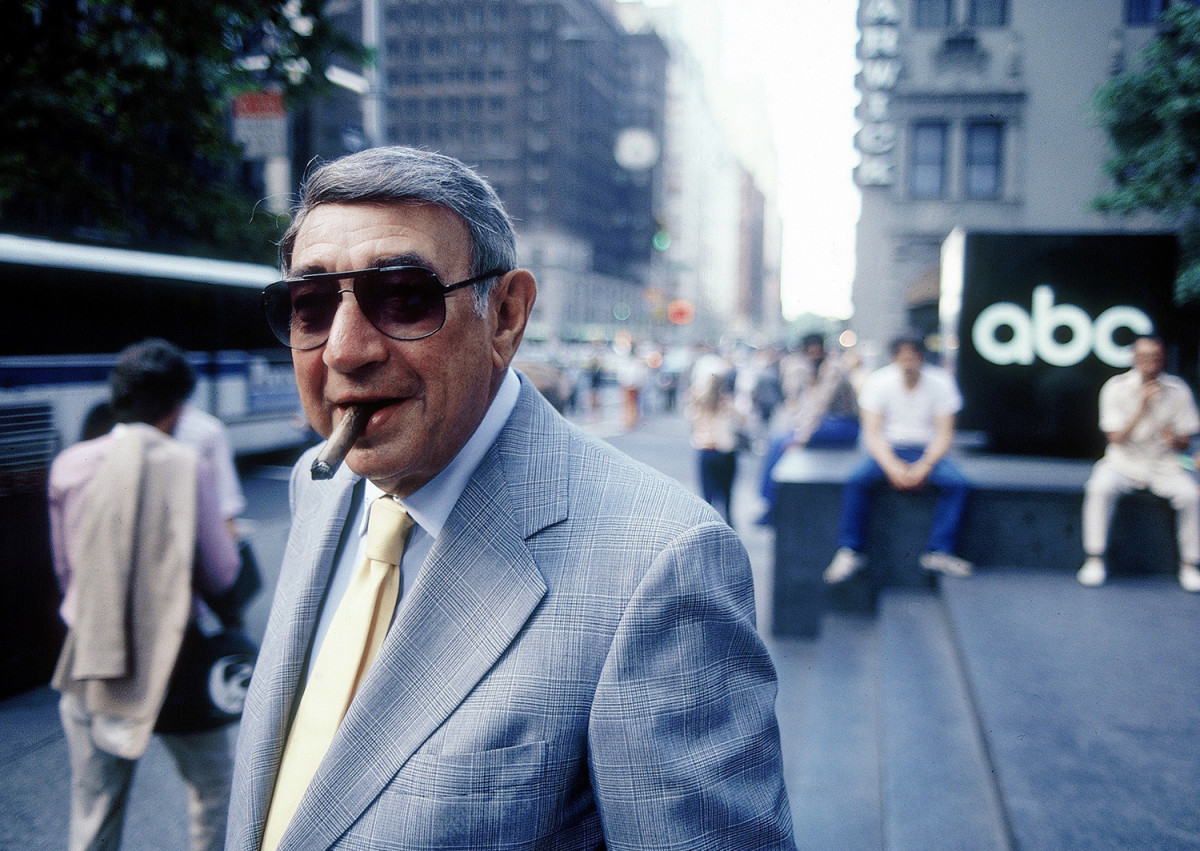
Howard Cosell
First true celebrity sports broadcaster; brought brash, caustic intellect to the MNF booth
The great Frank Deford sums up the inimitable Howard Cosell best. In a 1983 SI cover story, Deford wrote of the famed announcer: “In that jejune world up in the booth—high up in the booth—only one man possesses quickness and momentum. He is not the one with the golden locks or the golden tan but the old one, shaking, sallow and hunched, with a chin whose purpose is not to exist as a chin but only to fade, so that his face may, as the bow of a ship, break the waves and not get in the way of his voice. For as long as he speaks, whoever rails at Cosell’s toupee isn’t seeing the bombs for the silos.”
Howard Cosell may be best known for his storied relationship with Muhammad Ali, but the announcer’s impact on professional football might be as critical as anyone in the sport’s history. As the color voice of Monday Night Football for 14 years, from its inception in 1970 until 1983, it was Cosell who became such a celebrity that he’d be trailed home by hundreds of fans after games. Through his prominence, Cosell ushered the NFL into prime time, into the living room of houses all over America, with his caustic wit and authoritative voice.
Cosell was so polemical, so much ingrained in the culture of sports, that he was once voted both the most popular and the most disliked sportscaster in America. From boxing to the Olympics to Hollywood, Cosell was ubiquitous in American culture for decades. But his prominence was greatest when he was in the booth every Monday night on ABC. For years, Cosell’s staccato voice was synonymous with the NFL—whether you loved him or hated him.
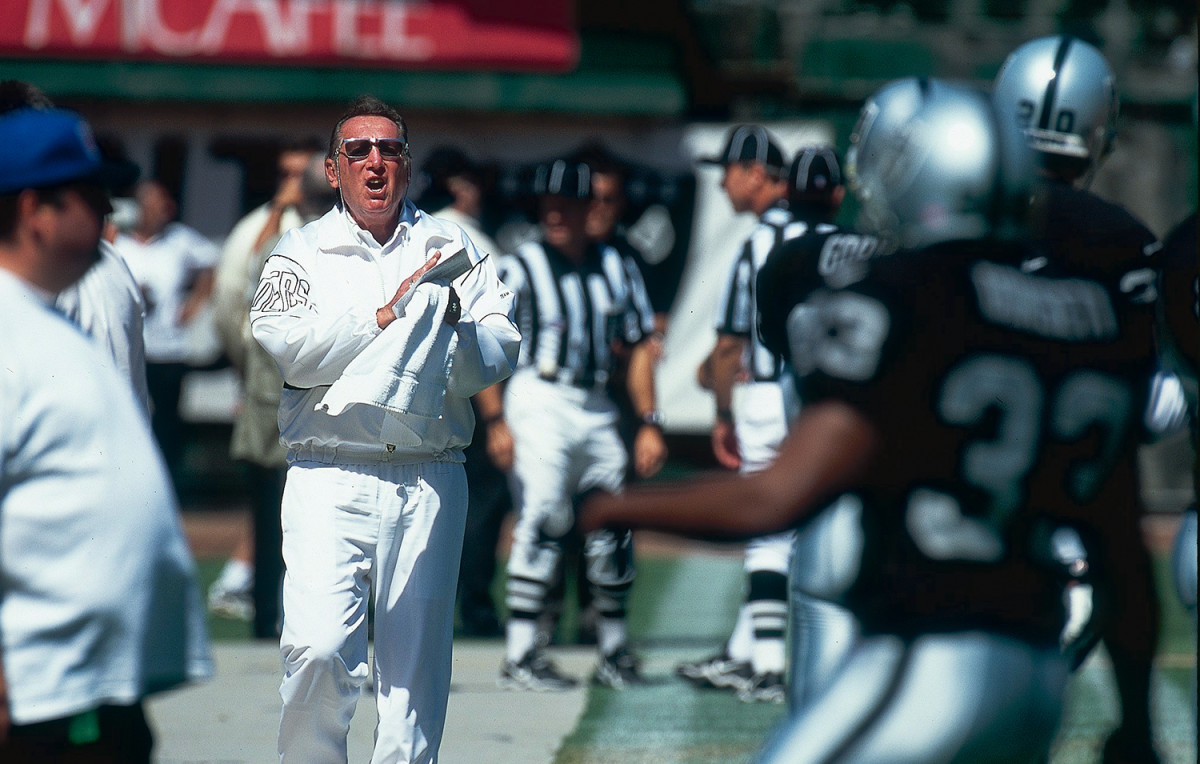
Al Davis
Iconoclastic Raiders coach and owner who challenged league orthodoxy
Al Davis was truly one of a kind, the only person in NFL history to serve as a personnel assistant, scout, assistant coach, head coach, general manager, commissioner and owner. After an itinerant early career that took him from Adelphi College to the U.S. Army, from the Baltimore Colts to the University of Southern California, Davis entered the AFL ranks as an assistant for the Chargers. When he became Oakland’s head coach in 1963—the team’s fourth in four seasons—winning was “completely foreign to anything the Oakland Raiders have ever done before,” SI’s Walter Bingham wrote of the franchise that had a 9-33 record in its first three seasons. “But,” Bingham continued, “now Al Davis arrived.”
Those words proved prophetic, as Davis would bring his “Commitment to Excellence” mantra to the franchise and come to coin his trademark phrase, “Just win, baby.” After briefly leaving the team in 1966 to become the commissioner of the AFL, Davis returned to the Raiders the following year as general manager and owner, and he soon hired John Madden as coach. Under Davis’s leadership, Oakland would win three Super Bowl titles, and would have just one losing season from 1965 to ’85.
Known as a caustic renegade, Davis was one of the first outspoken owners in sports. He constantly feuded with the league and was in large part responsible for the emergence of the AFL as a true competitor of the NFL. He sued the league to move the Raiders to Los Angeles in the ’80s, only to later move them back to Oakland, presaging the the era of franchise movement. He was also known as an early champion for diversity in the NFL, hiring the first head coach of Hispanic descent (Tom Flores) and the first African-American head coach (Art Shell), refusing to place his team at segregated hotels on road trips and encouraging his employees to scout and draft players from historically black colleges and universities.
Upon his death in 2011, SI’s Richard Hoffer wrote, “Davis not only dominated the game with his madcap misfits but also wrote the rules by which everyone, enemies included, ended up playing.”
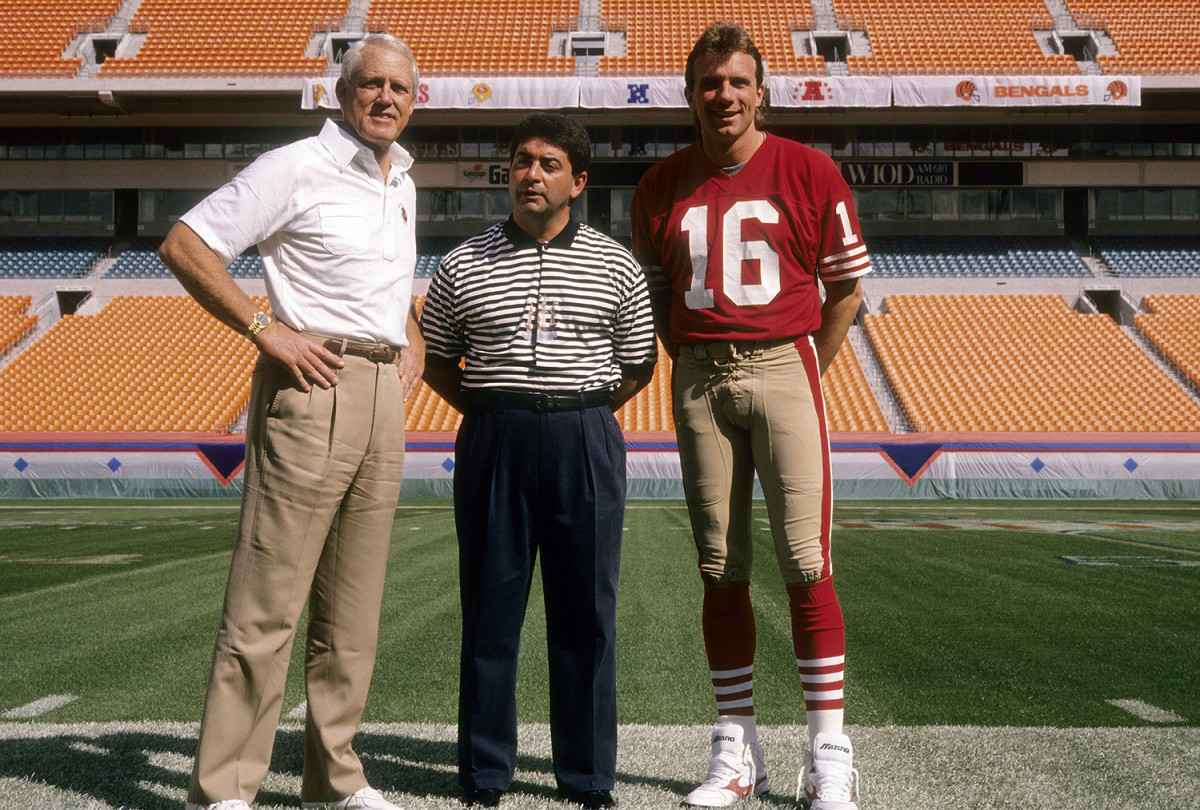
Eddie DeBartolo
49ers owner whose player-friendly approach lay the foundation for a dynasty
Eddie DeBartolo had this wild notion that instead of treating NFL players like cogs in a machine, you could treat them like humans, and might actually create an atmosphere conducive to winning as a team owner. Crazy.
Under DeBartolo’s ownership, beginning and 1977 and stretching until 2000, the San Francisco 49ers went to the playoffs 16 times, played for the NFC title 10 times and won five Super Bowls. Two years after purchasing the team, DeBartolo tabbed Stanford coach Bill Walsh for the job with the Niners. After Walsh left, DeBartolo kept it rolling with George Seifert for two more world championships.
SI called DeBartolo “the best owner in pro sports” in a 1990 profile that detailed how generous he was to his players, staff and others. Just one example: When a player was injured in a road game and stayed behind for treatment, he’d arrange for a private jet to bring the player back home. “Thank god Eddie didn't have to cut guys,” Bill Walsh said in that 1990 profile, “or they'd never have gotten cut.”
DeBartolo’s ownership ended at the turn of the century when he became embroiled in a Louisiana casino scandal. He pleaded guilty to failing to report a felony in relation to efforts made to secure a casino license. Banned from the NFL for a year, DeBartolo ultimately sold his stake in the team to his sister, Denise DeBartolo York, and continued working in the family shopping center business. Still, the 2016 Hall of Fame inductee remains at the heart of the 49ers: As famed receiver Dwight Clark battled ALS in his final years, DeBartolo flew Clark’s former teammates to his Montana ranch to celebrate, reminisce and say their farewells. “Everyone knew in the ’70s and ’80s that when Mr. DeBartolo owned the team, that was the team to be on,” lineman Kevin Gogan told SI’s Chris Ballard in 2018. “And I finally got a taste of it later in my career. I don't care how much money you make, if you treat guys with the utmost respect, you're going to get so much more out of them.”
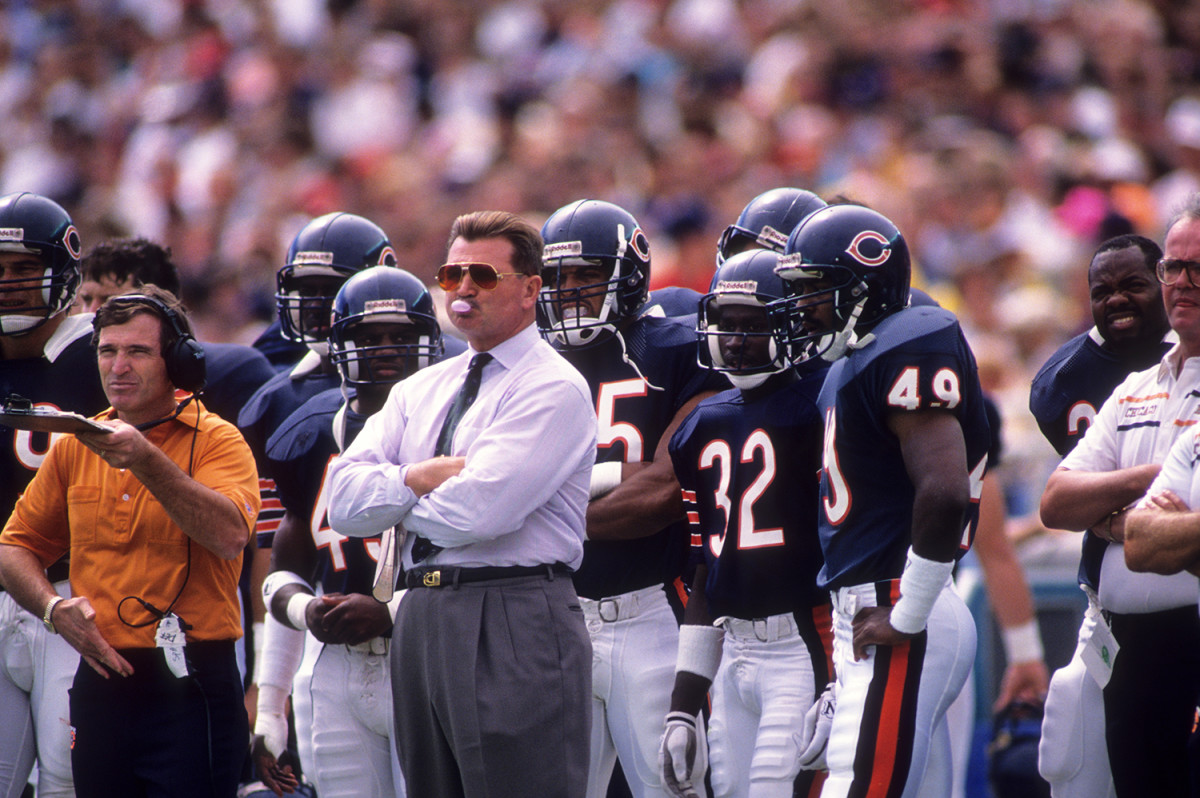
Mike Ditka
Revolutionary pass-catching tight end and iconic Bears coach who gained massive mainstream fame
Mike Ditka has spent six decades in the football spotlight, the living embodiment of the game’s tough-guy image. Legendarily competitive as a three-sport star at fabled Aliquippa (Pa.) High and Pitt (where he would punch out not just opponents but teammates whose effort he questioned), he was drafted by the Bears in the first round, fifth overall, in 1961. A fast and bruising proto-Gronkowski, Ditka revolutionized tight end in the pros: His 1,076 receiving yards as a rookie were most ever at the position, and his 248 catches in his first four seasons—including 75 in Chicago’s 1963 championship campaign—were unmatched until the likes of Kellen Winslow and Ozzie Newsome arrived two decades later. Ditka was All-Pro twice and made the Pro Bowl in each of his first five seasons.
After a contract dispute with Bears owner George Halas (whom he famously said “throws nickels around like manhole covers”), Ditka spent two years in exile with the Eagles, then joined Dallas, where he won a Super Bowl as a platooning tight end under Tom Landry. After retiring, he joined Landry’s staff as special teams coach, and though you’d be hard-pressed to find two men more different in temperament, Ditka credits the stoic Cowboys coach for rescuing his career and his reputation.
In 1982 Halas hand-picked Ditka to take over the woeful Bears, and over the next few years he remade the franchise in his fiery, throwback image. Ditka cleaned house, set the tone by breaking his fist with a locker punch (then telling his troops to go out a “win one for Lefty”) and held the wheel as Walter Payton ran rampant and Buddy Ryan’s defense rose to dominance. Many consider Ditka’s ’85 Bears, wildly loaded with talent and personalities, the greatest team in league history.
That feverish high proved unsustainable—Ryan left, Ditka’s teams floundered in the playoffs, and he was fired after a 5-11 season in 1992. Nor could he recapture the lightning in three years with the Saints, where the hallmark of his coaching tenure was trading away his entire 1999 draft to select Ricky Williams.
No matter. Ditka had become a folk hero in Chicago and beyond, immortalized in the Saturday Night Live sketches in which four worshipful superfans in aviator sunglasses and fake mustaches waxed hyperbolic about Da Bears and Da Coach. Ditka has worked as an analyst for NBC and ESPN, and he flirted with a run at the 2004 U.S. Senate seat that would be won by Barack Obama. It’s probably best he didn’t make it to Washington—if only for the sake of the lockers in the Senate gym. “I wasn't always the best, but nobody worked harder,” Ditka told SI in 1985. “One-on-one. You and me. Let's see who’s tougher. I lived for competition. Every game was a personal affront. Everything in my life was based on beating the other guy.”
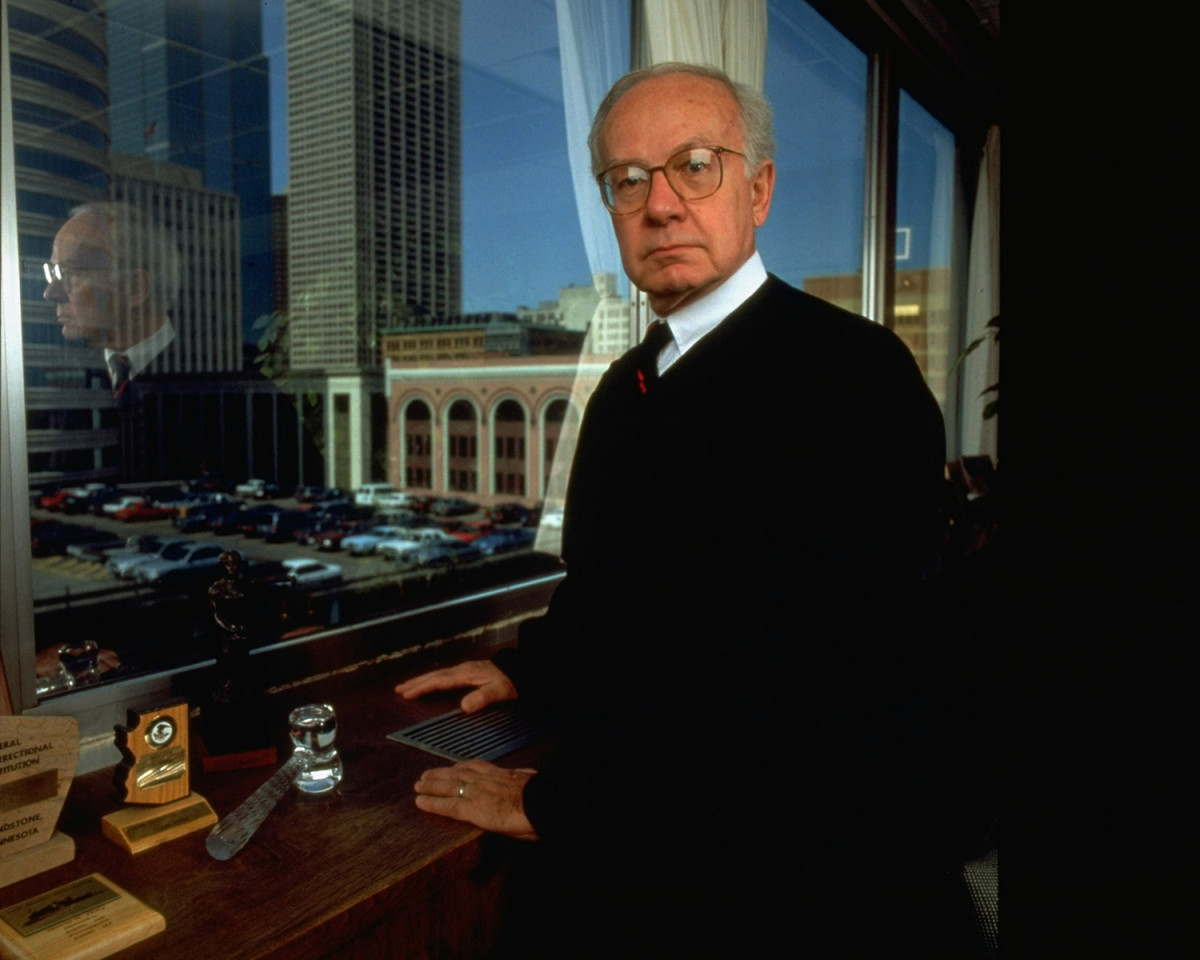
Judge David Doty
Federal judge who oversaw league/union labor relations and opened the door to free agency
For more than two decades, Judge David Doty ruled over owner-player relations from his seat on the U.S. District Court for the District of Minnesota. During a six-year stretch beginning in 1987, Doty presided over the contentious back-and-forth between NFL owners and the players union over free agency, eventually threatening to draw up his own solution if the two sides could not come to terms. The result shaped the NFL as we know it.
For decades, owners held the power in labor dealings with players. That started to erode in the ’70s, when the union began to challenge the league through antitrust litigation, choosing the federal court in Minneapolis as the venue. Doty, an ex-Marine, was appointed to the bench by President Reagan in 1987, and a year later he made his first ruling in favor of the players (it was overturned on appeal). In ’92 he presided over the bench trial that found “Plan B” free agency a violation of antitrust law, and soon after, in the Reggie White case, he threatened to impose his own version of free agency if the league and the union could not settle on one; the NFL buckled, and the consequent collective bargaining agreement ushered in free agency and the salary cap. Because the CBA included a consent decree, Doty’s court retained jurisdiction over NFL labor matters through the life of the agreement. The NFL’s fears that such a ruling would ruin pro football proved unfounded, of course; over the next two decades the league saw unprecedented success and revenue growth.
Doty’s court was final arbiter in NFL-NFLPA disputes up until the dissolution of the CBA in 2011. His final involvement in an NFL matter came in 2015, when, true to his player-friendly reputation, he reversed Adrian Peterson's suspension for alleged child abuse and chided Roger Goodell. “I’m not sure the commissioner understands there is a CBA,” Doty said at the time.
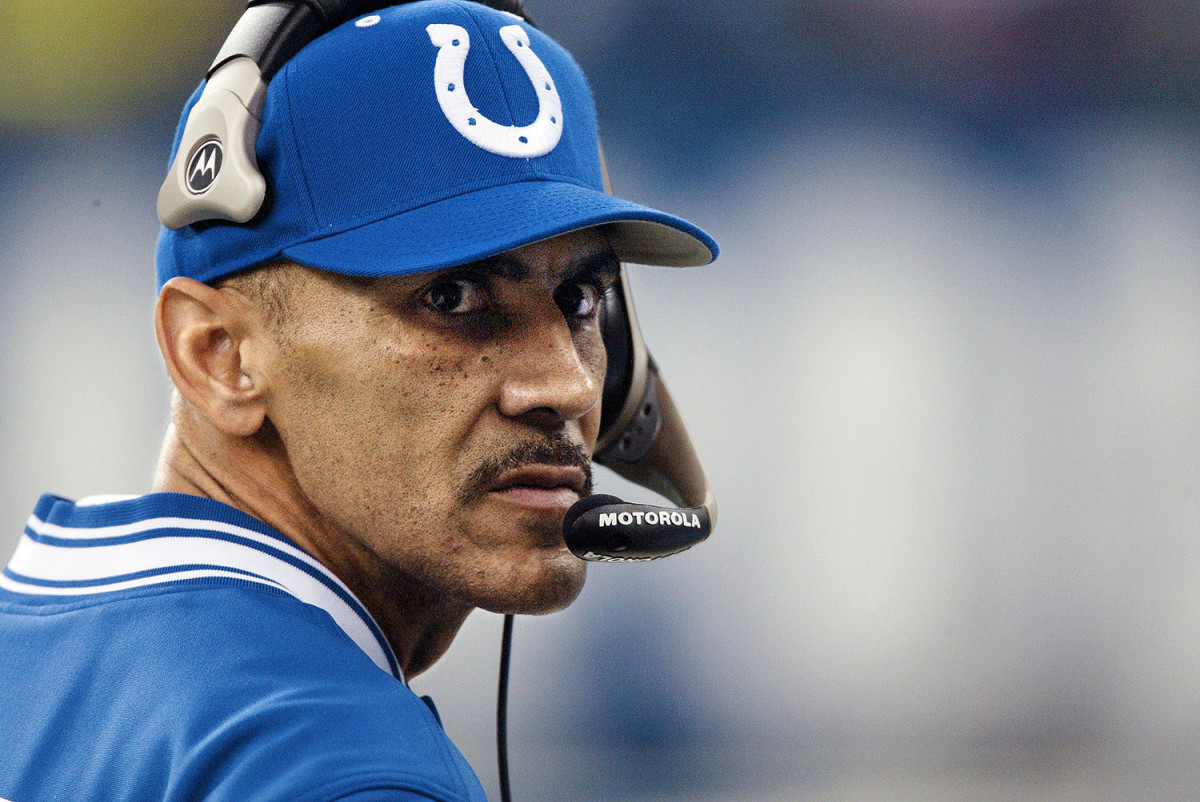
Tony Dungy
First black Super Bowl-winning coach, with an extensive and influential coaching tree
Few men have brought as much dignity and grace to their profession as Tony Dungy has to coaching. A three-year backup defensive back with the Steelers and 49ers, Dungy joined the NFL coaching ranks in 1981, instructing DBs in Pittsburgh and then Kansas City until 1991. He became Dennis Green’s defensive coordinator in Minnesota in 1992, and then Tampa Bay’s head coach in 1996, where he turned the struggling franchise into a regular playoff team. In 2002, one year after Dungy was dismissed from Tampa, the Bucs hoisted a Lombardi trophy with the team he built. Dungy, in the meantime, had been hired by the Colts, who went on to double-digit wins and the playoffs in each of his seven seasons there. His coaching peak came in 2006, when his Colts won a Super Bowl against a Bears team coached by Lovie Smith, one of seven former Dungy assistants who went on to become a head coach.
Dungy is as highly regarded for his work away from football as he is for his record, extensive coaching tree and influence on the game. He is invested in his Evangelical faith, personal and group mentorship and extensive civic involvement. He is also a television personality, noted author and motivational speaker. His work in these fields are significant, but in a series like this one, it should not distract from Dungy’s impact on the game, which was—and still is—monumental. His Tampa 2 scheme in the late ’90s and early 2000s revolutionized how people look at defense. Dungy took a traditional Cover 2 zone defense but had the middle linebacker drop deep down the center of the field, running with the innermost vertical receiver. This increased the athletic demands placed on linebackers (everyone sought the next Brian Urlacher, who filled the Tampa 2 “Mike” backer duties better than anyone else), and had spillover effects that changed how other defensive schemes were constructed. In the falling dominoes of pro football strategy, this forced changes in the design of passing offenses. Dungy brought a beautiful simplicity to the game.
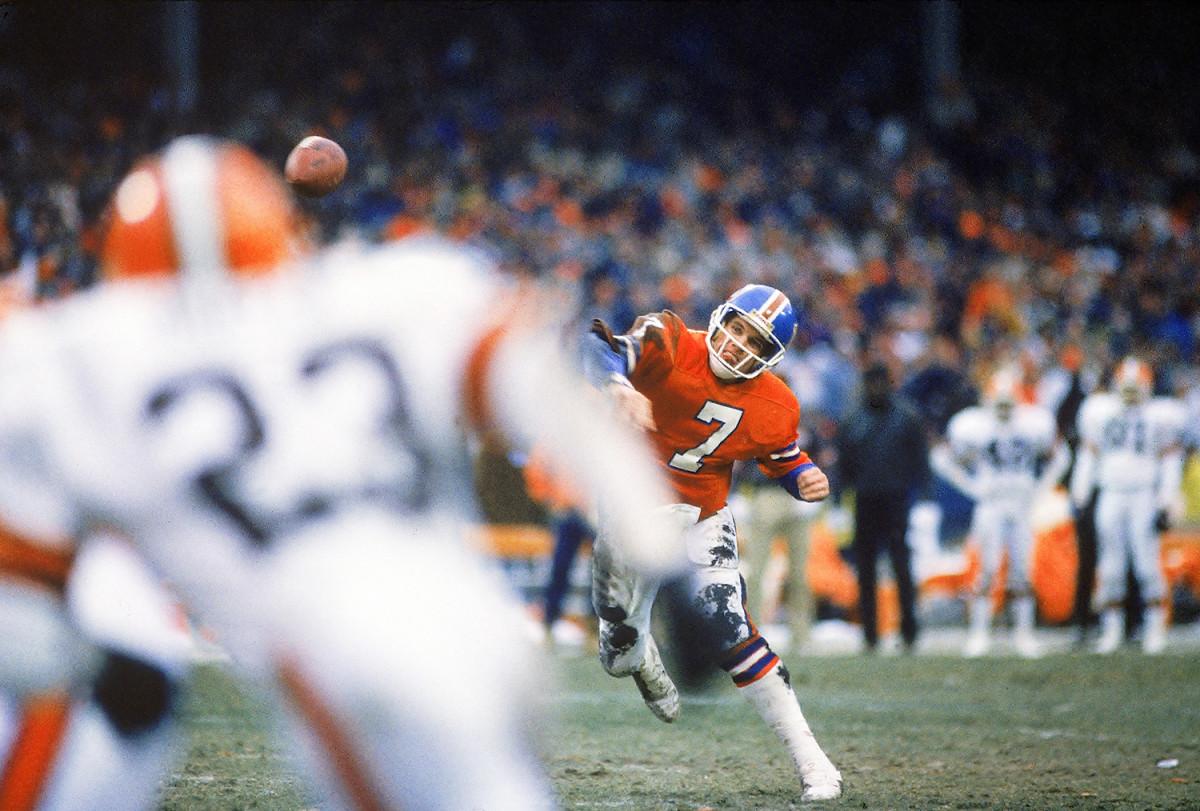
John Elway
Generational talent who forced a draft trade to Denver; first person to win the Super Bowl as a QB and GM
While he would later be known as one of the greatest quarterbacks in history, John Elway started his NFL career by flexing all the power a prized collegian has at his disposal, when he refused to sign with the Baltimore Colts, the team that selected him No. 1 overall in the famed 1983 draft. Elway, a two-sport star at Stanford, threatened that rather than sign with the Colts, he would play for the Yankees, who’d chosen him in the second round of the MLB draft two years earlier. In a bind, the Colts traded Elway to the Broncos for two veteran players and a first-round pick—reshaping the landscape of the league for the next two decades.
In Denver Elway became one of the most prolific passers—and running quarterbacks—in league history, the first ever to pass for more than 3,000 yards and rush for more than 200 yards in the same season seven consecutive times. But what is remembered most in Elway’s career was his penchant for heroics, including 31 fourth-quarter comebacks. There were the two against Cleveland in AFC title games, most famously “The Drive” in January 1987, when Elway took the Broncos 98 yards in the waning moments to send the game to overtime. Yet for years Elway fought the label of being one of the greatest quarterbacks who had never won a Super Bowl. That was until he led Denver to back-to-back Lombardi trophies in the final two seasons of his career, a fitting swan song for the legendary passer and Broncos icon.
Elway was not done, though, as in 2011 he was named general manager of his former team. And while so many retired athletes have failed when moving to executive positions, Elway thrived. As GM, he built a roster that took the Broncos to two Super Bowls and in 2016 he earned the franchise its first title since he was behind center. The triumph made Elway the first man in NFL history to win a Super Bowl as a quarterback and a general manager, an achievement that will be hard to match.
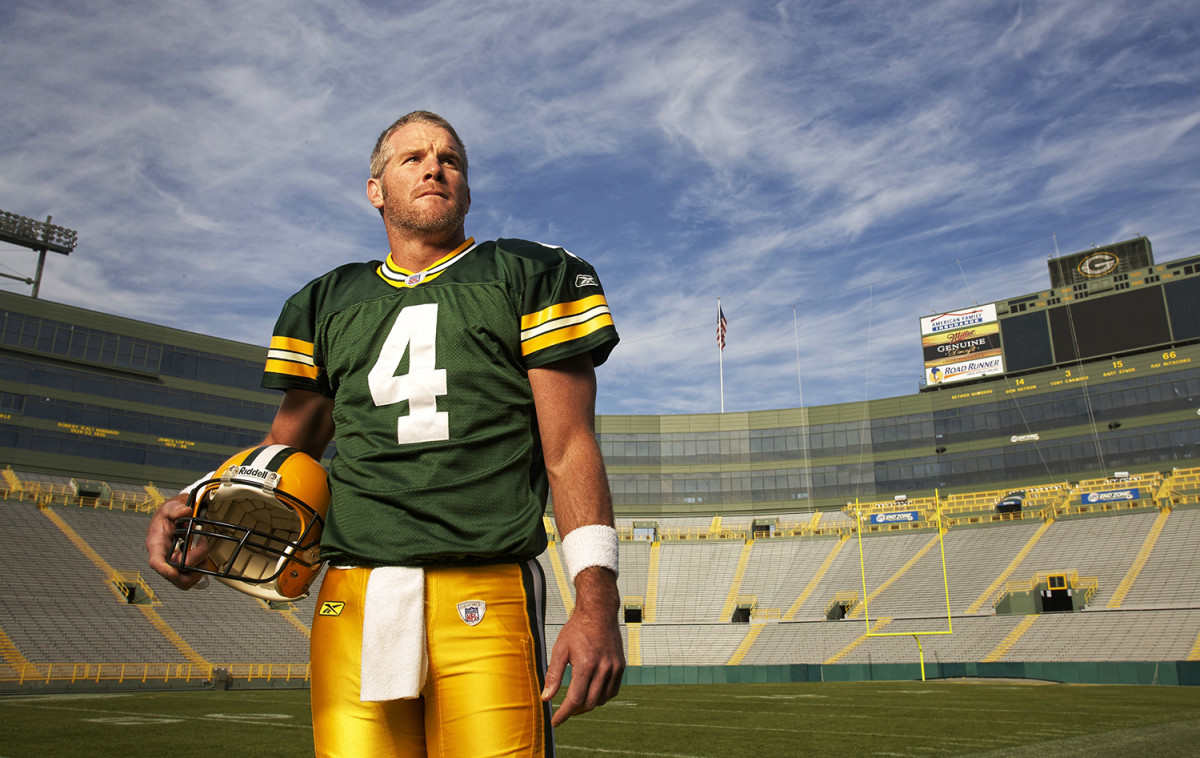
Brett Favre
Most durable quarterback ever, with a tumultuous life story that captivated America
On the heels of a gilded age of NFL football that transformed a handful of clean-shaven, golden-armed quarterbacks into Sunday staples and household stars, came Brett Favre, and the league was never quite the same again.
A rambling, freewheeling passer from Southern Mississippi known as much for gutting through hangovers as for his golden arm, Favre nabbed a far-flung chance at becoming a starting quarterback in both college and the NFL and never gave it up. When he was dealt to the Green Bay Packers from Atlanta in 1992, he netted a higher return (first-round pick) than his initial draft slot (second round), this despite throwing only four passes in Atlanta (none complete, two picked off).
In his first season in Green Bay, with the Packers steeped in an extended spell of irrelevance, Favre took over in Week 2 of ’92 for Don Majkowski and never let go. So began a stretch of 17 straight seasons in which Favre would play all 16 games, a stunning display of dedication and pain tolerance.
Favre, who admitted he did not know how to identify a nickel defense, was almost the anti-Montana or Manning. He was blunt, charismatic and, in many ways, grew up in front of America. Amid his push to become the league’s all-time passing leader (he was later overtaken by both Peyton Manning and Drew Brees), Favre battled through addiction and the death of his father, which was immortalized in an epic Monday night performance known simply as the “Dad Game.” He finished his career with typically eventful—even weird—stints in New York with the Jets and Minnesota with the Vikings. Never one to willingly give up his place, Favre made the Packers’ transition to Aaron Rodgers awkward—Favre retirement speculation was an annual pastime in Green Bay; he finally did “retire” after the 2007 season, but later said he felt pressured to do so by management, and returned to play another three seasons elsewhere, motivated through his last days in the pros by the perceived Packers slight. In his age 39 through 41 seasons, Favre completed 65.4 percent of his passes, threw 66 touchdowns to 48 interceptions and took the Vikings to within one play of the Super Bowl. As usual, Favre also took a boatload of sacks, and only after the final one—a takedown by the Bears’ Corey Wootton late in the 2010 season that left Favre briefly blacked out—did he fail to come back. It was the last play of his career.
The rift with the Packers lasted seven years. Finally in July 2015 he returned to Green Bay to be inducted into the team’s Hall of Fame—and was met by a sold-out crowd of 67,000 fans at Lambeau Field for a heartfelt reconciliation. Said Favre afterward, “It was like I never left.”
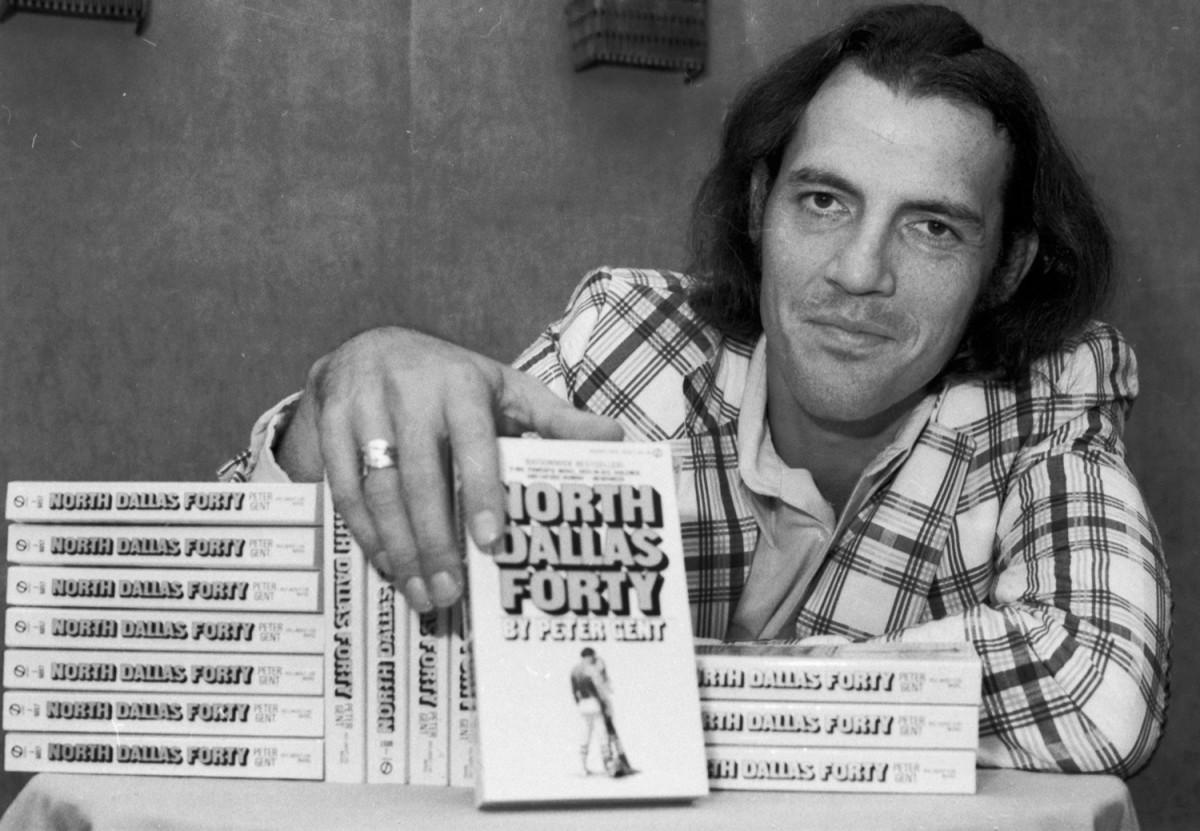
Peter Gent
Receiver who parlayed a brief Cowboys career into the novel/film North Dallas Forty, the Ball Four of the NFL
“Every time I try and call it a business you say it’s a game, and every time I say it should be a game you call it a business.” That quote, a heated barb flung by a pro football player at his coach toward the end of the novel North Dallas Forty, conveys the divide at the heart of Peter Gent’s fictionalized 1973 account of his experience in the NFL. A basketball player at Michigan State, Gent attended a tryout with the Cowboys in 1964, won a job and spent five seasons as a receiver with Dallas, splitting time as a No. 2 opposite the great Bob Hayes. Increasingly hobbled by injury (and disillusion) over those five years, Gent was traded after the 1968 season to the Giants, who waived him in the summer of ’69. It was then that he turned to writing, to attempt to capture what he’d been through.
North Dallas Forty, published in 1973, was one of a handful of books by players around that time—notably Out of Their League, the memoir by onetime Cardinals linebacker Dave Meggyesy, and major league pitcher Jim Bouton’s Ball Four—that dispensed with the anodyne, Chip Hilton-style depictions of American sports, pulling back the veil on the real, lived experience of professional athletes. In North Dallas Forty, Gent and his teammates, confronted by football’s visceral brutality, cope through booze, pot, pills, sex and various aberrant behaviors. The thinly veiled characterizations of Cowboys players and staff—Don Meredith, Tom Landry, Hayes and others are easily identifiable—caused a stir upon the book’s publication, but what lifts Gent’s novel above the level of salacious tell-all is its wider ambition.
Playing out amid the turmoil of America in the ’60s and ’70s—Vietnam war protests, racial strife, assassinations, Cold War fears—Gent aimed for a larger critique of the society that each Sunday embraced pro football’s dehumanizing violence, its infliction of pain for the public’s pleasure. The NFL, in Gent’s eyes, stood as a microcosm of the conflicts playing out in America in his era, the unpredictable, free-spirited individual in perpetual battle with authoritarianism and conformity, the team and the NFL standing in for the machine that crushes independent spirit and compels rigid adherence. Needless to say, the Cowboys did not appreciate the look.
Gent contributed to the screenplay for the 1979 movie, which smoothed out some of the novel’s rougher edges but pulled no punches in its depiction of the way in which pro football uses up and spits out players. If the Sabols, through NFL Films, glorified football’s grandeur, Gent and those like him showed fans the other side—vicious, abrasive, impersonal, demeaning. The paradox is that through it all, Gent loved the game. “I felt more in one Sunday afternoon than I did later on in whole years,” he wrote in the foreword to the 2003 edition. Like the fans, and the society as a whole, Gent embraced the contradictions inherent in that love. “There’s no greater display of everything that’s magnificent about sport in America,” he wrote, “and everything that’s wrong with culture in America.”
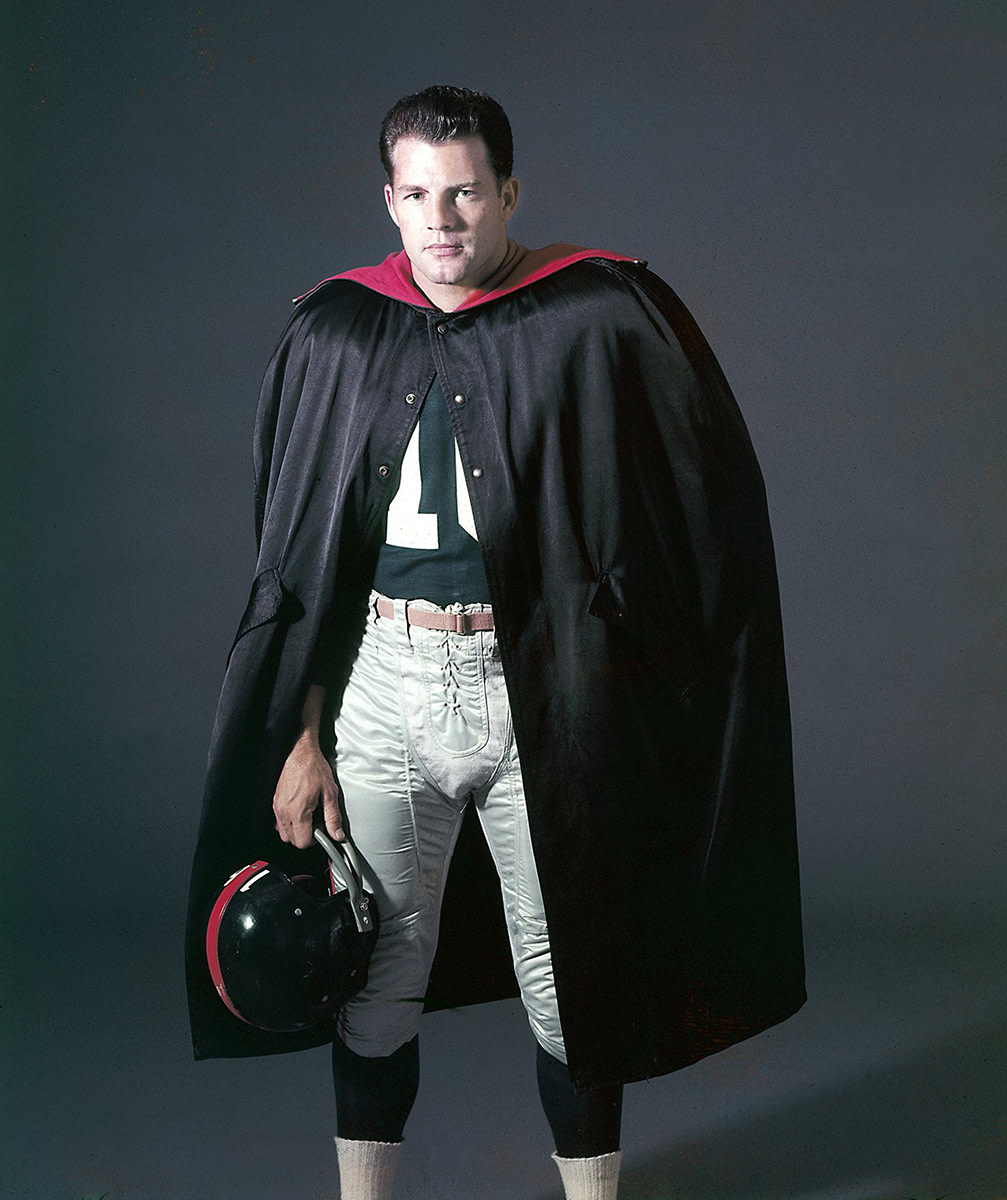
Frank Gifford
Clean-living Giants back who missed nearly two seasons after Bednarik’s knockout; later anchored MNF
Frank Gifford spent 12 years as an effective multipurpose weapon with New York Giants and 27 as a play-by-play announcer and commentator for ABC’s Monday Night Football. He began his NFL career as a shifty running back and ended it as a clutch receiver, making eight Pro Bowl appearances and playing in five NFL championship games, winning a title in 1956, when he was named league MVP. In a 1960 game against the Eagles, Gifford took a brutal high hit from linebacker Chuck Bednarik, leaving him motionless on the field. Gifford retired afterward, so damaging was the hit and so lengthy the recuperation period. But 18 months later, he rejoined the Giants, this time as a receiver.
By the time Gifford retired from the NFL for the second time in 1964, the league’s popularity was rising, and Gifford was a national star, posing for ads and hanging out with New York celebrities. Blessed with good looks and charm, Gifford transitioned seamlessly from the field to the booth at CBS, and then joined Monday Night Football in 1971 for the show’s second season, where he became the level-headed straight man in the booth to the louder and much more dramatic Howard Cosell and Don Meredith, as well as a host of other partners through the years.
Gifford died at age 84 from natural causes, and soon after, the family revealed he had chronic traumatic encephalopathy, the degenerative brain disease that can only be diagnosed posthumously and that has been found in numerous former football players. The family revealed the CTE diagnosis with the hope that more attention would be paid to medical research linking football and traumatic brain injuries.
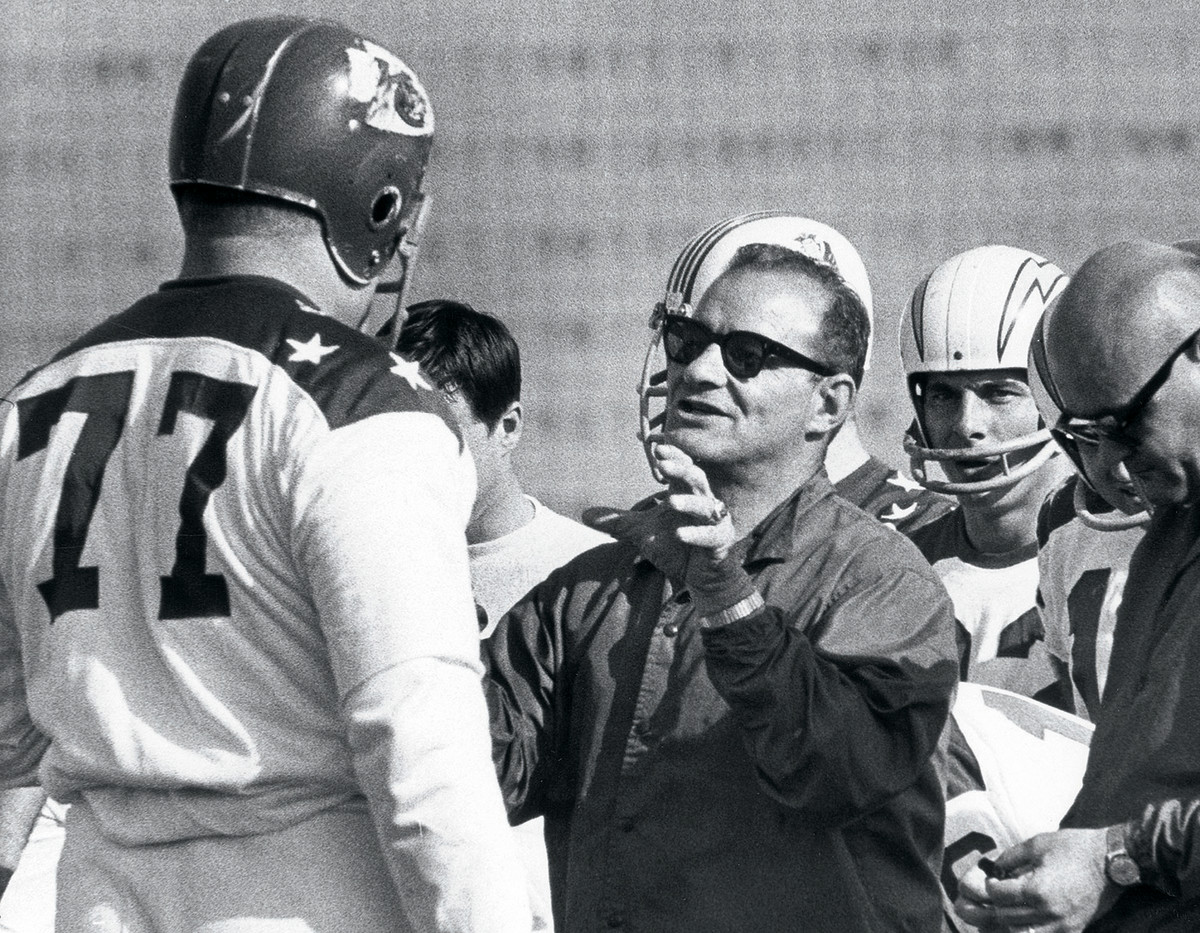
Sid Gillman
Pioneer of the modern passing game
It’s not so much Sid Gillman’s accomplishments as a head coach—five AFL Western Division titles with the Chargers, an AFL Championship in 1963, Pro Football Hall of Fame enshrinement in 1983—as the way he went about achieving them. As Al Davis, perhaps Gillman’s most noted disciple, once said, "Sid Gillman brought class to the AFL. Just being part of Sid’s organization was, for me, like going to a laboratory for the highly developed science of organized football.”
Gillman was the first to see offensive football from a predominantly aerial, vertical standpoint. He implemented a downfield-attacking offense with the Chargers that became the genesis of the modern game. His 1963 AFL title—the Chargers’ only league championship ever—was a master class, as San Diego stymied the Boston Patriots 51-10, gaining 610 yards on offense, with schemed motion to negate the Patriots’ blitzing. Gillman titled his game plan that week “Feast or Famine.”
Game-planning was Gillman’s forte. He revolutionized the endeavor by studying film. He and Paul Brown could cut and splice game film (using scissors) to analyze opponents’ strategies, and Gillman insisted on filming all of his practices so that he could later watch and grade players. He was conducting this exercise as early as the ’50s, when he was the head coach at the University of Cincinnati. In ’53, in fact, the NCAA ruled that the practice gave Gillman’s team an unfair advantage, not because the Bearcats would study film before the game, but rather, because they’d do it during the game, at halftime in the locker room.
Gillman became the L.A. Rams’ head coach in 1955. He went 26-21-1 before a 2-10 season in 1959, upon which he was fired. The cross-town Chargers of the new AFL hired him the next year—among the staffers Gillman brought in were Chuck Noll as defensive assistant and Al Davis as receivers coach—and he went 10-4 his first season and 12-2 in his second. Over his 11 years with the Chargers, Gillman was 86-53-6.
In 1992, SI’s Paul Zimmerman wrote, “The Gillman system spread like branches of a tree throughout the world of football. His assistants on those early Chargers, Chuck Noll and Jack Faulkner, took it to Pittsburgh and Denver, respectively, then Faulkner took it to the Rams as their special assistant coach. Al Davis and Al LoCasale took it to Oakland, where it rubbed off on [Bill] Walsh. Kay Stephenson, Dan Henning and Don Breaux all had been quarterbacks for Gillman at San Diego, and his ideas followed them to Buffalo and Atlanta and San Diego and Washington. As head coach at Miami of Ohio and Cincinnati, Gillman had groomed such future coaches as Bo Schembechler, [Paul] Dietzel, Bill Arnsparger, Johnny Pont and Ara Parseghian.” And that’s just the beginning of the Gillman tree.
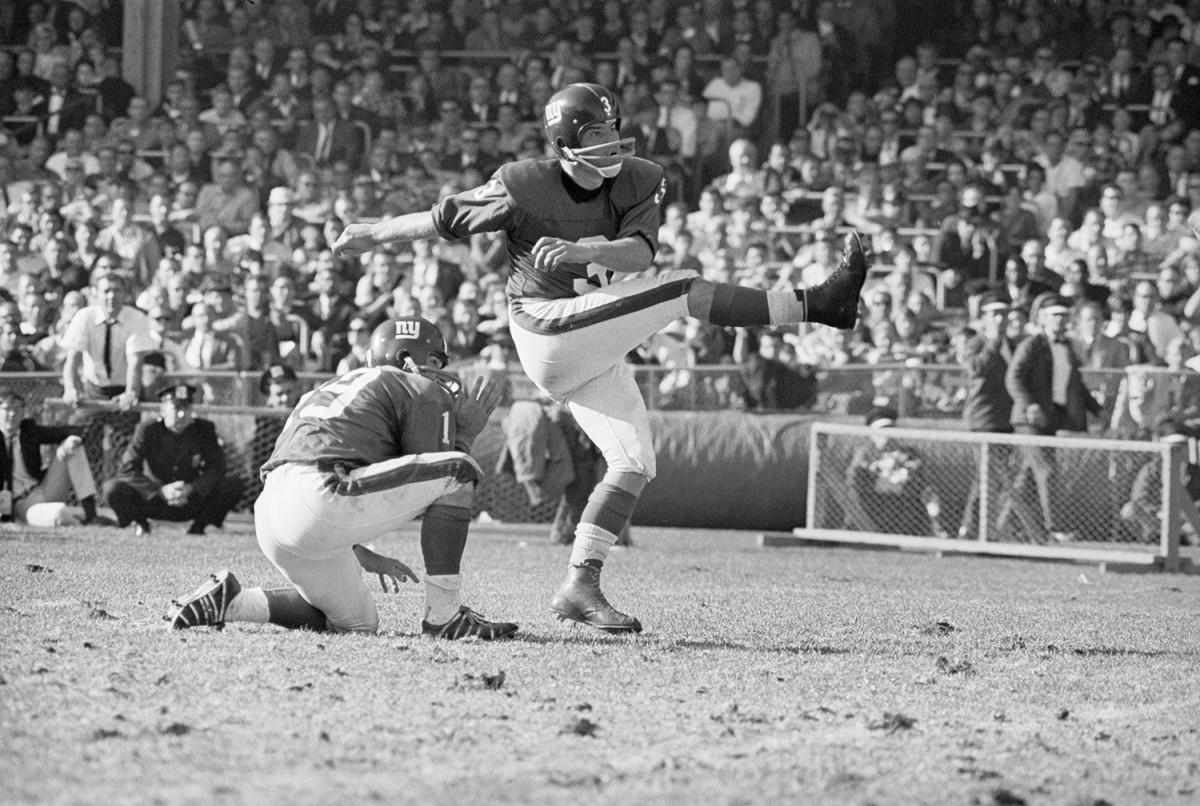
Pete Gogolak
NFL’s first soccer-style kicker
A Hungarian immigrant who came to the U.S. only to find that soccer barely existed here, Pete Gogolak ended up applying his love of “football” to the American version, and changed his adopted country’s pastime.
The first prominent kicker who approached and contacted the ball like a soccer player—from the side, with the instep—Gogolak turned heads during an era of rotund linemen/placekickers chugging up to the football and hitting it square with their toe. And there was a demand for his services.
Famously, Gogolak spurned the AFL’s Buffalo Bills after his second professional season, when his request to double his salary to a whopping $20,000 per year was denied and he crossed over to the NFL’s New York Giants. The move shattered what had been a wall between the rival leagues, eventually leading to a signing frenzy from deep-pocketed owners on both sides of the aisle. It was easier, then, to bring both leagues under one umbrella than to continually fight with another entity not bound by the same free-agent rules.
Setting off a placekicking revolution and serving as the catalyst for the eventual merger of the NFL and the AFL, the most important event in pro football’s sporting ascendance? Not bad for a guy from Budapest.
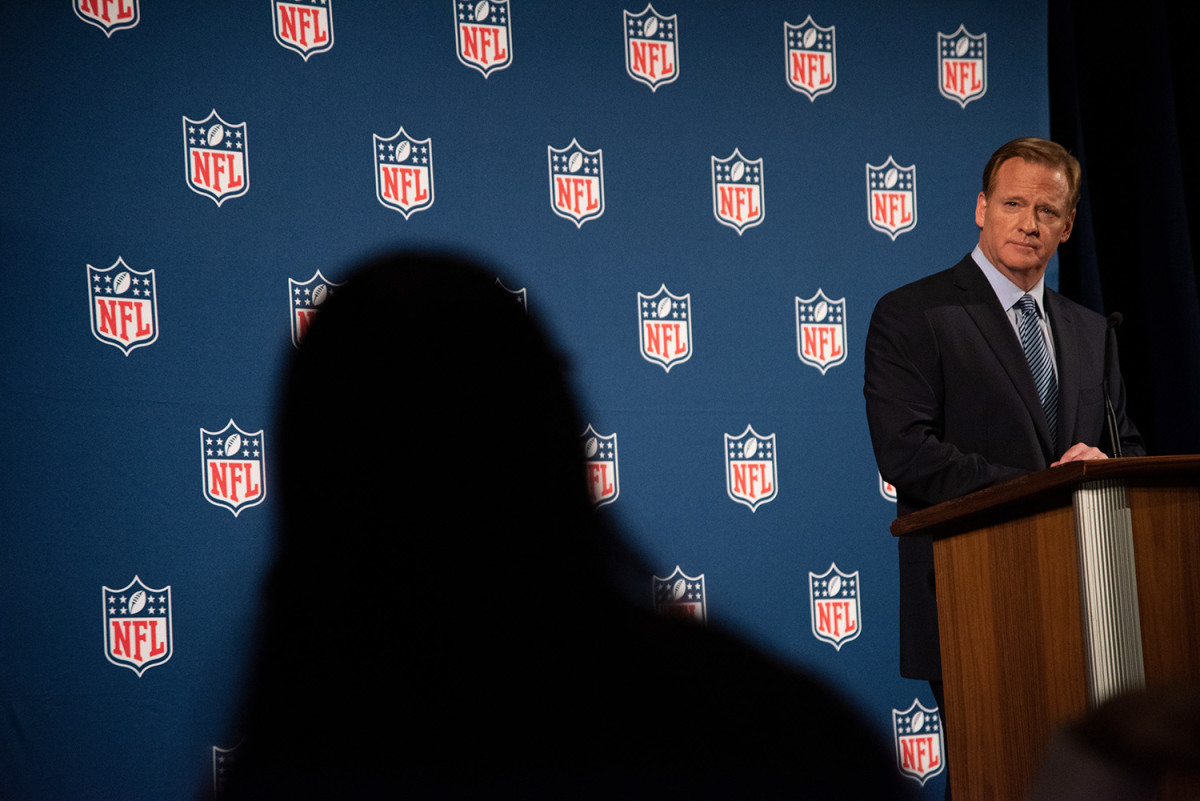
Roger Goodell
Commissioner during the league’s most tumultuous decade
Roger Goodell’s directive from owners when he assumed the job of commissioner in 2006 was to take a product that had been forged through years of elbow grease, trials and tribulations, and monetize it. Given the league’s soaring revenues over the course of his commissionership, for that alone he will undoubtedly be seen as one of the most significant figures in NFL history.
But Goodell’s legacy may end up being one of the most complicated of any prominent American sports figure. A lifer in the league office, Goodell almost immediately encountered a wrecking ball of issues when he took over that left the NFL looking flat-footed and slow to come around to modern times. Growing understanding of head trauma and its impact on retired players caused a seismic shift in the way people looked at the game. There were the Bountygate and Deflategate scandals. The was the lockout. The replacement ref fiasco. The Richie Incognito-Jonathan Martin case. There were Michael Vick and Ben Roethlisbergrer, Ray Rice and Greg Hardy. Adrian Peterson. Tyreek Hill and Kareem Hunt. There was a quarterback crisis. There is the minority coaching crisis, the wobble in television ratings, and worries over the “in-game” experience. There is legalized gambling, E sports and other myriad changes to the world and society to come. Goodell has been there throughout all of the tumult.
Given the fact that so many off-field issues overshadowed what would have been a golden age of football, it’s hard to imagine that Goodell does not have his regrets. However, the league is not without accomplishments during his time. For one, a legion of owners has held him in high regard, not only for his ability to absorb criticism that might otherwise be directed at them, but for the way he has advanced their personal interests in the face of obstacles and opposition. Stadium deals are more lucrative. Television deals are more lucrative. In any given year, almost all of the most-watched programs in America are NFL broadcasts. Ultimately, Roger Goodell’s legacy may be defined by his ability to keep it that way.
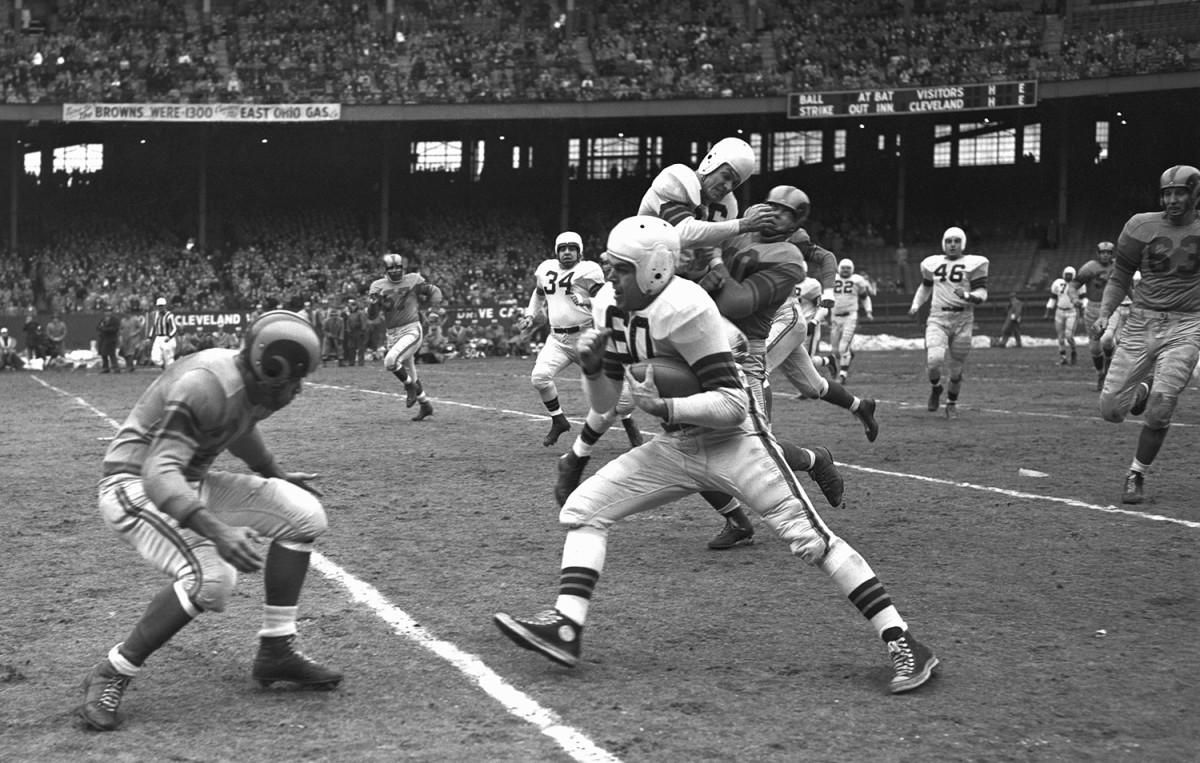
Otto Graham
Seven-time champion (AAFC, NFL) as Browns quarterback
The Browns are one of two non-expansion teams, with the Lions, that have never appeared in a Super Bowl. But long before they were known for their ineptitude, the Browns were a very, very successful team. Northwestern halfback Otto Graham was the first player signed to the brand-new Browns franchise (of the upstart All-American Football Conference) in 1946, and team co-founder and coach Paul Brown converted him to quarterback. Graham quickly took to the T-formation and led Cleveland four straight AAFC championships.
When the Browns were absorbed, along with the 49ers and Colts, by the NFL—assumed to be a more competitive league—in 1950, commissioner Bert Bell wanted to give them an immediate challenge. He scheduled their first game against the two-time defending champion Philadelphia Eagles. Graham’s first pass in the NFL was a touchdown, and Cleveland ended up crushing Philly 35-10, with Graham throwing for 346 yards and three touchdowns. The test was passed.
Graham led the Browns to the championship game in each of their first six seasons in the NFL, winning in 1950, ’54 and ’55, after which he retired—meaning he played in a league championship game every year of his pro career. Graham also never missed a game over those 10 seasons. Any debate about the most accomplished quarterbacks in league history has to include him.
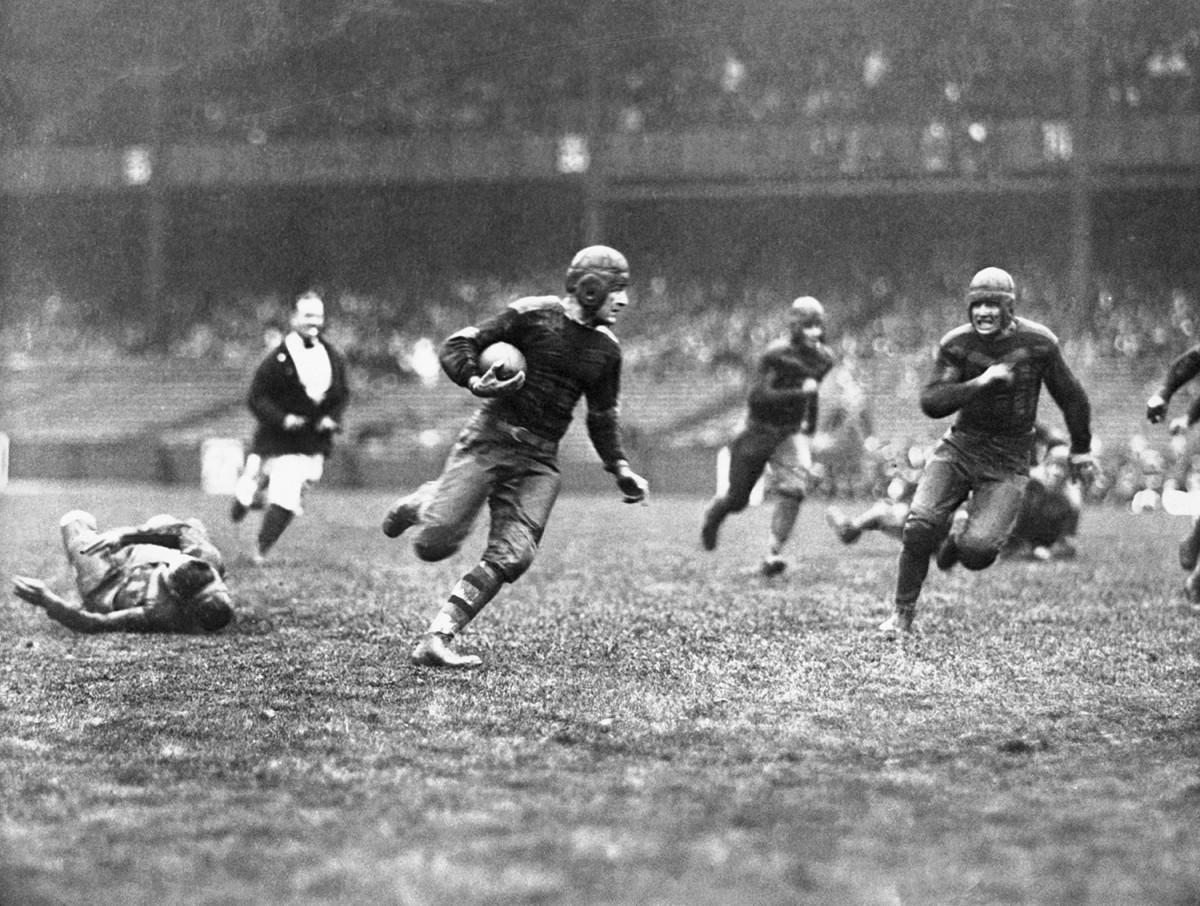
Red Grange
1920s college star whose move to the NFL lifted the profile of the pro game
Harold “Red” Grange was the first player to drop out of school to turn professional. In 1925, when Grange left the University of Illinois to play with the Chicago Bears, the NFL was a pale imitation of the college game and struggled to attract crowds. Grange was the college game’s biggest star, a three-time All-America running back at Illinois dubbed the “Galloping Ghost” by reporters. So, before the 1925 college football season, C.C. Pyle, a movie theatre manager in Champaign, Ill., approached Grange with a proposition. How would he like to earn $100,000? Pyle orchestrated an unprecedented contract with the Bears that would bring the college star to the NFL for a 19-game, 66-day cross-country tour during the winter of 1925-26. With the contract, Pyle became the first real football agent, and Grange received a cut of the gate receipts for all the games played on the barnstorming tour. In his first eight games as a pro, Grange played before an estimated 200,000 fans, including upwards of 70,000 at the Polo Grounds against the Giants. Babe Ruth was there to watch, as were some 100 sportswriters. His star power boosted pro football and made it a sport to watch. Grange’s sudden shift from college to the pros also had an impact on the relationship between colleges and the NFL, ultimately leading to the creation of the NFL draft.
Grange made $20,000 when the Bears played Philadelphia during that tour, and another $20,000 when they played New York, amounts unheard of in an era when most players hardly made $100 per game. In 1926 Grange and Pyle formed a rival league to the NFL, and Grange played two seasons for the New York Yankees of the American Football League. In ’27 he suffered a serious knee injury and was never the same runner. Still, rejoining the Bears in ’28, he played for six more seasons, winning championships in 1932 and ’33 and twice being named All-Pro. Like other sports stars of his (and our) time, he capitalized on endorsement deals and appeared in Hollywood movies. Grange was a star of his era on par with Ruth and Jack Dempsey, and while his pro career never came close to matching what he’d done in college, his simple decision to get paid to run the ball had a colossal impact on the evolution of the sport.
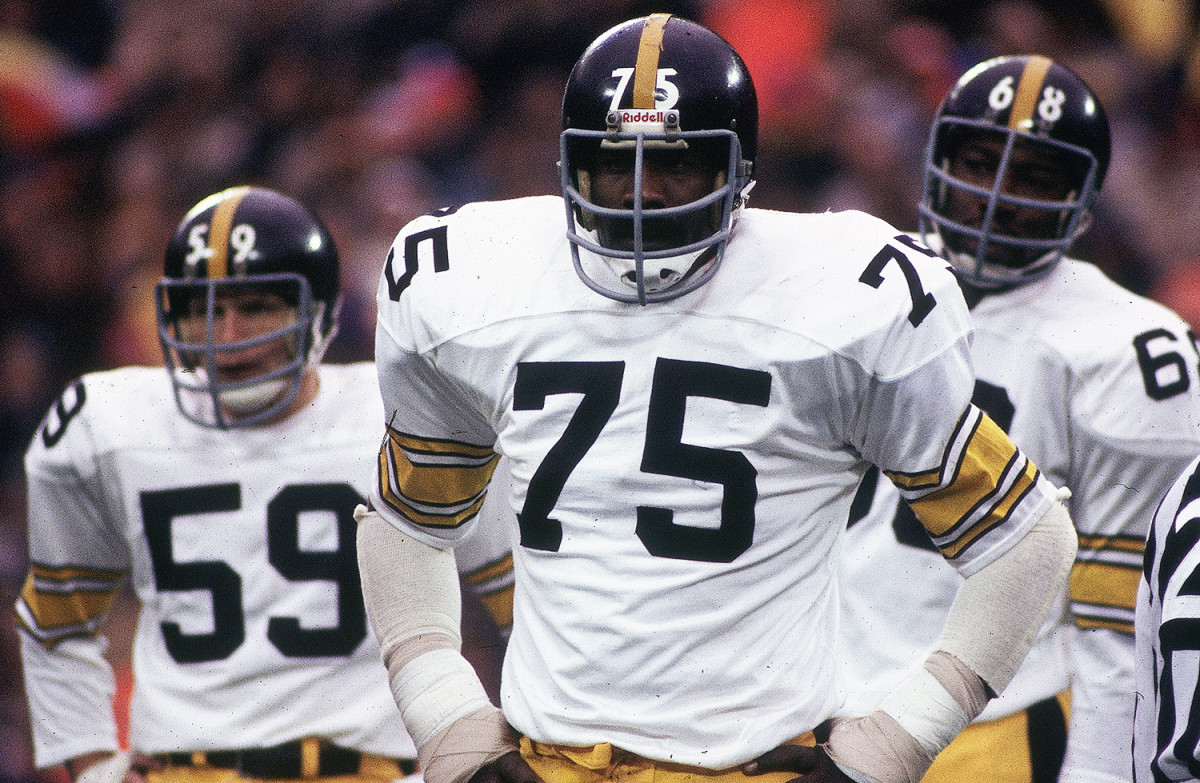
Mean Joe Greene
Anchor of Pittsburgh’s Steel Curtain defense and star of a classic Coke commercial
The Pittsburgh Steelers of the ’70s won four Super Bowls in six years, sent nine players to the Hall of Fame and set the standard for NFL dynasties in the Super Bowl era. It all started with Joe Greene.
Steelers scouts were split on Greene in the lead-up to the 1969 draft—so overpowering was he at North Texas State that they found it hard to measure his true talent, or his passion. But new coach Chuck Noll had no doubts, taking Greene with his first pick (fourth overall), coaching him up and building a generational defense around the 6'4", 275-pound defensive tackle. Greene terrorized quarterbacks and ball-carriers throughout the decade, making the Pro Bowl in each of his first 11 seasons, earning four All-Pro nods and winning Defensive Player of the Year twice. Noll’s specially designed “pinch” defense aligned Greene at an odd angle to the center, taking advantage of his unique blend of strength and nimbleness to dominate the middle of the line. In Pittsburgh’s first Super Bowl win, the Steelers held the Vikings offense to 17 rushing yards and zero points; Greene had an interception and a forced fumble and recovery.
Plagued at times by neck trouble, as in the playoffs in January 1976, Greene was sometimes “more of a mental deterrent than a physical obstacle” to opponents, as SI’s Mark Mulvoy wrote. Indeed, his very presence lifted Pittsburgh—the team and the city—and commanded both fear and respect. Said Lynn Swann in a 1975 SI profile of his teammate, “Last year somebody clipped him and he stomped on the guy’s head. The referee ran up to him, says, ‘Mr. Greene!’ Not ’75,’ like he’d say to anybody else. ‘Mr. Greene!’” About that nickname: Greene said it arose during college when North Texas State fans started calling their defense the Mean Green and naturally shifted it over to their big defensive lineman. But Greene was known on occasion to break a few teeth, twist a foe’s a helmet off or supply a strategic kick. “I'd grab a face mask only in a fit of anger,” he told SI’s Roy Blount in that ’75 profile. “Uncontrolled anger is damn near insane.”
So it was a stroke of genius to cast Greene against type in one of TV’s most memorable commercials. A battered warrior limping to the locker room, Greene begrudgingly takes a Coke from an admiring kid, and tosses the awestruck fan his jersey return. The ad, which aired during the baseball playoffs in 1979 and on the 1980 Super Bowl telecast, won a Clio Award and has been named one of the 10 greatest commercials in history. “It pulled the mask off the gladiator,” said writer Gary Pomerantz, calling it, “a monument of brisk, effective, dramatic storytelling.”
It also changed Greene’s life. “I was suddenly approachable,” he said in 2014. “Little kids were no longer afraid of me, and older people, both women and men, would come up and offer me a Coke.”
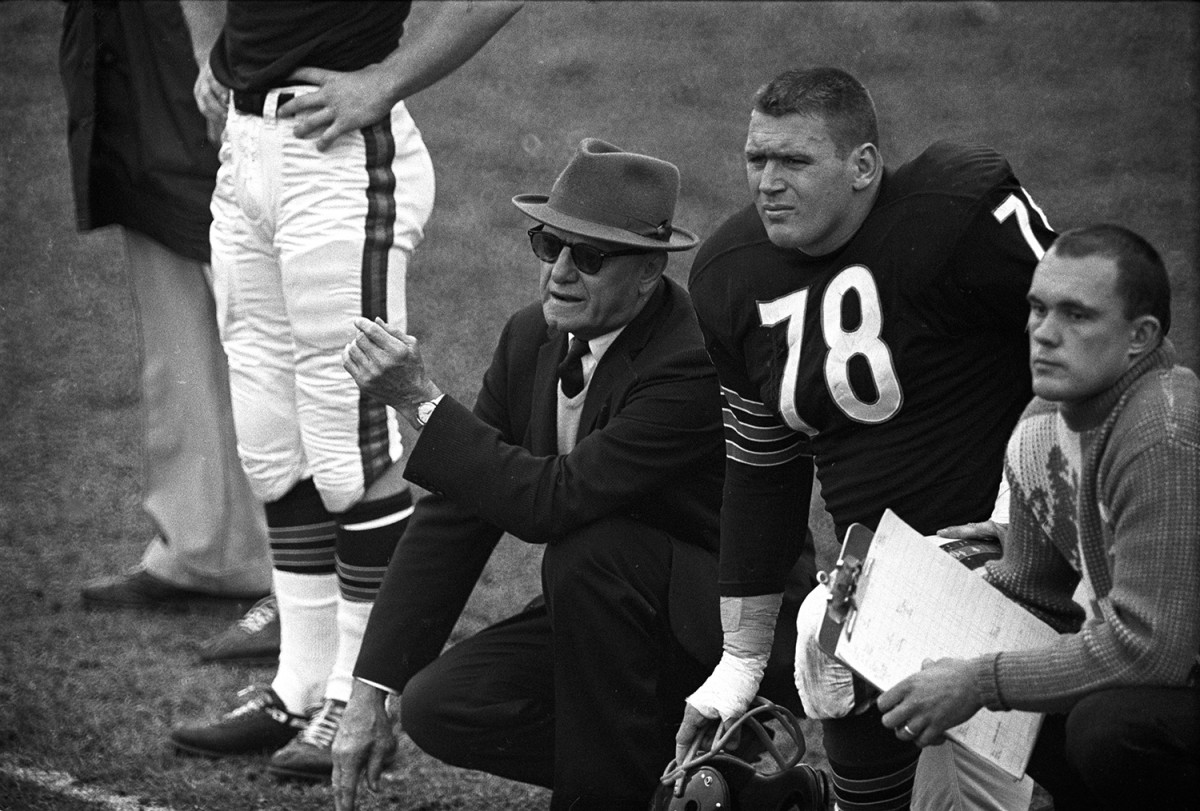
George Halas
League co-founder; owner, coach and patriarch of the Bears
Three-time coach of the Chicago Bears, an eight-time NFL champion, captain in the Navy, outfielder for the New York Yankees—there are few who could claim a more significant footprint across the field of athletics than George Halas.
But it was his time as the coach and owner of the Bears that will leave the most lasting impact. The NFC championship trophy is still named in his honor. Like Paul Brown, Halas was early to the use of film and the deployment of assistant coaches to help him see the game. He would go on to coach 497 games, winning 318 of them.
He was from a golden age of professional football and, in its infancy, had to make decisions for the betterment of the fledgling league and sport rather than to deepen the financial interests of the owners. Halas was an early voice in the movement to charge fans admission and to use that revenue to compensate players. He was a fixture in all aspects of the budding game, including in the communications department and sales. He was also a proponent of sharing revenue to aid smaller markets and the creation of a draft, which would prevent the larger cities from building a singular pipeline from the collegiate game. His oldest daughter, Virginia Halas McCaskey, remains the principal owner of the team, keeping the legendary Halas name alive, as a direct link from the Hupmobile showroom in Canton where her father drew up plans for a pro football league to the powerhouse that dominates the American sports landscape today.
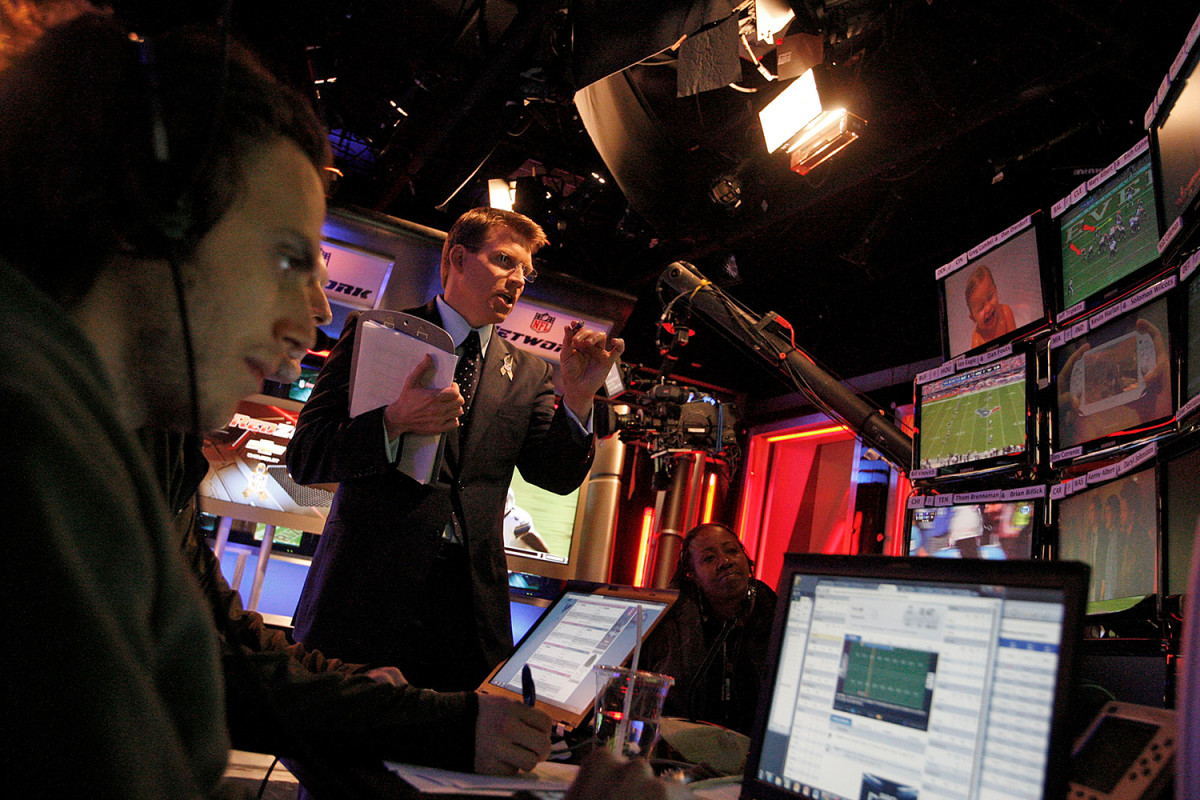
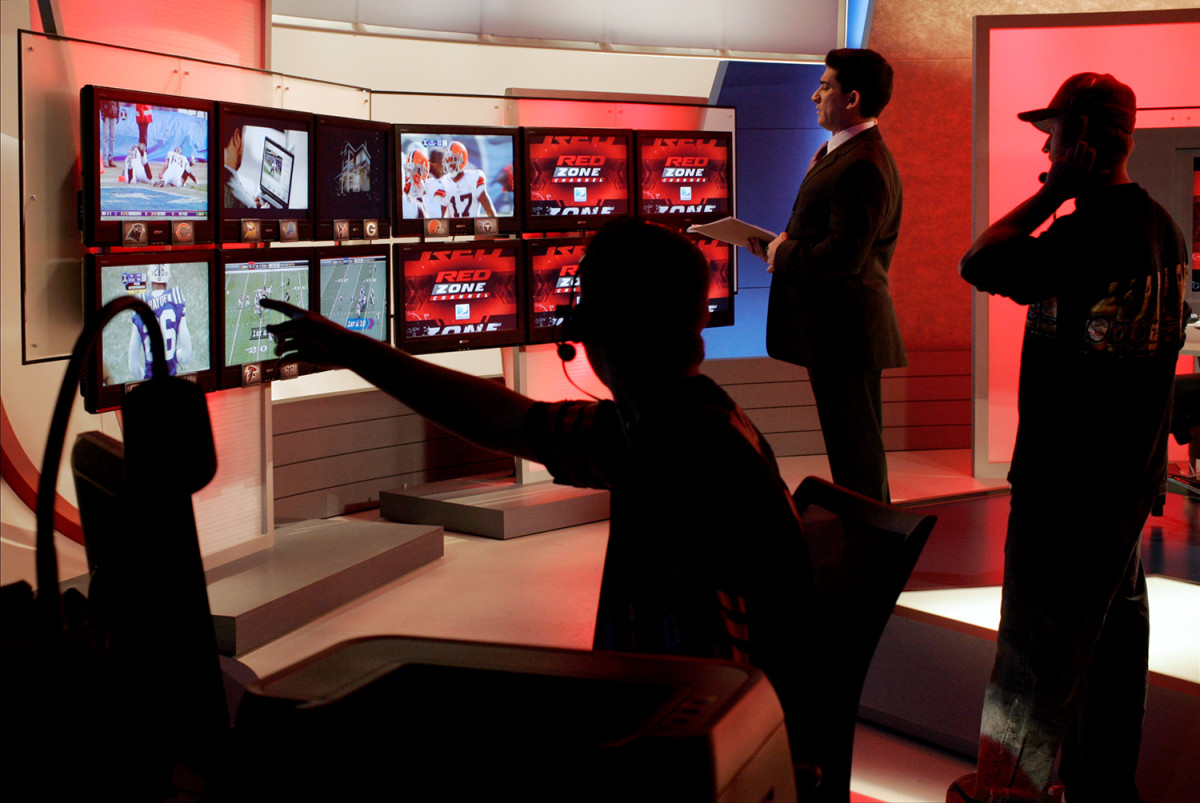
Scott Hanson and Andrew Siciliano
Hosts of transformative (and rival) Red Zone broadcasts
It’s remarkable how much of the NFL’s growth over its first 100 years is a direct result of changes in the media that affect how fans consume the game. With that in mind, it’s hard to understate the importance of DirecTV’s Red Zone Channel and its spin-off NFL RedZone on the modern fan experience. It’s tempting to credit the innovator who first dreamt up the concept of a live, commercial-free, whip-around highlight show on 17 glorious Sundays each year—a News Corp. exec named Eric Shanks hit on the idea after seeing a whip-around soccer show in Italy—but Scott Hanson and Andrew Siciliano have become the platform’s avatars, representing broadcasts that revolutionized the way so many viewers spend football Sundays.
The 1990s were not that long ago, but think about how NFL fans followed their favorite players and teams back then. There were fewer prime-time games, and viewers relied on occasional “game breaks” and evening highlight shows for a taste of what was going on. If you didn’t live in your favorite team’s market, good luck getting an update.
Now fans can essentially watch up to 13 Sunday afternoon games in one full helping. We can keep tabs on fantasy teams and parlays, every touchdown, and anything else deemed highlight-worthy. Older fans can only wish they were able to see the careers of Jerry Rice, Barry Sanders or Sammy Baugh in the octobox.
Here’s one last way to think about the incredible tonnage of air time: If you watched John Madden call one game a week for 30 years, you could spend as many cumulative hours on your couch watching Siciliano or Hanson narrate live game action in half as many years. They have educated and influenced an entire generation of football watchers, and done it all without ever teasing what would come up after the next commercial break.
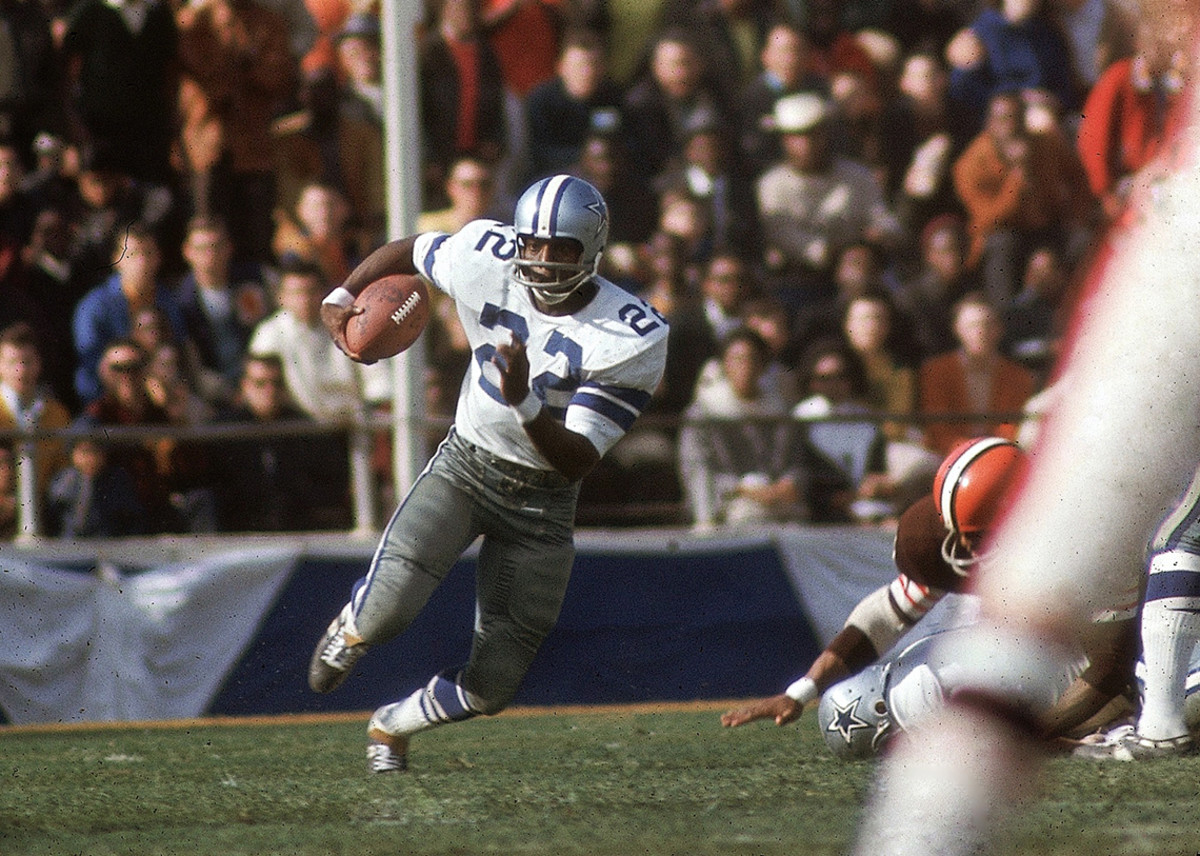
Bob Hayes
Olympic 100-meter champ who brought mind-blowing speed to the NFL game
The first of the field-stretching receivers, Bob Hayes remains the only person to win both Olympic gold in track and field and a Super Bowl. A football star at Florida A&M, Hayes moonlighted as a sprinter, setting college records at historically black school meets across the South but rarely gaining invites to major events at barely segregated large universities. When Hayes was chosen to represent the U.S. at the 1964 Tokyo Olympics (where he would win gold in the 100-meter dash and the 4x100), President Lyndon Johnson was moved to ask his football coach, Jake Gaither, if Hayes could have some time off from the gridiron. “But Mr. President,” Gaither said, “Bob is a football player. He just happens to be the World’s Fastest Human.”
The man with that lofty nickname was drafted by the Cowboys in ’64 (one spot ahead of Wichita State lineman Bill Parcells) and played 10 seasons for Dallas. An immediate difference-maker, Hayes topped 1,000 yards and led the league in TD receptions in each of his first two seasons, and was twice named All-Pro. In 1970 he averaged an eye-popping 26.1 yards per catch, a figure that no receiver since has matched.
Hayes heralded a wave of sprinters entering the NFL, but his biggest impact was on the shape of defenses. Since he destroyed man-to-man and rudimentary zone coverages, “coaches came up with a double zone to try to control him,” SI’s Paul Zimmerman wrote. “A cornerback would play him tight as he came off the line—in those days defenders could do anything they wanted to a receiver, except grab and hold—and another defensive back would pick him up deep. Or coaches would assign the deepest defensive back, usually the free safety, to make sure he stayed behind Hayes, which opened up vast areas underneath. No other player caused that kind of strategic overhaul of the defensive game.”
Hayes hit hard times in retirement, and the 10 months he spent in jail on a drug trafficking charge likely delayed his Hall of Fame induction. He died from kidney failure in 2002 at age 59, having finished his degree in education at FAMU. In 2004 the Hall’s Seniors Committee nominated him for induction, but his candidacy failed the final balloting, after which Zimmerman resigned from the committee in disgust. Hayes finally earned induction in 2009.
Wrote former ESPN and Sports Illustrated scribe Ralph Wiley: "Oh, sure, there was speed in football before Bob Hayes. There just wasn't that much of it. Not track speed, warp speed, world-class speed, we-better-think-of-something-now jets."
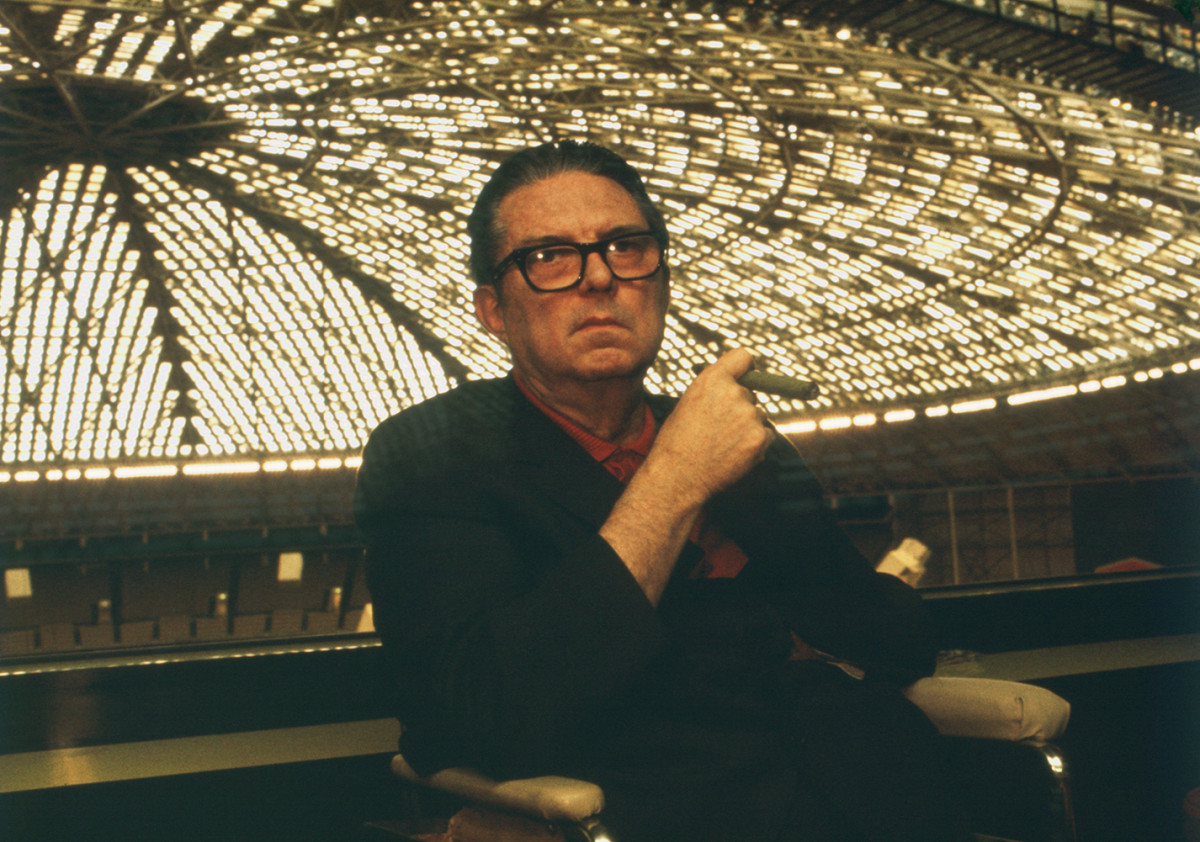
Roy Hofheinz
Driving force behind the Astrodome, pro sports’ first indoor stadium
Before there was the ridiculous football space station in Dallas, or the opulent, robotic roof that opens and retracts over the Falcons in Atlanta, there was the Astrodome in Houston. And there was Roy Hofheinz.
The age of stadium design and, in many ways, the perception surrounding a team, a town and a franchise after a new stadium is built, changed when the former mayor of Houston pushed for and secured a concept that would change professional sports as we know it: a building that could, theoretically, host anything.
Hofheinz said he hit on the notion of a covered stadium after visiting Rome’s Colosseum, which featured retractable awnings to protect the crowd from the elements, and when a group that included Hofheinz was awarded a major league baseball franchise in 1960, it was realized that the city’s hot, humid summers would necessitate an indoor venue. Built at a cost of $35 million, the Astrodome opened in 1965 and was immediately heralded as a modern marvel. Dubbed “the Eighth Wonder of the World,” it boasted features that would become an essential part of the modern stadium experience, including high-end luxury suites, air conditioning, synthetic turf and an animated scoreboard that was the early forerunner of the massive video screens in every new stadium. It was the home of the Astros from ’65 until 1999, and the Oilers from 1968 until their move to Tennessee in 1997.
Before stadium building became another heartless money grab for the American plutocracy, Roy Hofheinz’s Astrodome was a genuine source of civic pride and national curiosity.
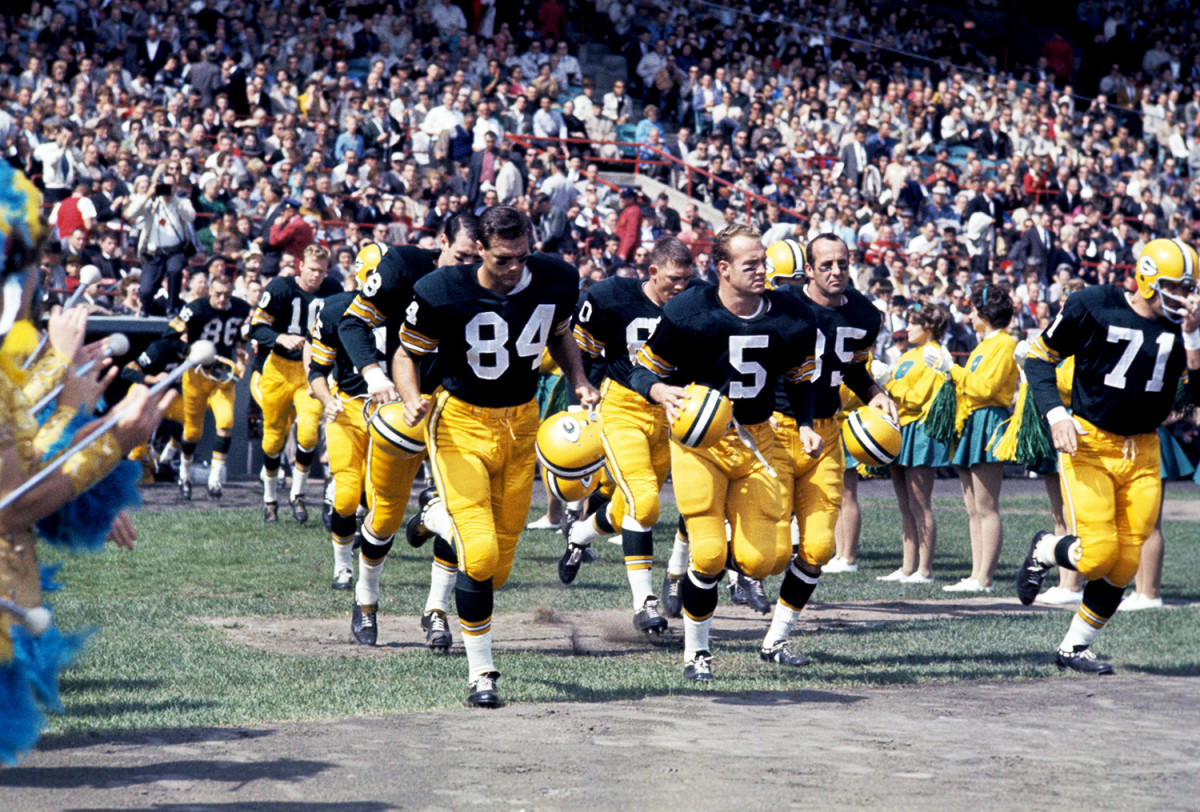
Paul Hornung
Packers golden boy who was suspended a season for gambling
Paul Hornung was so beloved, so revered and so consequential to the NFL that despite being suspended by the league indefinitely in 1963 for gambling on games (the cardinal sin of sports!), The Golden Boy’s reputation would go undamaged in the annals of the league. Hornung was one the first true superstars in the NFL, “a man who lived long nights, indulging a voracious appetite for excess,” as SI’s Tim Layden wrote in 2002. “He was Namath before Namath.” How big a star was he? When Hornung was called to active duty in the Army in 1961, coach Vince Lombardi privately petitioned President John F. Kennedy to grant Hornung a weekend pass to play in the New Year’s Eve NFL Championship Game game. The President obliged, and Hornung scored 19 points—a touchdown, three field goals and four extra points—in the Packers’ 37-0 victory over the Giants.
When the league suspended Hornung for betting on games, he accepted his punishment—but he also threatened Pete Rozelle by saying he’d go to the U.S. Senate and reveal the league’s much larger gambling problem. That incident was a mere blip on Hornung’s Hall of Fame career. He first rose to prominence as a quarterback at Notre Dame, where he won the Heisman Trophy and earned his Golden Boy nickname for his blond locks and the Golden Dome of South Bend. Drafted first overall by the Packers in 1957, Hornung switched to halfback (he also did some placekicking) and led the league in scoring in three straight seasons; in 1960, in just 12 games, his 176 points set an NFL record that stood for 46 years. The following year he was named league MVP.
On a Packers dynasty that dominated the NFL for a decade, a team that was stocked with Hall of Famers at every position, it was Hornung who stood out as the most important member. “The Packer team takes its cues from Hornung, a natural leader,” wrote SI’s Tex Maule in 1964. After Hornung languished for his first two seasons, splitting time between halfback and quarterback, Lombardi turned him into the fulcrum of the offense, the point man for the famed Green Bay power sweep. During his career, Green Bay won four NFL championships and the first Super Bowl (though he sat it out with a pinched nerve), cementing his legacy as one of the most important figures in NFL history.
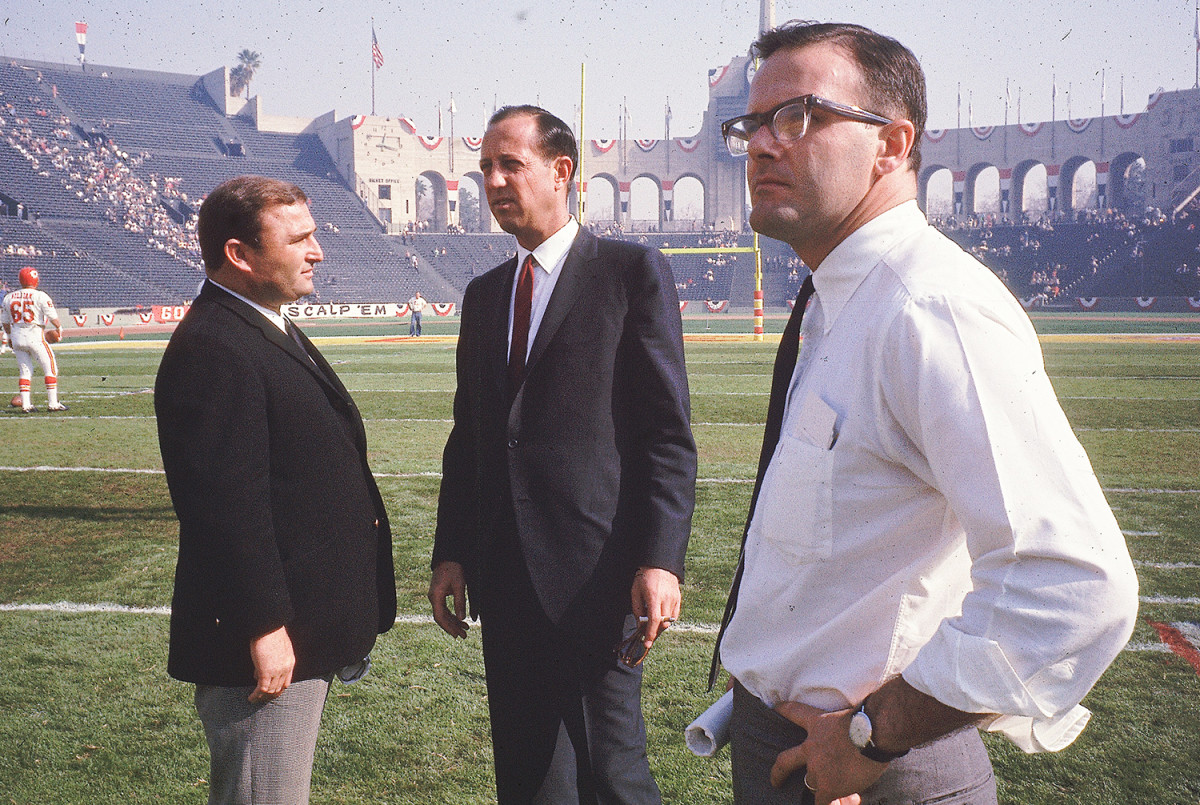
Lamar Hunt
AFL founder and patriarch of the Chiefs
The son of oil tycoons, Lamar Hunt was a football player in spirit but a budding sports entrepreneur in reality.
After becoming the first owner to bring professional football to Dallas (with the Texans of the AFL), Hunt was chased from his hometown after the NFL injected the Cowboys into the market and nabbed a majority of the fan base. However, that led Hunt to Kansas City, where he changed the team’s name to the Chiefs and presided over one of the league’s iconic franchises.
A down-to-earth presence until his death, Hunt was known for printing his phone number in the media guide and refusing to be called an owner long before NBA teams began questioning the weight of the language. Jerry Jones considered Hunt a mentor, and Hunt was credited as being one of the foundational visionaries behind the modern NFL.
Hunt also had a bit of a Forrest Gump fingerprint across all American sports, boasting an initial investment in the Chicago Bulls and a strong hand in the initial migration of professional soccer to America. The AFC championship trophy, awarded to the Super Bowl contender from that conference, is named in his honor.
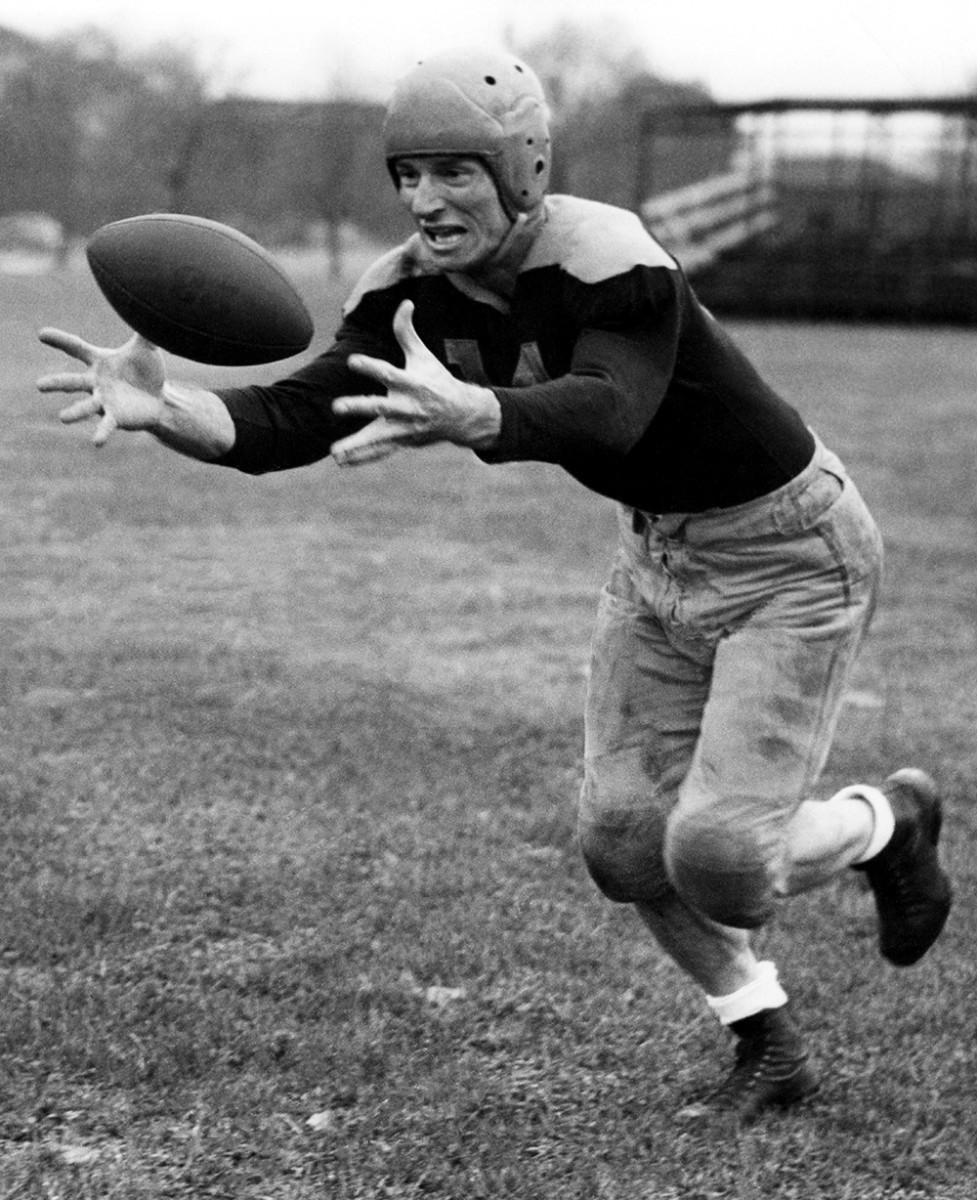
Don Hutson
Record-setting Packers receiver who was decades ahead of his time
In an era still paced by the running game, there were teams that believed they had occasional receiving threats, and there was one team that had Don Hutson. The difference was vast.
The Packers receiver caught a touchdown on nearly 20 percent of his receptions throughout a stellar 11-year career from 1935 to ’45. At least once per season, and often far more often, he would rip the top off unsuspecting defenses for a long touchdown using his sub-10-second sprinter’s speed. However, it was the nuance that Hutson applied to his route-running that sealed his place in football history and made him a member of the inaugural Hall of Fame class in 1963.
His coaches described the subtleties to his route-running—head fakes, shifts, double moves—as ideas from a different era. Though the game wasn’t examined and dissected with the same fervor as it is now, Hutson may be considered the godfather of modern route-running, breaking through the archaic, angular paths taken by receivers of the time. He also caused a rise in double and triple coverage in pass defenses, another revelatory development for coaches and coordinators who never thought there would be a need to devote additional help to receivers who barely got the football. Hutson led the league in receiving eight times, and his career mark of 99 touchdown receptions stood for an astounding 44 years.
Known as the “Alabama Antelope,” Hutson carved a path through the foundational era of football. A teammate of Bear Bryant at Alabama and a student of Curly Lambeau in Green Bay, Hutson went on to serve as an assistant coach of the Packers for several seasons before exiting the game in 1948 to a life in the business world. In that way, he already had a solid head start. Before signing his first contract with the Packers, Lambeau reportedly had to break the bank for Hutson to lure him away from baseball. The offer? $300 per game.
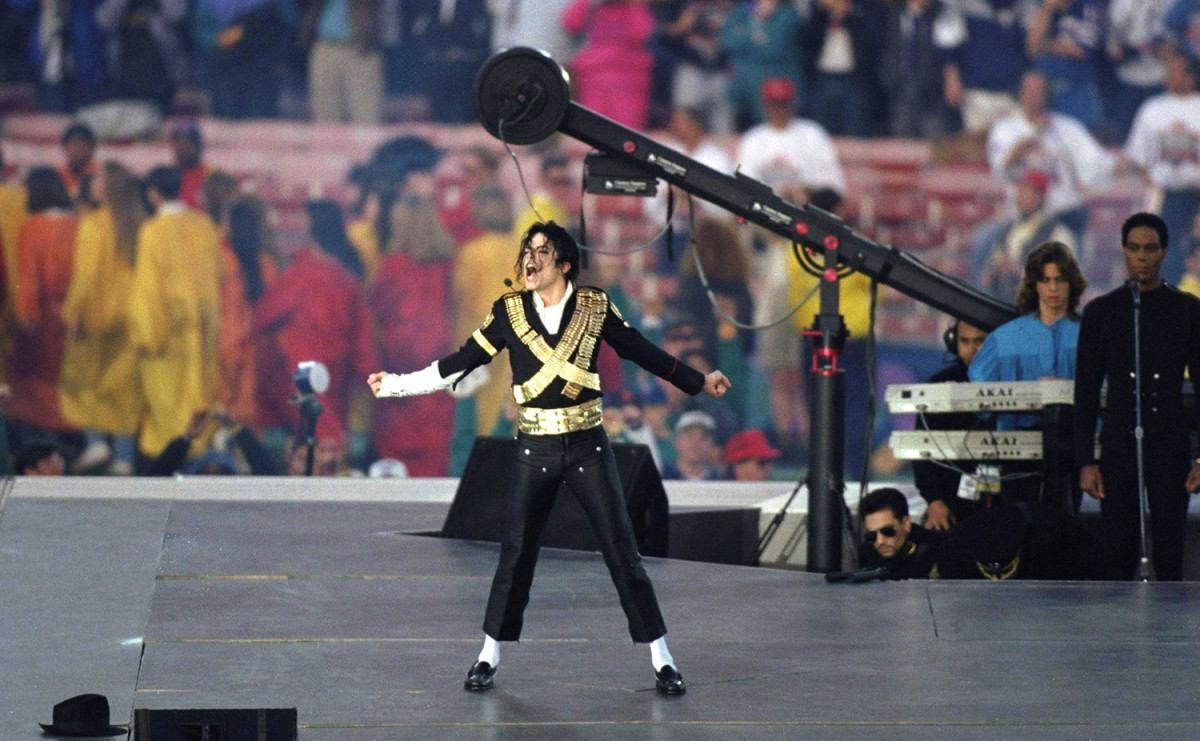
Michael Jackson
“King of Pop” who turned the Super Bowl halftime show into a major standalone event
Michael Jackson exploded through the floor of the stage at the Rose Bowl. A machine called the Toaster launched him eight feet into the air. He tucked his knees and landed gracefully and then just stood still, holding the moment and the anticipation for a minute and 35 seconds as the crowd at Super Bowl XXVII erupted in cheers. At the sound of a guitar solo, Jackson slowly removed his sunglasses, and started into his song “Jam.” He moonwalked and spun and kicked to “Billie Jean” and “Black or White” and pulled off a crowd stunt during a “We Are the World” segment in which fans held up cards to reveal cartoon images of children holding hands. The NFL had never before seen a performance quite like it.
Before Jackson, Super Bowl halftime was the domain of marching bands, aging crooners, cheesy “salutes” (… to the Caribbean! … to Hollywood!) and the milquetoast Up With People ensemble. It was far from must-see TV, so run-of-the-mill that it often wasn’t even televised. In 1992, Fox (not yet an NFL broadcaster) directly challenged the CBS Super Bowl telecast with strategic counterprogramming; its airing of the popular comedy show “In Living Color” just as the game went to halftime reportedly caused CBS’s audience to drop by 22% for its tepid “Winter Magic” show.
Jackson, a global superstar whose career had yet to be tarnished by accusations of child molestation, was tapped for the following year. His electrifying performance proved that halftime could be as big as the game itself and, crucially, draw non-football viewers—the TV audience for that year’s halftime show was actually higher than for the first-half football action between the Cowboys and the Bills that had preceded it, as people tuned in specifically to see Jackson’s 13-minute performance. It took time for the phenomenon to cement itself—there were still some bizarre themed shows in the ’90s—but in the years ahead Super Bowl halftime would boast the likes of U2, Prince, the Rolling Stones and Beyoncé.
But that’s not the only influence Jackson had on the history of the NFL—he also played a role in the shaping of the Patriots dynasty. In 1984, team owner Billy Sullivan's son Chuck—who dabbled in music promotion and who ran Sullivan Stadium—financed the Jackson brothers’ Victory Tour, using the stadium as collateral. The tour was a financial disaster for Sullivan, who eventually went bankrupt. In 1988, Robert Kraft, who’d previously bought up much of the adjacent land, snapped up Sullivan Stadium for $25 million; six years later, with the struggling franchise in danger of moving to St. Louis, he bought the Patriots outright. We all know how that turned out.
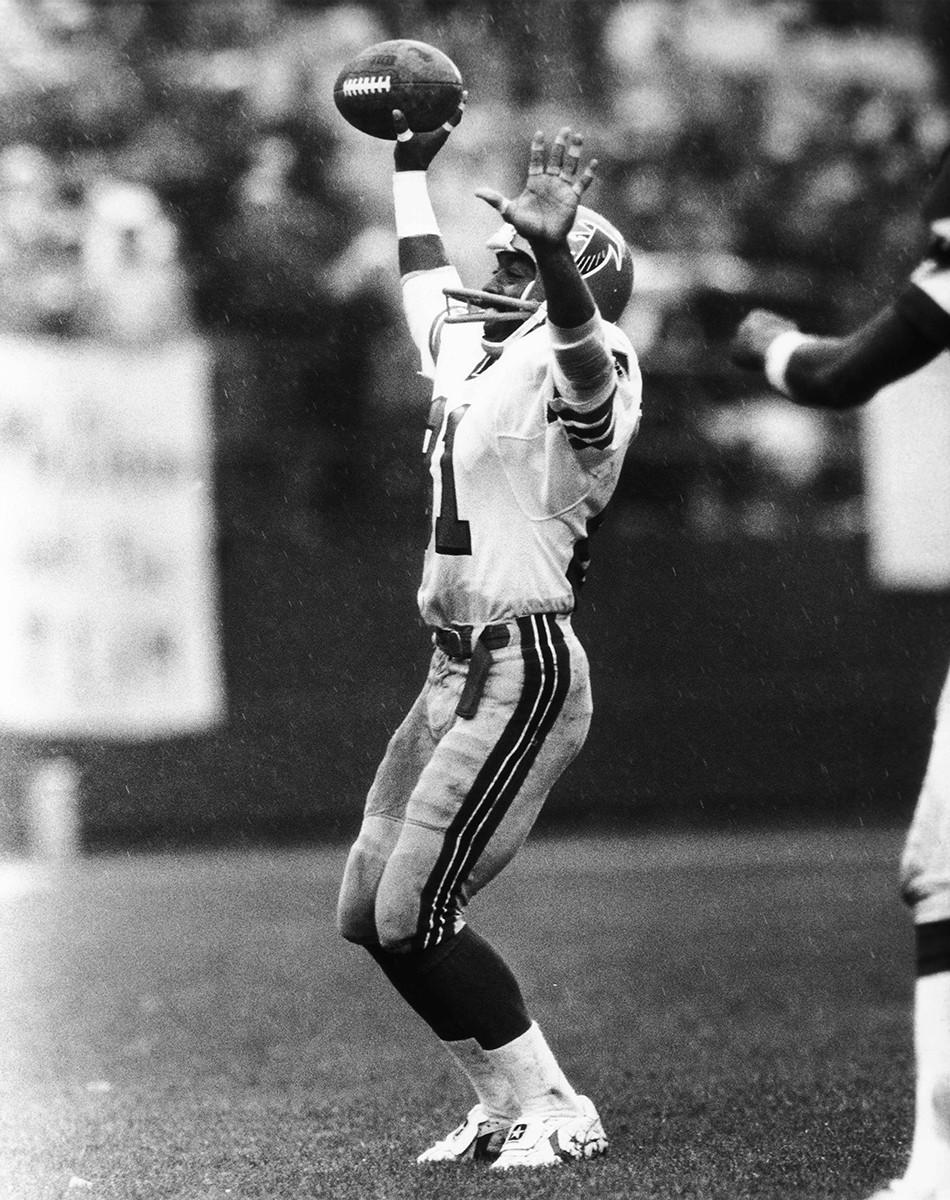
Billy “White Shoes” Johnson
Famed return man whose touchdown celebrations set off a phenomenon
In the early days, six points were mostly celebrated with a handshake, maybe a hug. Then in 1965, Giants receiver Homer Jones pioneered the still-popular spike. But it was Billy “White Shoes” Johnson in the ’70s who made touchdowns a cause for flamboyant expressions of sheer joy.
As a receiver and return man at Division III Widener College, Johnson had begun to celebrate scores with “the Funky Chicken” dance, derived from Rufus Thomas’s soul song. Drafted by the Oilers in the 15th round in 1974, he brought the show to the pros, where in 13 seasons as a return man for the Oilers and Falcons he broke into the dance after scores (he had 31 career TDs; 25 receiving and six on returns). Johnson, in his signature white shoes, would raise the football high with one arm, knock his knees together and then land in a half split.
Johnson’s infectious moves made the touchdown celebration part of the game, inspiring generations of players to let loose in the end zone, as well as after sacks and other big plays. Soon there was so much joy on the field that the No Fun League felt it had to push back—in 1984 it instituted a rule prohibiting “any prolonged, excessive, or premeditated celebration by individual players or groups of players.” While Johnson insisted his dance had nothing to do with taunting, such celebrations were seen by critics as crossing the boundary of sportsmanship, and players who calmly handed the ball to an official after a score were praised for their placidity.
The last four decades have seen a tug of war over just how much is permissible, the celebration rules relaxing or tightening seemingly on the whim of some suit at 345 Park Avenue. Crossbar dunks were OK, then they weren’t. Choreograped group routines, banned after the Redskins’ “Fun Bunch,” are now the rage. Indeed, after trying to legislate celebration out of the game, the NFL now markets itself with highlights of player’s touchdown routines. Johnson is the founding father of the movement.

Jerry Jones
Wildcat Cowboys owner whose power grew with new revenue streams he created and pushed
The highest-profile owner in football’s modern era, Jerry Jones has spent two decades as the NFL’s preeminent dealmaker, wielding influence over the league’s lucrative TV contracts, stadium ventures and labor disputes. An Arkansas native, Jones co-captained the Razorbacks’ 1965 Cotton Bowl team, then started an oil and gas exploration company, tapping “dry” wells in Oklahoma that the big oil firms had given up on. He struck it rich, and in 1989 he fulfilled a lifelong dream by buying the floundering Dallas Cowboys—who were losing games on the field and money off of it—for a record $140 million ($65 million for the team, $75 million for the lease to Texas Stadium). Jones’s first move, firing the legendary Tom Landry and replacing him with his college teammate Jimmy Johnson, shocked the football world.
What came next transformed American sports. Jones built football’s preeminent NFL dynasty of the 1990s, winning three Super Bowls in four years. Just as significantly, he began looking for—and finding—money where those before him had never thought to look. Jones formed a group that welcomed Fox’s 1994 bid for broadcasting rights, setting off an era of soaring TV revenue. In 1995 he challenged the league’s dominion over NFL sponsorships by striking his own stadium deals with Pepsi, Nike and the like; Jones won the ensuing legal tussle, keeping his stadium sponsorships and earning the right to enter into licensing agreements independent of the NFL. In 2009 he opened the lavish, $1.3 billion Cowboys Stadium, with two 160-foot-wide flat screens, field-level luxury boxes and a max capacity of 105,000.
Despite his team’s failures on the field—Dallas hasn’t made it past the divisional round since its last Super Bowl win, in the 1995 season—Jones retains vast power among the ownership ranks and is an outspoken and influential voice on seemingly every league matter. In 2016 he waived his magic wand in support of Stan Kroenke’s move from St. Louis to Los Angeles, pushing Kroenke’s vision for a Los Angeles stadium that will serve as a league landmark to rival his own lucrative pleasure dome. In a 2007 SI profile of Jones, Patriots owner Robert Kraft said of his colleague, “He knows how to sell the sizzle, he understands what the NFL experience is for a fan, and he’s always pushing the envelope.”
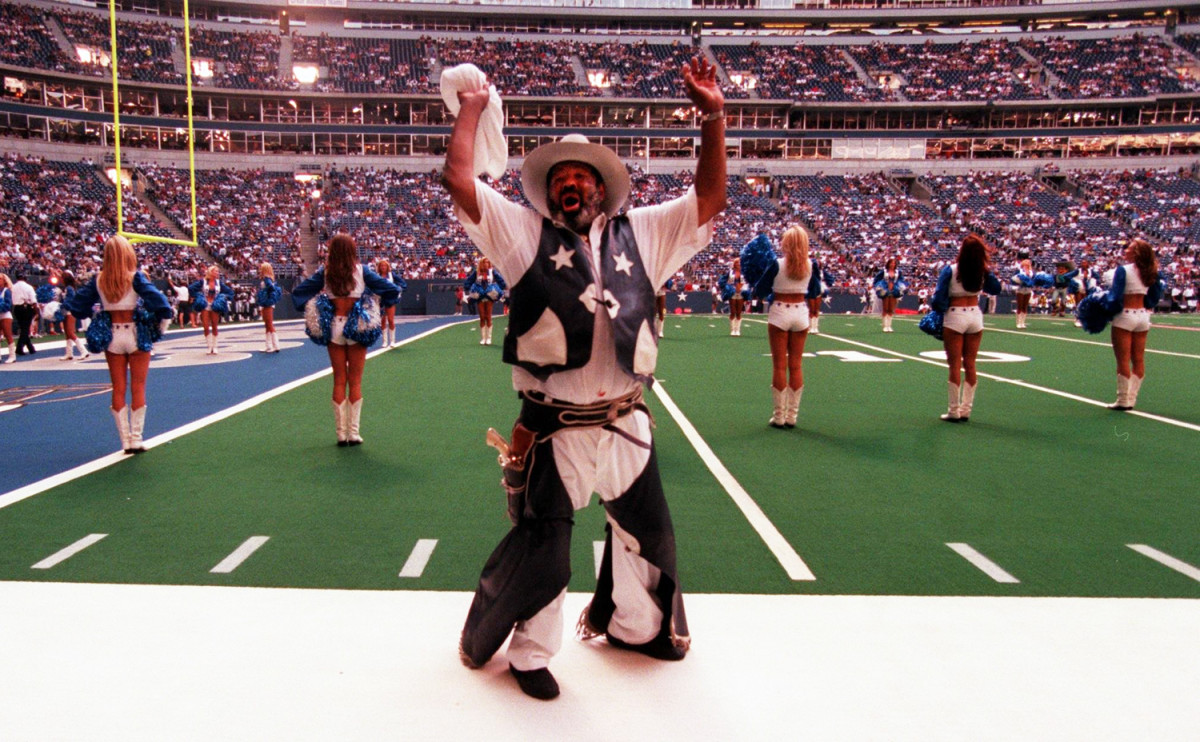
Wilford “Crazy Ray” Jones
Staple of the Cowboys sidelines (and broadcasts) for years, heralding rise of the superfan culture
The Cowboys’ branding as “America’s Team” in the 1970s meant they were regulars on television, and that meant that viewers couldn’t miss “Crazy Ray,” the Cowboys’ self-appointed, unofficial mascot. Beginning as a pennant vendor in 1962, Wilford Jones honed his persona and his fandom, turning out for Cowboys games and cavorting and whistling in his signature chaps and blue vest, brandishing a toy six-shooter. Though he was unpaid, the Cowboys gave him his own parking space and granted him unlimited access at home games. At a time when the NFL was reaching ever-wider TV audiences, the CBS cameras loved him—especially when he got into friendly tussles with “Chief Zee,” the Redskins mascot, at high-profile showdowns with division-rival Washington. When the Cowboys were on TV—regular season, Thanksgiving, playoffs, Super Bowl—Wilford Jones was there; he missed just three games in his lifetime.
While he wasn’t the first to dress up funny and cheer on his team, Crazy Ray’s over-the-top passion and obsession—broadcast to millions just when the NFL was hitting its stride—heralded the rise of the NFL superfan. Every team has its Crazy Ray, and it’s not even that crazy anymore.
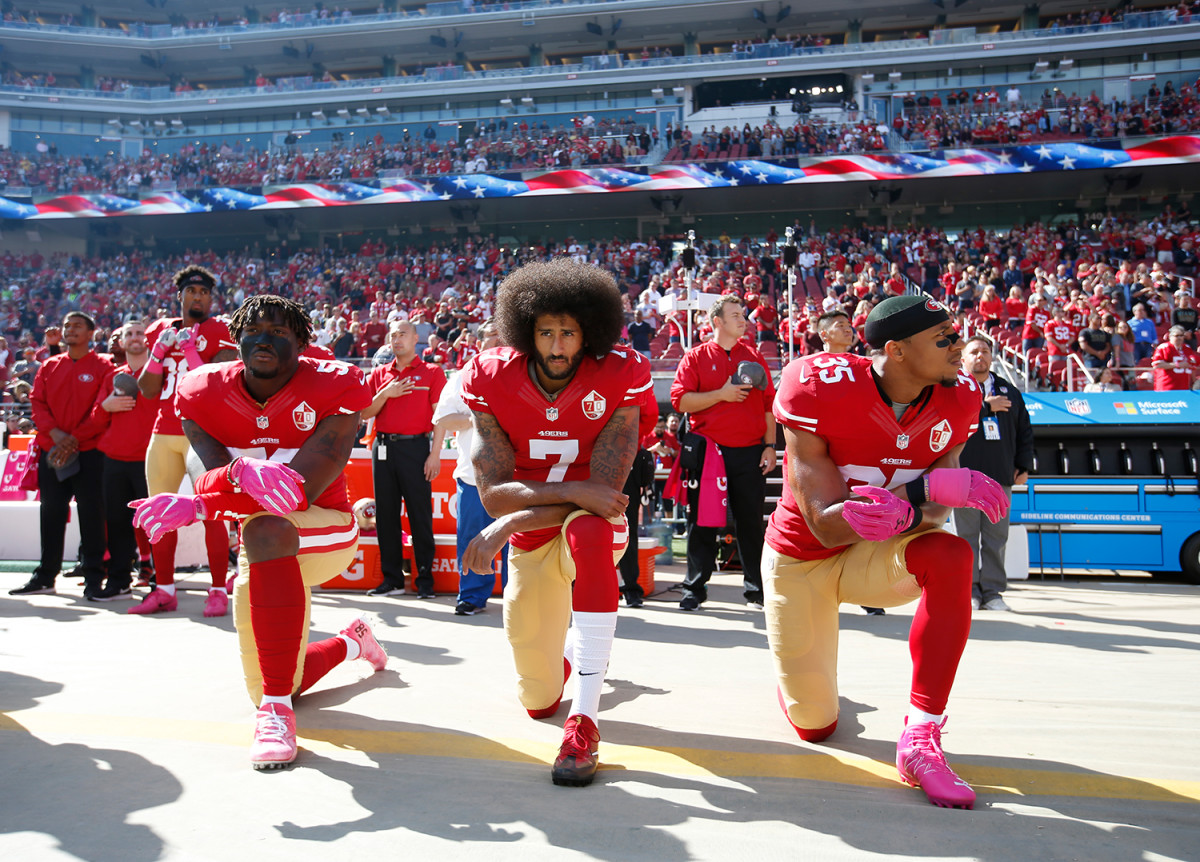
Colin Kaepernick
49ers QB whose protests of racial injustice shook the NFL and generated volatile national debate
Colin Kaepernick made his initial mark in the NFL by taking the 49ers to the Super Bowl in his second season, as a scrambling, unpredictable fill-in for Alex Smith. His biggest mark, of course, came from what he did on the sideline.
A baseball and football star at Nevada, Kaepernick was selected in the second round of the 2011 draft by the Niners. He played sparingly until Smith suffered a concussion in a Week 10 game in 2012. Operating out of a pistol formation, Kaepernick’s dual-threat capabilities posed an immediate challenge for opposing defenses; in the divisional-round playoff game that season, Kaepernick threw for 263 yards and rushed for 181—the latter the most ever by a quarterback in an NFL game—in a 45-31 defeat of the Packers. The following season Kaepernick, now the undisputed starter, led the Niners to the NFC title game, coming one Richard Sherman deflection from another Super Bowl appearance. Eventually, however, NFL defenses began to solve for Kaepernick’s skills, and midway through the 2015 season, after coach Jim Harbaugh left for Michigan, Kaepernick lost his starting job to Blaine Gabbert.
In the 2016 preseason, following a series of shooting deaths of unarmed black men by police, Kaepernick chose to sit on the bench during the playing of the national anthem, in protest of police brutality and systemic racism in the U.S. When media noticed and critics objected, Kaepernick instead knelt for the final preseason game, and continued to do so for each game over the next two years. The gesture, which spread around the league and to other sports, sparked an intense national debate over the role of athletes in politics, inspired Twitter insults from President Trump and arguably cost Kaepernick a job in the NFL. (He settled a collusion lawsuit against the league for an undisclosed sum in 2019.). Kaepernick’s community activism and his apparel partnership with Nike have kept him in the public eye, though he has not played a down since 2016. “I don’t want to be someone who can be put into a category,” Kaepernick told The MMQB in 2013. “I want to be my own person. … And I want to have a positive influence as much as I can.”
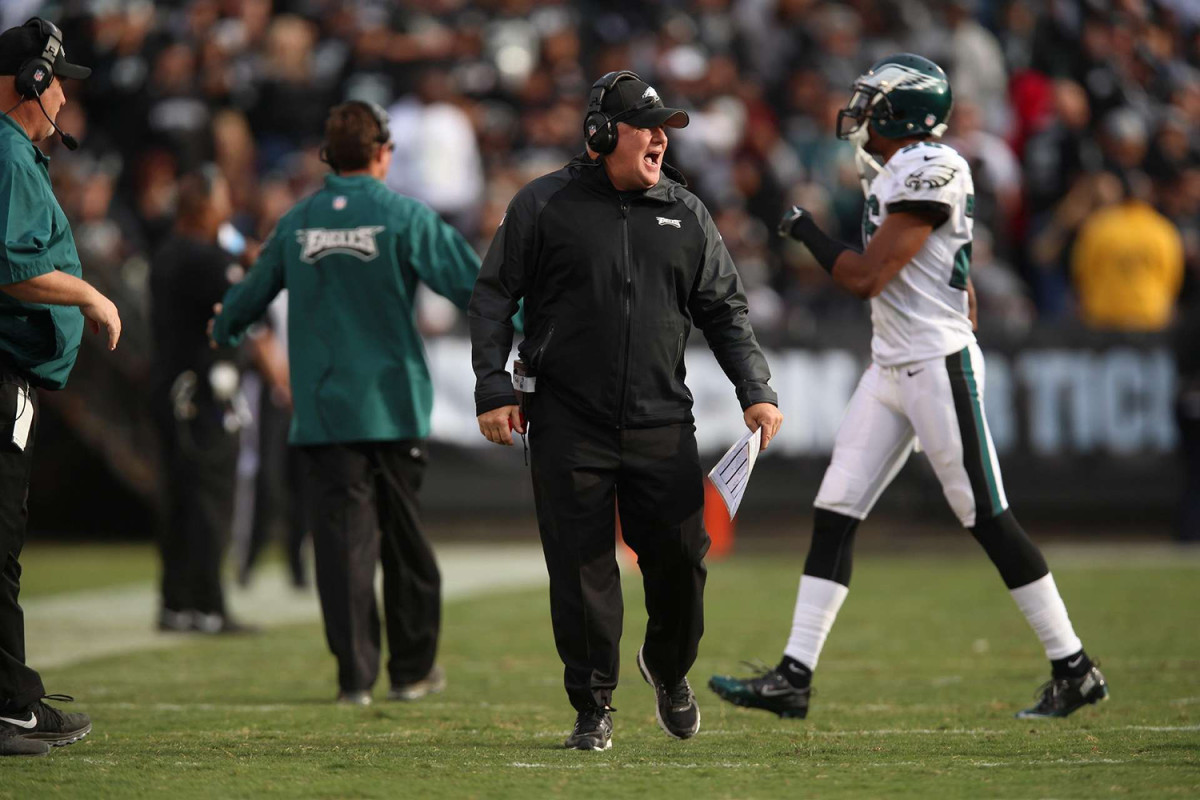
Chip Kelly
Innovator who failed in the NFL but proved the feasibility of wide-open spread concepts in the pros
Unique for his ability to spread both jokes and fear throughout the NFL, Chip Kelly had no parallel in professional circles when he arrived in the league in 2013 with the Eagles. But after he was forced out of Philadelphia in a power struggle, eventually left to wither for a season on a sinking 49ers team, there was little doubt: Kelly helped change the NFL in numerous ways.
Rising from obscurity in New Hampshire, Kelly took over an ascending Oregon program and turned it into a national college powerhouse. With an uptempo system that relied on short play calls and simple, repetitive instructions, the Ducks were a team no one could quite catch up to. That made executives at the next level salivate over the possibility of Kelly streamlining their own operations.
After some flirtations, Kelly finally made the leap to the pros in 2013 and reached the playoffs in his first year with Philly. The Eagles finished fourth in points, second in yards, fifth in passing touchdowns, first in rushing yards and second in rushing touchdowns. They were gaining, on average, more than five yards per carry that season despite averaging only about two minutes per drive.
What happened next was an NFL story all too familiar. Kelly’s good ideas—a focus on sports science, nutrition and wellness—were pilfered by the rest of the league. Many of his zone concepts were incorporated and folded into offensive schemes. And Kelly, who suffered from an inability to politick like the high-level used car salesmen abundant in the profession, was booted out of Philadelphia before he could finish a third season. But … not before he helped change the way teams practice, prepare, eat and play. And even though he has returned to the college ranks at UCLA, there a plenty who believe the NFL has not heard the last of him.
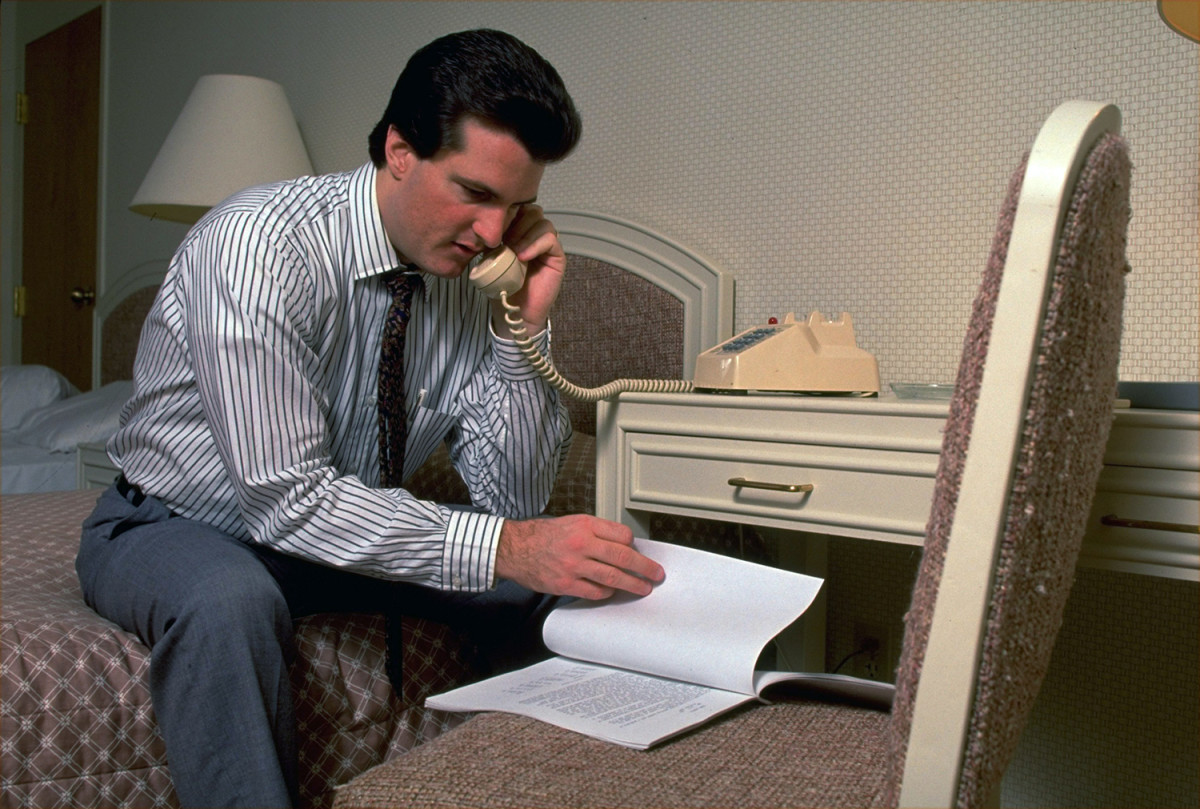
Mel Kiper Jr.
Self-made expert at the forefront of the draft information industry
Encouraged by some inside the NFL to follow his passion no matter how obscure, Mel Kiper, a coiffed, fast-talking draft analyst, constructed an empire out of his love for the league’s college-to-professional pipeline.
The Maryland native has been a fixture in professional football for decades. From his draft guides—long established as a must-read for NFL insiders during the lead-up to drafts—to his confident television demeanor, everything about Kiper’s aesthetic has been carbon copied elsewhere, once the draft shifted from minor curiosity to standalone industry for fans in the offseason.
For years Kiper owned the idea of being the expert on rising college talent—not only gauging their skills, but putting into perspective where they might land in the upcoming draft. In the decades since Kiper’s emergence, every sports network has at least one draft analyst. Kiper’s home net, ESPN, has two. And these analysts are becoming far more engrained in the game. In 2019, longtime NFL Network draft analyst Mike Mayock was hired as general manager of the Oakland Raiders. Todd McShay has been mentioned as a possible personnel executive with the Jets. Daniel Jeremiah, now the head draft analyst at NFL Network, has been touted for general manager roles at numerous openings. All of them have Kiper and his dogged foresight to thank.
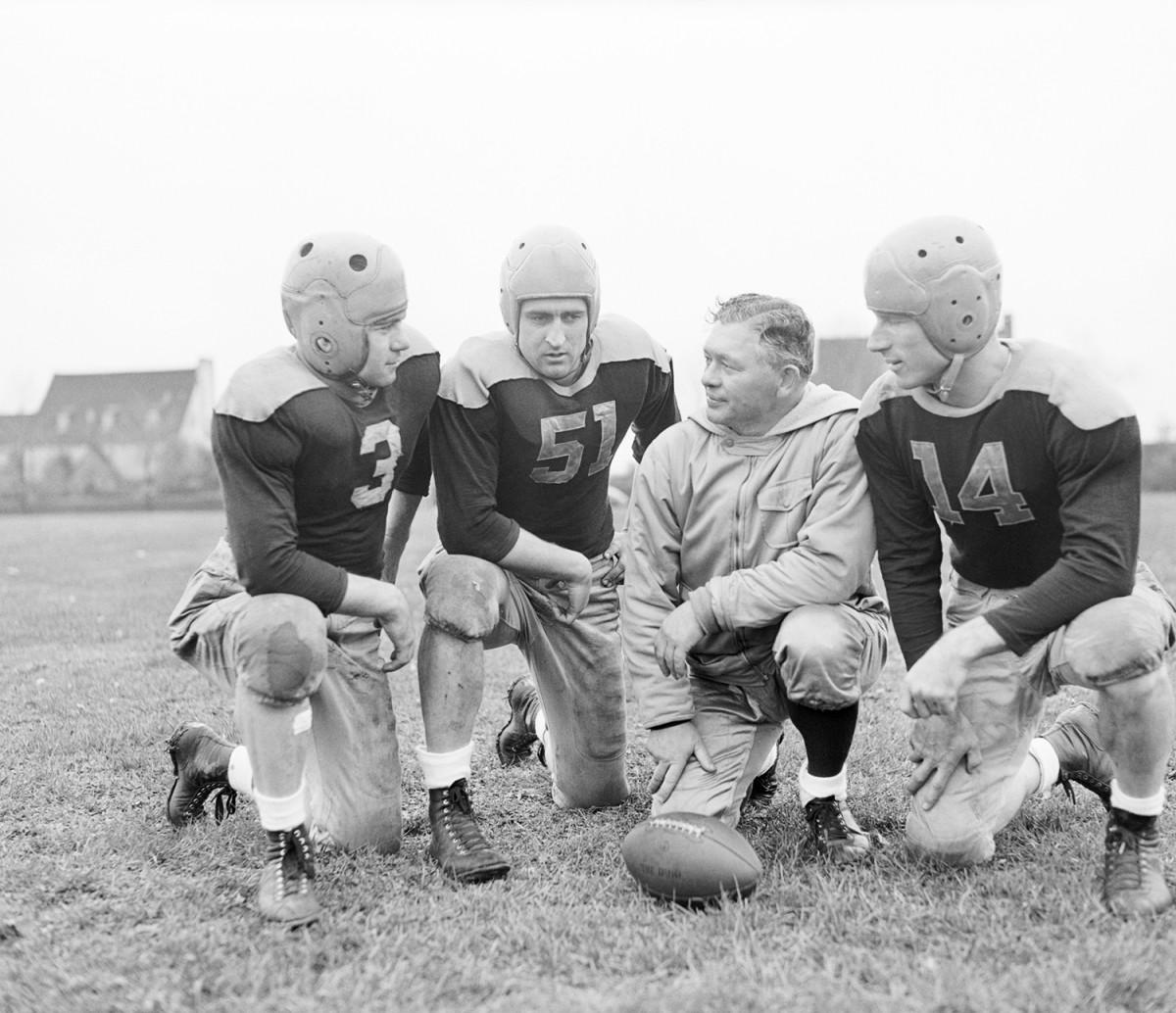
Curly Lambeau
Packers patriarch under whose leadership the NFL survived and thrived in tiny Green Bay
Earl “Curly” Lambeau was working as a shipping clerk in 1919 when he approached his employer to ask for funding to start a football team. The Indian Packing Company put up $500 to pay for uniforms, and the Green Bay “Packers” were born. Lambeau played halfback, the most important position in football’s early days, and led the team as a player-coach from 1919 to ’29 and continued as coach of the team until 1949. His approach to the game revolutionized football—he’s credited with making the forward pass a crucial part of offense, creating pass patterns and working around rules that made it difficult to employ the now-basic tactic. With his innovative coaching, Lambeau led the Packers to three consecutive NFL championships in 1929-31, and he won three more in ’36, ’39 and ‘44, one of just three head coaches (along with Chicago’s George Halas and New England’s Bill Belichick) to win six NFL championships.
Under Lambeau's leadership, Green Bay survived several financial crises of the type that would prove fatal to the likes of Rock Island, Duluth, Dayton and other small-market teams. In 1923, with the franchise on the verge of bankruptcy, Lambeau decided to incorporate, and sold shares of the team to the community to keep the lights on. Green Bay is now the only publicly-owned, not-for-profit, major league professional team in the U.S.
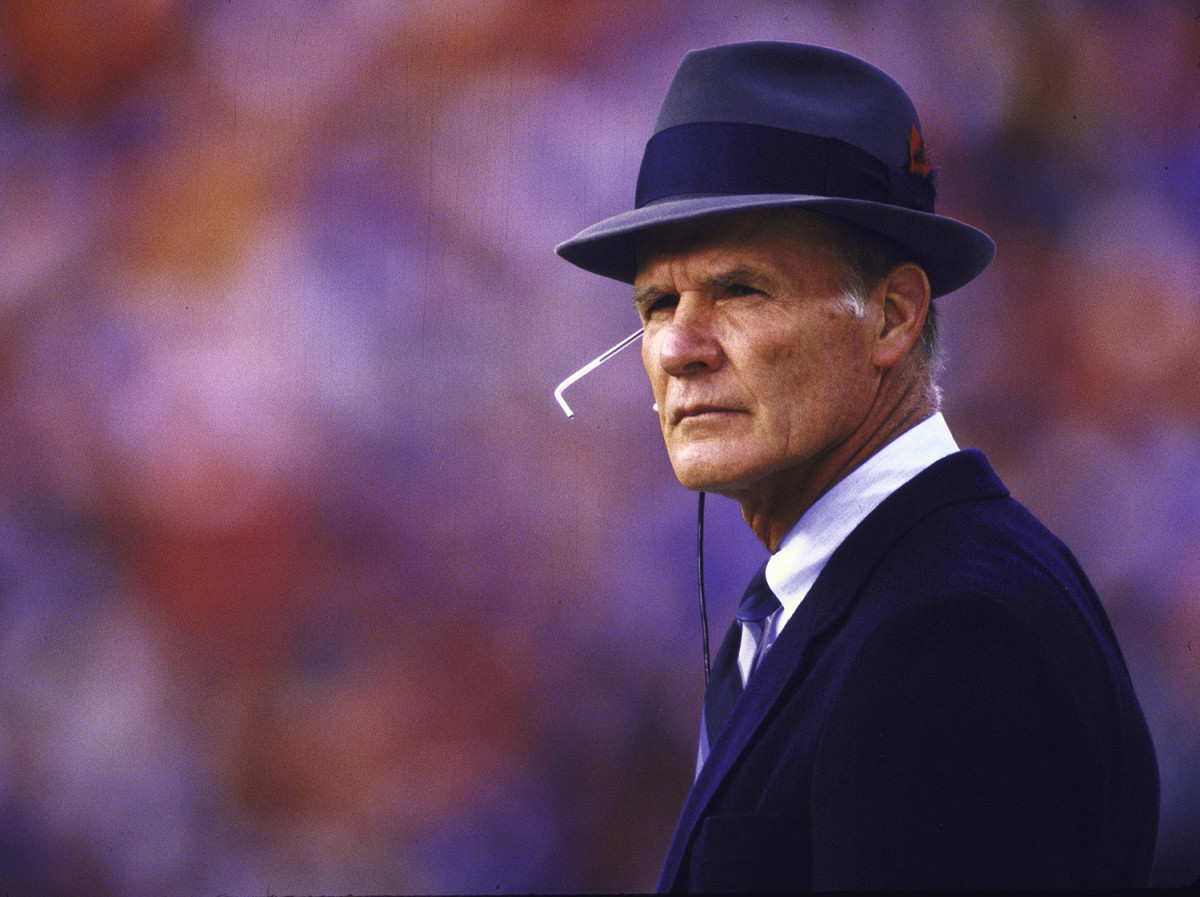
Tom Landry
Iconic, fedora-topped Cowboys coach
Twenty straight winning seasons. That statistic may define Tom Landry’s career better than anything else. Imagine all the success Bill Belichick has enjoyed with the Patriots, a sports dynasty that has gone on seemingly forever (or actually forever, depending on your age). Now add two more winning seasons and you get Landry’s run with the Cowboys from 1966 to ’85. The franchise’s original coach, Landry came to the expansion team after a run as defensive coordinator with the Giants, for whom he played from 1950 to ’55. He’s known for creating the 4-3 defense, but in his early days he had to make the most out of his weak personnel on the expansion Cowboys. “So I had to do it with the motion and formations and gadget plays, the kind of stuff that bothered me most when I was a defensive coach,” Landry told SI’s Paul Zimmerman.
Between 1970 and 1978 the Cowboys went to five Super Bowls and took on the nickname “America’s Team.” Landry became the most famous coach in the game, known not just for his innovation and winning but also his trademark fedora and his sideline stoicism.
After three consecutive losing seasons and upon Jerry Jones purchasing the Cowboys, Landry was fired as the only coach the Cowboys had ever known and replaced with Jimmy Johnson, a move Pete Rozelle said was “like Lombardi’s death.” In a 1989 SI article, Landry dismissed any notion of going elsewhere. “I think I'm too far along to worry about coaching another team. … It's a chapter closed. This is the worst scenario, I guess, but I’m not bitter.”
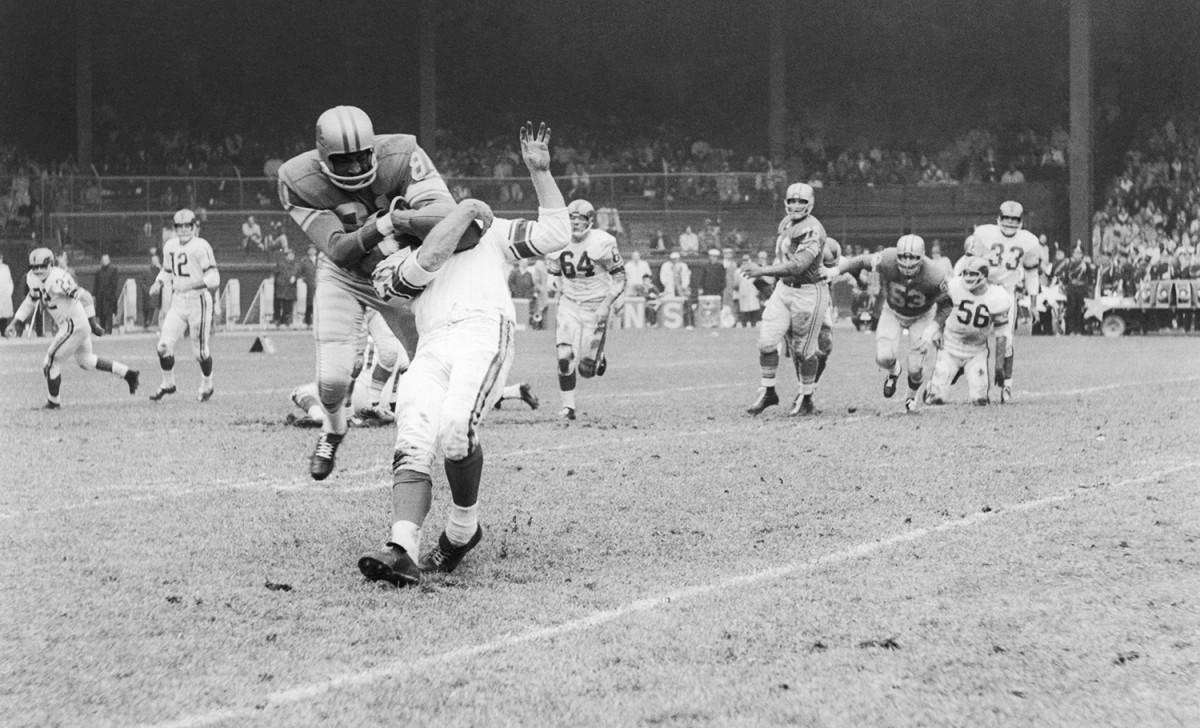
Dick “Night Train” Lane
Fearsome ’50s defensive back and one of the first great black players
Considered by many the most athletic and hardest-hitting defensive back of his era, Richard Lane, better known as “Night Train,” still owns the NFL single-season record for interceptions (14) and was inducted into the Hall of Fame in 1974. Lane had a hard upbringing: As an infant he was rescued from a dumpster, abandoned by his pimp father and prostitute mother; he attended a segregated high school in Austin, Texas, and spent four years in the Army and some time working at an aircraft plant before walking into the Los Angeles Rams offices and requesting a tryout.
Lane went on to play 14 seasons of pro football, earning a reputation as an innovator at his position, popularizing bump-and-run coverage at the line of scrimmage, as well as off coverage meant to bait quarterbacks into throwing his way, like Deion Sanders many years later. Lane’s signature face-mask and clothesline tackles influenced numerous NFL rules changes intended to protect ball-carriers’ and receivers’ heads. He once told former NFL coach and friend Jerry Glanville, “Jer, there’s never been a good tackle in the history of the league above the eyebrows.” One of the first star black players in NFL history, Lane was also among the first African-American players to exercise a sort of free agency before such a thing existed, successfully demanding a trade from the Chicago Cardinals to the Detroit Lions in 1959. “I asked for that trade,” he said later. “We had that Canadian offense with three chances for a fumble on every play, and somebody always came through.” He later became the first African-American to hold a position in the Lions’ front office.
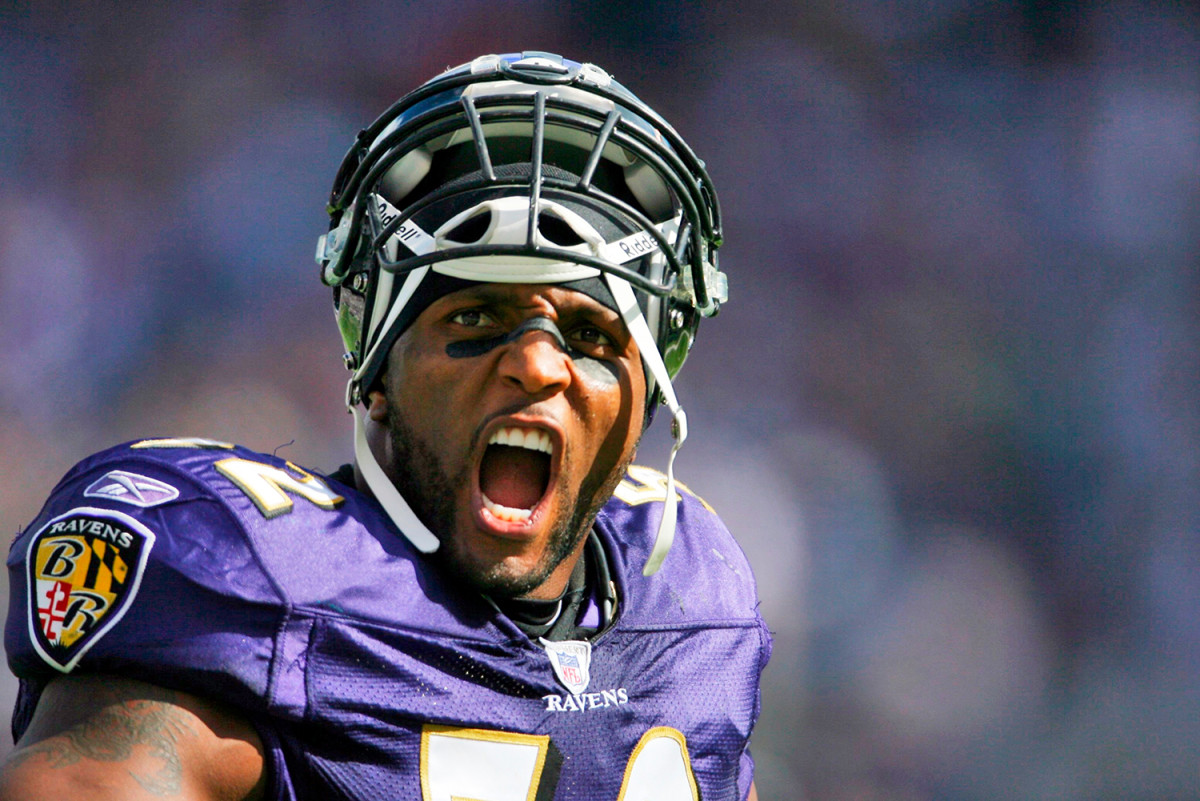
Ray Lewis
Vociferous Ravens linebacker notoriously caught up in killings at Super Bowl XXXIV
A stalwart in the NFL for nearly two decades, Ray Lewis is known as much for his involvement in two deaths at the Super Bowl as he was for his immense on-field bravado and preachy rhetoric.
Fitting the often outsized image of a modern football leader, Lewis played his career with a notable tenacity that set a tone for the Ravens’ franchise and inspired a generation of defensive players to follow. He engrained himself in the city of Baltimore through his play and his elaborate pregame dance routine, which grew to include musical and fire elements and which is now memorialized in bronze outside the Ravens’ stadium.
The two-time Super Bowl champion, 13-time Pro Bowler and two-time Defensive Player of the Year embodied the newly christened franchise in Baltimore, which for years has been built on a ferocious and unforgiving defense. A first-round pick out of the University of Miami, Lewis anchored some of the best defensive units in modern football history. He is listed as second all-time in career tackles and finished with 31 interceptions, 96 pass breakups, 19 forced fumbles and 20 fumble recoveries.
As impressive as those numbers are, Lewis will forever be linked to the stabbing deaths of Jacinth Baker and Richard Lollar in the early hours of Jan. 31, 2000, in Atlanta. The events of that night remain unclear beyond the fact that the two men died during an argument with Lewis’s group, after which Lewis fled the scene in his limo. Originally charged with murder, Lewis pled guilty to obstruction of justice and testified against two of his companions (who were both found not guilty). He was sentenced to a year’s probation and was fined $250,000 by the NFL.
Alternately intensely defensive and contrite about the Atlanta incident, Lewis worked to rebuild his image in the ensuing years, and by the mid-2000s was, as SI wrote in 2006, “Baltimore’s most beloved public figure.” He left the game on top, with a Super Bowl victory in the 2012 season, and then became an analyst on ESPN’s NFL coverage. But even upon his induction into the Hall of Fame in 2018, the cloud of Atlanta hung over him. Lewis continues to be one of the most polarizing figures in American sports.
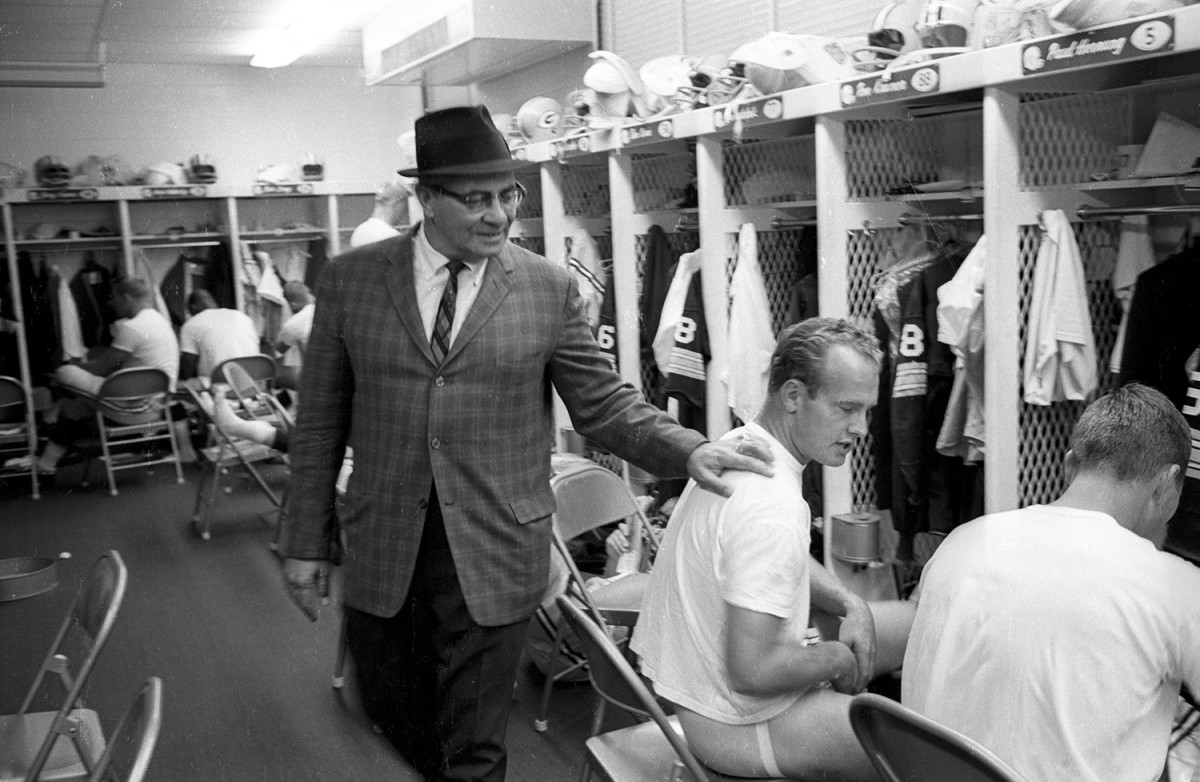
Vince Lombardi
Packers icon and, for many, the very image of a football coach
After 11 years of futility capped by their worst-ever season, the floundering Green Bay Packers were seeking a savior in 1959. They found him in an unlikely place: New York. Vince Lombardi was born in Brooklyn, went to college at Fordham (where he was one of the “Seven Blocks of Granite”) and was serving as offensive coordinator for the Giants when the People’s Team tapped him to take over as coach and GM. He instantly transformed the Packers and put small-town Green Bay back on the NFL map.
Lombardi’s coaching qualities included an uncompromising competitiveness, a strong eye for talent and intense focus on classroom study and preparation to make his power game work. The deceptively simple Packers sweep, which Lombardi had honed in New York, required precise coordination among the center and pulling guards to create spaces for the ball-carrier to “run to daylight.” With Paul Hornung at halfback, Jim Taylor at fullback, Bart Starr the smart and savvy QB, and an offensive line of future Hall of Famers, Lombardi deployed the sweep to devastating effect. The Packers went 7-5 his first season, 8-4 the next and played in the NFL Championship Game, and in 1961 they demolished his old team, the Giants, 37-0, to win the title. It was the first of Lombardi’s five pro football championships, including each of the first two Super Bowls. The Packers went 9-1 in the postseason under his direction.
Lombardi stepped down as coach after his second Super Bowl victory—he had a .754 winning percentage in Green Bay—then moved to Washington to run the Redskins in 1969, leading them to their first winning season in 14 years. In June of the following year he was diagnosed with colon cancer, and he died in September 1970. The legacy he left was enormous, in football and in the wider culture. Lombardi popularized (though he didn’t coin) the famous phrase, “Winning isn’t everything; it’s the only thing,” and he said that despite its many intricacies, at heart “football is two things. It’s blocking and tackling. I don’t care anything about formations or new offenses or tricks on defense. You block and tackle better than the team you’re playing, you win.” Following his death, the Super Bowl trophy was renamed in his honor.
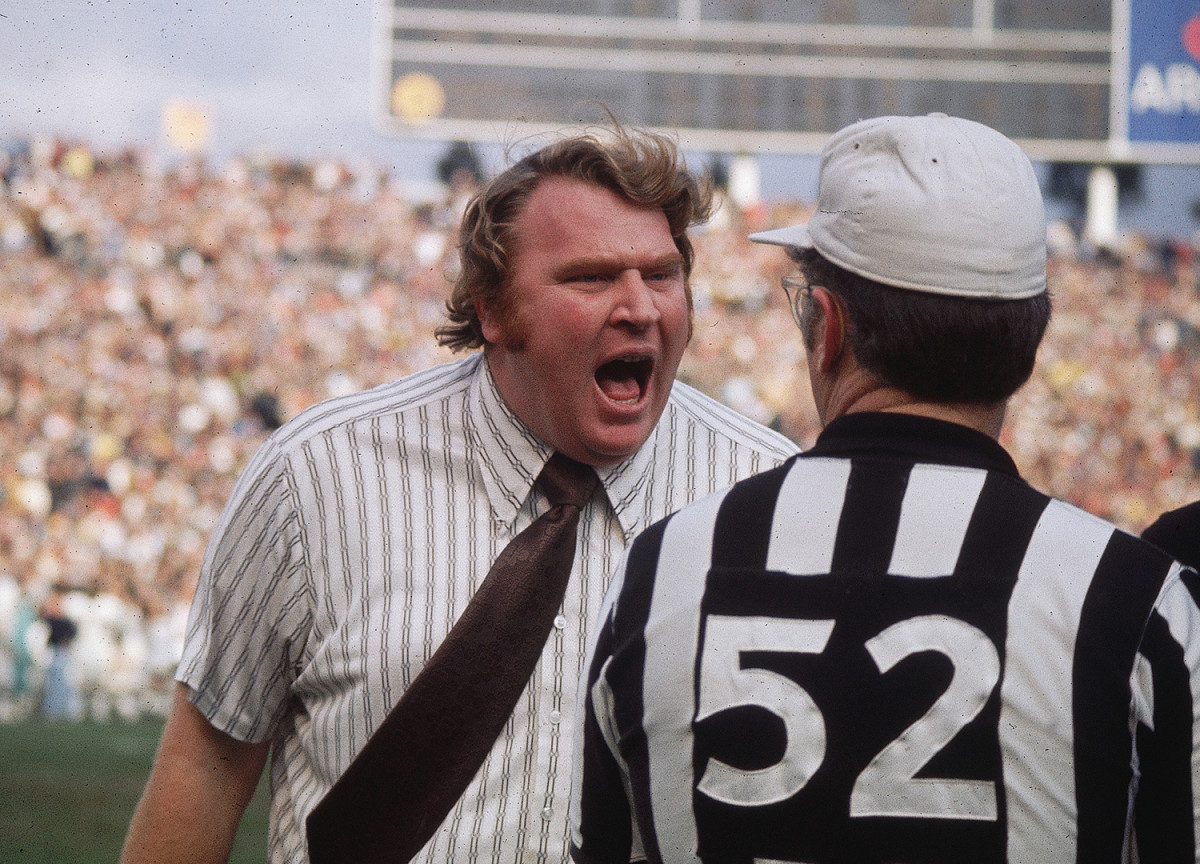
John Madden
Hall of Fame coach turned broadcaster, known to later generations for his eponymous video game
John Madden could make this list of influential figures three separate times. Truly. His life in the NFL spotlight began as the animated 33-year-old coach of the Raiders, with whom he won an NFL-record 75.9% of his games and, in the 1976 season, a Super Bowl. As he explains it, he eventually came to realize that chasing a title was much more appealing than reclaiming one. Two years after hoisting the Lombardi Trophy, Madden abruptly quit coaching.
In 1979 CBS hired him as a color commentator, hoping to find a known name with some on-air charisma. What they wound up with was their No. 1 game analyst by 1981, a broadcaster who went on to win eight Emmys and call five Super Bowls alongside play-by-play man Pat Summerall. In 1994 Madden followed Summerall to Fox, where he called three more Super Bowls and racked up another four Emmys. Then came his foray into prime time, where he and Al Michaels spent four years on ABC’s Monday Night Football and three years on NBC’s Sunday Night Football. Working with Michaels, Madden called three more Super Bowls and won another four Emmys, bringing his career total to 16 (not counting his 2010 Lifetime Achievement Emmy).
Madden’s on-air staying power stemmed from his relatable enthusiasm and knack for explaining details of the game in ways that common viewers could understand. Gritty, technical offensive line play became almost must-see TV, and America grew accustomed to yellow lines of telestration sweeping across its screens, guiding viewers’ eyes from receivers to defenders to mundane scenes on the sideline that became comical once broken down. Anyone who still had trouble processing a play that Madden broke down was often ushered into the party at the last second by his universally understood exclamation: Boom!
More important to the NFL’s growth than Madden’s coaching or broadcasting, however, was the EA Sports video game that bears his name. When the company approached him in 1984 about the idea, Madden insisted the game be as realistic as possible. When EA said its screens could fit only six or seven players per team, Madden said he’d back out if there weren’t the full 11 players. This sort of back and forth help delay the game’s release until 1988. EA gained the right to use NFL teams and players in 1993 and ’94, respectively. Smart move by all; the game has sold more than 130 million copies and is the league’s second-largest source of licensing revenue, behind only apparel.
The Madden series has brought pro football to life for multiple generations of young fans who came to view teams in the breadth of entire depth charts and 53-man rosters. Actual NFL playbooks were learned. The game’s franchise mode, introduced in 1998, boosted the increasing popularity of the NFL’s offseason, where free-agent and draft moves are now debated and discussed for months on end. No figure has more influenced pro football in pop culture than John Madden.
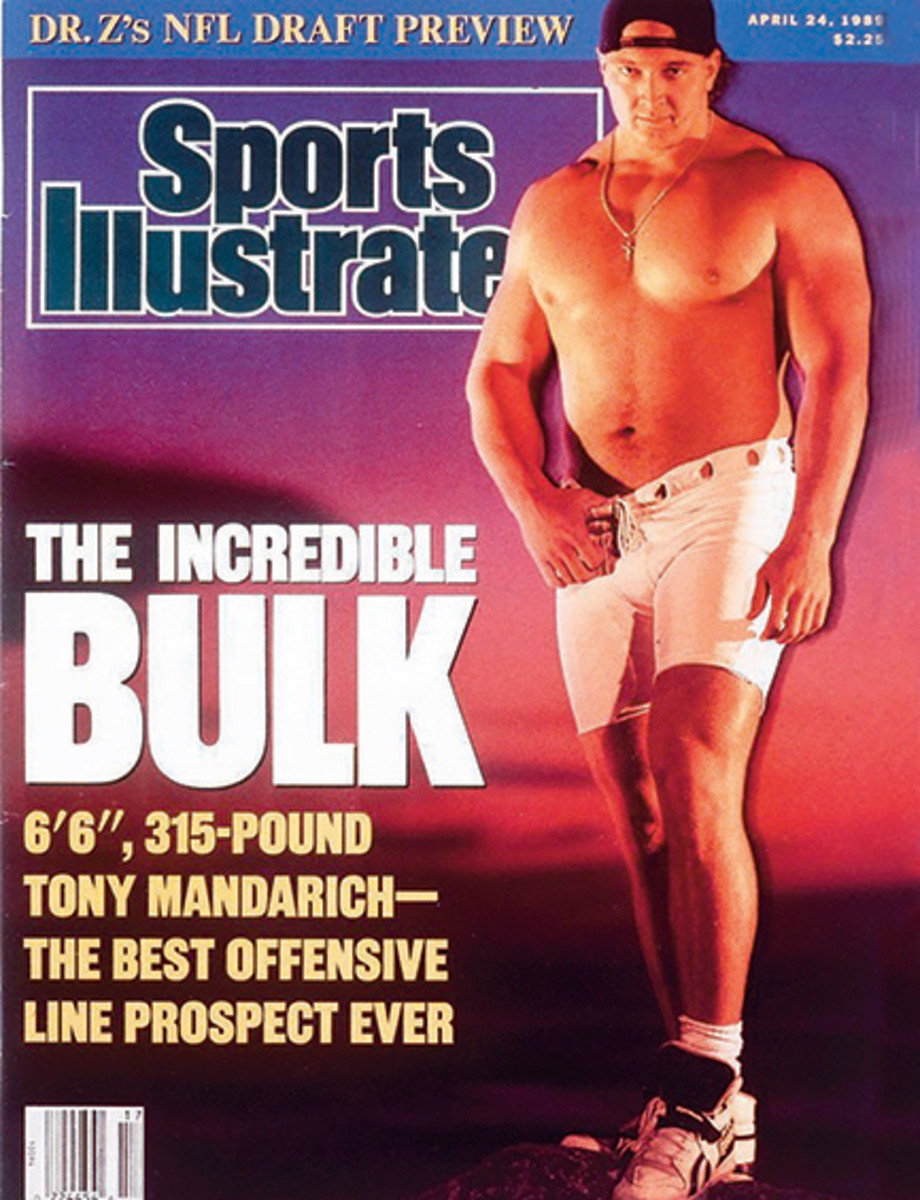
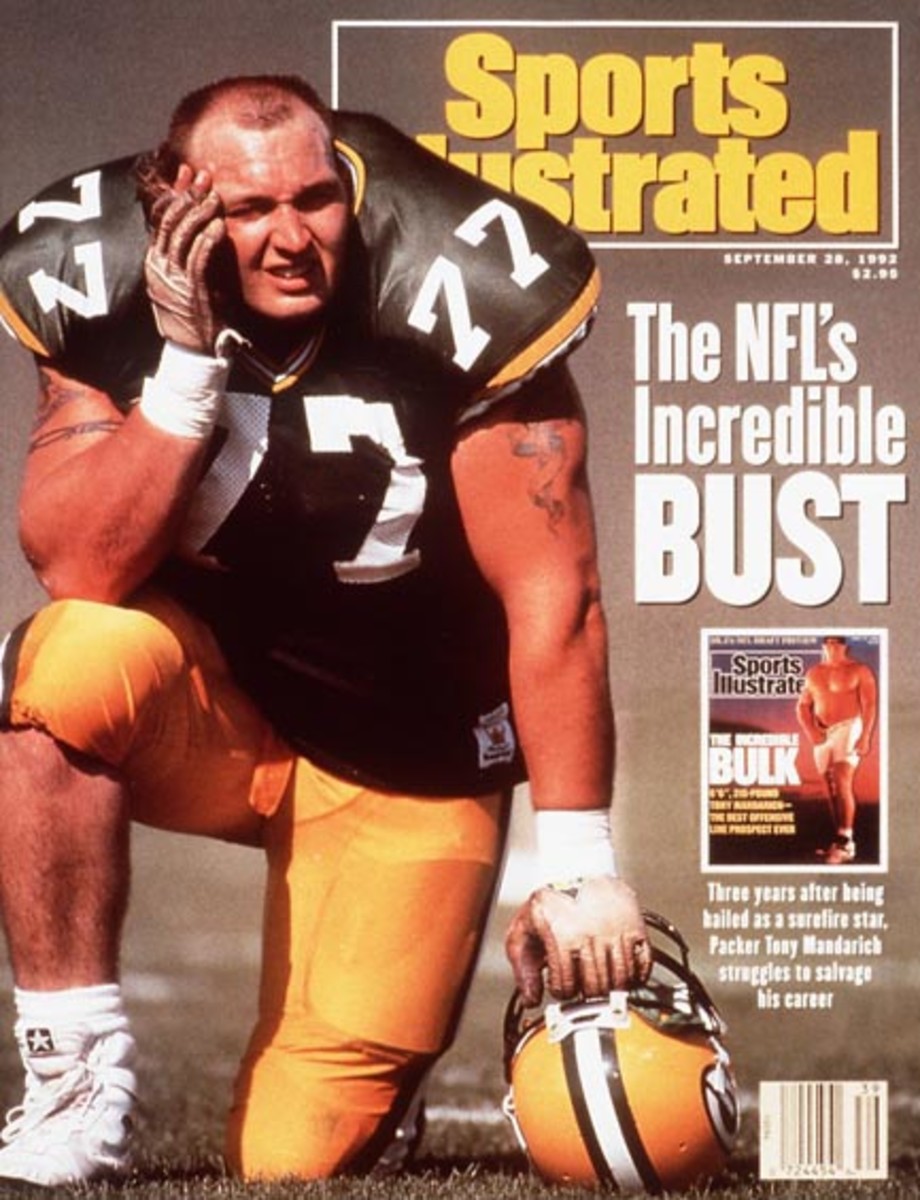
Tony Mandarich
From Incredible Bulk to Incredible Bust, the embodiment of steroid use
The subject of one of Sports Illustrated’s most notorious covers, the barrel-chested Tony Mandarich—who posed shirtless on the cover of the April 24, 1989, magazine and was labeled “The Best Offensive Line Prospect Ever”—is one of the bigger flops in NFL history. Mandarich went from the “Incredible Bulk,” as labeled on that cover, to the “Incredible Bust.” As Rick Telander wrote in the 1989 cover story, “With his size, speed and attack-and-obliterate style of play, Mandarich has broken new ground for offensive linemen, as well as for the game of football as we know it. Either that or he has set civilization back a thousand years.”
Mandarich was so dominant as a college lineman at Michigan State that the team had to create stats—like “off the film” (players driven out of the camera's view) and “no mas” (defenders who quit against him)—to assess his play. Selected second overall by the Packers in ’89, Mandarich would be the only top-five pick in that year’s draft to not make it to the Hall of Fame—the others were Troy Aikman, Barry Sanders, Derrick Thomas and Deion Sanders—as he would start only 63 games in his career and become infamous for steroid and drug use.
Years after his career fizzled out, Mandarich would come clean about his steroid and painkiller abuse in a tell-all book. He admitted to taking steroids as a senior in high school; to injecting others with steroids at his local gym; to conning at least 10 doctors in four states into writing him prescriptions for painkillers when he was playing for Green Bay; to hiding syringes in his jockstrap and shooting up during practice; and to cheating drug tests in college and the NFL with a variety of homemade concoctions (including a rubber squeaking dog toy that he filled with clean urine).
For years Mandarich was the poster-boy for steroid use in the NFL. As Telander wrote in 2009: “Through the SI cover story Mandarich indirectly abetted the growth of the steroid culture among young athletes, and his chemically induced strength and rage helped him humiliate many clean players he competed against.”
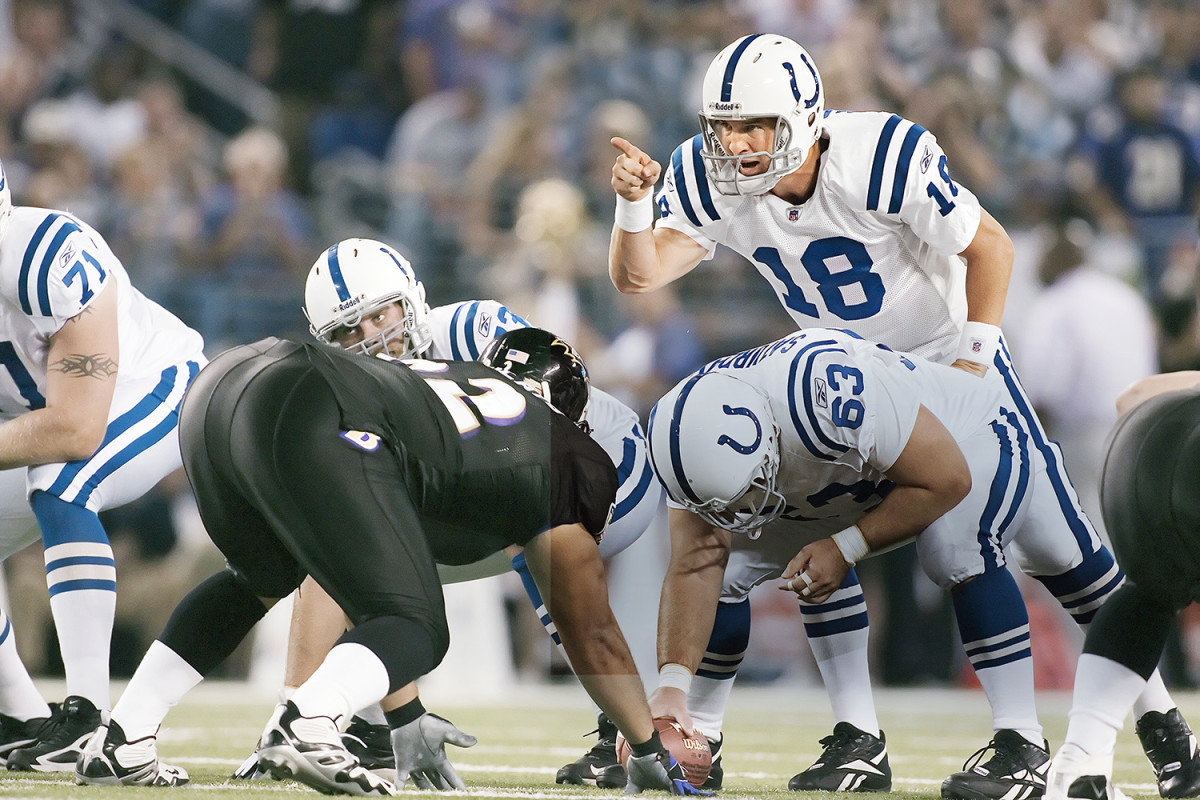
Peyton Manning
Five-time MVP and face of the league in the 2000s
We could list his accolades here—a jumble of numbers and percent signs and acronyms—and it’d be enough to explain Manning’s position on this list. His 54 game-winning drives. His 3.13% sack rate, tied for the lowest in NFL history and a testament to knowing what the defense is doing and getting the ball out quickly. His 539 passing touchdowns. His five MVPs when no one else in NFL history even has four.
Manning was a high school recruit who went to Tennessee and became the No. 1 overall draft pick in that famous 1998 draft featuring him and Ryan Leaf. Smart move, Colts. He wasn’t the savior immediately, though: Manning threw a league-high 28 interceptions in his rookie season. Soon, though, he became immortal. Babies in Knoxville and Indianapolis and around the country would be named Peyton.
He was easily the most prolific quarterback of the 2000s, even if Tom Brady had three Super Bowl rings before Manning reached one. Following the 2006 season, Manning finally got the monkey off his back, beating Chicago 29-17 for his first Lombardi. But in his mid-30s, Manning had four neck surgeries in two years and missed the 2011 season. The Colts released him and drafted Andrew Luck, and free agents across the NFL said then as they say today, “If they can cut Peyton Manning, they can cut anybody.”
Manning had his second act with the Broncos, going to two Super Bowls in four years and finishing his career with a victory in Super Bowl 50 as his arm finally started to give way. He has a bronze statue outside Lucas Oil Stadium, and his No. 18 is retired in Denver. NFL teams clamor for his knowledge in their front offices, and TV network partners beg him to join their booths. His $248 million in career earnings stand as the most for an NFL player, and his numerous endorsements have brought him tens of millions more. According to his NFL father, Archie, however, his “greatest moment” came in 2007 when an Indianapolis medical facility with which he had long been associated was renamed Peyton Manning Children’s Hospital.
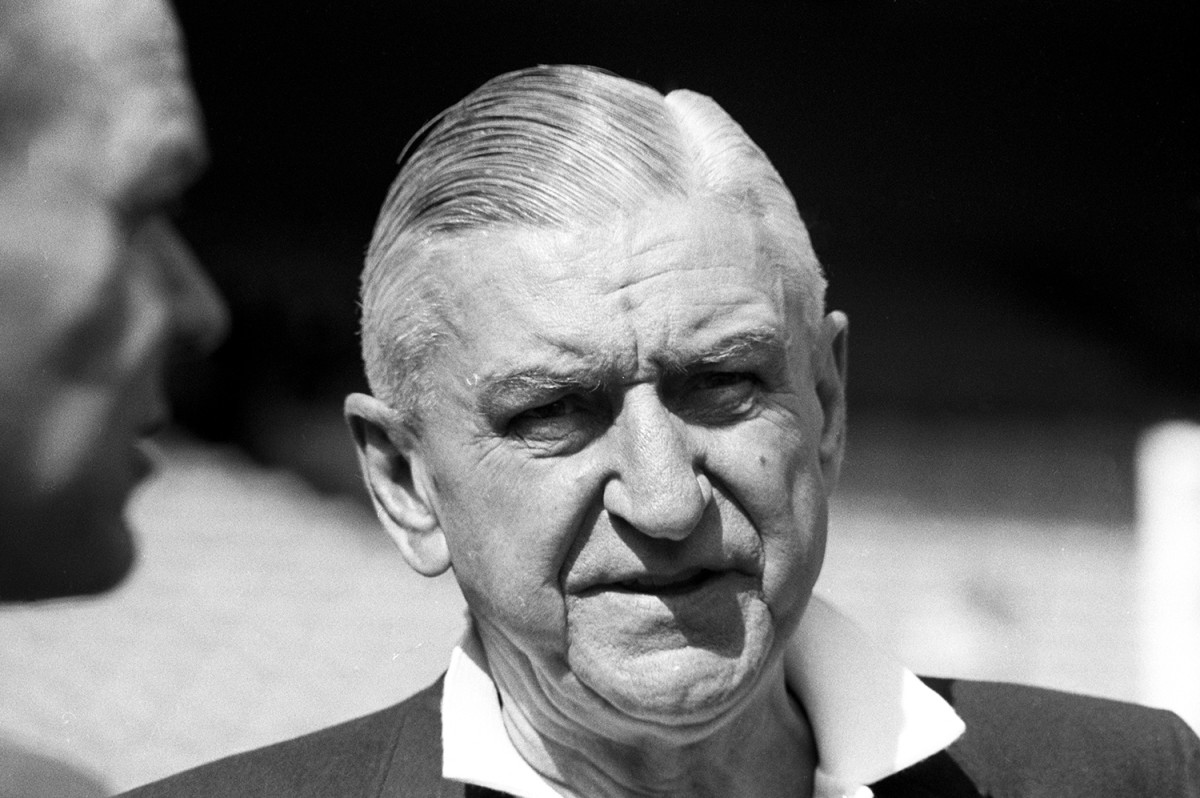
George Preston Marshall
Last owner to integrate his team, and that only under pressure from the feds
George Preston Marshall brought an NFL franchise to Washington, D.C., and oversaw a period of great success, including championships in 1937 and 1942. He is in the Pro Football Hall of Fame for his contributions to the sport, including the introduction of halftime shows, marching bands and cheerleaders; pushing for an expanded use of the forward pass; and suggesting that the league be split into two divisions, the winners of which would play in a championship game at the end of the season.
But Marshall’s legacy also includes his track record of racism. His was the last NFL team to integrate, doing so in 1962 only after the Kennedy Administration decreed that if Marshall did not sign a black player, his team would be denied use of D.C. (now RFK) Stadium, which stood on federal land. The late Washington Post columnist Shirley Povich referred to Marshall’s reputation as “the leading racist in the NFL” in a book the newspaper published about the team’s 60th anniversary in 1992. Today the name that Marshall chose for the team while it was still in Boston has been resisted by some Native Americans and other groups who object to the use of a racial epithet as a team mascot. In 1933, when Marshall changed the name from Braves to Redskins to avoid confusion with baseball’s Boston Braves, the team had several Native American players and a coach who may have been Native American. A common narrative has been that Marshall picked the name to honor them, but in an interview with the Associated Press at the time of the change, Marshall confirmed that their presence “has not, as may be suspected, inspired me to select the name Redskins.”
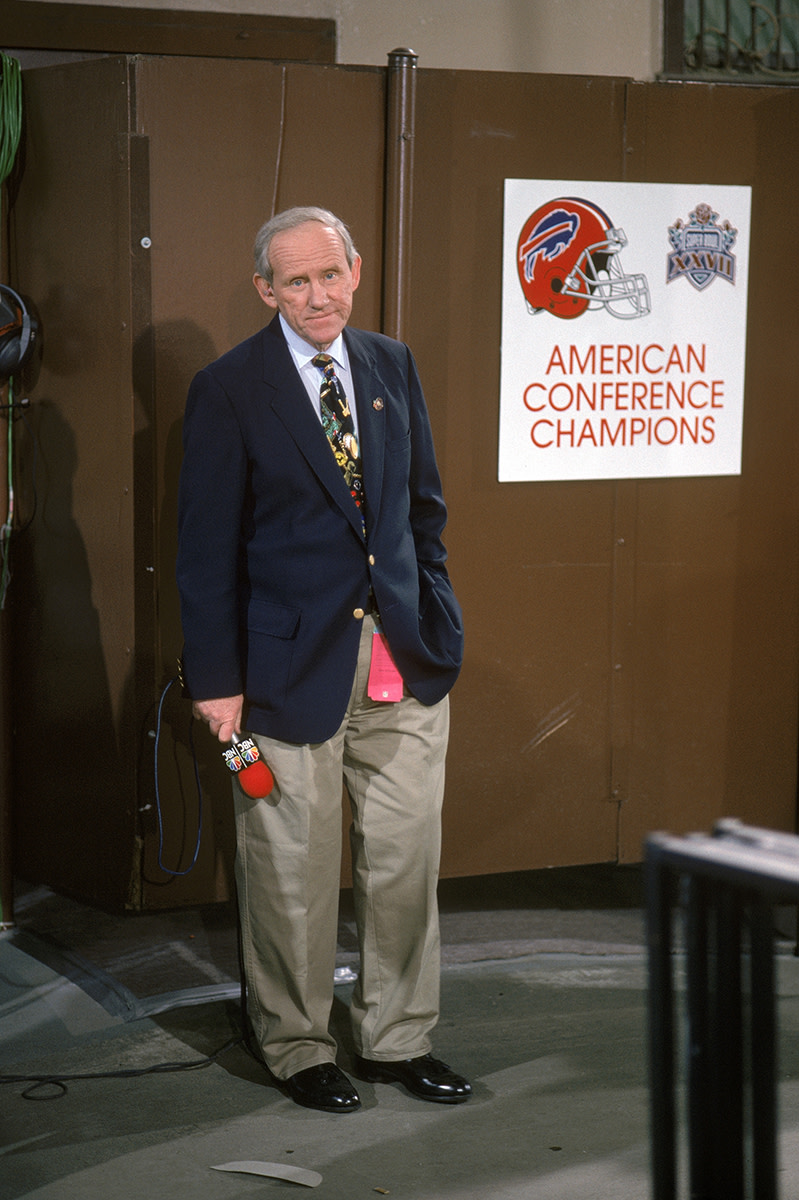
Will McDonough
First prominent national NFL notes/information reporter; forerunner of today’s info-driven media coverage
Before the days of the “WojBomb,” the Adam Schefter newsbreak, or even the deeply reported Monday Morning Quarterback column on SI.com, there was Will McDonough at The Boston Globe. A visionary who understood that regional fandom also meant keeping an eye open and an ear to the ground, McDonough was the preeminent football newsbreaker for much of the NFL’s meteoric rise to national prominence. Upon his death in 2003 at the age of 67, commissioner Paul Tagliabue told the Associated Press that McDonough was the most influential sportswriter covering the NFL.
A Boston native, McDonough broke into the business at a time when sportswriters were essentially degenerate poets hanging out in the press box. Remembrances written by colleagues note how he never cheered, how he was always digging in to news that didn’t particularly relate to his team, and how he once beat up a Patriots player who was hounding him in the locker room. In the reporting world, swagger is often defined by one’s ability to pick up the phone and command anyone in the business to provide you with good, honest information, and in that way McDonough’s cubicle and phone were the nexus of a certain kind of power that would come to define NFL media.
While many writers from that star-studded Globe staff went on to make their mark in sports journalism, it was McDonough who broke down the barrier between hardened newspaper man and widespread television scoop artist, a setup that is still very much alive today. He was a staple of pregame shows on CBS in the ’80s and NBC in the ’90s, feeding fans’ growing appetite for every last morsel of NFL news.
While McDonough had his detractors—he was challenged for being too cozy to some of the league’s power brokers, such as Bill Parcells—he was almost unanimously viewed as the most iron-clad reporter of his time, learning about everything from Parcells’ shocking ouster after the Patriots’ 1996 Super Bowl run to the Rams’ move to St. Louis far before his competitors. And his legacy isn’t just among those who emulate his newshound nature. One son, Sean, is a broadcaster for ESPN. Another, Terry, is in personnel with the Arizona Cardinals.
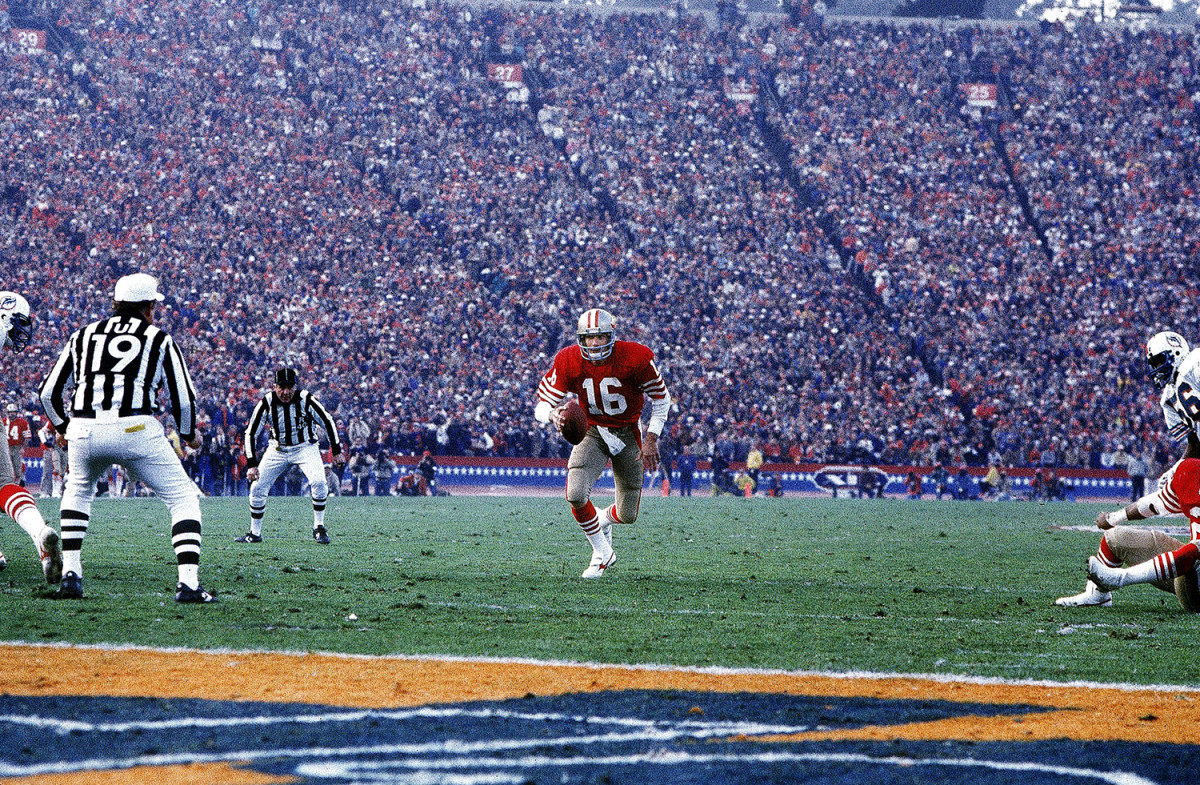
Joe Montana
Four-time Super Bowl-winning quarterback
He was known as Joe Cool because of his sangfroid on the field, whether leading comebacks or being so perfect in clutch games that a comeback wasn’t needed. As SI’s Leigh Montville wrote in 1990, “He somehow seems to breathe slower when everyone else breathes fast, seems to have a different metabolism.”
With four Super Bowl wins and no losses—and 11 touchdowns, zero interceptions a record passer rating of 127.8 in those games—Montana set the standard for quarterback excellence. Before Tom Brady was fighting Montana for the sobriquet of greatest of all time, he was idolizing and emulating Montana like so many young football hopefuls.
Not only did Montana dominate on the field, but his transcendence gave rise to the next generation of great quarterbacks. As Montville summed up his impact: “You look at the poster on the bedroom wall. You could be Joe Montana. Yes, you could. You throw your official NFL ball into the air, narrowly missing the model airplanes hanging from the ceiling by strings. You catch the ball and dive onto the bed. Montana to Rice! Touchdown! You could do that. You could hear the same noises Joe Montana hears. You could do the same things he does. Yes, you could.” When Tom Brady was named SI’s Sportsman of the Year in 2005, he quoted that passage in his acceptance speech.
When Montana retired, he had most postseason games with a passer rating over 100.0. He is second in career postseason touchdown passes (45), fourth in passing yards (5,772) and fourth in games with 300-plus passing yards, despite playing before the real explosion in the NFL passing game. Montana won the NFL’s passing title twice and led the NFC in passing five times.
"Simply put,” 49ers owner Eddie DeBartolo Jr. said when presenting the quarterback for the Hall of fame, “Joe Montana was the greatest quarterback to have ever played the game.”
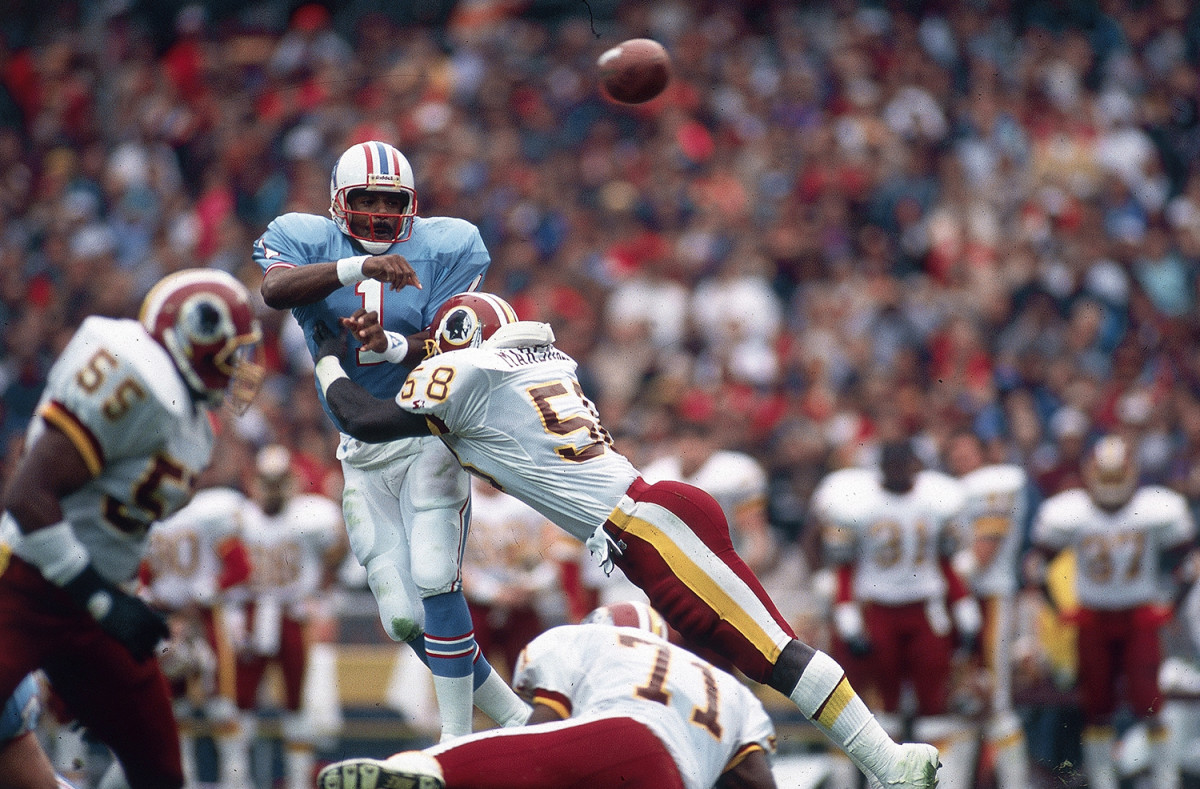
Warren Moon
Best NFL player ever to come out of the CFL—after the NFL initially spurned him
Warren Moon thrived not only as a collegiate quarterback but also a star in the CFL and eventually the NFL, in the face of coaches and evaluators who at the time believed black players belonged only at skill positions. In doing so, he carved a path for modern-day players to follow.
It is mind-boggling today to consider Moon’s path to nine pro bowls, two NFL passing titles and the Pro Football Hall of Fame. Lightly recruited out of high school, he used West Los Angeles College as a stepping stone to the University of Washington. Undrafted in 1978—among those taken in his stead were such immortals as Pete Woods, Mark Manges and Dennis Sproul—he used the Canadian Football League’s Edmonton Eskimos as a boost to the NFL. However, while Moon won an unprecedented five straight Grey Cup titles, he would still need to wait half a decade before proving his most ardent critics wrong.
When he finally got to the NFL, with Houston in 1984, Moon was the perfect player for the Oilers Run ’n’ Shoot offense and regularly amassed the kind of gaudy passing numbers that are expected of quarterbacks three decades on. He topped the 4,000-yard mark four times in his career and the 30-touchdown mark twice. He orchestrated 35 game-winning drives and was twice named Offensive Player of the Year.
Remarkably, Moon still hangs on to a spot in the NFL’s top 10 all-time leading passers despite not playing in the league for five years after college. As the Undefeated’s Jason Reid noted, he is now a sounding board for modern black quarterbacks such as Cam Newton and Russell Wilson—and serves as a warning to evaluators and coaches everywhere about the dangers of stereotyping and closed-mindedness.
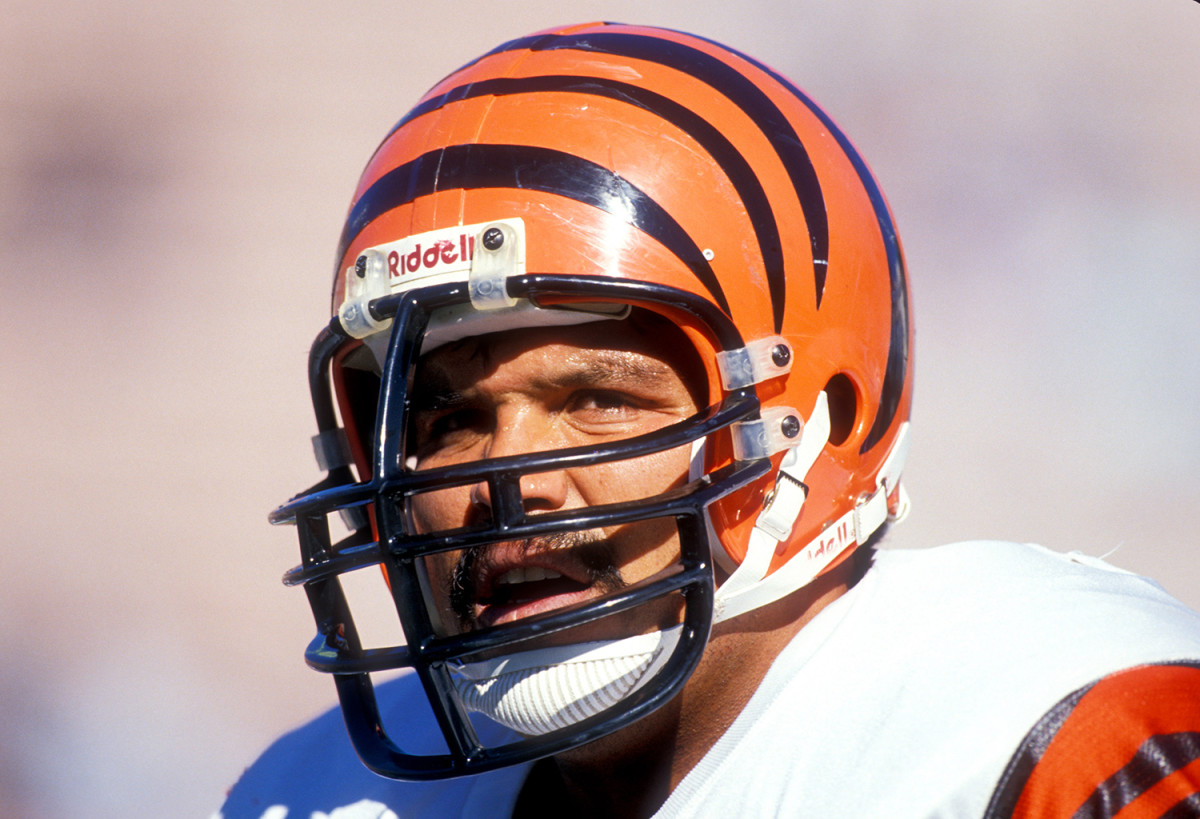
Anthony Muñoz
Arguably the greatest offensive lineman, and greatest Latino player
Sometimes a legacy is as straightforward as being an immensely gifted player, getting drafted high, living up to expectations and then surpassing them, and walking away as perhaps the most accomplished man to ever play your position. Simple.
Meet Anthony Muñoz. Drafted third overall out of USC in 1980 despite being viewed as an injury risk after missing significant time over his junior and senior seasons with knee trouble, Muñoz cracked the Bengals starting lineup as a rookie. He would go on to miss just 10 games in his first 12 seasons, earning a staggering 11 trips to the Pro Bowl and an even more staggering nine First-Team All-Pro selections. His Hall of Fame induction in 1998 was a mere formality.
The grandson of a Mexican immigrant, Muñoz is the greatest NFL player of Mexican of descent, and he has become an ambassador for the game in a country into which the NFL continues to expand its reach. Nineteen years ago he started a youth camp that, now in conjunction with the NFL and the Pro Football Hall of Fame, has him traveling across the U.S. as well as to Mexico City, teaching football and team-building to Hispanic youths.
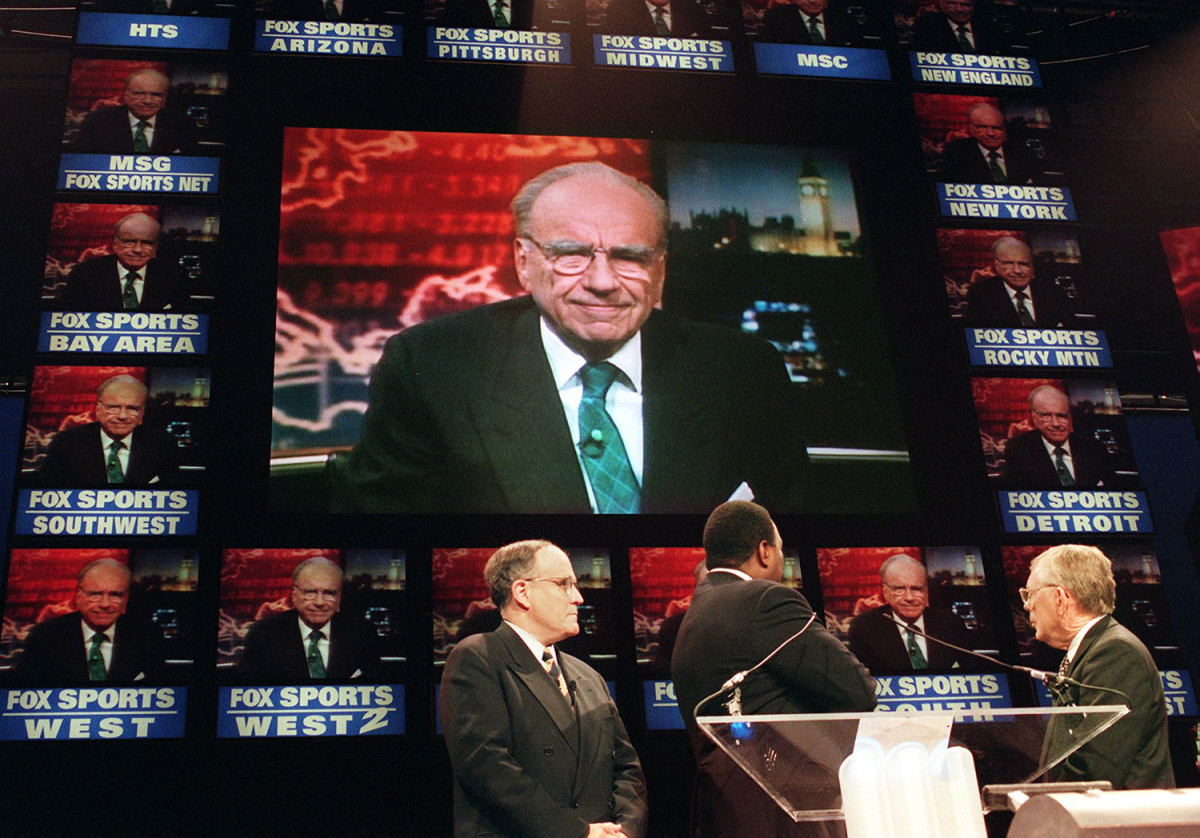
Rupert Murdoch
Fox impresario whose network broadcasts reshaped the league’s image
An international media kingpin best known for his American news network and his ownership of various other influential, often abrasive conservative news outlets in the U.K. and his native Australia, Ruper Murdoch also had a significant hand in the cultivation of the NFL’s modern brand.
In 1986 Murdoch launched Fox Broadcasting Company as a brash and iconoclastic challenger to the Big Three, CBS, NBC and ABC. While the network’s reach grew and it boasted some prime-time hits, Murdoch realized that it was NFL programming—specifically, game broadcasts—that would lift Fox to equal footing among the major networks. In 1993 Fox bid $1.58 billion over four years for the NFC’s broadcast rights, $100 million more per year than CBS.
Murdoch applied the basic principles of his various news and television outlets—ratcheting up the volume—to the NFL, which, in turn, helped formulate the display-heavy, bells-and-whistles version of the televised product we see today. Murdoch also used the spectacle of football to earn credibility (and grow an audience) for his network, turning it into the major cultural and political force that it is today.
Murdoch is far from beloved—he literally has a Bond villain analogue—and wide swaths of the public in the U.S. and abroad view his vast influence on society as corrosive. But he had unparalleled insights into the value and influence of the NFL as an American brand. Murdoch and those under him (most notably fellow Aussie David Hill, who headed Fox Sports in the ’90s) imagined a future in which pro football coverage would blossom beyond its single-digit camera setup into a Sunday spectacle, with zooming graphics, loud information, celebratory pregame shows and festive music. And, of course, a robot.
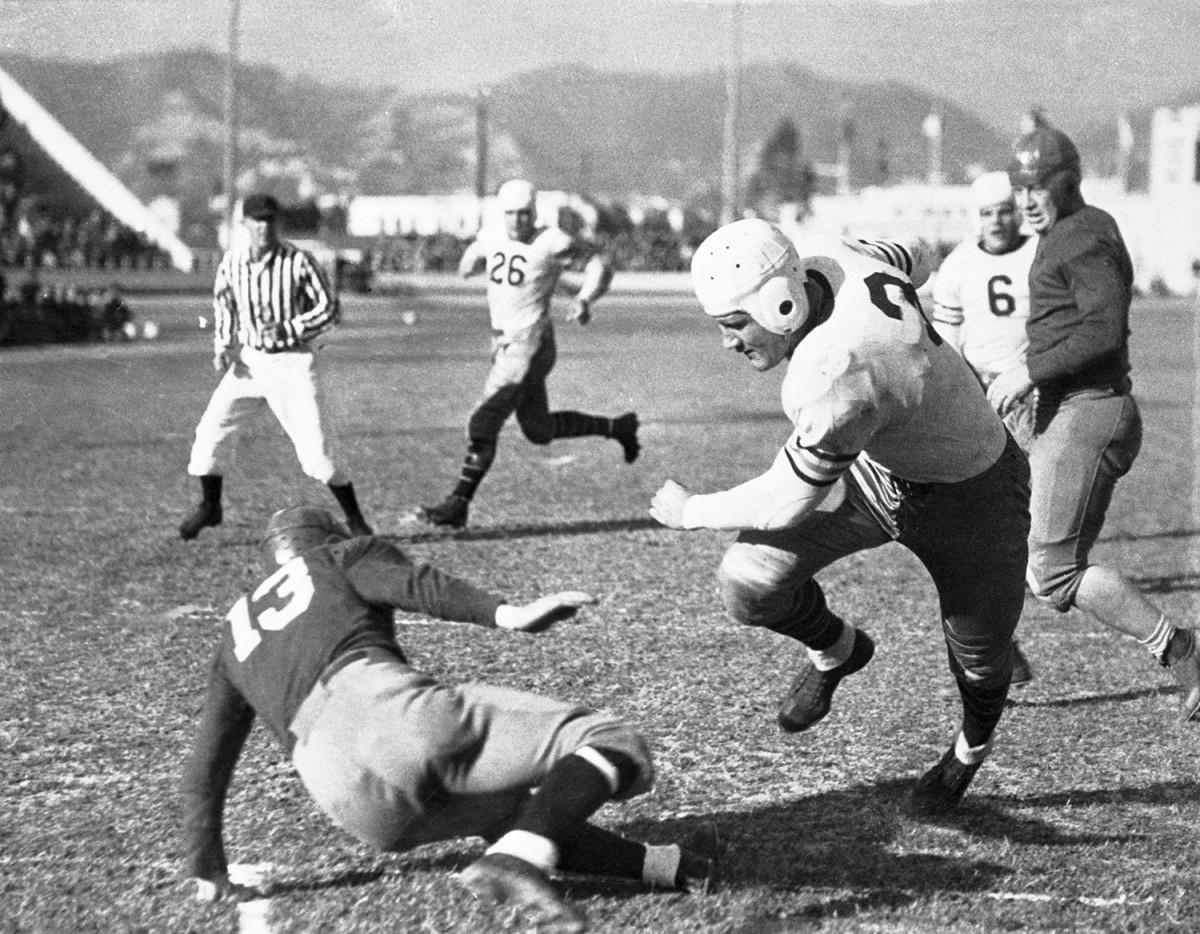
Bronko Nagurski
Legendary tough guy of the rough-and-tumble ’30s
Was Bronislau “Bronko” the strongest football player of his era? The two-way player for the Bears was so difficult to tackle, and his strength so impressive, that stories about him spun into the stuff of legend. Because he played in the 1930s, long before television created a record of the game, his feats became even more fantastic in each retelling.
There was the story of how his college coach at Minnesota, Clarence Spears, discovered him in little International Falls, Minn. Spears was there to recruit another player but saw Nagurski plowing a field—without the help of a horse. Spears asked the youngster for directions, and Nagurski lifted his plow to point him in the right direction.
Or the time in the NFL when Nagurski scored against the Redskins on a play that began when he ran over the center. He then sent two linebackers reeling, pummeled a safety and stopped only when he crashed into the brick wall at Wrigley Field. “That last guy gave me an awful good lick,” Nagurski allegedly told coach George Halas. The legendary tough guy is said to have had the largest championship ring ever made—size 19½.
“One time Bronko hit me from behind and I thought a grandstand collapsed on me,” said Green Bay tackle Cal Hubbard.
Nagurski checked in at 6'2" and 226 pounds in an age when the average lineman weighed 210. His versatility is unheard of in today’s game—not content just to carry the ball, he lined up at linebacker when Chicago was on defense. Chicago benefited from a 1933 rule change that allowed passing from anywhere behind the line of scrimmage. This legalized Nagurski’s jump pass and made him a dual threat on offense.
The four-time All-Pro helped the Bears win championships in 1932 and ’33, and then again in ’43, when he came out of retirement after six years off to join a Bears team whose roster was depleted because of the war. Red Grange, who made up the other half of Chicago’s running back tandem in the 1930s, once said about Nagurski: “He was the best player I ever saw. He had the power of Larry Csonka, but was faster, and he was good as Dick Butkus on defense, maybe better.”
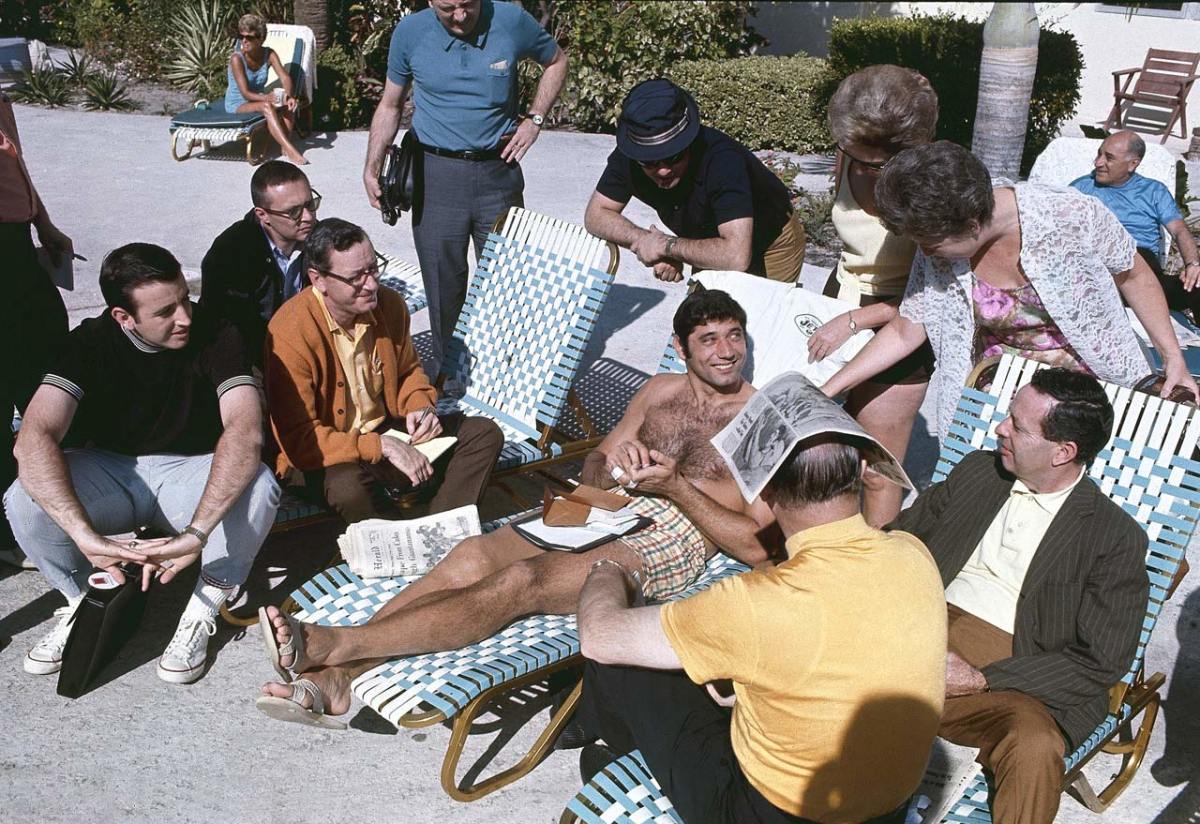
Joe Namath
Fabled ’60s playboy who glamorized the quarterback position
Glancing at Joe Namath’s statistics in isolation might cause some confusion if you’re wandering around the Hall of Fame in Canton. He lost more games than he won. He threw significantly more interceptions (220) than touchdowns (173). His lifetime quarterback rating (65.5) is closer to that of JaMarcus Russell (65.2) than Peyton Manning (96.5).
But taken in its entirety—the looks, the aura, the swagger—and it begins to make some sense. Namath was one of the first to truly glamorize the role of quarterback, not just in football but in mainstream America. He dressed stylishly. He grew his hair long and cultivated a Fu Manchu mustache. He womanized, at a time when that served as proof of some existential manhood. He embodied the nickname “Broadway Joe.”
And, of course, Namath famously backed up a poolside guarantee that the Jets would defeat Johnny Unitas and the massively favored Colts in Super Bowl III, a stunning proposition. The win would establish the AFL as the NFL’s equal, and also serve as the most significant victory in Jets history, a high point the franchise has not approached since that 1968 season.
To put in perspective Namath at the height of his power, one former teammate said he once watched the quarterback coming off the bench and running onto the field in a comeback situation, and the crowd noise drowned out passing airplanes. Monday Night Football in its early days was built around Namath’s schedule, just as the league these days works to showcase top teams in the best broadcast slots. Namath had his own prime-time television show. He acted in Hollywood movies. He appeared on Broadway and guest-hosted the Tonight show when Johnny Carson was out.
While his post-career life included struggles with alcohol, peaking in an embarrassing televised moment of sideline harassment involving reporter Suzy Kolber, Namath now boasts a newfound sobriety, and a certain Zen, mirroring the carefree persona of the 1960s and ’70s that aided his rise in the first place.
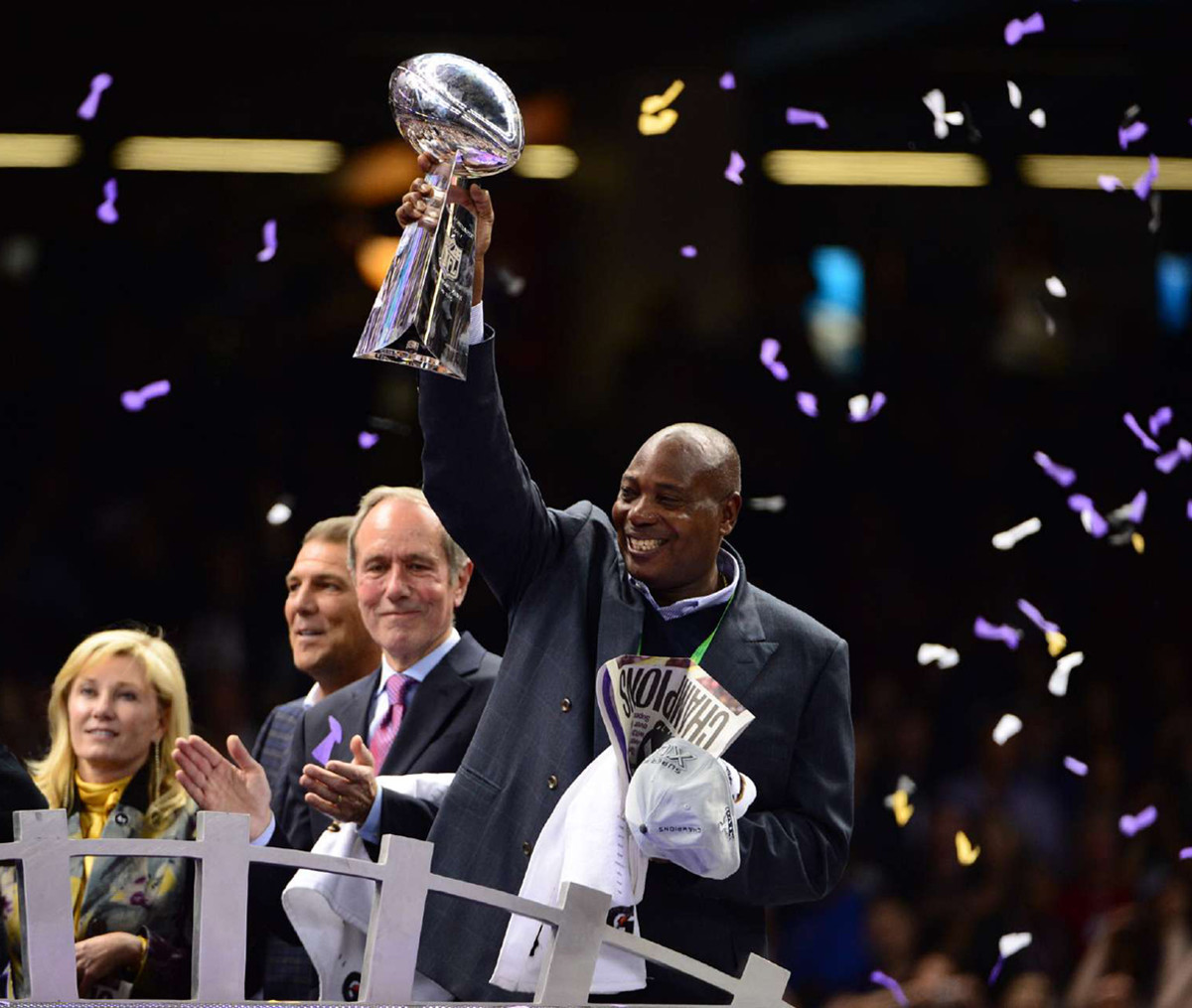
Ozzie Newsome
Hall of Fame tight end, first black GM and architect of powerhouse Ravens teams
Ozzie Newsome won’t go into the Hall of Fame as an executive because he’s already enshrined in Canton as a player. That doesn’t mean the Hall shouldn’t make an exception. A first-round pick out of Alabama by Cleveland in 1978, Newsome made six All-Pro teams and held the NFL records for tight ends in receptions, receiving yards and touchdowns for 21 years after his retirement.
Joining the Browns front office, he worked his way up the ladder and followed the team to Baltimore to become the Ravens’ first vice president of player personnel. In their inaugural draft in ’96, Newsome held the fourth and 26th overall picks, which he used on Jonathan Ogden and Ray Lewis, respectively. So far there have been five Hall of Fame players from the 1996 draft, and Newsome selected two of them.
Newsome’s Ravens won the Super Bowl in the 2000 season, and in 2002 Baltimore promoted him to general manager, making him the first black GM in NFL history. From 2002 to his retirement after the 2018 season, Newsome had just four losing seasons while enjoying nine playoff years and another Super Bowl victory following the 2012 season. Eighteen of his draft picks have played in the Pro Bowl. His legacy obviously extended off the playing field, but it also extended to other front offices. Several black GMs have followed Newsome, and he’s always been a sounding board for them.
“They will tell you that Ozzie has been a guy who will take a call and just talk,” John Wooten, the former chairman of the Fritz Pollard Alliance, told SI in 2013. “That’s what he just does, that’s the way he is. He’s not one of these guys that if you’re not in his circle, you’re not going to get anything from him. They have received great advice. He’s been a great mentor to those guys.”
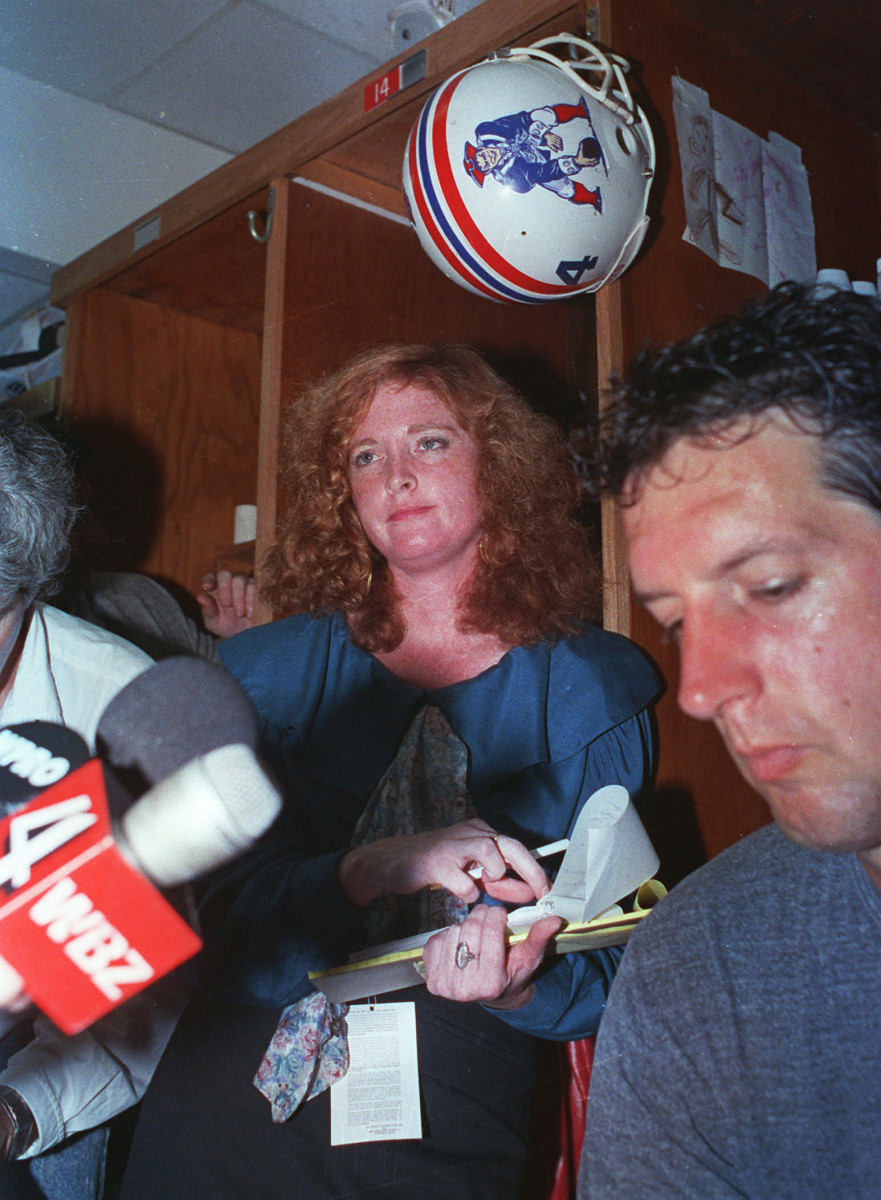
Lisa Olson
Pioneering journalist whose mistreatment in the Patriots locker room changed how the game is covered
The NFL, and the sports journalism world as a whole, still has a long way to go in terms of how it treats female reporters in traditionally male-dominated environments. But had it not been for the progress forged by Lisa Olson, a Boston Herald sportswriter who stood up to the rampant sexism and harassment common in locker rooms in the ’90s, there’s no telling where the profession would be now.
On September 17, 1990, Olson was conducting interviews in the Patriots locker room when she was subjected to obscene gestures and comments from several players. Her subsequent complaint was originally dismissed by team owner Victor Kiam, who would later joke about the incident at an all-male dinner. Olson filed a lawsuit against the team that was settled out of court, and the league conducted its own investigation, leading to fines for the players involved and to the team for not protecting the reporter’s right to do her job. According to the New York Times, then-commissioner Paul Tagliabue told Kiam that the incident was “damaging to the league.” Meanwhile, the atmosphere in the Boston area became so toxic for Olson, who was booed and taunted by fans, that she left the country for a spell, working for the Sydney Morning Herald before returning to the New York Daily News, The Sporting News and AOL’s Fan House.
Fast forward almost 30 years, and it’s clear that press boxes have diversified, though nowhere near as quickly as they should have. News organizations everywhere have struggled to make their roster of reporters reflect the communities they serve, not to mention the wide array of experiences and backgrounds of the people they cover.
In that time, there have been countless issues involving female reporters in and out of NFL locker rooms. Tara Sullivan of the Bergen Record was denied entrance to a locker room following The Masters in 2011. Jourdan Rodrigue of The Charlotte Observer was chuckled at by Panthers quarterback Cam Newton for asking a question about a certain route. And there are the countless issues every day that are simply felt and experienced but not reported. In such moments Olson’s fearlessness can serve as a foundation for the long push ahead to equality.

Dr. Bennett Omalu
Former Pittsburgh coroner who first identified CTE in NFL players
Perhaps the single most significant name in football post-2000, Bennet Omalu—the Nigerian-born doctor who first discovered evidence of brain trauma in the body of former Steelers great Mike Webster—changed the way everyone from players and coaches to administrators and concerned parents have approached the violent sport.
The emergence of chronic traumatic encephalopathy as a diagnosis in deceased players, and its growing correlation with the behavior and actions of players who suffered from issues such as mood swings, depression and other unpredictable vacillations in personality, was like detonating a landmine in the football community. Cognitive impairment as a result of sports was once thought to be reserved for boxers—“punch drunk” was the term often used—and its identification among football players had a jolting effect. CTE research was at the heart of the lawsuit filed by former players and their families over the physical and psychological impairment they suffered in retirement, culminating in a $1 billion settlement in 2013. It has also revolutionized in the way coaches understand the necessity of contact during practice, and the techniques with which players can tackle more safely.
Omalu, who was played by Will Smith in the movie Concussion that dramatized his difficulties in finding acceptance for his research, famously faced pushback from scores of complicit doctors and other NFL yes-men who feared what such knowledge would do to the sport. If nothing else, the mainstreaming of hard facts, paired with the sympathetic stories of struggling post-career players—including such stars as Junior Seau, Jim McMahon and Nick Buoniconti—pulled back the curtain on the health and safety efforts of the NFL that, until Omalu came along, were largely just window dressing.
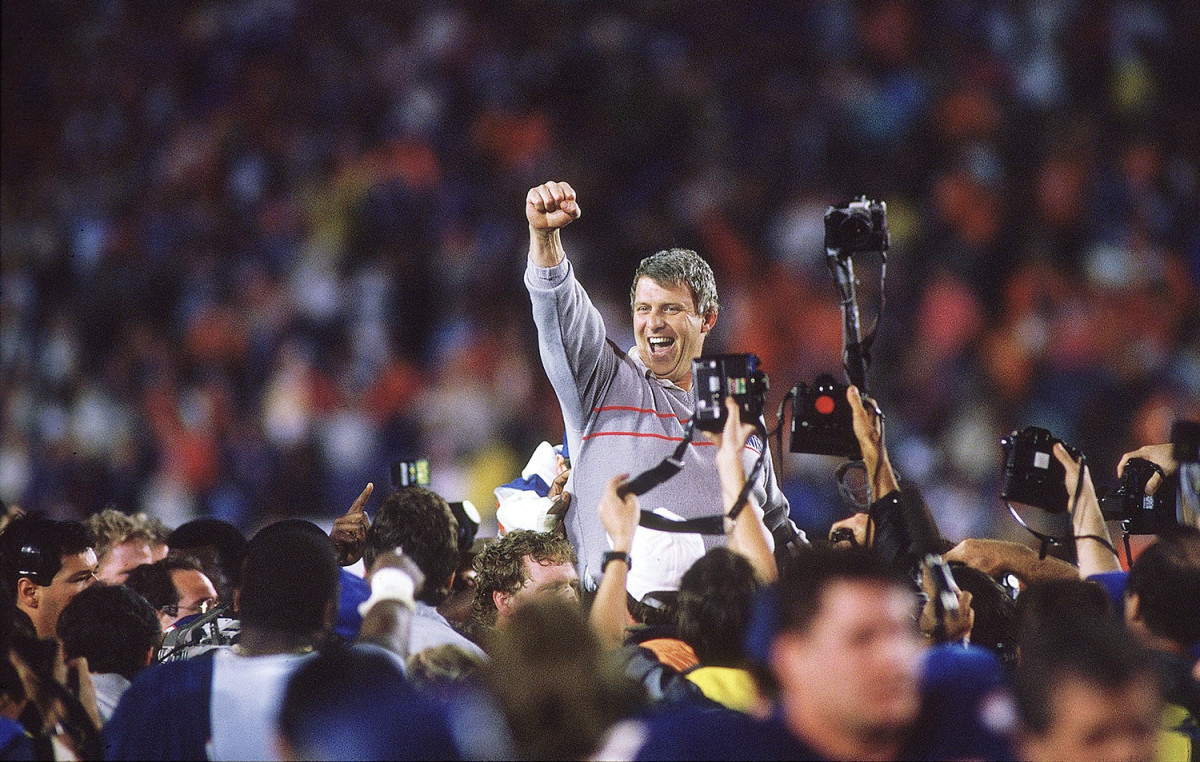
Bill Parcells
Hall of Fame coach with extensive tree and unparalleled competitive drive
Bristly, gruff and ultimately unforgiving, Bill Parcells was not always a coach upon whom players reflected with great love and affection. But there is little doubt: His two Super Bowl wins and subsequent coaching tree that produced a troika of legendary Super Bowl-winning head coaches place him among the most significant men to ever walk the NFL sidelines.
Perfect for New Jersey, Parcells thrived in chaos. As the coach of the Giants from 1983 to 1990, he oversaw a defensive revolution brought on by his whip-smart coordinator, Bill Belichick. Everything from the way the Giants punished opponents to the way they deftly maneuvered between quarterbacks became part of Parcells’ persona. So did his trademark aura, which brought him to remarkable highs as a coach but also marked him as a man who did what he wanted when he wanted, and was not afraid of the consequences. During his stint coaching the Cowboys, he famously defied owner Jerry Jones, saying that he wanted a larger hand in personnel management. (If I’m going to cook the meal, you should at least let me shop for the groceries.) Parcells has touched franchises across the NFL. As a head coach he won Super Bowls with the Giants, made a Super Bowl with the Patriots, took the Jets to the AFC title game and helped turn around the adrift, post-Jimmy Johnson Cowboys. His mentorship of Saints coach Sean Payton is also significant and has been evident throughout Payton’s tenure in New Orleans.
Though his combative nature seemed to contribute to the peaks and valleys of his career (and his health), Parcells has always been a thrill-seeker. In his retirement he still owns racehorses and obsesses over the stock market, which, he reminds anyone who will ask, is not for the sane. For a coach who was mentored by the great Vince Lombardi disciple Mickey Corcoran, himself a friend and former colleague of Bob Knight, not competing is not an option.
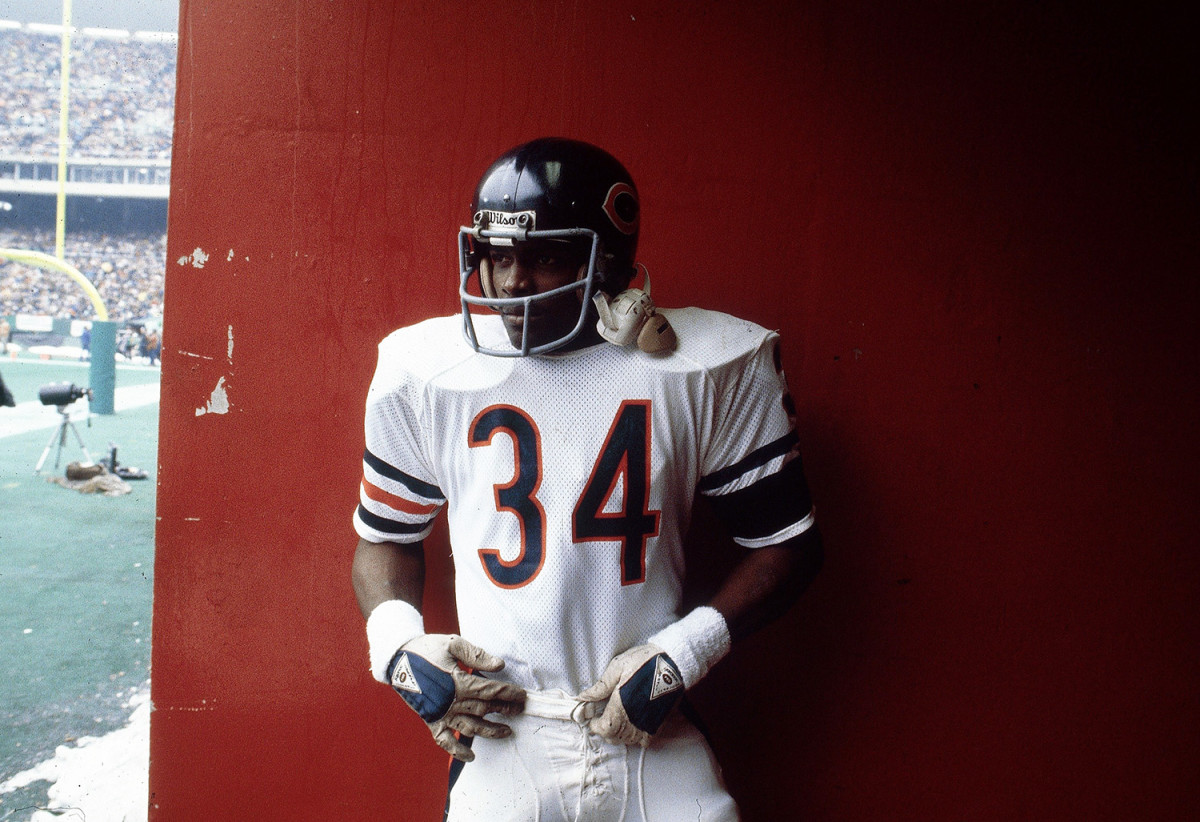
Walter Payton
Beloved Bears back after whom the league’s humanitarian award is named
Upon being drafted fourth overall by the Bears in 1975 out of Jackson State, Walter Payton said, “When I get through with Chicago, they’ll be loving me."
The statement proved prophetic. Over 13 seasons with the Bears, the soft-spoken kid from Mississippi won over his adopted city, and the league as a whole, with his infectious smile and joyful approach to the game. Payton was an expert jokester, and he was notorious among his teammates for the pranks he’d pull on them. “Sweetness,” they called him.
He was also relentless. Payton’s hill sprints became the stuff of legend—the spot near his suburban Chicago home where he put himself through the brutalizing workout now bears his name—and his offseasons back in Mississippi were even more demanding. It all paid off on the field: He led the league in rushing attempts for four straight years from 1976 to ’79, amassing huge yardage totals on middling Bears teams. In 1984 he surpassed Jim Brown as the NFL’s all-time leading rusher; the following season he and the Bears won a Super Bowl. His single-game record of 275 rushing yards stood for 23 years.
Payton was also arguably the greatest all-around offensive player the game has seen. He is third all-time in yards from scrimmage, his 492 career receptions led all running backs upon his retirement, his blocking was formidable, and he even lined up at quarterback in a pinch. He has more touchdown passes than any other running back who began his career after 1952.
Payton’s life after football was tumultuous, and privately he struggled with the loss of identity many professional athletes face when they retire from the game. Still, he remained an icon in Chicago, and his untimely death from bile duct cancer in 1999, at the age of 45, stunned and saddened the football world. After Payton’s death, the NFL’s Man of the Year award, given to a player for excellence on and off the field, was renamed in Payton’s honor. He’d been its 1977 recipient.
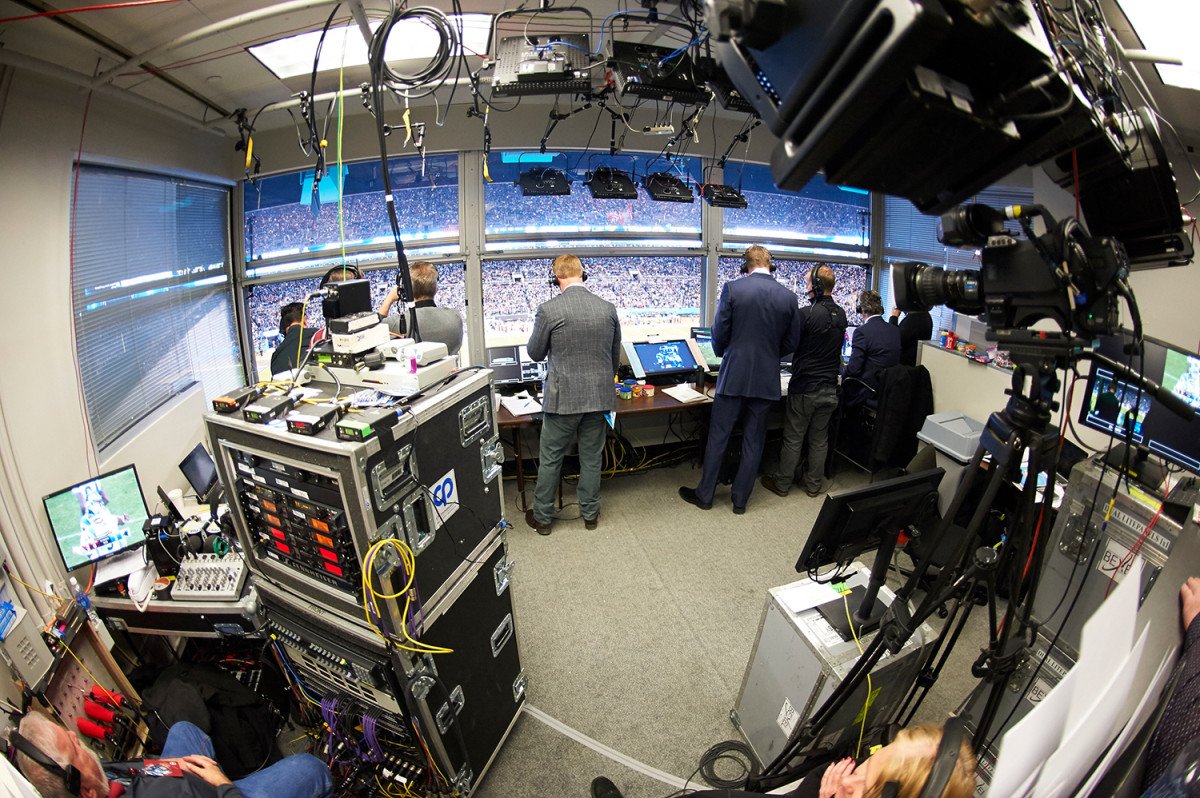
Mike Pereira
Former game official who brought rules analysis to NFL broadcasts
Given the biblical length and ever-expanding legalese of the NFL rule book, it was only a matter of time before a broadcast network took advantage of a personable referee to explain the calls on air.
Enter Mike Pereira, the league’s former vice president of officiating, who turned his weekly segments on NFL Network into what has become one of the most indispensable jobs in football: on-air rules analyst. Since joining Fox in 2010, Pereira has ushered in a blanket change across many sports, especially those (NASCAR, PGA tour) featuring similarly byzantine rule sets. While the results have not always been great (bless you, Mike Carey), the need for someone to come on the air and talk authoritatively during a moment of officiating discord has become solidified. Think back on the “Tuck Rule” game, the January 2002 playoff showdown between the Raiders and Patriots, which did not have a rules analyst and left the task to a speculating Phil Simms at one of the most critical points of the season.
Not that it’s all good. Hyperanalysis of officials—the minute scrutiny, constant questioning, and calling out of mistakes by former colleagues—has a certain corrosive effect on the perception of the zebras, and that has trickled down to lower levels of the sport, where scholastic and youth organizations are having a harder time finding game officials. But until a fan’s demand for a more streamlined and easier-to-understand game (think, the Alliance of American Football’s full-disclosure style of officiating, which brought fans into the booth as these discussions were happening) is met, analysts such as Pereira will be essential to understanding the minutiae of NFL rules and officiating procedures.
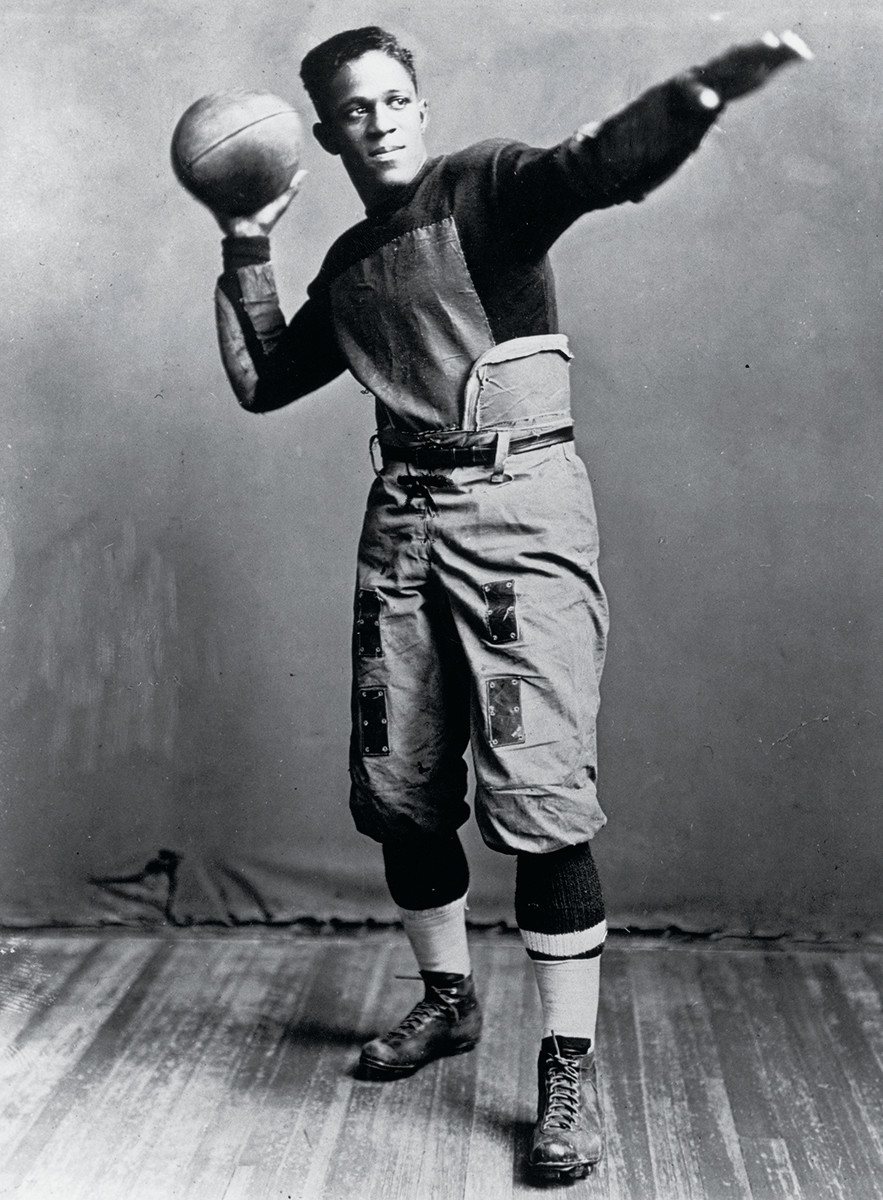
Fritz Pollard
Member of first NFL champion and co-coach the next year; among the best of the black players of the ’20s, before the NFL’s racial barrier was instituted
Upon entering the locker room for his first day of practice at Brown University, Frederick Douglass “Fritz” Pollard was promptly called a “nigger” by a white teammate, then sent to a corner of the practice field to punt footballs by himself for nearly the entire session. When he hit the showers, a previously rowdy and jovial bunch of white teammates went silent and cleared the room, and when he sat near the front of the trolley home from practice that night, players cleared the rows around him, and some hopped off to hitchhike rather than ride with a black man. “The thing I most remember,” Pollard later said of that first day of practice, “was the humiliation.”
Pollard, of course, persevered, becoming the first African-American to play in the Rose Bowl and the second African-American to earn All-America honors. He went on to become pro football's first black quarterback and first black coach; as a player, he was a member of the NFL’s first championship team, the Akron Pros in 1920 (the league was known as the APFA its first year). The following year he became a player-coach for Akron. Throughout his career he endured racist slurs and taunts from fans and players alike, enjoying none of the perks of athletic celebrity in a segregated America; 1926 was his last NFL season, and after 1933 black players were absent from the league by unwritten agreement among teams; pro football did not reintegrate until 1946.
Of those who subjected him to abuse, Pollard told NFL Films, “I didn’t get mad at them and want to fight them. I would just look at them and grin, and in the next minute run for an 80-yard touchdown.” Pollard, who was inducted posthumously into the Pro Football Hall of Fame in 2005, is the namesake of the Fritz Pollard Alliance, a professional organization of scouts, coaches and front-office personnel in the NFL committed to equal opportunity in football.
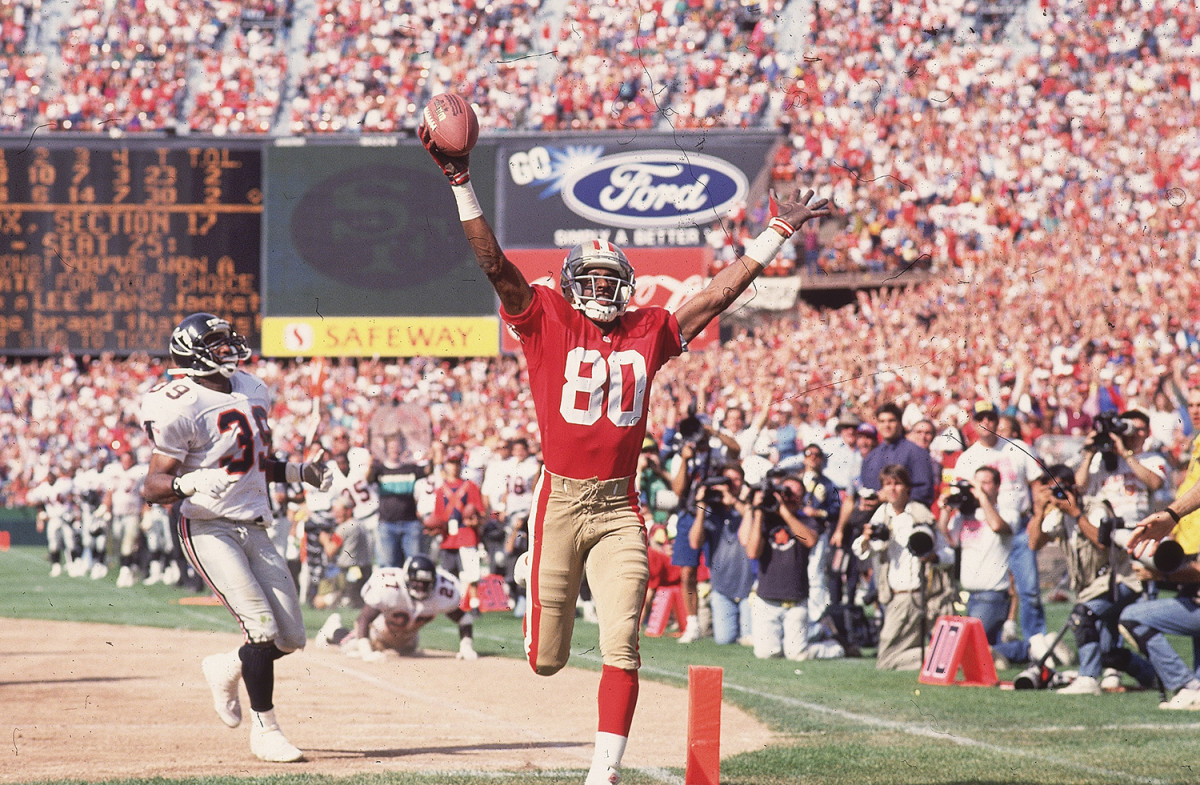
Jerry Rice
GOAT receiver
We hear all the time that receiving stats have become inflated in today’s pass-friendly NFL. And yet, almost everyone agrees: No receiver will ever match Jerry Rice’s record of 22,895 receiving yards. No. 2 on the all-time receiving list is Larry Fitzgerald, at 16,279. Arizona’s future Hall of Famer would need four more All-Pro-caliber seasons to catch Rice (who, it must be noted, was a 10-time First Team All-Pro and two-time Second-Teamer).
We could dart in hundreds of directions that illustrate Rice’s staggering production over his 20-year career. (One more: No receiver in the modern era has led the league in receiving more than twice … except Rice, who did it six times.) But more inspiring than his production was the way it came about. His speed was good but not great. Same for his size (6'2", 200). His hands were excellent, of course, but not jaw-dropping in a highlight reel sense like DeAndre Hopkins’s or Odell Beckham’s.
Rice is a reminder of a fact we all love but often overlook: that raw talent is not everything. Hard work and attention to detail matter. That’s especially true at receiver, where getting open stems from the timing and technique of setting up defenders. Rice did it better than anyone, which is why he was prolific in so many big games. He went 3-1 in Super Bowls (the one loss coming during his quietly accomplished three-year stint with the Raiders), and his playoff receiving records are even more extreme than his regular season records.
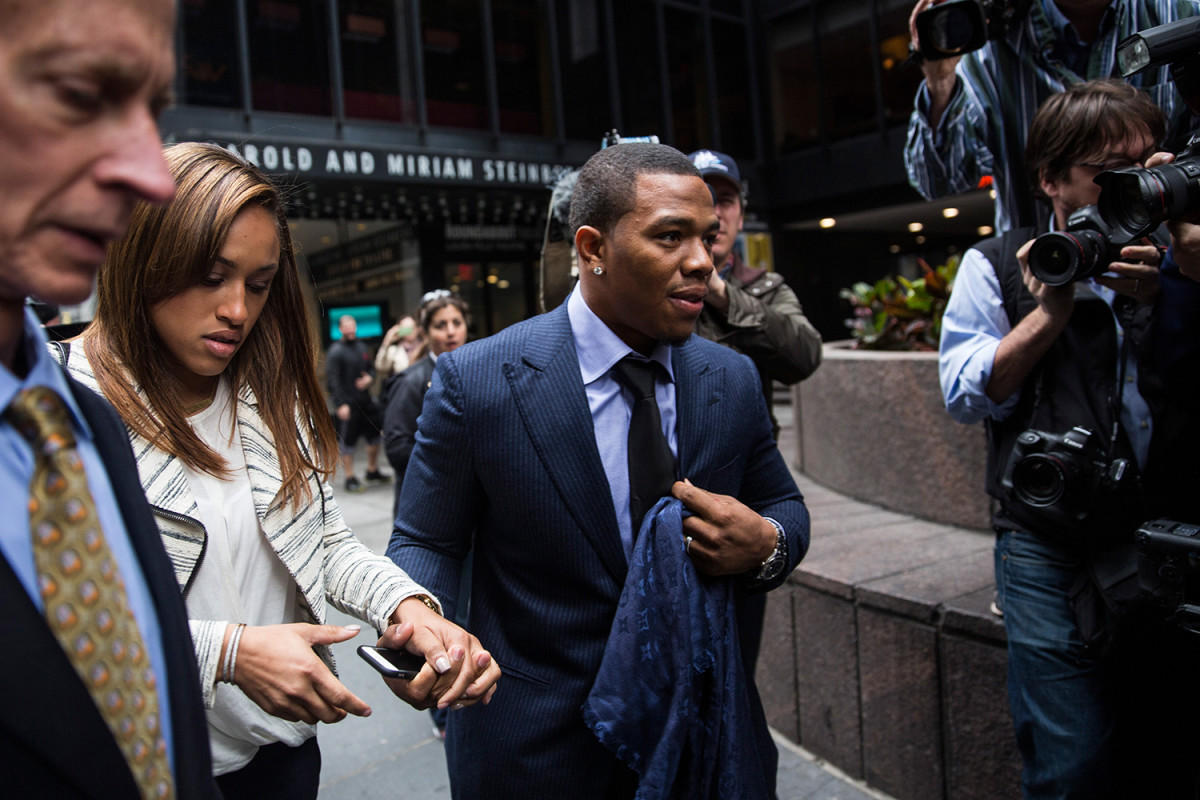
Ray Rice
Productive running back whose domestic violence case exposed league’s failures on social issues
Ray Rice played six seasons as a running back for the Baltimore Ravens, rushing for more than 6,000 yards and playing on the Super Bowl XLVII champion team. He makes this list not for what he did during his NFL career but for the incident that ended it, and forced a re-examination of the NFL’s handling of domestic violence cases. In February 2014, Rice struck his fianceé, Janay Palmer, and dragged her out of an Atlantic City casino elevator. The criminal assault charges were dropped in exchange for his participation in a pre-trial intervention program, and the NFL suspended Rice two games. That was the extent of it—until the full video of the incident, including the punch, was released to the public by TMZ in September of that year.
The video changed everything, for both Rice and the league. He was promptly cut by the Ravens, who had stood beside him until that point, and he was suspended indefinitely by the league. The scrutiny the NFL faced, including from a number of big-ticket sponsors, forced an independent investigation into Roger Goodell’s handling of the case, by former FBI director Robert Mueller, and a hurried rewriting of the league’s personal conduct policy. Rice won his appeal to be reinstated later that fall, but he would never play in the NFL again.
In the years since, Rice has talked openly about his own rehabilitation and has used his voice to speak out against intimate partner violence. His case, particularly the video, put the spotlight on domestic violence in the NFL, spurring the league to adopt measures such as mandatory training and new investigative protocols. But five years on, the NFL is still grappling with many of the same questions it didn’t have answers to then, regarding how to prevent and penalize acts of violence, and rehabilitate those who commit them.
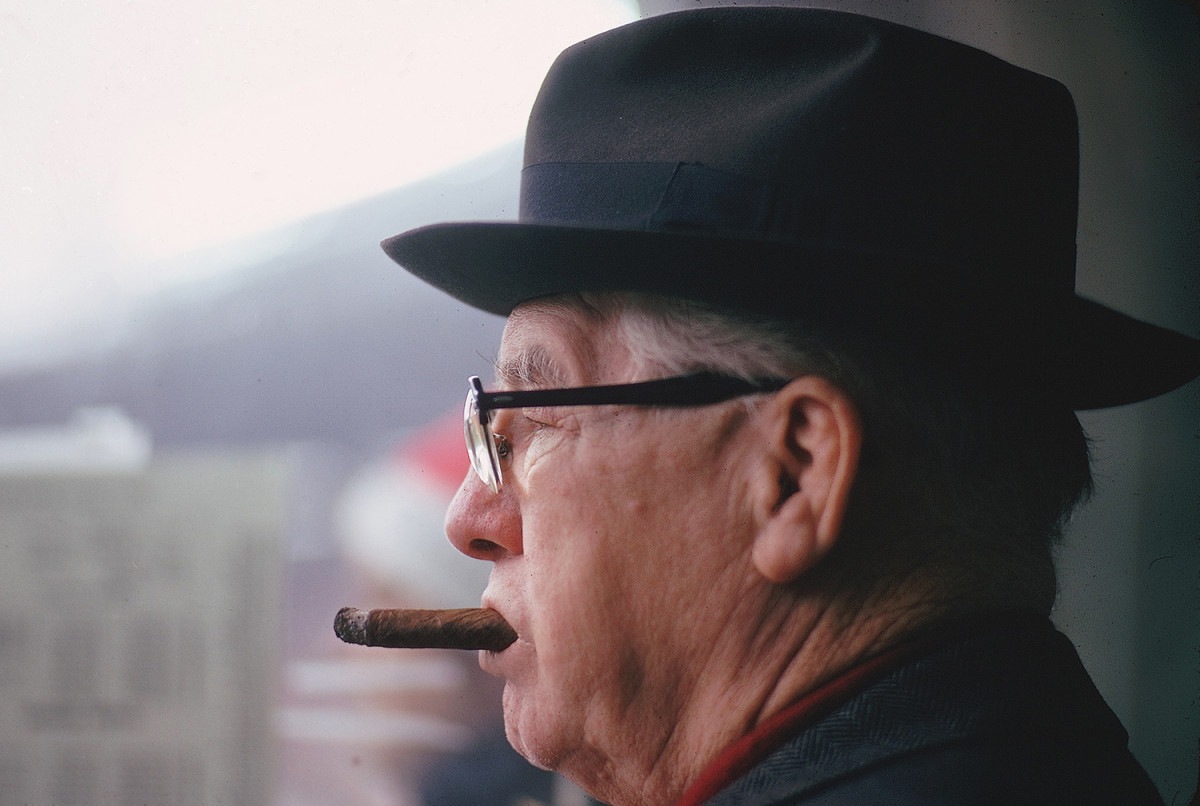
Art Rooney
Steelers patriarch who waited four decades for his team to become champions
“I paid $2,500 for it,” Art Rooney Sr. told SI’s Tex Maule in 1966,” but if I had wanted to be tough about it I could have had it for nothing.” That purchase of the then-named Pittsburgh Pirates in 1933—financed, legend says, by Rooney’s racetrack winnings—would not only turn out to be quite the bargain, but would also shape the history of professional football for the next nine decades. Rooney would shepherd the team into the NFL in their inaugural season and change their name to the Steelers in ’40 in honor of the city’s primary industry. Eighty-six years on, it is the oldest franchise in the AFC, tied for the most Super Bowl wins, and still owned by the Rooney family, now one of the most revered and influential names in sports.
Before the Steelers became synonymous with sustained success and respectability, they were consistently one of the worst teams in the league. However, in the 1960s Rooney stop treating the team “like “some kind of hilarious hobby,” as Maule wrote, and began to focus his attention on building the franchise into a winner. He hired Chuck Noll in 1969 and stayed loyal to the coach even after Noll lost 13 consecutive games in his first season. It would prove the right call, as Pittsburgh—behind the legendary Steel Curtain defense—would become the preeminent team of the ’70s, winning four Super Bowl titles in six seasons. After finishing .500 or better just 12 times in the team’s first 33 seasons, the Steelers have done so 27 times in their last 30 seasons.
Rooney, who before purchasing the franchise played semipro baseball and was an amateur boxing champion, forged a reputation as humble, compassionate and fatherly. He became one of the most visible and beloved figures in Pittsburgh, known as the Chief, and one of the most respected owners in the league. Upon his death in 1988, commissioner Pete Rozelle remarked: “He was a man who belonged to the entire world of sports … It is questionable whether any sports figure was more universally loved and respected.”
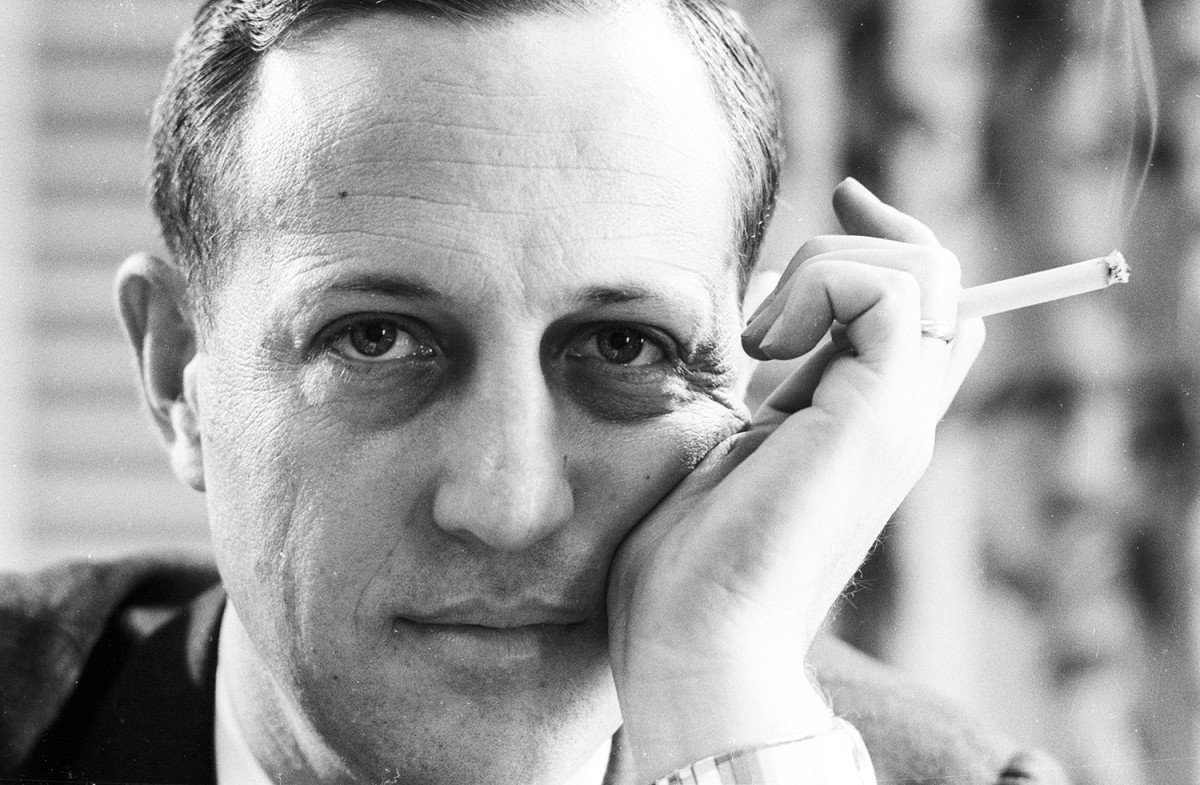
Pete Rozelle
Commissioner during pro football’s ascendance; oversaw the NFL-AFL merger, creating a sports juggernaut
If you look at the NFL in terms of quarter-century windows, there may be no more important administrator than former commissioner Pete Rozelle, who took the league from a middling property in the American sports landscape to an indomitable powerhouse upon his retirement in 1989.
Famously given the job at the extremely young age of 33 because, as Cowboys executive Tex Schramm told ESPN years later, “[the owners] thought they could control him,” Rozelle went on to use his background in public relations to help the NFL more than double in size and become a fixture on prime-time American television programming.
To this day Rozelle’s vision for the league places him among the most popular and revered leaders in any sport. From the beginning he seemed to understand what the rest of the country did about the potential of professional football. He relocated the league offices from suburban Philadelphia to Manhattan, he worked to create a modernized structure for television contracts and, ultimately, he brought the AFL and NFL together, creating the Super Bowl, one of the most important spectacles in global sports.
Certainly, current commissioner Roger Goodell has faced hurdles in his time, and given the heightened awareness of the game, has had to pay the price publicly for his decisions. But Rozelle also had to battle great upheaval, including more fractious labor relations and the threats of other seemingly well-funded professional leagues that sought to upend the NFL’s progress.
His career may be summed up best by what long-time Giants patriarch Wellington Mara told ESPN: Rozelle “moved the NFL from the back page to the front page,” and “from day time to prime time.”
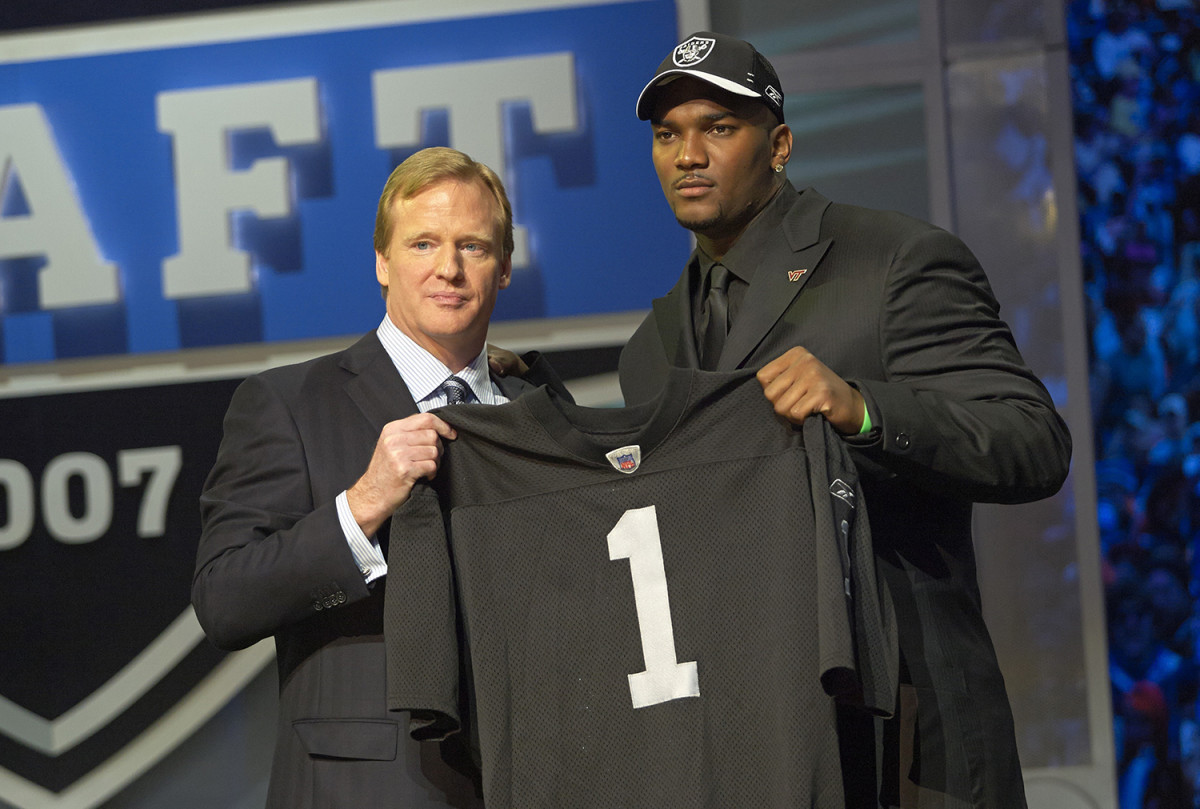
JaMarcus Russell
Colossal draft bust and the driving force in the institution of a rookie wage scale
JaMarcus Russell was the No. 1 overall pick by the Raiders in 2007, selected ahead of Calvin Johnson, Joe Thomas, Adrian Peterson and Darrelle Revis. He played three seasons, mostly overweight, threw 18 touchdown passes and 23 interceptions and had a 7-18 record as a starter.
Russell possessed one of the strongest arms the NFL draft has ever seen. Everyone has heard the stat: He once threw a football 65 yards while on his knees. Raiders owner Al Davis fell in love with that potential, and there was little debate pre-draft that Russell would be the top pick. But there was a contract holdout that stretched into the first week of the season—one of the longest in NFL history for a draft pick. Russell eventually agreed to a $61 million deal with $32.5 million in guaranteed money, nearly $6 million more in guaranteed dollars than the previous year’s first overall pick, Mario Williams.
But Russell just wasn’t very good. He struggled with accuracy and weight, and eventually Davis cut him. One year later the collective bargaining agreement was up, and thus began the rookie wage scale. No longer are top college prospects paid through negotiation of their (relative) market value. No. Their cash for the next four years is preordained—thanks in large part of Russell’s failures.
In the years after his release, Russell would try a couple of comebacks. Rumors abounded about his weight, and he never got more than a tryout. “But what if I don’t make it back to the NFL? I’ll be O.K.,” Russell told SI in 2011. “Being a competitor, I feel like I have unfinished business. Like, ‘It can’t end like this.’ But want to know the truth? I know that the game don’t owe me a damn thing.”
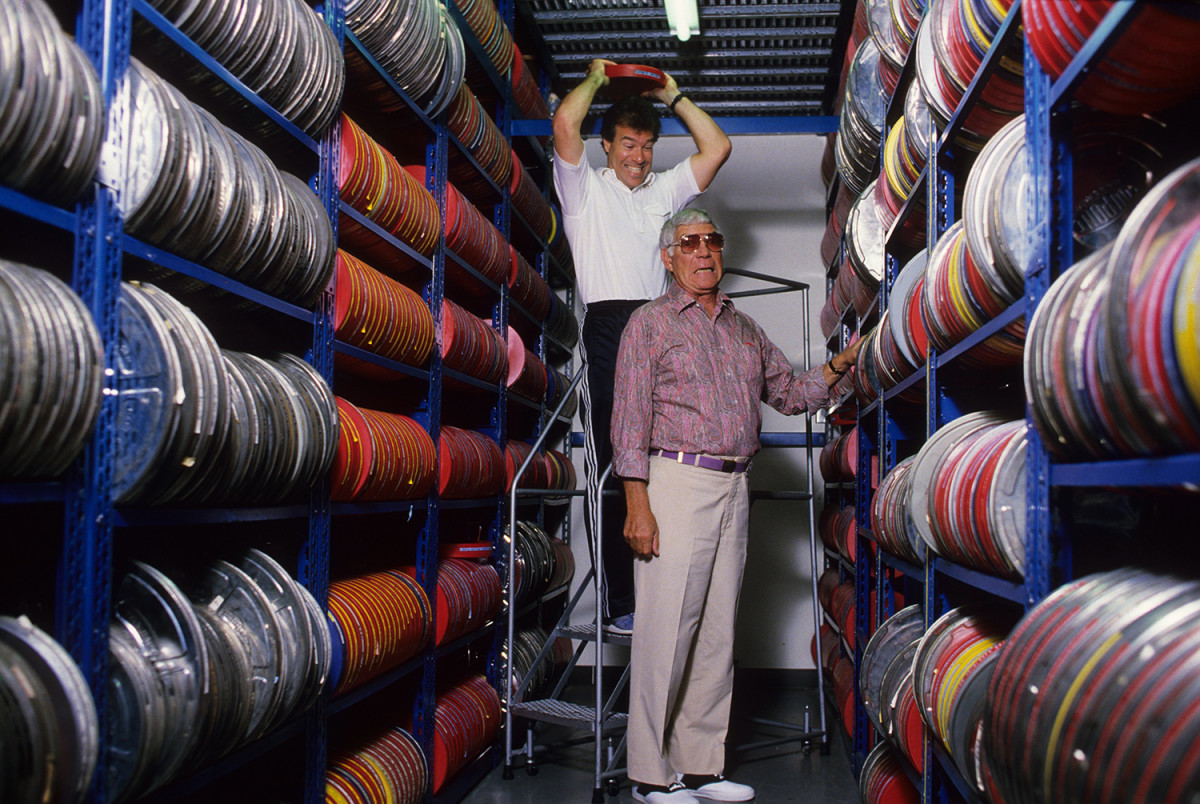
Ed & Steve Sabol
Creative minds behind NFL Films, shaping the public perception of football for generations
Ed Sabol founded the company that became NFL Films in 1962, five years before the first Super Bowl. His son, Steve, worked with him for years, then took over as president in 1985 and served in that capacity until his death in 2012. When NFL Films launched in the early ’60s, pro football lagged behind baseball, boxing and college football in the American sports landscape. But Big Ed and his son had a clear vision. They knew that the intricacies of the game were perfect for making cinematic magic, and through their art they helped the NFL grow into the American cultural institution it is today.
The Sabols were innovators in the field of sports programming. They were the first to mic up players and coaches for sound, which opened up the human side of the game to fans. They were the first to use ground-level slow motion and montage editing in sports, and they invented the blooper reel, the footage of on-field miscues that became wildly popular.
Most notably, perhaps, they employed dramatic musical scores—so affecting that the soundtracks were released on a series of CDs—and paired that with narration from John Facenda, known as “The Voice of God” for his stentorian performances of Steve Sabol’s grandiloquent scripts. Many of the camera angles and editing seen during football broadcasts today are part of the Sabols’ legacy, and it can be argued that so too is the on-screen portrayal of each game as a self-contained narrative, a theater not just of winners and losers but of heroes, villains and underdogs, a test of will and moral character. Perhaps more than anyone else, the Sabols cultivated the myth and mystique of pro football, and sold it to a willing audience. In 1999 SI’s Austin Murphy deemed NFL Films “perhaps the most effective propaganda organ in the history of corporate America.”
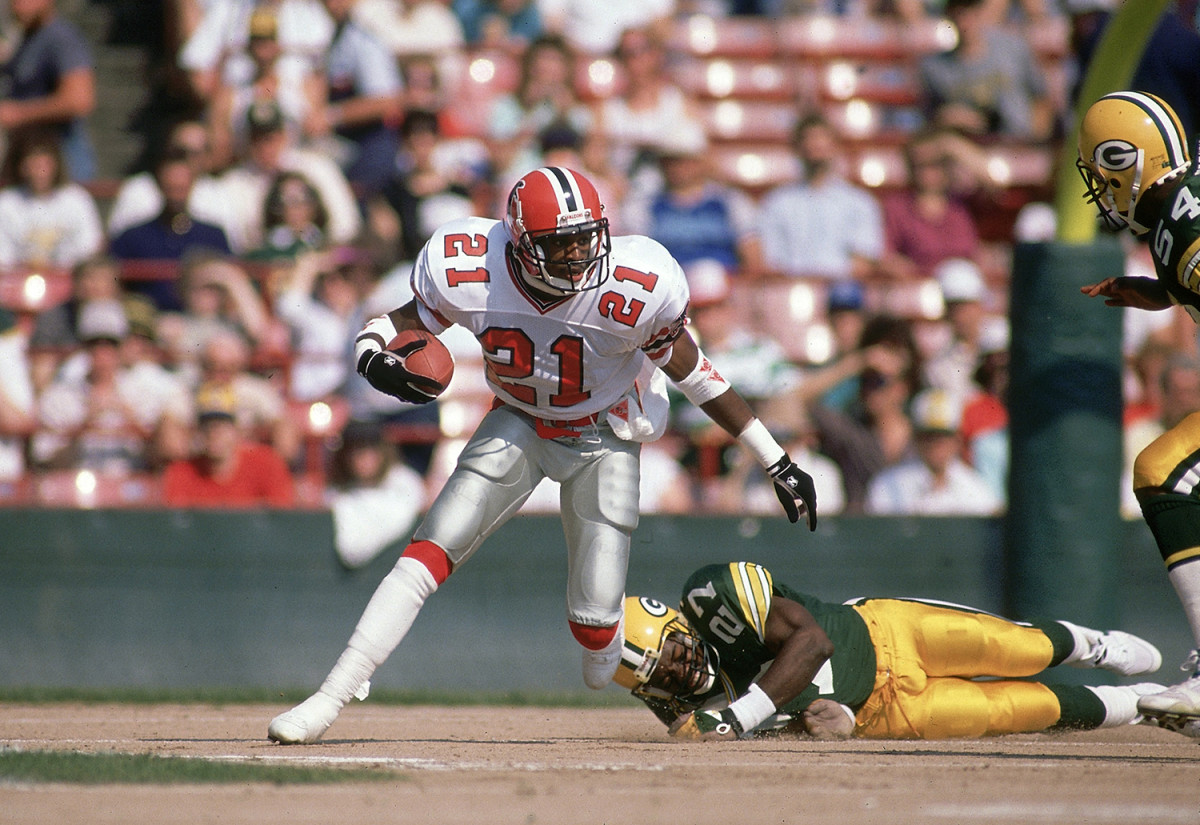
Deion Sanders
Flamboyant two-sport star who made cornerback sexy
In the modern era, only a handful of players have tried their hand at both the NFL and major league baseball, even fewer at the same time. Deion Sanders was arguably the most accomplished modern athlete ever to play at the highest level of both sports.
An All-America cornerback and star outfielder at Florida State, Sanders was drafted by both the New York Yankees and the Atlanta Falcons. Rather than choose one or the other, he followed Bo Jackson’s lead by choosing both. Sanders debuted for the Yankees on May 31, 1989; in September of that year he suited up at cornerback and return man for the Falcons. “Prime Time” ended up playing nine seasons for four MLB teams and 14 seasons for five NFL clubs. He is the only person to play in both the World Series (with the Braves in 1992) and the Super Bowl (with the Niners in 1995 and the Cowboys in 1996). His best baseball season was 1992, when he batted .304, stole 26 bases and led the league in triples, with 14. In the NFL, Sanders had 53 career interceptions and 22 touchdowns (nine pick-sixes, nine kick returns, three TD receptions and a fumble runback). A sometime wideout as well as corner and return man, he caught 36 passes for the Cowboys in 1996.
Flamboyant, mercurial and outrageously talented, Sanders also was unapologetic about his pursuit of the spotlight. “They don’t pay nobody to be humble,” he told SI in 1989. “I’m a businessman now, and the product is me.” But Sanders’ greatest legacy is his ability to transition between sports, and between positions in football, seamlessly. Former Falcons coach Jerry Glanville, growing accustomed to Sanders’ baseball absences, coined the term “Cat coverage” to describe his game-day instructions for his star: “I’d say to him, You see that cat wearing 81—or 17 or whatever the best receiver had on that day. You see him? You’ve got that cat all day; I’ll see you when the game’s over. Great coaching.”
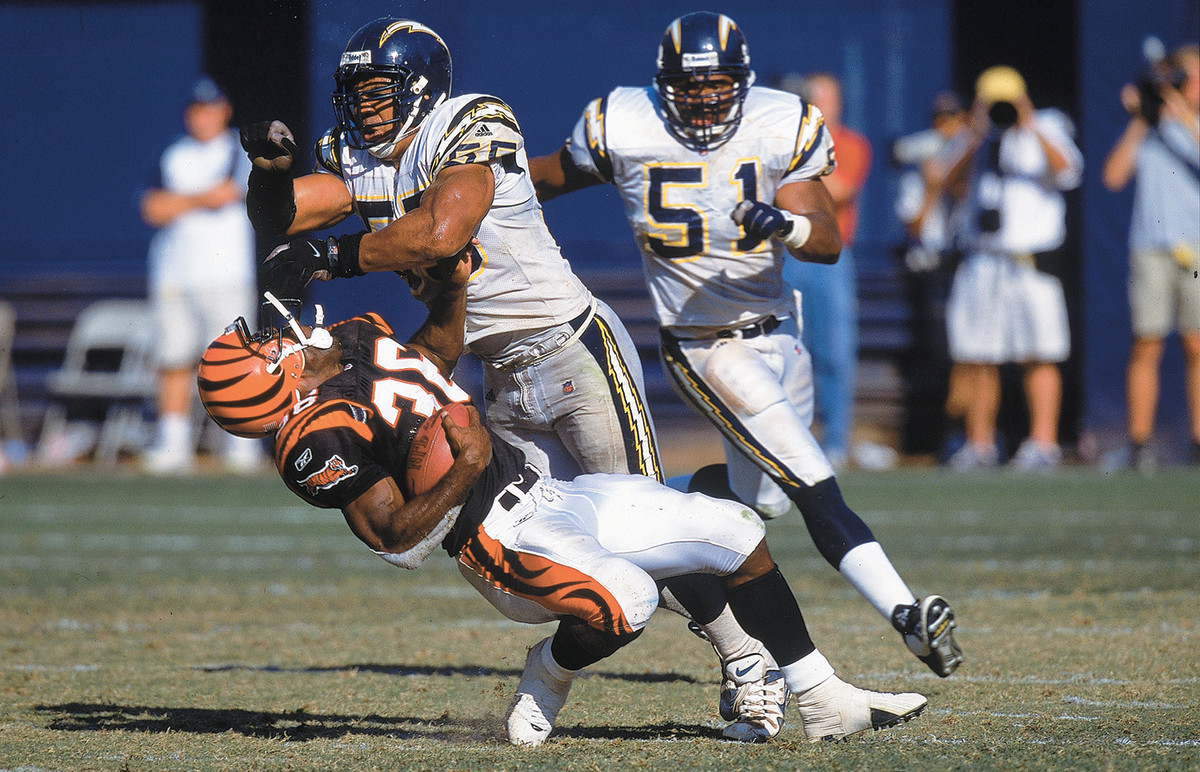
Junior Seau
Hard-hitting linebacker of Polynesian descent whose possibly CTE-linked suicide rocked sports
One of the greatest players in Chargers history and arguably the finest linebacker never to win a Super Bowl, Junior Seau was a six-time All-Pro and the 1992 NFL Defensive Player of the Year. As a homegrown hero who stayed true to his local roots and his Samoan heritage, he was, as SI’s Jim Trotter noted in 2012, the most popular athlete in a town where Tony Gwynn and Dan Fouts became icons and Ted Williams, Bill Walton and Marcus Allen grew up. After excelling at Oceanside High and USC, Seau was drafted by the Chargers fifth overall in 1990. He spent the next 13 seasons as a stalwart on San Diego’s defense (making the Pro Bowl in all but his rookie year), then played seven more years with the Dolphins and Patriots. Seau’s rise in the NFL inspired a generation of Polynesian football players, and through business and charity he remained a larger-than-life figure in the San Diego area.
Seau’s legacy, however, is inextricably linked with his suicide at the age of 43, three years after his retirement. In May 2012, in his shoreline home in Oceanside, he shot himself in the chest, presumably to preserve his brain for study. In the wake of his death, those close to him noted that Seau, outwardly ebullient and carefree, had been struggling with the transition from football, facing gambling problems and other financial stress and exhibiting signs of depression. Seau had never been diagnosed with a concussion in all his years in the game, but in January 2013 his family revealed that his brain had tested positive for chronic traumatic encephalopathy (CTE), the disease associated with repetitive head trauma that had been linked with football since the mid-2000s. The tragic fate of one of the NFL’s most admired and beloved players further highlighted the threat facing football in the new century.
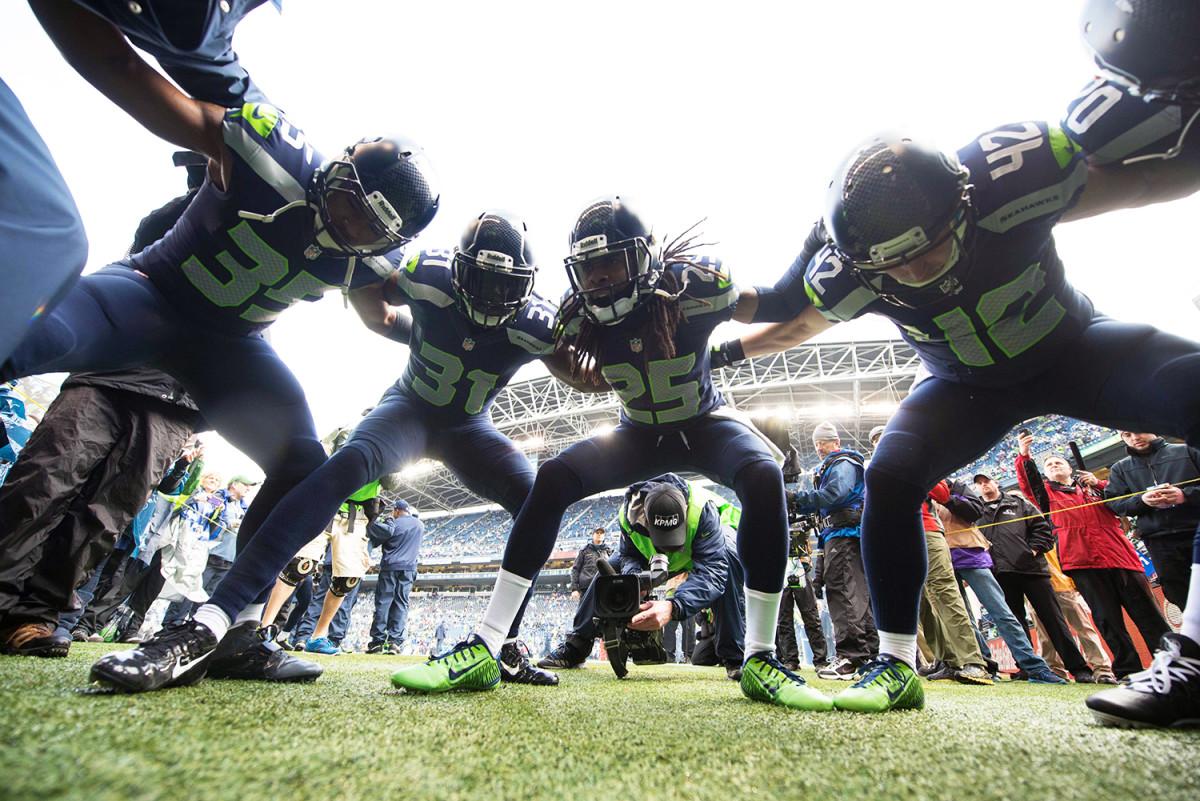
Richard Sherman
Outspoken cornerback who has given voice to concerns of players in the 2010s
Most of Football America first met Richard Sherman on October 30, 2011. The little-known fifth-round rookie made his first NFL start, going up against that year’s fourth overall pick, Bengals receiver A.J. Green. Sherman shined for much of the game, and more notably, he carried himself as brashly as any corner in the NFL, getting in Green’s grill from the get-go and never letting up. Sherman had perceived a slight from Green early in the game; afterward he called Green “overrated.” (It should be noted, Sherman speaks highly of Green today.)
Observers would quickly get to know Seattle’s new mechanically savvy, physically strong lockdown left corner. Sherman became the defining figure of the Seahawks’ Legion of Boom secondary, and his perimeter coverage helped propel Seattle’s beautifully simple Cover 3 scheme, which several NFL teams would come to adopt.
But it was Richard Sherman the Person more than Richard Sherman the Player who really rocked the NFL. He blew up all sorts of stereotypes. He was a demonstrative, outspoken, dreadlocked black athlete from Compton who had a Stanford education and substantive, original thoughts on almost all matters relating to on- and off-field issues. He was the rare polarizing figure who was taken seriously by many of his haters. He could come across as overly confrontational in some of his public spats, saying to ESPN’s Skip Bayless “I’m better at life than you” and calling San Francisco’s Michael Crabtree “a sorry receiver” in a famous live interview after the 2013 NFC title game. But those episodes also illustrate the conundrum of Richard Sherman: Many of his critics who disliked the manner of his outspokenness couldn’t help but admire him for standing up and speaking his mind. In high-profile columns for The MMQB, for which he was a regular contributor, he was frank and direct in taking on targets ranging from Roger Goodell’s discipline to the rules regarding defensive play. Not to say there weren’t times when Sherman took things too far—the Seahawks felt Sherman crossed the line for once threatening to ruin a reporter’s career; spats with teammates were mostly brotherly but could be emotionally exhausting.
Sherman signed a life-changing mega-contract in 2014; entering the 2019 season, he is slightly diminished in skills but still a quality veteran for the 49ers, with a respected platform with the NFL Players Association. Sherman’s playing career may soon wind down (we’ll see), but he’ll likely be in the spotlight for years to come.
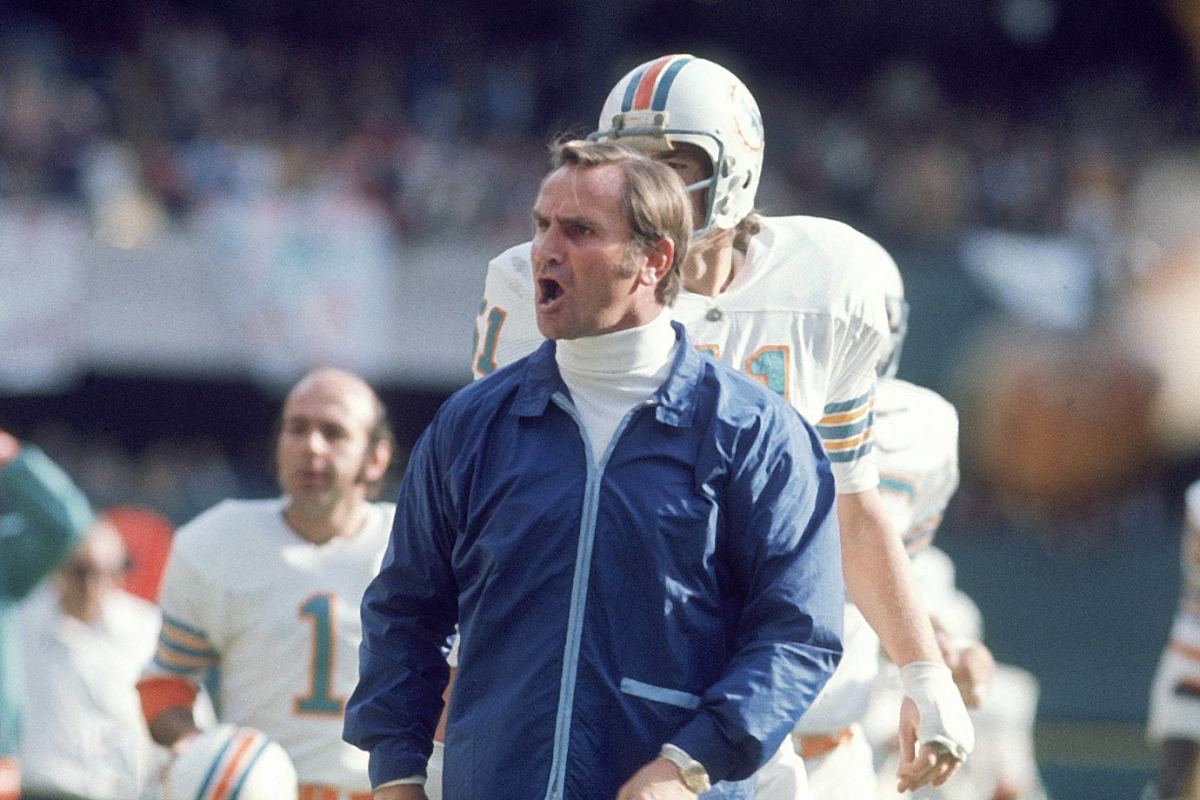
Don Shula
NFL’s all-time winningest coach
Don Shula’s legacy has grown only stronger with time, his 347 career wins as a head coach and the Miami Dolphins’ 1972 undefeated season both still unmatched as he nears his 90th birthday. The difficulty of both of those feats matches Shula’s approach to his 33 years as a head coach in the NFL, which included 19 playoff appearances, six Super Bowls and two NFL championships: He demanded that his players practice four times a day, and he required that QB Dan Marino call his own plays at practice as a rookie.
Shula was a player first, a cornerback for Cleveland, Baltimore and Washington in the 1950s, before his first head coaching gig with the Colts in 1963. A half-century later he would still consider his team’s loss to Joe Namath’s Jets in Super Bowl III a “disaster” and the greatest regret of his career. But just four years after that loss came what many see as the greatest triumph in NFL history: the only perfect season. When the ’85 Bears came challenging, it was Shula’s Dolphins who handed them their only loss that season, preserving the standalone legend of his ’72 team.
Shula told his wife, Mary Anne, to throw away his meticulous library of game plans when he retired in 1995—he needed a clean break from the game. She didn’t listen, filing every season away in his home office, with the exception of the 17 reports from the perfect 1972 season, which are locked in a safe. Both these pages and Shula himself show the signs of age; a 2011 blood clot scare diminished him physically, and he now gets around with the use of a motorized scooter. But what remains unchanged are the benchmarks Shula set. “Nobody has done it since, and nobody did it before,” Shula said of the perfect ’72 season in an interview with The MMQB in 2013. “It just stands by itself.”
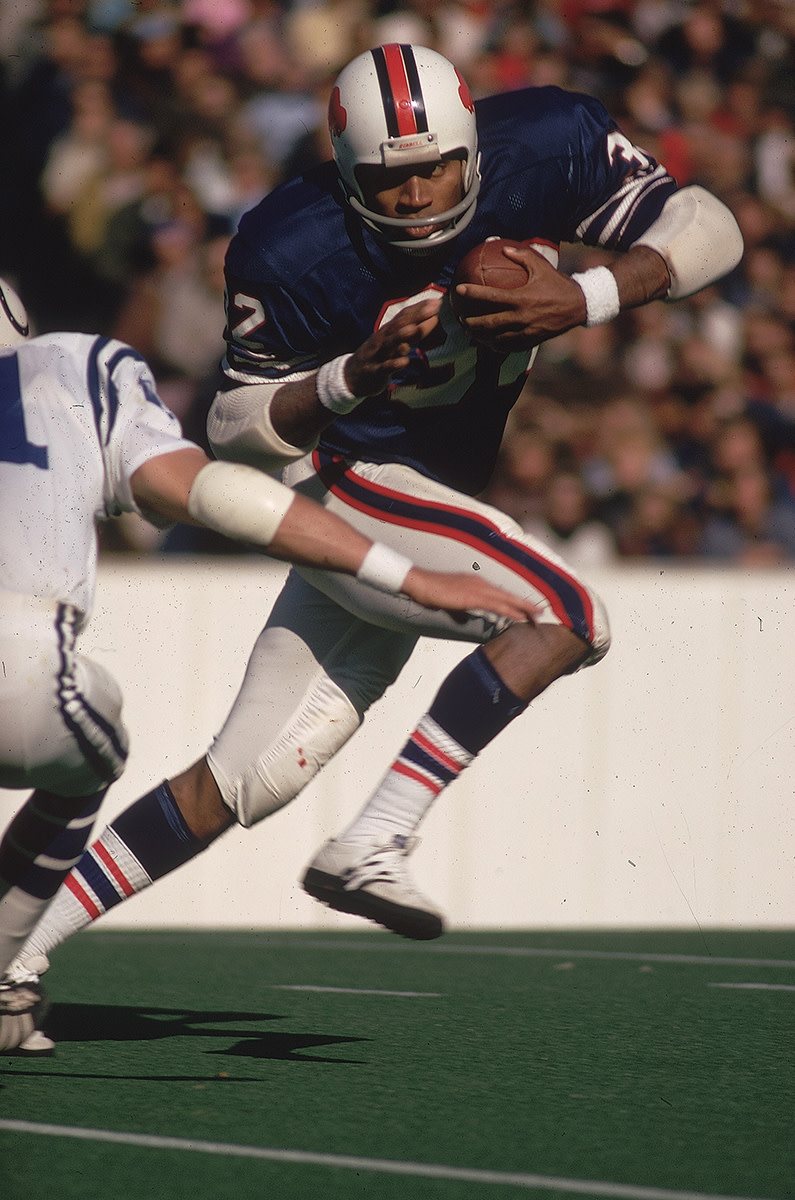
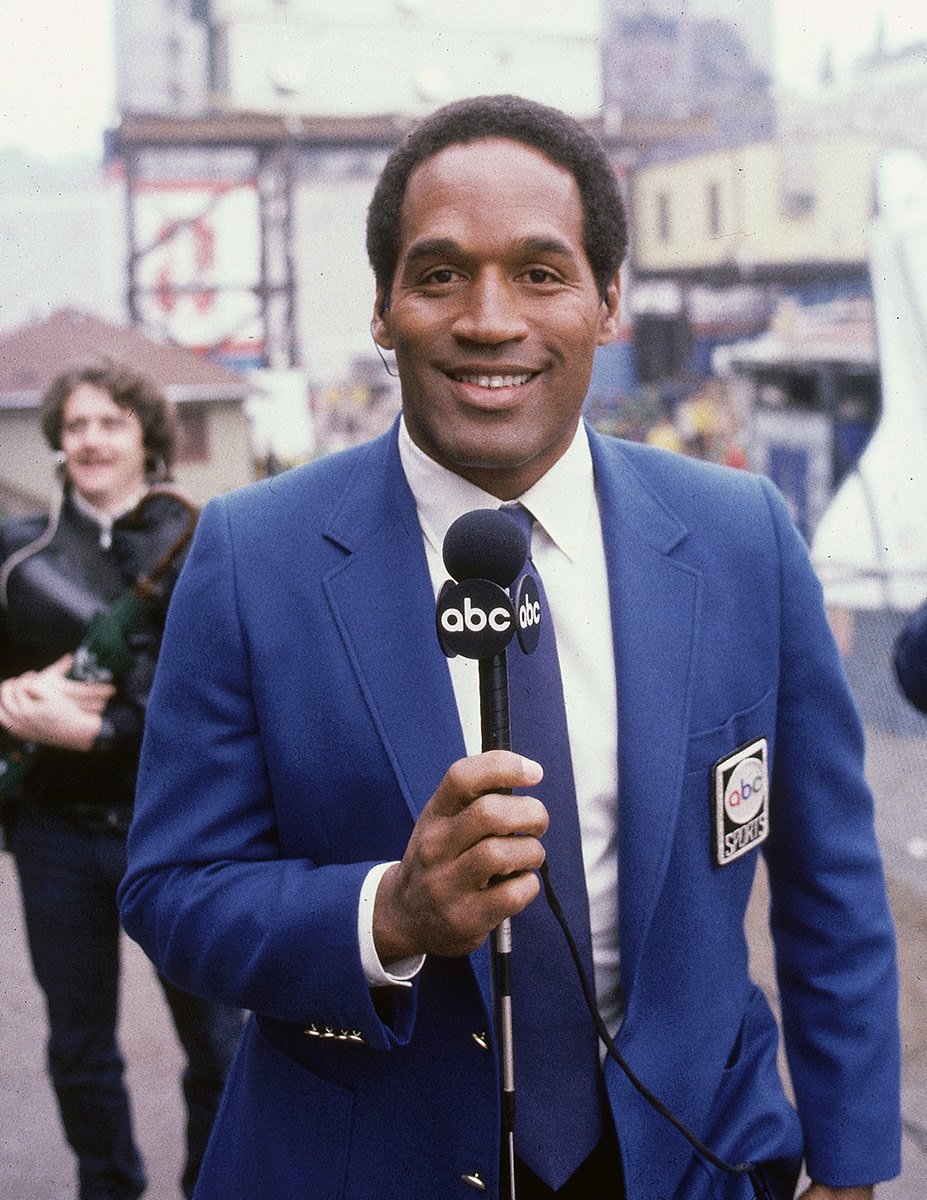
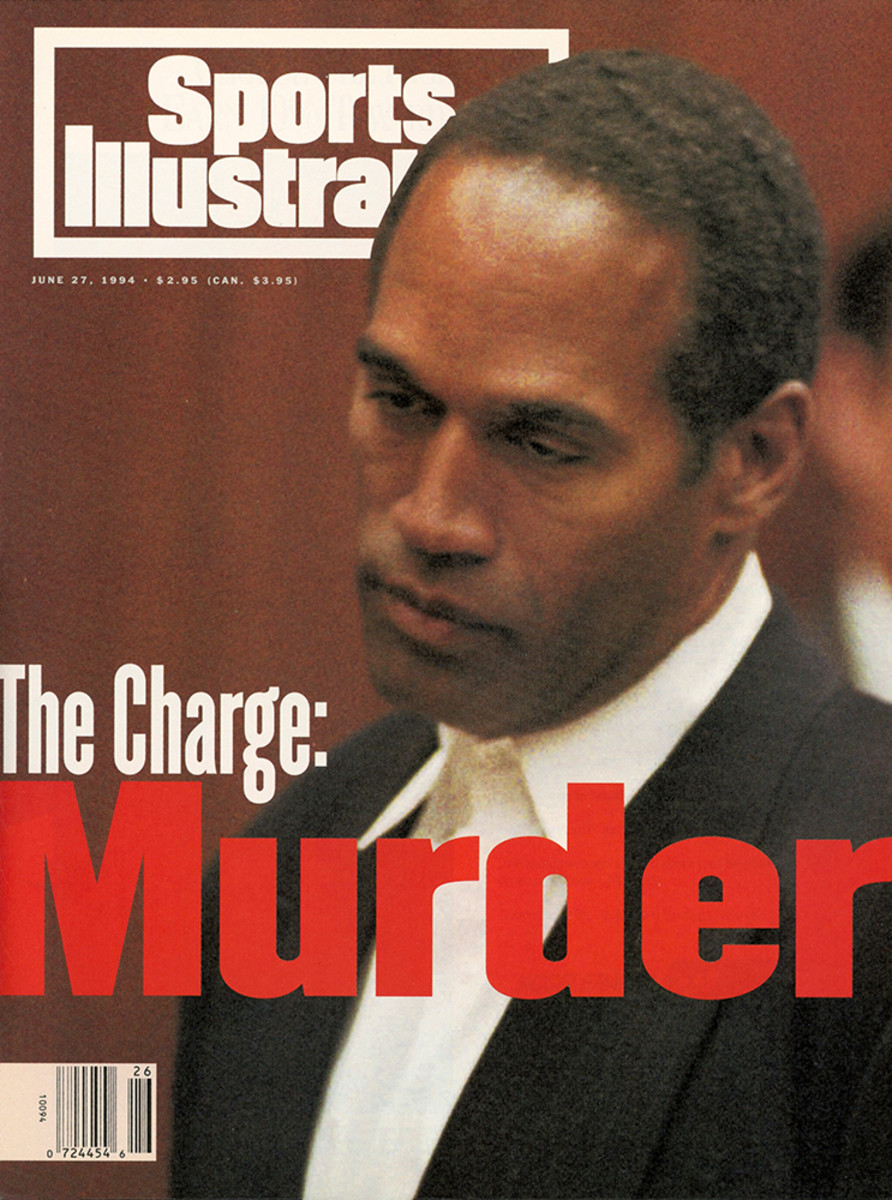
O.J. Simpson
Record-setting running back with the strangest life story of any prominent American athlete
What can be said about O.J. Simpson that he didn’t already say in the 2007 book If I Did It, in which he hypothesized in detail about how he might have killed Nicole Brown Simpson and Ronald Goldman, the victims of a murder for which Simpson was acquitted in 1995, arguably the most infamous and polarizing court case in American sports history.
Simpson burst into the public spotlight as a tailback at USC, “the finest combination of speed and power within the memory of any pro scout,” as SI’s Dan Jenkins wrote in 1967. He led the Trojans to a national title in ’67 and won the Heisman in ’68 (and was also a member the Trojans’ 4x110-yard relay team that briefly held the world record). The biggest star college football had seen arguably since the days of Red Grange, Simpson “ran through the folklore of college football the way Henry V ran through Agincourt,” Jenkins wrote in SI. He was selected first overall by the Bills in ’69, and though briefly contemplated sitting out a year in order to play in California, went on to become the best running back of the 1970s. “The Juice” led the league in rushing five times, and in 1973 he became the first (and only) running back to surpass 2,000 yards in a 14-game season. His 143.1 yards per game remains the single-season record.
Hard as it is to think of now, Simpson was also the biggest crossover star of the time, making numerous TV and film appearances, working on ABC’s Olympic coverage, and sprinting through airports in his ubiquitous commercials for Hertz, one of a host of sponsorships that boosted his profile and his bank account. Upon retirement, he had stints in the MNF booth and, famously, the Naked Gun film series.
The aftermath of the June 1994 murders, including the slow-speed chase through Los Angeles and Simpson’s arrest, televised live across the nation, were a spectacle unlike anything seen before in America. His months-long court case, also broadcast live, with nightly recaps akin to postgame analysis, helped engrain 24-hour cable news in the culture. In October 1995, tens of millions tuned in to watch the verdict, in which Simpson was acquitted. He was later found culpable for the deaths in a civil suit brought by the Goldman family.
Once one of America’s most recognizable and well-liked celebrities, Simpson became a pariah. He was chronically embroiled in financial and legal troubles, culminating in his conviction in 2008 on kidnapping and armed robbery charges, for which he spent nine years in prison in Nevada. In 2019 he joined Twitter with a video-recorded taunt that he “has some getting even to do.”
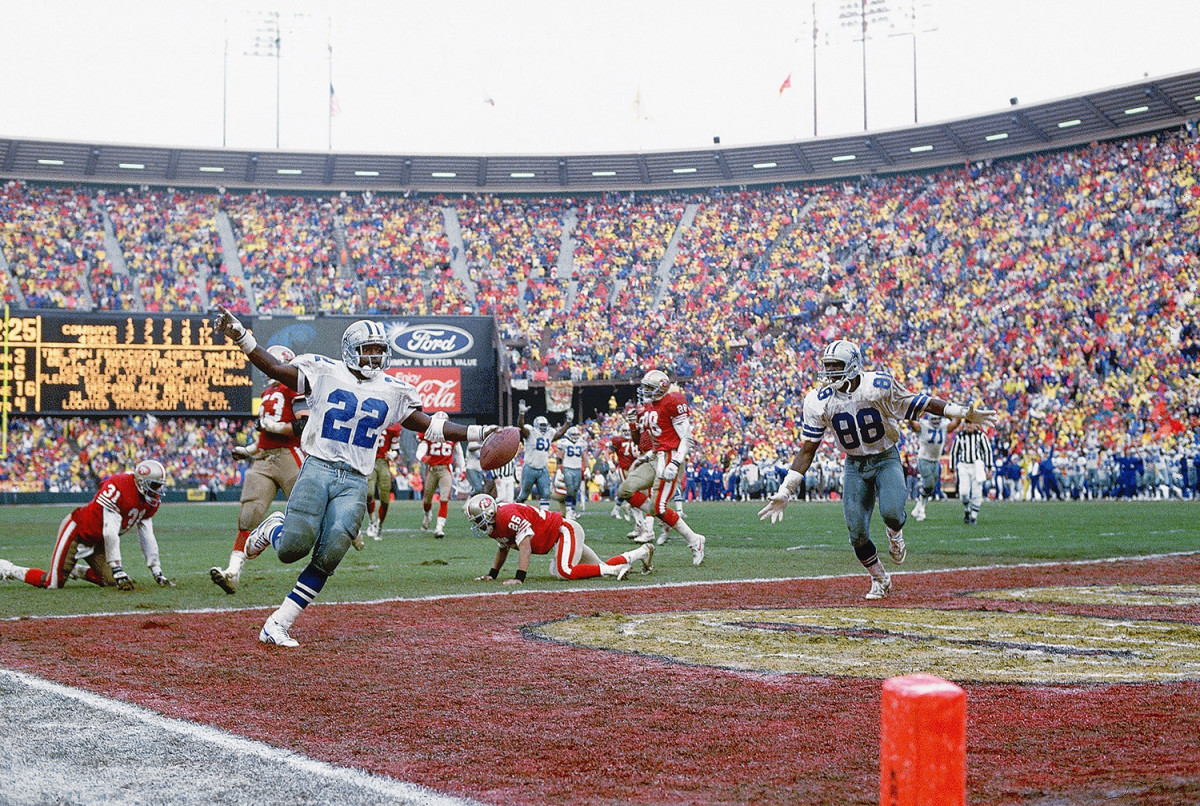
Emmitt Smith
All-time leading rusher and most accomplished of the Cowboys’ Super Bowl-champion trio
For the better part of his Hall of Fame career, Emmitt Smith was the preeminent player at what, alongside quarterback, had long been football’s preeminent position. He embodied longevity at a position known for denying it; counting two unceremonious years in Arizona, Smith played 15 seasons, rushing for more than 1,000 yards in 11 of his first 12, leading the league in rushing four times and helping guide the Cowboys to three Super Bowl titles. Making Smith’s longevity more impressive is the workload he carried for many of those years. His 18,355 yards rushing are the most in history, but so are his 4,409 rushing attempts—by a lot. Second on the all-time rushing attempts list is Walter Payton, with 3,838. Fully 1,495 of Smith’s attempts, and 5,789 of his yards, came after age 30, when most runners hit the proverbial wall.
Which brings us to the crux of the Emmitt Smith discussion: How much should we value a running back for a high-volume workload? The discussion presents something of a moving target; the position in today’s offensively diverse, pass-happy NFL is more specialized, leading to running back committees. Most of the backs who do get a lot of touches are in their early 20s, their teams fully aware they might be expending the player’s shelf life in his first few seasons.
But a discussion about Smith’s workload pertains not just to the big picture of his career, but also the little pictures. Through the ’90s, one of football’s richest debates was, Who is the best running back: Emmitt Smith or Barry Sanders? Sanders was clearly the more gifted runner. His unmatched lateral agility and stop/start control created some of football’s most magical plays. What often separates running backs is their ability to create their own yards. Here Sanders was better than anyone. Smith, on the other hand, was believed to be the beneficiary of a lot of touches and an uncommonly good offensive line. If Sanders was a home run slugger, Smith was the ultimate on-base hitter, wearing down defenses with steady doses of three- to eight-yard runs. There’s little doubt that Sanders would have been more productive behind Dallas’s line than he was behind Detroit’s. But it’s also possible that Dallas’s uber-sustainable ground game would have been less effective with Sanders. He did not always get back to the line of scrimmage; his 1,114 lost yards as a runner are by far the most in history. Smith, on the other hand, consistently kept the Cowboys ahead of the chains. In the ’90s, he was everything you could want in a back.
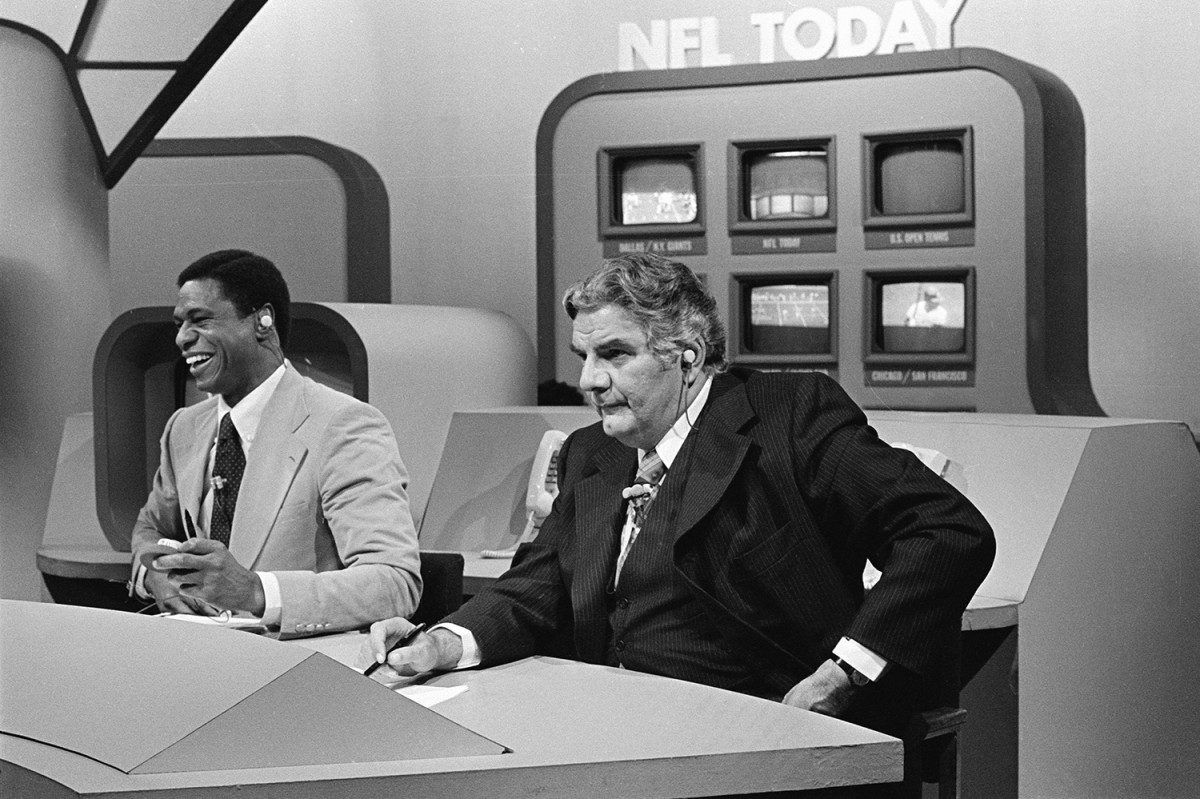
Jimmy “The Greek” Snyder
Vegas bookie who brought gambling info to the NFL pregame show; fired for offensive, racially ignorant comments
Jimmy “The Greek” Snyder, a fast-talking bookmaker turned football prognosticator who rose to minor fame as a CBS analyst at a time when the discussion and practice of gambling was akin to talking about sex or drugs, might have been a man before his time, had some idiotic and racist comments not derailed his career.
In the current era, when legalized gambling is sweeping the nation and leaving networks to scramble for talent capable of addressing both the on-field play and the implications on various betting lines and odds, the Greek would have been the ideal solution. Snyder was gruff, with the appearance that he smelled of Parliament 100s and was perpetually sitting in the corner of a dimly lit bar with a ledger of bets in front of him. His style earned both the charmed attention of America during his CBS pregame prediction segments—he would not mention a game’s betting line but would provide a final score, leaving it up to gamblers to figure it out—and the respect of the bookmaking community from which he came. However, during a televised interview on the birthday of Martin Luther King in 1988, Snyder made ignorant and insensitive comments about African-Americans, and CBS promptly fired him.
For years Jimmy the Greek would embody the analog of the football gambler, a stereotype that has since been demolished by the emergence of modern-day sports betting experts and analysts. Snyder, who died in 1996, was never able to see the rise of Fan Duel and Draft Kings, companies that would finally crash through the NFL’S anti-gambling façade and deliver common, stigma-free betting to the masses at a time when the practice was being legalized across the country.
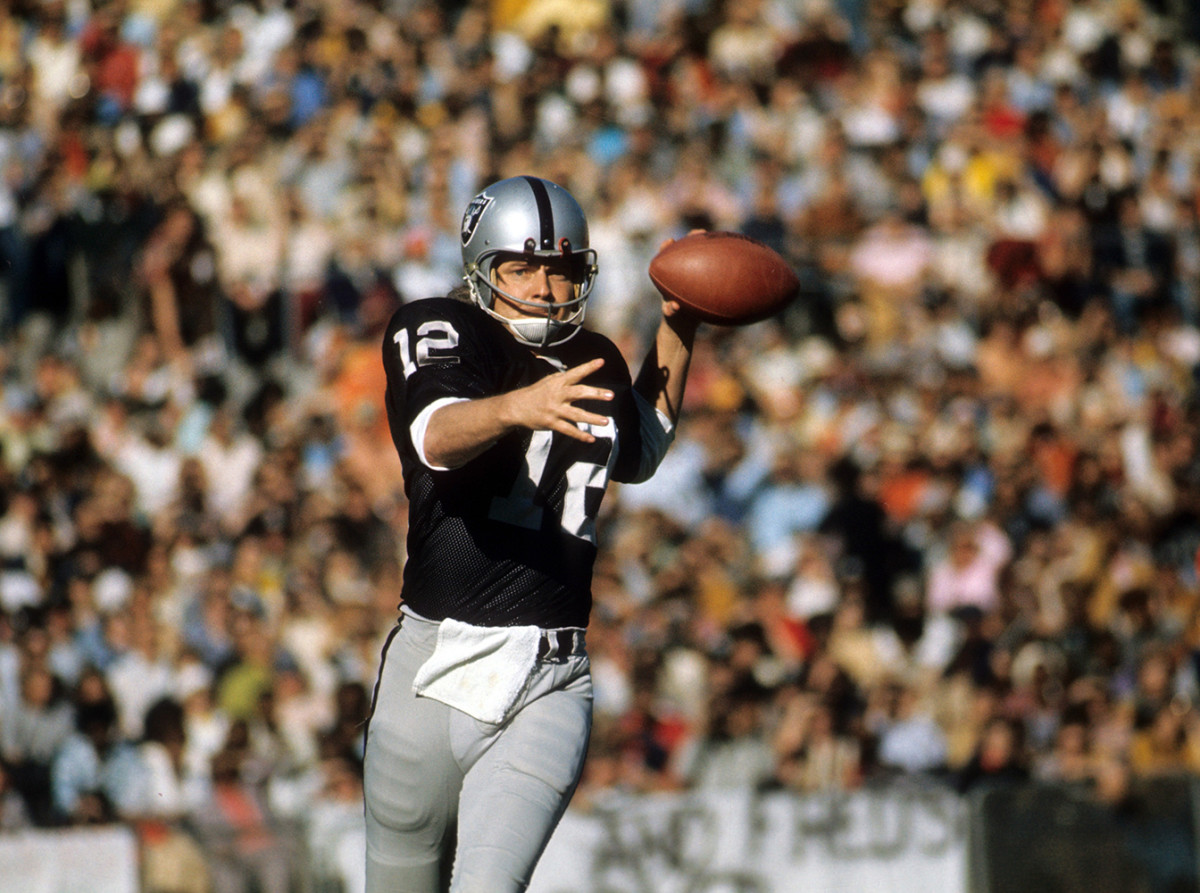
Ken Stabler
Hard-living southpaw QB who personified the renegade Raiders
The Snake, as he was known for his slithery elusiveness as a runner, was clutch. That nobody denies. Ken Stabler, the quarterback who led the Raiders to their first Super Bowl title, in 1977 under coach John Madden, had more than his fair share of memorable plays throughout his 15-year NFL career. Many of them earned their own sobriquets—the Holy Roller, the Sea of Hands and Ghost to the Post all entered pro football lore, magical plays that embodied Stabler’s savvy and skill.
“I’ve often said, if I had one drive to win a game to this day, and I had a quarterback to pick, I would pick Kenny,” Madden said upon Stabler’s death in 2015. “When you think about the Raiders, you think about Ken Stabler.”
The Snake might not have put up the QB best stats—a fact that, controversially, kept him out of the Hall of Fame until 2016, a year after his death—but the lefty gunslinger was always one of the game’s biggest personalities. He was known as a hard-living, fun-loving character—the perfect face for the swashbuckling Raiders of the 1970s, a gang of misfits and castoffs. Stabler was also one of the most electrifying players in the league, never one to play it safe, either with his arm or his legs. His high school coach, Denzil Hollis, gave Stabler his nickname, because as he told Robert F. Jones in a 1977 SI cover story, “He’d run 200 yards to score from 20 yards out.”
Stabler was the league MVP in 1974 and a member of the All-Decade second team, though knee problems cut his prime short. Still, he left an indelible mark on the NFL with his substance on the field and, even more so, his style off it. As he told Jones in that ’77 story, “What counts isn’t so much where you’re going—I mean, we all end up in the same place—but what counts is the getting there.”

Leigh Steinberg
First NFL super-agent
If you think there’s a glut of sports agents today, you have Leigh Steinberg to thank for inspiring a generation of them. Steinberg became the first super-agent in pro football, beginning his career in 1975 and dominating the field in the ’80s and into the ’90s. He was so well known and so successful that he’s credited with being the inspiration for the Tom Cruise movie Jerry Maguire.
With more than 40 years under his belt, Steinberg has represented eight No. 1 overall picks, beginning with Steve Bartkowski in 1975. He had Bruce Smith, Derrick Thomas, Eric Dickerson, Howie Long, Kenny Easley, Kevin Greene, Steve Young, Troy Aikman, Thurman Thomas, Drew Bledsoe, Edgerrin James, Jevon Kearse, John Lynch, Junior Seau, Tony Gonzalez and dozens of others.
As he rose, Steinberg played the media game perfectly with reporters and developed close connections with NFL owners and executives. Then it all came crashing down. Steinberg filed for bankruptcy in 2012 after several years of alcohol abuse, plus a divorce and a legal battle with a former business partner.
After treatment, Steinberg restarted his career, inking first-round quarterback Paxton Lynch in 2016. That year he reflected on his struggles to SI, saying, “There were times where I felt like Sisyphus pushing that rock uphill, and it just kept rolling back down.” His group, Steinberg Sports & Entertainment, now represents 2018 NFL MVP Patrick Mahomes.
Steinberg has negotiated more than $3 billion in player contracts over his career and is known among NFL media circles for his lavish Super Bowl party that once was far more wild than the Saturday afternoon gathering it is today.
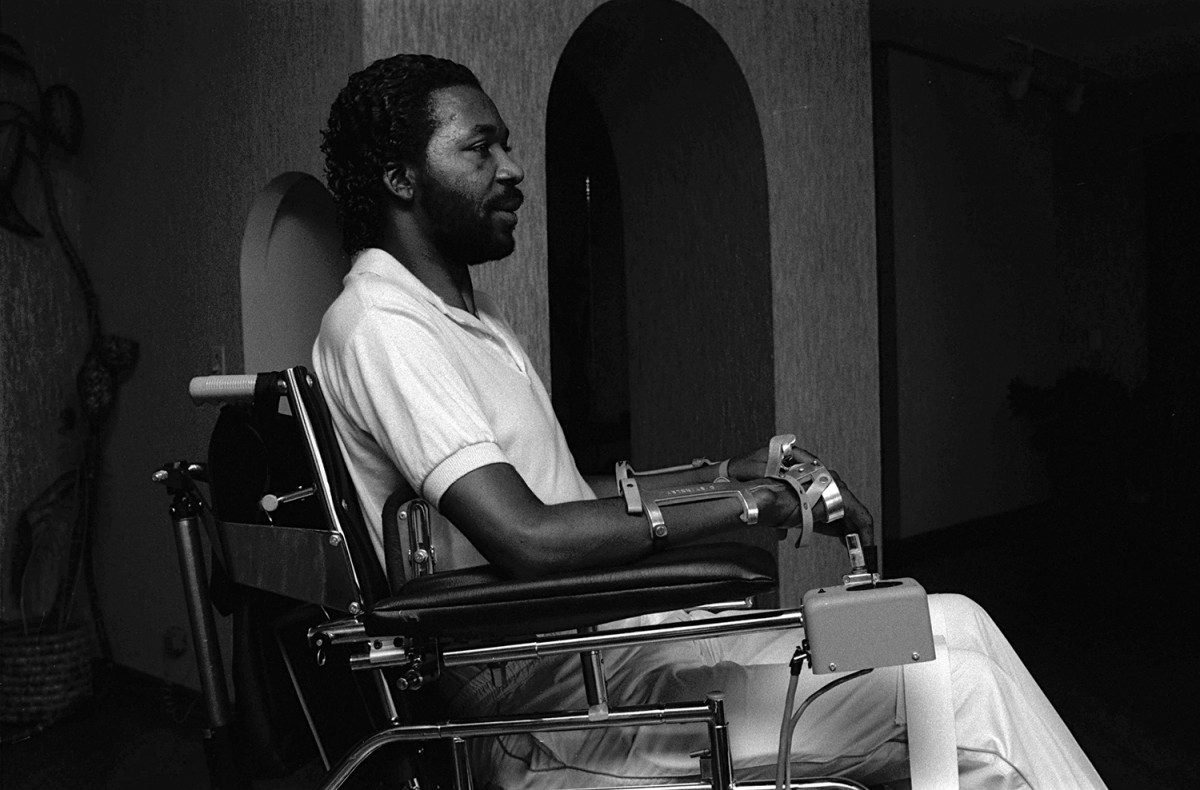
Darryl Stingley
Patriots receiver paralyzed for life after a Jack Tatum hit
In an age when brutality was part of the NFL’s visceral appeal, there were horrifying cautionary tales. One of them was Darryl Stingley, a talented first-round pick whose career was cut short by an on-field hit.
On the verge of a major contract extension after five seasons with the Patriots, Stingley went on a crossing route in a preseason game at Oakland and was hit by Raiders safety Jack Tatum. The blow broke two of Stingley’s vertebrae and compressed his spinal cord, leaving him a quadriplegic. He was 26 at the time, and remained in a wheelchair until his death in 2007.
The incident created a spider web of guilt and regret, from Stingley to Tatum to Patriots quarterback Steve Grogan, who told the Associated Press upon news of Stingley’s death that he “thought about that throw over and over.” Could I have changed anything or done anything differently?” Tatum never apologized (and the Stingley family took offense to his autobiography, They Call Me Assassin), but Tatum’s coach in Oakland, John Madden, told the L.A. Times the hit “ate on him his whole life.”
As the collision came in the preseason, it raised the question of this particular brand of ruthlessness in exhibition games. In the decades since, preseason football has become an exercise in simply not getting injured, rather than a physical tune up for the regular season. So too have NFL rules evolved to protect receivers in situations where they are seen as defenseless.
On the field, Stingley would be remembered as a receiver who, before the injury, could successfully navigate the defense-favorable rules of the time. His son, Derek, ended up playing arena football for years, ending his decade-long career with the Dallas Desperados in 2003. He went into coaching shortly after.
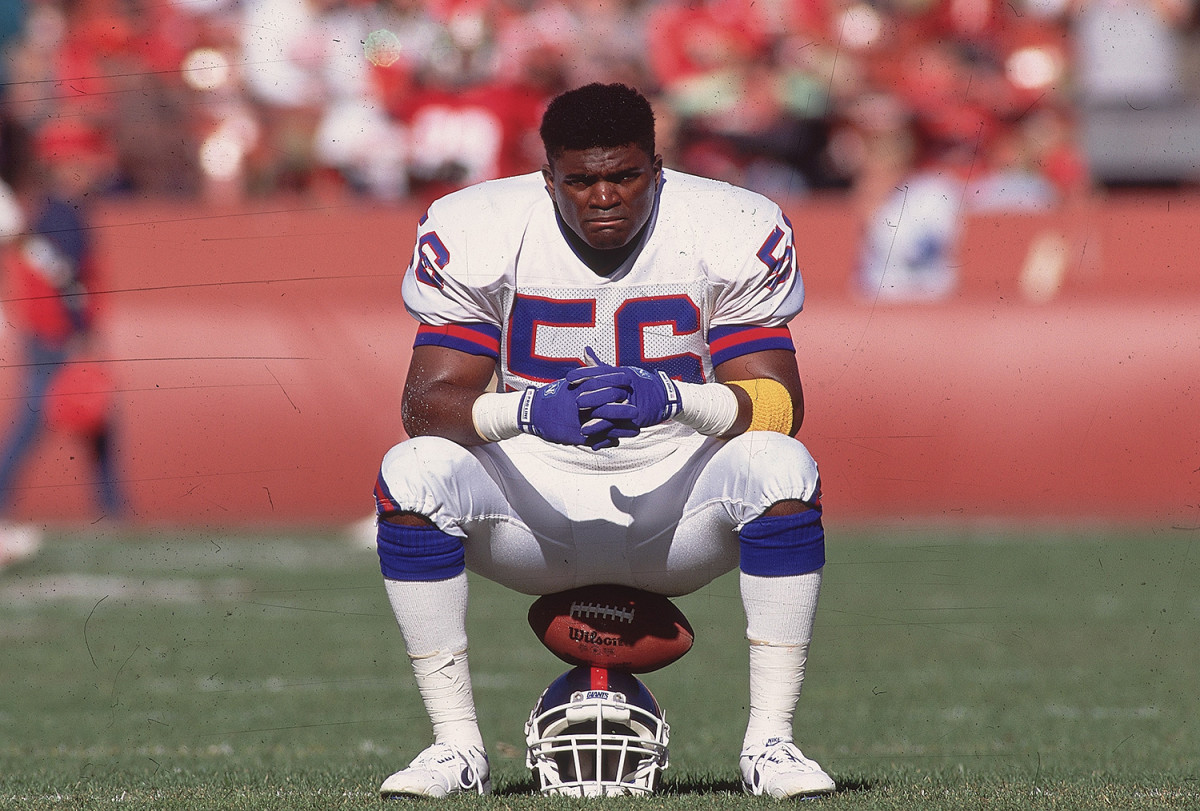
Lawrence Taylor
All-time great whose career was marred by cocaine and alcohol abuse
He was the most feared defensive player in the NFL in the 1980s—and possibly of all time. Don Shula once mused in a 1987 SI article that Lawrence Taylor could wind up being the greatest ever. Bill Belichick, Taylor’s former defensive coordinator and a football historian, regularly states Taylor is indeed the best ever.
The No. 2 overall pick of the Giants out of North Carolina in 1981, Taylor began his career as if shot out of a cannon—Pro Bowl selection, First Team All-Pro, NFL Defensive Rookie of the Year and NFL Defensive Player of the Year. From 1981 to through 1989, Taylor was on the All-Pro First Team all but one year. He earned two more Defensive Player of the Year nods, had seven straight seasons of double-digit sacks and essentially created the rush-linebacker position. No season stood out more than 1986. That year Taylor racked up 20.5 sacks on his way to becoming the first—and only—defensive unanimous MVP. The Giants went 14-2 that year and rolled the Broncos in Super Bowl XXI, earning their first NFL title in 30 years.
Taylor’s play fell off at the turn of the decade, and he didn’t appear on the All-Pro or Pro Bowl team again after 1990. In a 1991 SI interview with Paul Zimmerman, he acknowledged that his best days were behind him. “One bad thing about playing on such a high level for so long is that you have no place to go but down. I’ve heard the rumors that I’m getting too old, that I can’t play the way I used to, that I don’t have the same burst that I used to. What player has the same burst at 32 that he had at 22?”
Taylor’s playing career and post-playing life were marred by alcohol and substance abuse. He was suspended by the league for a drug violation, and after his career he bragged about how many tests he beat. He also admitted to heavy cocaine and crack use during and after his playing days. In 2011 he pled guilty to two sex-related misdemeanors after soliciting a prostitute who turned out to be 16.
His reputation as a player remains undiminished through it all. In The MMQB’s All-Time Draft in 2017, in which NFL experts built teams by choosing from the pool of every player in history, Taylor was chosen first overall.
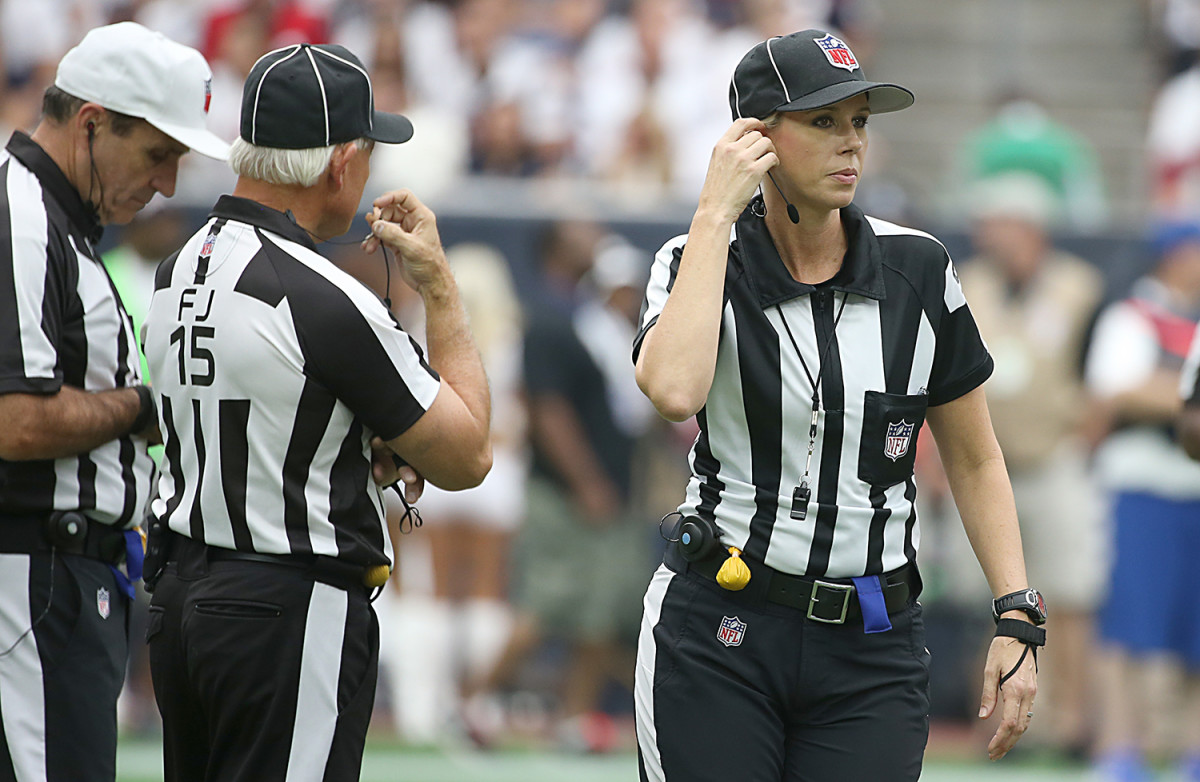
Sarah Thomas
First female game official
Sarah Thomas is a pioneer even if she doesn’t want to be viewed as one. Four years ago, in 2015, Thomas became the first female, full-time official in NFL history.
“I set out to do this and get involved in officiating not having any idea that there were not any females officiating football,” Thomas once said. “Being a former basketball player, you saw female officiating all the time, so no, I don’t feel like a pioneer.”
Like so many officials who make their way to the NFL ranks, Thomas had nothing handed to her. A former basketball player at the University of Mobile, she started working high school football games in 1999. She became the first woman to officiate a major college football game in 2007, and she moved up to the Big Ten in 2011. Gerry Austin, a three-time Super Bowl official who eyed Thomas’s talent early in her career, told the New York Times in 2009. “They [the NFL] have got to look at her. She’s too good.”
After not getting selected for a couple years, Thomas joined the NFL in 2015. The move was, of course, groundbreaking: Though Shannon Eastin had officiated a game during the 2012 referee lockout, Thomas was the first permanent official. Two years later she became a down judge, a title that had been changed from head linesman for obvious reasons. And in January 2019 she drew the Chargers-Patriots playoff game, adding yet another first to her career and further paving the way for women in a male-dominated industry.
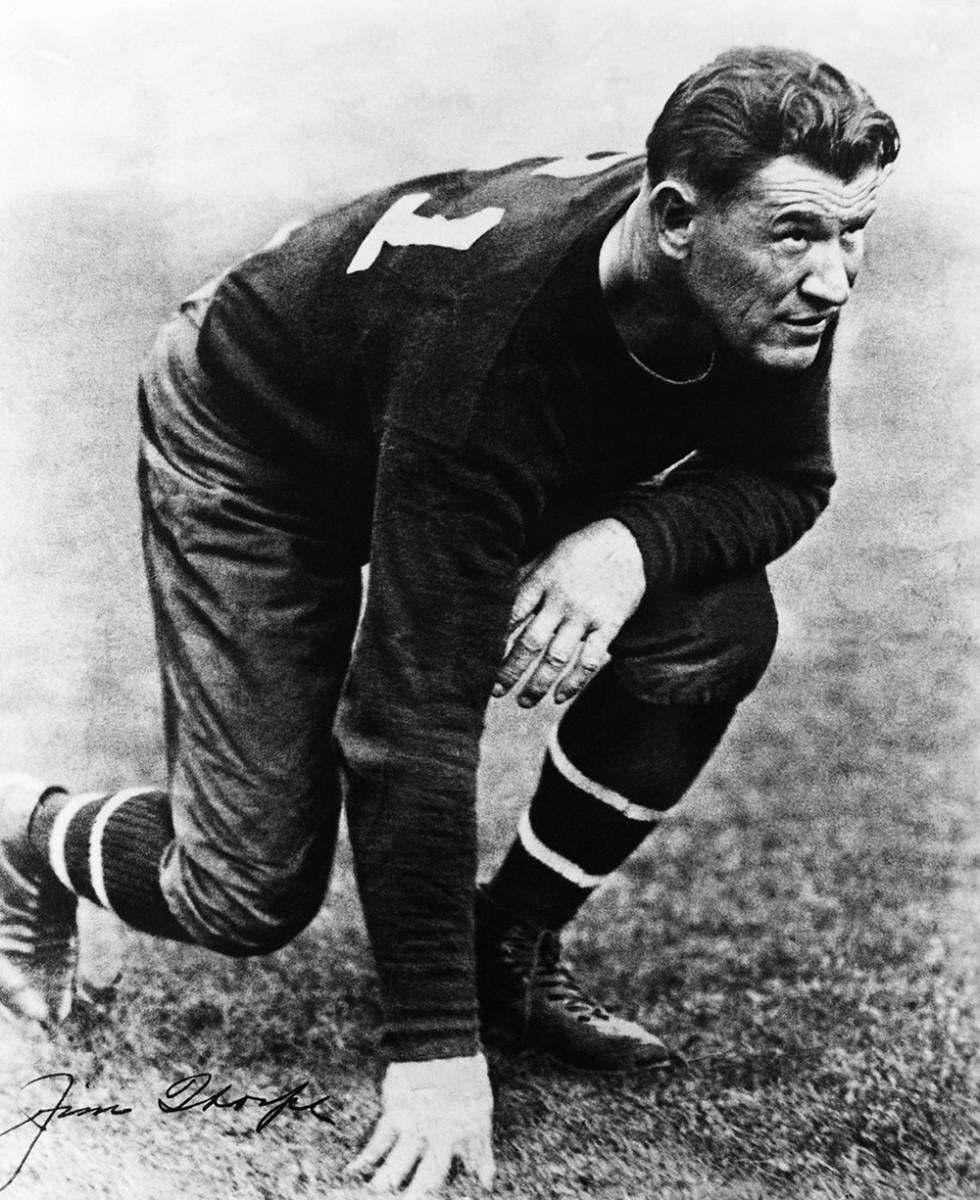
Jim Thorpe
Baseball and football star and Olympic decathlon champ who played for six NFL teams
You don’t need any qualifiers for how great Jim Thorpe was. You don’t have to say greatest Native American athlete in U.S. history. Or greatest athlete of the first half of the 20th century. Indeed, those things are true. But quite simply, Thorpe was the greatest all-around athlete in American history. He was a two-time Olympic gold medalist—in the multi-discipline decathlon and pentathlon—and played professional football, baseball and basketball.
His football exploits are legendary. In college at the Carlisle School, Thorpe was a two-time All-America under coach Pop Warner. There, Thorpe had 12 of the 18 points in Carlisle’s 18-15 1911 victory against Harvard, in what was likely the greatest upset in college football history to that point. Thorpe would go on to play for six NFL teams—including the Oorang Indians, with a roster of Native Americans—before retiring at age 41. He also served as the first president of the American Professional Football Association, which became the NFL.
Harry Stuhldreher, who quarterbacked Notre Dame’s Four Horsemen and played against Thorpe as a pro, told SI’s Alfred Wright in 1962 that Thorpe was the best he’d ever seen. “Thorpe was so fast he could run around the ends and so powerful he could drive through the center of the line dragging half a dozen tacklers with him. He was one of the best kickers there ever was both as a punter and a drop-kicker. On defense he was everywhere, tackling behind the line or knocking down passes in the secondary.”
Thorpe was a member of the inaugural Pro Football Hall of Fame class of 1963—not bad for a guy who was 33 when the NFL formed in 1920.
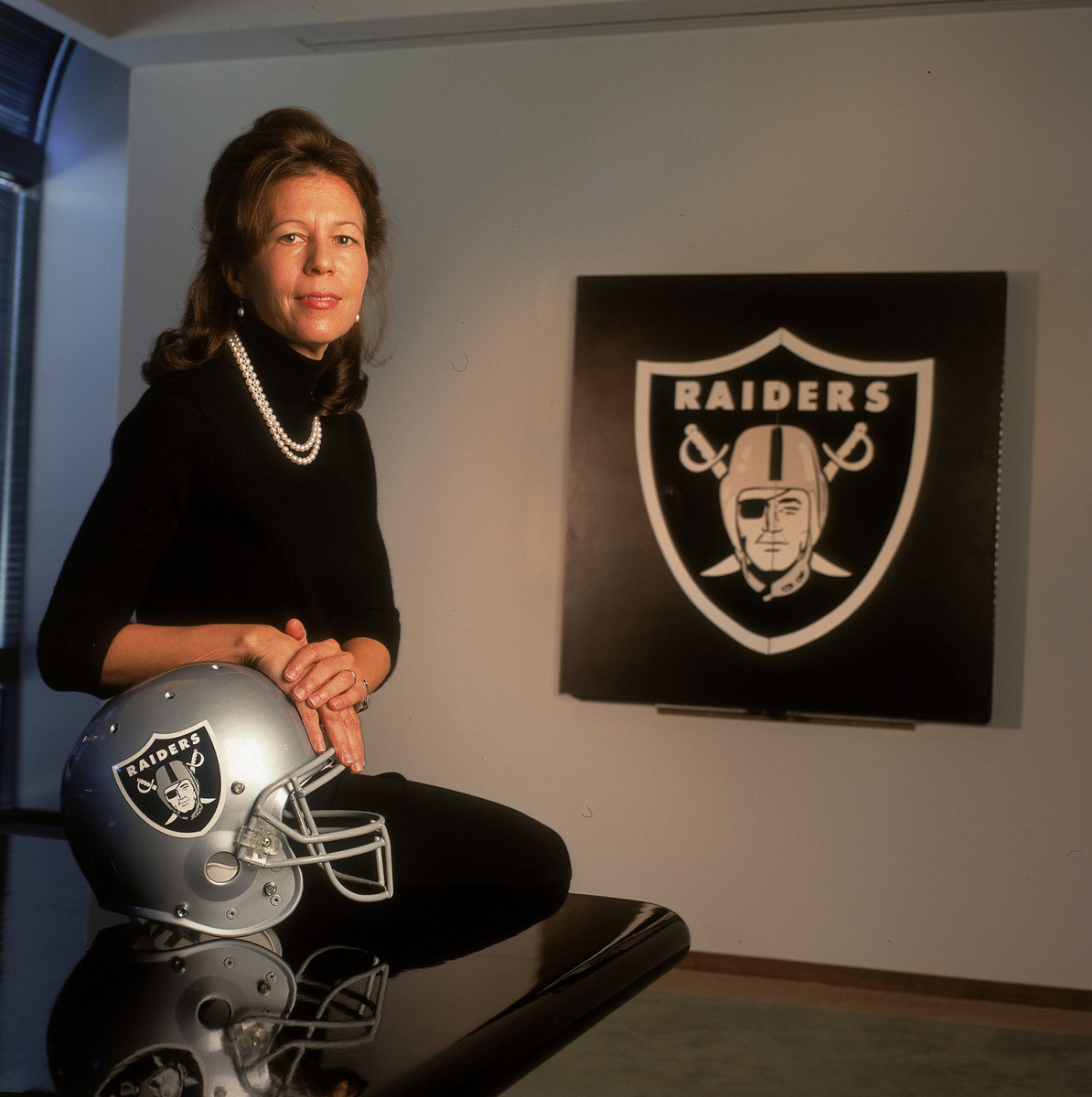
Amy Trask
Highest-ranking woman executive, outside of ownership families, ever in an NFL team’s front office
The first female CEO of an NFL team, Amy Trask held the title with the Raiders from 1997 to 2013, earning the nickname “The Princess of Darkness” from rival execs and an appreciative Raider Nation. Her 2016 book You Negotiate Like a Girl details a life in football bucking norms and learning from mercurial Raiders owner Al Davis, a force for diversifying the NFL during his 48-year association with the team.
Trask began attending Raiders games as a student Cal, then interned with the team’s legal department while at law school at USC, after the Raiders’ move to Los Angeles. In 1987 she joined the legal staff full-time, and by ’92 Davis was sending her to league meetings, where she was often the only woman in the room. She was seen as tough and tenacious—“like a younger, sharper, meaner version of Al—with a law degree,” as an exec from another team said in an SI story in 2002, a characterization she didn’t try to dispel. “I can be very, very tough,” she said in that ’02 profile, “and what’s wrong with being tough? If tough were used to describe a man in my position, I don’t think it would be perceived as a negative.”
As CEO, Trask oversaw the Raiders’ business and legal dealings. The owner’s protégée and right-hand woman, she was a strident defender of her boss and her team, often to the annoyance of others in the league, and through the 2000s many saw her as Davis’s possible successor in the day-to-day running of the Raiders. After Al died in 2011, his son, Mark, who inherited the team, reportedly told Trask she would have a subordinate role under his ownership. She resigned in 2013, and now serves as an analyst for CBS, columnist for The Athletic, and chairman of the Big 3 pro basketball league.
Despite breaking new ground with the Raiders, Trask has always downplayed her role as a pioneer in the industry. “This is my dream job,” she told the San Francisco Chronicle in 2001. “I came to this from a love of football. I didn't think, ‘There should be more women in sports, I should go into that.’ The overriding passion for me is football and winning football games.”
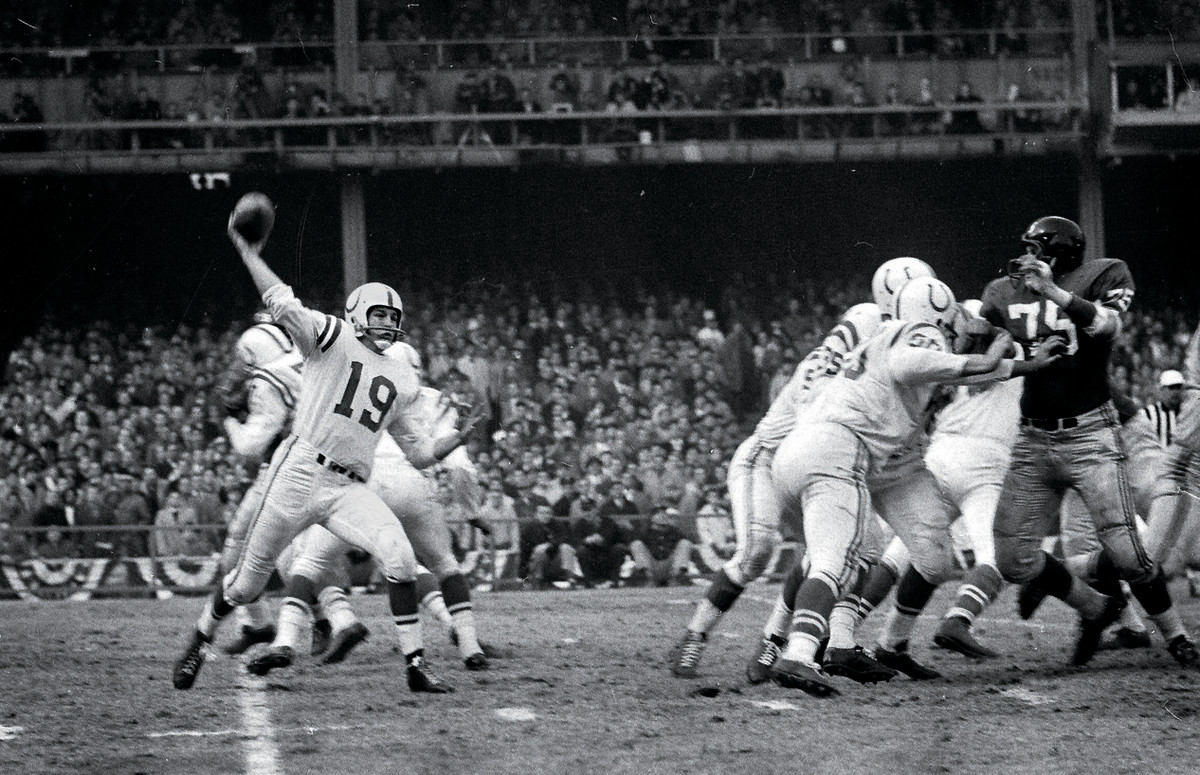
Johnny Unitas
Greatest quarterback of his era
Johnny Unitas, a.k.a. Johnny U or The Golden Arm, was in many respects the forerunner of modern superstar quarterbacking. A no-nonsense 6'1", 194-pound field general who called his own plays, Unitas had total command over a Baltimore Colts team that won NFL championships in 1958 (in what was dubbed “The Greatest Game Ever Played”) and ’59, and he posted prolific numbers, setting records (eventually broken) for most Pro Bowl appearances (10), starting QB wins (118), consecutive games with a touchdown pass (47) and consecutive games with at least two touchdown passes (12). He was First Team All-Pro five times, including one season when he wasn’t voted to the Pro Bowl.
Besides his successes, Unitas is emblematic of the easily forgotten imperfections that surround so many of football’s seemingly perfect stars. His entrance and exit from the NFL were rough. After being drafted in the ninth round by the Steelers in 1955, Unitas got no practice reps that first offseason, as coach Walt Kiesling was believed to have predetermined that the rookie from Louisville was not smart enough to quarterback an NFL team. Unitas was cut, and spent that year working construction.
He joined the Colts as a backup in 1956 and saw his first action on October 6, replacing George Shaw in the waning minutes for mop-up duty. However, Unitas always told the story of his first game as being on October 21 against the Bears. Shaw broke his leg, Unitas came in and famously threw a pick-six on his first attempt.
Unitas’s departure from pro football was equally unglamorous. At almost 40 years old, he was traded to the Chargers in 1973, where he originally threatened to not report. As a Charger, he went 1-3, which by then was not surprising considering that from 1968 on, Unitas, plagued by arm trouble, saw his average passing yards per attempt drop from 8.1 to 6.6 and his interceptions outnumber his touchdowns 64 to 38.
These lows are easily forgotten, though, because of the then-unparalleled highs in the middle of Unitas’s career. He was the first truly prolific passing QB, the first to surpass 40,000 career yards, all before the league updated to passer-friendly rules in 1978. Wrote SI’s Frank Deford upon Unitas’s death in 2002, “Johnny U was an American original, a piece of work like none other, excepting maybe Paul Bunyan and Horatio Alger. … But that was myth, and that was fiction. Johnny U was real, before our eyes.”
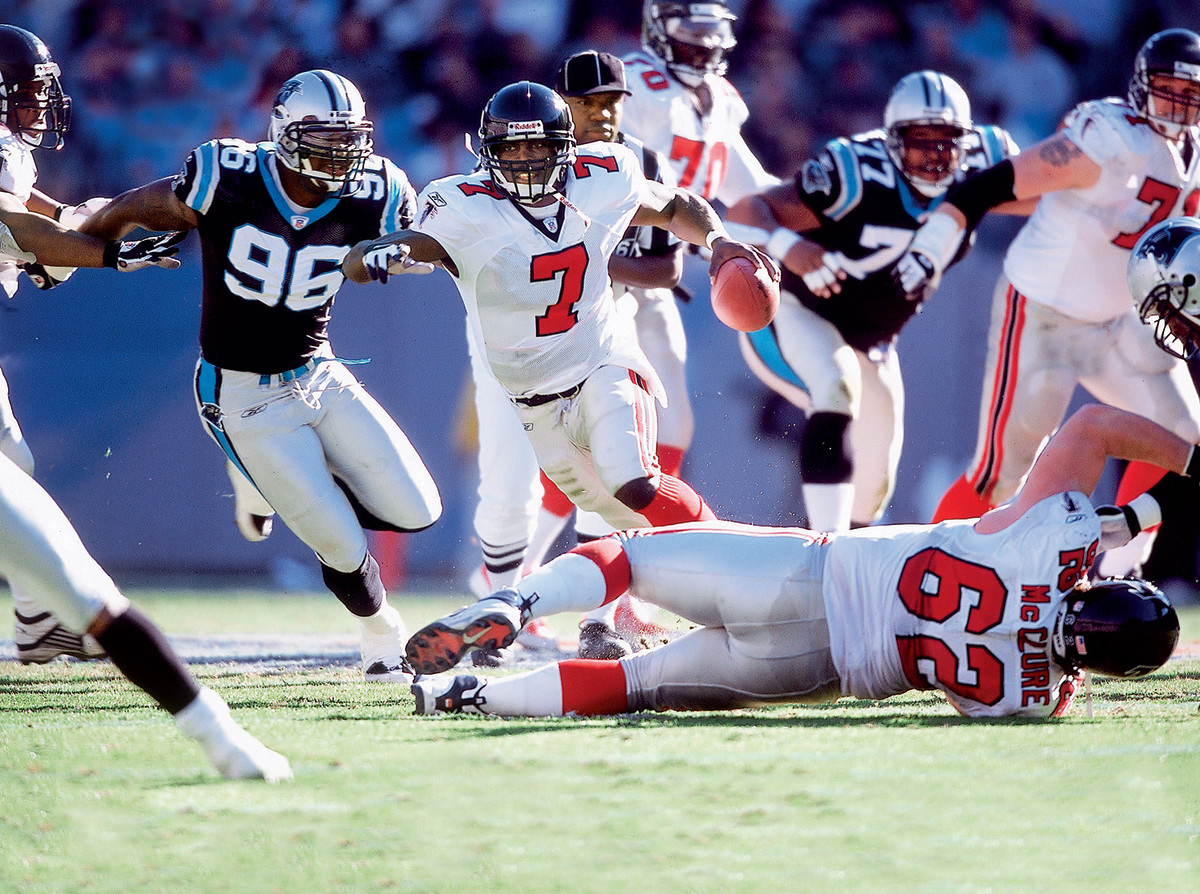
Michael Vick
Electric scrambling QB, suspended and jailed for dog-fighting at the height of his career
When you think of dual-threat quarterbacks, you think of Michael Vick. The former No. 1 overall pick holds the record for career rushing yards by a quarterback, and he’s the only quarterback ever to rush for 1,000 yards in a season. There was no quarterback faster than Vick in his day, and it’s likely he’s the most elusive quarterback in NFL history, even as the position continues to evolve.
“Anytime I watch kids, whether it’s in high school, college or the NFL playing the way I played, I know why they’re doing it,” Vick told SI in 2017. “It’s great. I’m just glad it’s accepted.”
Vick ushered in a generation of rushing quarterbacks even though he had just modest success relative to other QBs on this list. He won 10 or more games just once in his career, never played in a Super Bowl and never made an All-Pro team—but his cultural impact was massive. Vick was unapologetically black in Atlanta, a black mecca. He had his own signature Nike sneaker, something essentially unheard of for an athlete who plays in cleats. He graced video game covers and threw footballs out of stadiums in commercials.
But his life and career came crashing down in 2007 when he pled guilty to charges related to dog-fighting. He spent nearly two years in federal prison and declared bankruptcy, then returned to the field in 2009 with the Eagles and eventually signed a $100 million contract for a second time after being named the NFL Comeback Player of the Year. He paid off his debts and became a spokesperson for animal rights.
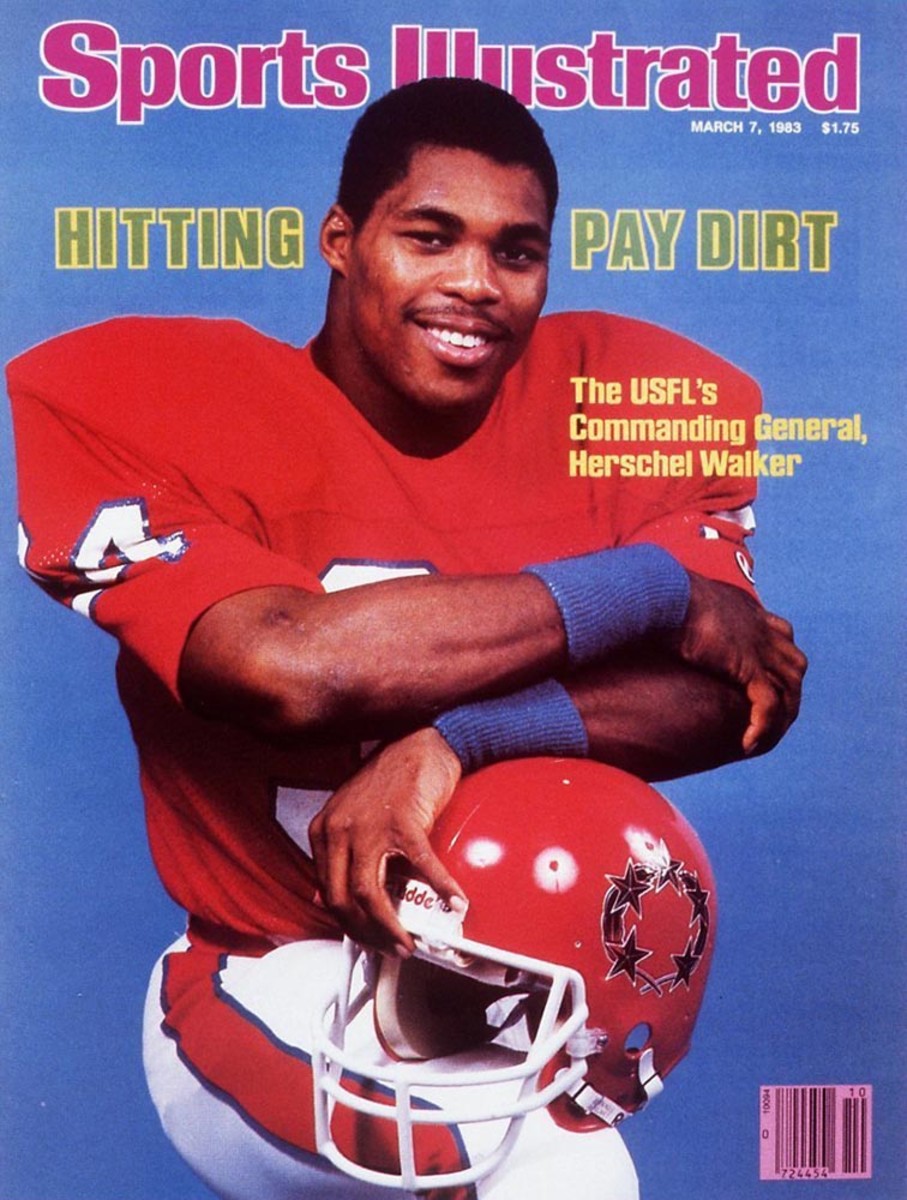
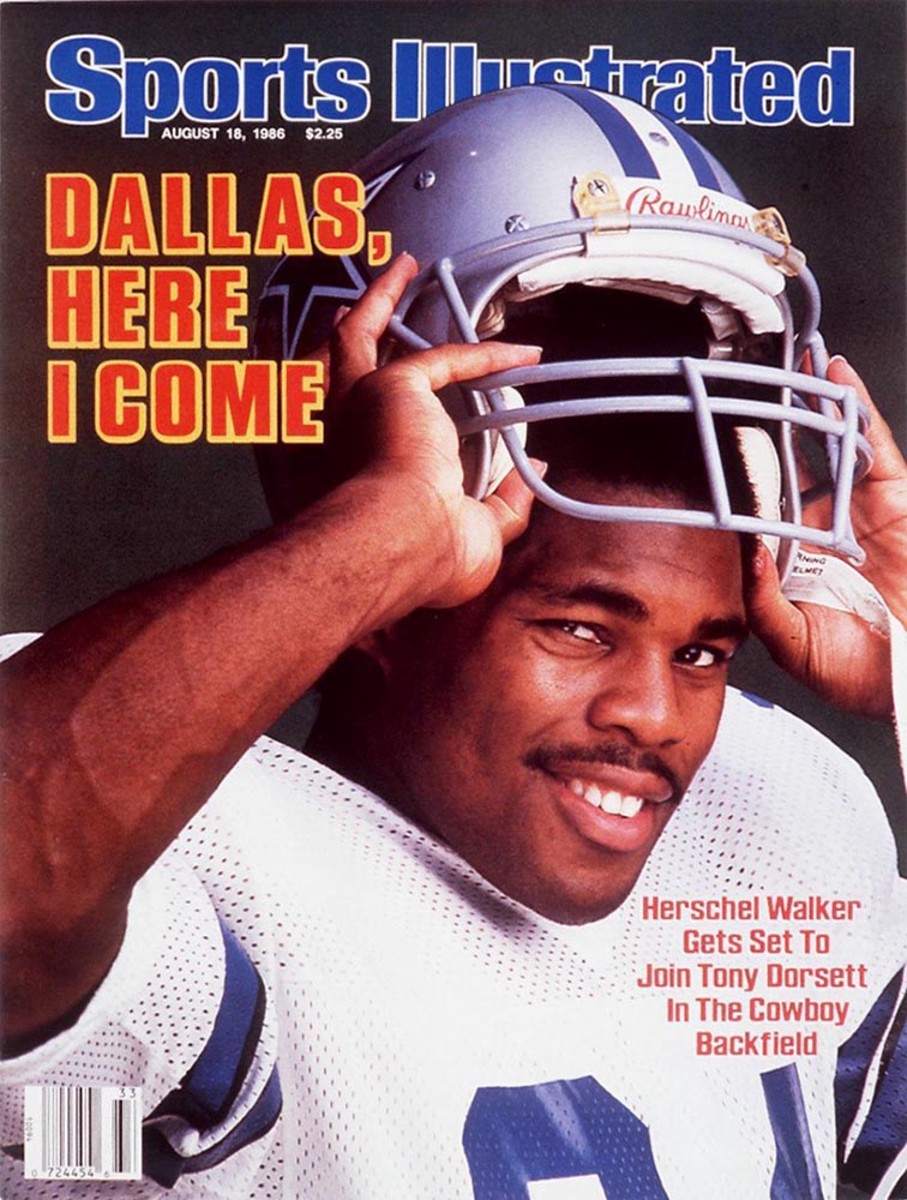
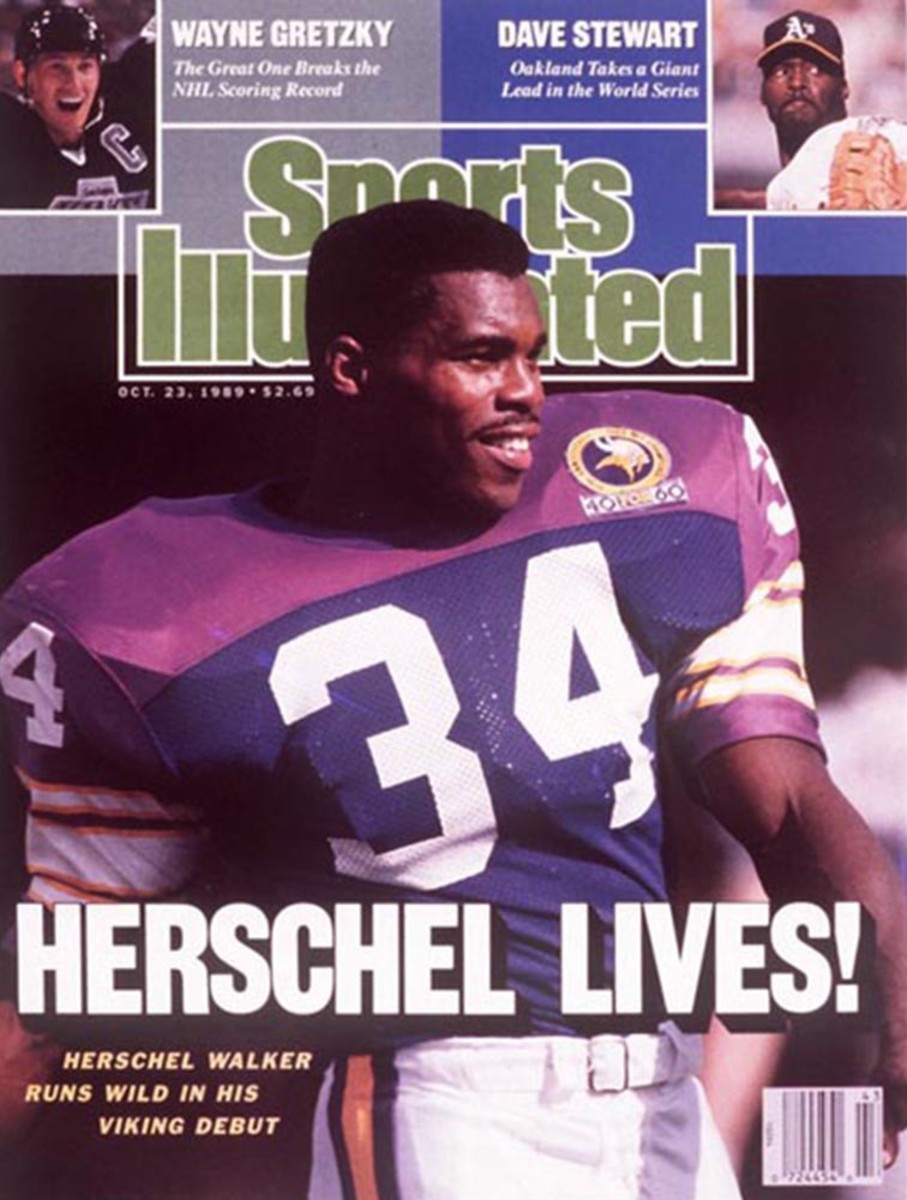
Herschel Walker
Biggest fish to join the rival USFL; centerpiece of the massive trade that contributed to the Cowboys’ ’90s dynasty
Herschel Walker finished his NFL career with a respectable 8,225 rushing yards, 61 rushing touchdowns and two All-Pro selections. Those stats aren’t why he’s on this list, though. The reasons for Walker’s inclusion here are threefold.
First, he was truly one of the first players football fans were able to follow from high school through college and into the pros. His schoolboy exploits in smalltown Georgia were legendary, as he had 45 rushing touchdowns in his senior season on his way to play for the Georgia Bulldogs. There, as a freshman phenom, he helped the Bulldogs to a national championship, and two years later he easily wrapped up the Heisman Trophy. Possibly the most pro-ready back in collegiate history, Walker left Georgia after his junior season. But he didn’t join the NFL.
Like Joe Namath signing with the young AFL in 1965, Walker’s three-year deal with the USFL’s New Jersey Generals for $5 million promised to shake up the pro football ranks. The well-established NFL had a rival league willing to pluck players who hadn’t finished college, let them choose their teams and pay them more than the NFL would. By 1990—and with the help of Barry Sanders’ Heisman season—the NFL relaxed its rules and began allowing juniors in the draft.
In the meantime, the Cowboys had secured Walker’s NFL rights, and after the USFL folded he joined America’s Team, forming an All-Heisman backfield with Tony Dorsett. In 1988, his third season in Dallas, Walker rushed for 1,514 yards and appeared ready to establish himself as the best back in football at age 26. But in midseason of the following year, in what remains the biggest blockbuster trade in NFL history, the Cowboys dealt him to the Vikings for four players and eight draft picks. Dallas turned those picks into Emmitt Smith and Darren Woodson, among others, and went on to dominate the early ’90s with three Super Bowl victories. Walker, meanwhile, would rush for more than 1,000 yards just once after that, and for the rest of his career he was dogged with questions about his passion for football.
His early entry into the consciousness of football fans, his groundbreaking decision to join the upstart league and his role in the biggest trade in NFL history solidify Walker’s place among the formative figures of the game.
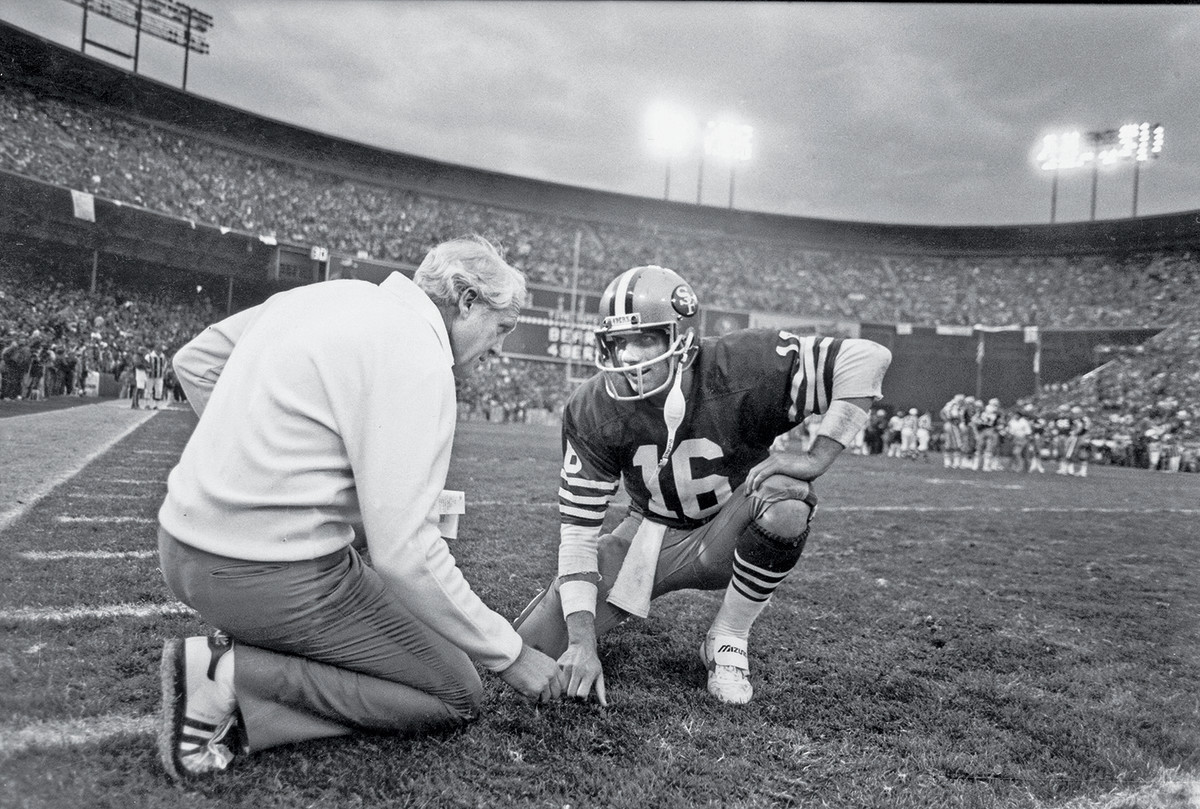
Bill Walsh
Dynastic 49ers coach who brought the West Coast offense to prominence
Bill Walsh’s groundbreaking West Coast offense remains en vogue to this day. More than half the NFL runs some variation of the scheme. But more important than the unique terminology, formations and route combinations it introduced is its broader concept: supplanting the running game with a short passing game. Walsh prioritized completed passes and drop-back efficiency, which helped bring the NFL to the pass-friendly methods that define it today.
Walsh’s approach, like any, would not have spread if it didn’t work so well. For him the idea was born out of necessity. Early in his time as a Cincinnati Bengals offensive assistant (1968-75), he discovered that quarterback Virgil Carter was not a strong downfield thrower. Walsh modified his vertical passing game, accommodating Carter with shorter throws. Carter’s completion percentage went up, and the new passing concepts took hold and expanded. In 1979 Walsh was named head coach of the 49ers, whom he directed to six division titles and three Super Bowl championships, with Joe Montana running the offense.
Not that it was Walsh’s system that did all the work. Those who were around him rave about his genius as a teacher. Things would seem brilliantly simple after he explained them. His book The Score Takes Care of Itself became popular, but his other tome, Finding the Winning Edge—in which Walsh broke down seemingly every possible detail of running a team—became a must-read in coaching circles. Because of a limited print run, you rarely find copies today priced under $250.
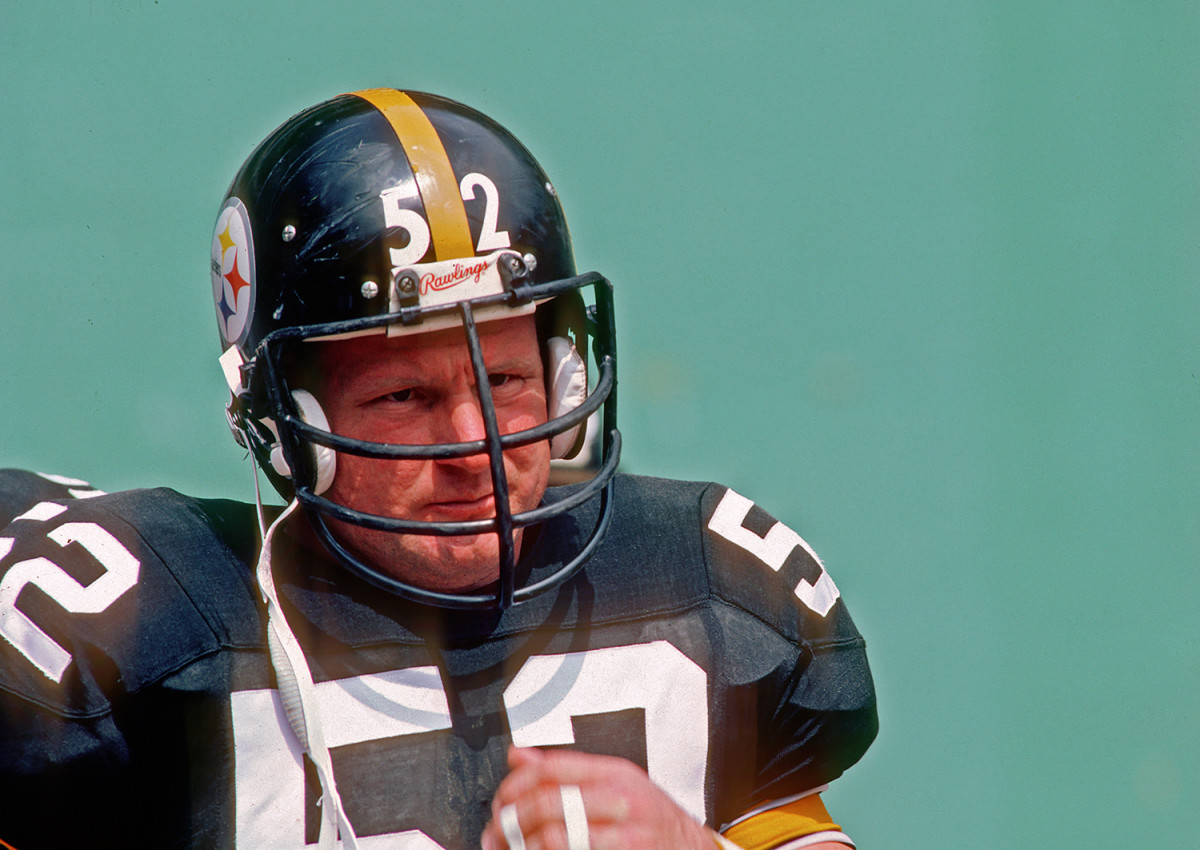
Mike Webster
First face of CTE and dementia in former players
To modern audiences he is the avatar for the devastating long-term effects of head trauma, but Mike Webster lived a full life in his 50 years.
At 6'1", 255, Webster was small by offensive line standards, even for the leaner NFL of the 1970s and ’80s. But the fifth-round pick out of Wisconsin lasted through 17 NFL seasons, 15 of them with the Steelers beginning in 1974. For much of his career he was simply the best center in the game, a four-time Super Bowl champion, five-time All-Pro and nine-time Pro Bowl selection. He was named to both 1970s and 1980s All-Decade Team.
However, it was his post-football life for which he will be best remembered. Almost immediately after his retirement, Webster’s life spiraled downward, as he endured a host of physical and cognitive ailments, including dementia, amnesia and depression, as well as serious financial difficulties from poor choices that his family members attributed to his inability to think straight. At times he lived in a pickup truck or rented hotel rooms, receiving and occasionally declining help from family, friends and former teammates. A 1997 Hall of Fame inductee, the man known as Iron Mike died of a heart attack in 2002, at age 50.
Webster’s brain was examined posthumously by Dr. Bennet Omalu, who found evidence of chronic traumatic encephalopathy, the first time the disease (until then primarily seen in boxers) was diagnosed in a former football player. Webster’s decline was chronicled in media reports at the time, but it was the depiction in the 2015 movie Concussion that brought it to a wider public and served as a devastating message for players, former and current, experiencing even the mildest form of the same symptoms. Finally, more than a decade after his death, the issues Webster endured began to be seriously confronted by the NFL, and American society as a whole.
In 2019 Ben Roethlisberger is set to break Webster’s mark for the most seasons played by a member of the Pittsburgh Steelers. While his longevity mark may be surpassed, the pain of Webster’s journey will have a lasting place in the story of football.
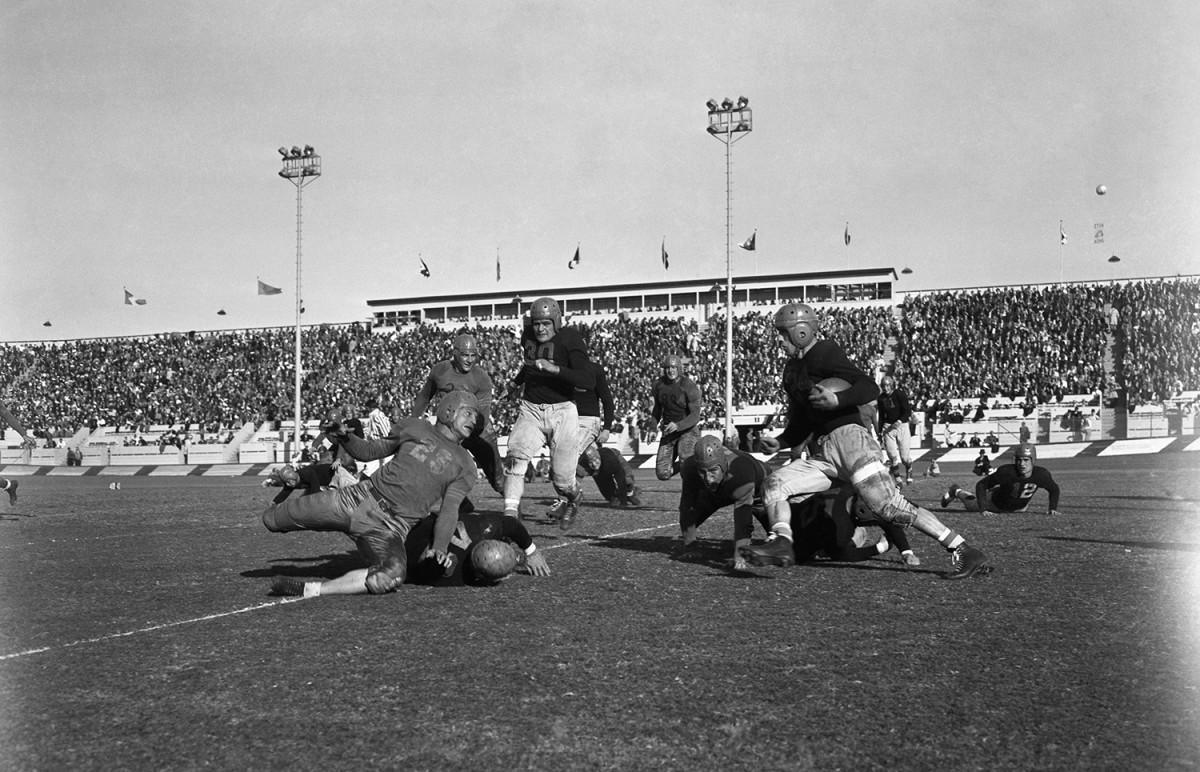
Byron “Whizzer” White
League-leading rusher who left for judicial career and spent 31 years as a U.S. Supreme Court justice
Imagine a world … in which Ezekiel Elliott leads the NFL in rushing in two of his first three seasons, then leaves football behind for a law career, and eventually ends up on the U.S. Supreme Court.
The story of Byron “Whizzer” White tells us a lot about the place of pro football in America in the late ’30s and early ’40s, and about one man’s very distinctive path to one of the preeminent positions in the country.
White, who in high school picked up the nickname that trailed him throughout his life, was an All-America running back at Colorado and the fourth pick of the 1938 NFL draft, by Pittsburgh. But he was also a Phi Beta Kappa student who’d been offered a Rhodes scholarship, and during the spring of his senior year he agonized over whether to take Art Rooney’s offer of $15,800, the highest salary ever for an NFL player, or travel to the U.K. to study law at Oxford. He chose the latter—then discovered he could postpone matriculation until January, allowing him to take the money and play football.
White led the league in rushing as a rookie with Pittsburgh in ’38 and was named All-Pro, then spent the spring term at Oxford, as something of a celebrity (he met the young John F. Kennedy at an embassy party). The outbreak of war in 1939 sent Rhodes scholars back to the U.S. White enrolled at Yale Law School that fall, but in 1940 Lions owner Fred Mandel Jr. tempted him back to the NFL with a two-year contract. White led the league in rushing again in 1940, then returned to Yale in the spring of ’41, and in the fall played for the Lions on the weekends while a full-time law student.
White enlisted in the Navy in December ’41 and served as an intelligence officer through the end of the war. Upon his return to the States, he put football behind him for good. He graduated from Yale Law top of his class, clerked for Chief Justice Fred M. Vinson, practiced law in Colorado, then joined the Kennedy administration as deputy attorney general, “a vital symbol of the New Frontier—fit, energetic and passionately committed to public service,” as his biographer wrote in 1993. Kennedy appointed him to the Supreme Court in 1962 at the age of 44, and he served the next 31 years as a brilliant, pragmatic and non-ideological jurist, and an imposing questioner during oral arguments. Throughout his life, he avoided the limelight, preferring to let his actions and court decisions speak for themselves. And he never did like the name Whizzer.
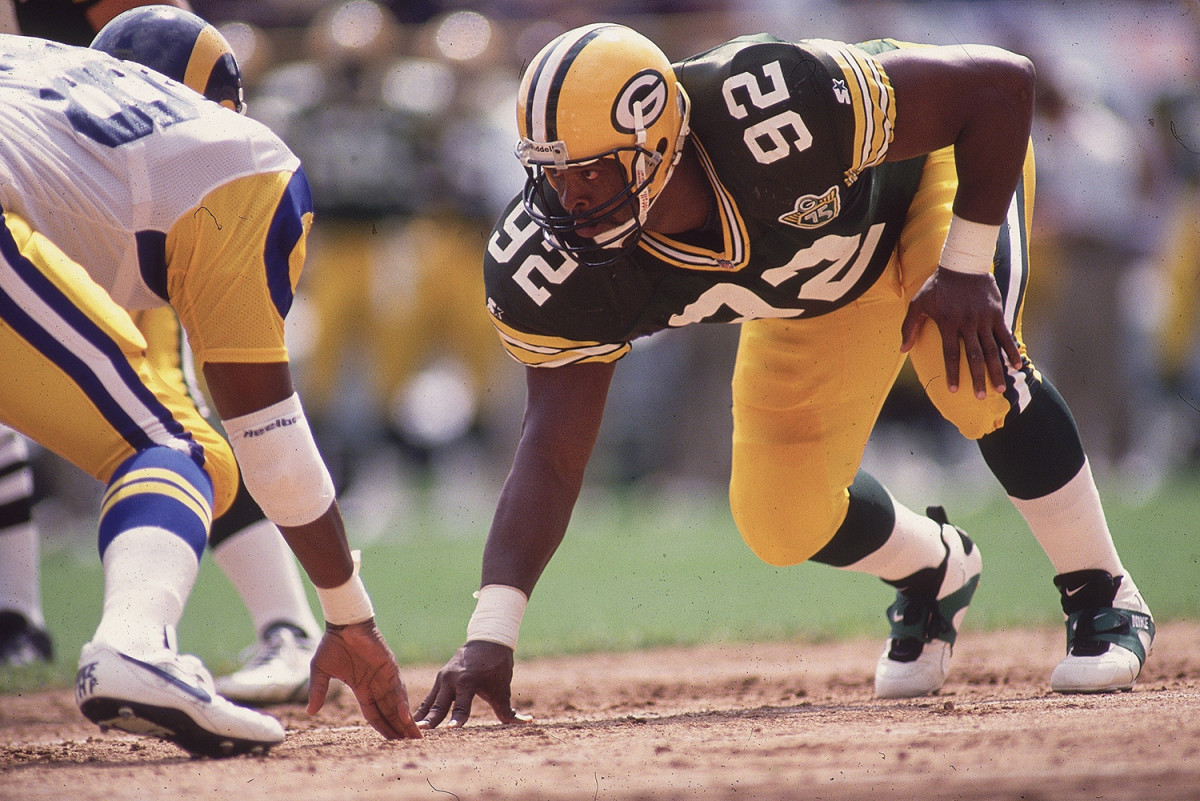
Reggie White
Hall of Fame defensive end and first major unrestricted free agent
Arguably the most accomplished pass-rusher in NFL history, Reggie White went to 13 Pro Bowls, earned eight First Team All-Pro nods, won the NFL Defensive Player of the Year award twice, and had his jersey number, 92, retired by two different teams. Yet it was in that transition from one team to the other where White made his biggest impact on NFL history.
White’s was the most prominent name on the 1992 lawsuit that compelled the NFL to accept unrestricted free agency, the culmination of years of contentious labor disputes between the owners and the players union. In that inaugural free-agent class of 1993, White—already a six-time All-Pro with the Eagles—was clearly the big prize. But he shocked the football world when he spurned powerhouse franchises and perennial winners in Washington and San Francisco for tiny Green Bay, undermining establishment voices who believed free agency would kill small-market teams and ultimately bring about the downfall of the NFL.
A Tennessee native who played in college for the Vols and began his pro career with the USFL’s Memphis Showboats, White made the sleepy Wisconsin town an attractive destination for free agents, especially African-American players from the Southeast who might otherwise have balked at moving to a city with a predominantly white population and sub-zero winter temps. His arrival with the storied franchise, combined with the emergence of quarterback Brett Favre, brought about a Packers resurgence. White died at the age of 43 in 2004 from cardiac arrhythmia that may have been linked to sleep apnea. He was posthumously inducted into the Hall of Fame in 2006.
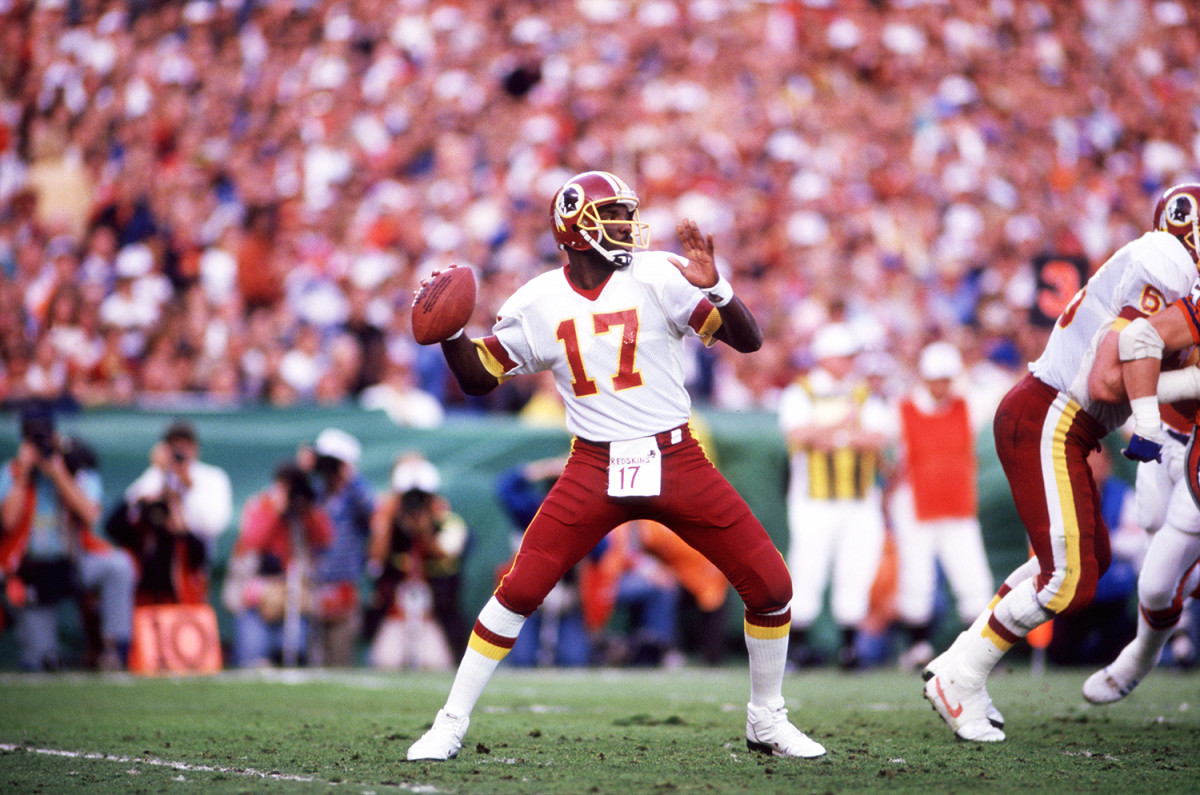
Doug Williams
First black quarterback to win the Super Bowl
A barrier-breaking football player, Doug Williams was the first black quarterback to be drafted No. 1 overall and play QB for his draft team, the first to start every game of a season, and the first to lead a team as the starting quarterback to a Super Bowl victory. “My whole life, whatever I was, I was ‘the first of… ’” Williams told SI in 1988. “It was destined. It was in the cards.”
Williams won Black College Player of the Year twice at Grambling State, and in his senior year he finished fourth in Heisman voting. Joe Gibbs, at the time the offensive coordinator for Tampa Bay, eyed Williams for the Bucs’ pick at No. 17 in the 1978 draft. A year later Williams went 10-6 as the starter and took the formerly woeful young franchise to its first NFC title game. After a contract dispute following the 1982 season—Williams was by far the lowest-paid starting QB in the league—he moved to the USFL before Gibbs, now the head coach Washington, called him in to be Jay Schroeder’s backup in 1986. The next season, after injuries and bad play from Schroeder, Williams got the starting job in the postseason and led Washington to Super Bowl XXII, against John Elway’s Broncos.
After Denver jumped ahead 10-0, Williams torched the Broncos for four touchdowns in the second quarter on the way to a 42-10 victory in which he was named Super Bowl MVP. But injuries and racism after the victory essentially ended his career. Williams never made it back to the playoffs, and he retired following the 1989 season, at age 34. “There weren’t a lot of phone calls about endorsements,” he told SI in 2008. “Eventually I just let it go, because there are so many people who would deny the obvious reasons.”
He went back to Grambling State, where he followed legendary coach Eddie Robinson and won three consecutive conference titles and one national championship. Since 2014 he’s been in Washington’s front office, serving as senior VP of player personnel since 2017.
Williams wasn’t the NFL’s first black quarterback, but his Super Bowl victory proved—to those who needed it proven to—that black quarterbacks can succeed in the NFL.
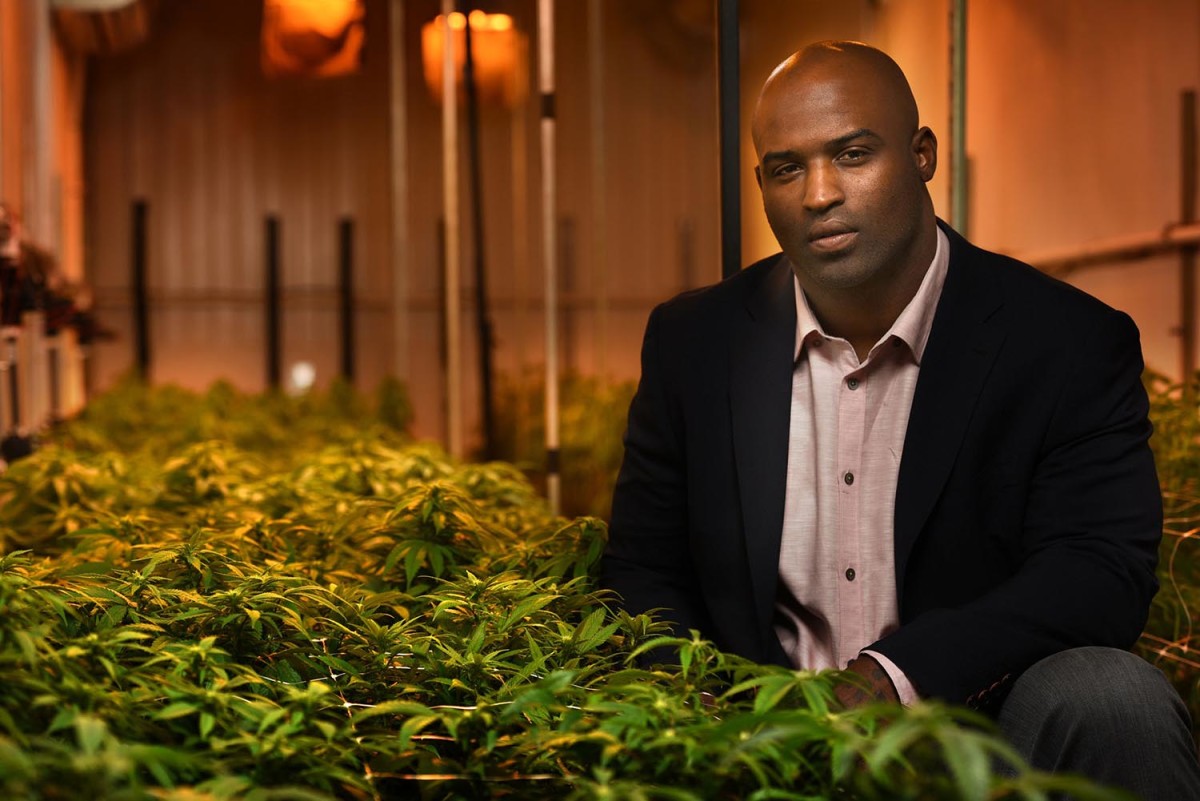
Ricky Williams
Enigmatic running back who brought mental health issues and marijuana use into the open
Ricky Williams had five 1,000-yard rushing seasons in the NFL and led the league in 2002 with 1,843 yards, but he is perhaps better known for his personal journey from an introverted first-round pick who kept his helmet on during media interviews to an advocate for mental health and the positive affects of marijuana for athletes and others.
Williams entered the 1999 draft as the NCAA career rushing leader and first Texas Longhorn to win the Heisman Trophy since Earl Campbell. But he polarized scouts. His withdrawn nature made some question his passion, and his hiring of Master P as his agent raised eyebrows. One who wasn’t dissuaded was Saints coach Mike Ditka; he saw Williams as another Walter Payton and traded his entire draft, plus the following year’s first- and third-round picks, to Washington to move up from 12 to 5 for Williams. The move was a disaster—the rookie struggled with injuries, alienated fans and the media and said he felt “like an outcast” in New Orleans in a 2000 SI story. Ditka and his GM were fired in a house-cleaning after that season.
Williams reached 1,000 rushing yards each of the next four years, but he repeatedly ran afoul of the league’s drug policy—retiring for a year in 2004 rather than submitting to a suspension and fine (he studied Ayurveda), missing all of 2006 with the Dolphins after another failed test (he played for Toronto in the CFL) and playing just one game in 2007 (he was injured in his first appearance after being reinstated). He retired for good in 2011 with 10,009 rushing yards, 31st all-time.
One of the great non-conformists in American sports history, Williams challenged narratives about the kind of person a star athlete should be. He traveled and studied, soul-searched, and didn’t conceal his disdain for the norms of stardom. He said he was diagnosed with borderline personality disorder and avoidance disorder during his NFL career, using marijuana as an alternative to the ubiquitous and addictive painkillers doled out like candy in NFL locker rooms. Since his retirement, he has emerged as medical marijuana’s most prominent and influential backer among athletes. “In my search for the truth, I’ve learned to be comfortable with myself in a way that I don’t have to apologize for,” Williams told SI’s Greg Bishop in 2016. “The legacy I want to leave is one that's true to who I was. Not an image I portrayed of what I should have been.”
![winkreading[1].JPG](https://www.si.com/.image/t_share/MTY4MDA3NDMyOTQyNzg5OTA1/winkreading1jpg.jpg)
Wilfred Winkenbach
Credited with inventing fantasy football
You may not know Wilfred Winkenbach’s name, but you definitely know his greatest contribution to the game of football. He is credited with inventing fantasy football, way back in 1962, a full 17 years before the more famous Dan Okrent and his buddies invented Rotisserie baseball.
Wilfred Winkenbach is the reason you have stayed up past your bedtime on Monday night to see if a defense forces a meaningless turnover. He is the reason casual football fans have heard of more than eight tight ends. He has indirectly spawned countless websites, apps and TV shows—an entire industry worth of careers adjacent to the NFL’s already colossal business. It’s hard to say just how big the industry is, but one Forbes headline from 2013 threw around the number $70 billion. (Other estimates are more modest.)
The Greater Oakland Professional Pigskin Prognosticators League, which is still up and running under the original rules, only awards points for touchdowns, field goals and extra points. Now we have half-point PPRs, superflex, daily fantasy, even punters only. Winkenbach’s original golden idea has been taken to numerous extremes, but the initial conceit—drafting players to your own team and earning points for their on-field performance—remains at the heart of the fantasy game. For many people, fantasy has been a pathway from nascent interest in football to outright fandom. Even for many hardcore football fans, it’s become a primary reason to follow the league.
Even if you’re one of the get-off-my-lawn types who still decries fantasy football for eroding single-team fandom or prioritizing statistics over wins, it’s impossible to deny that fantasy has contributed to the explosion of the NFL’s popularity. Discussion of fantasy dominates everything from pregame shows to postgame highlights to the bottom-line ticker.
You simply can’t imagine following the NFL in 2019 without mention of fantasy football. And the original idea came from the mind of Winkenbach, a man in his own way as influential to how fans experience the game as Rozelle, Arledge or Berman.
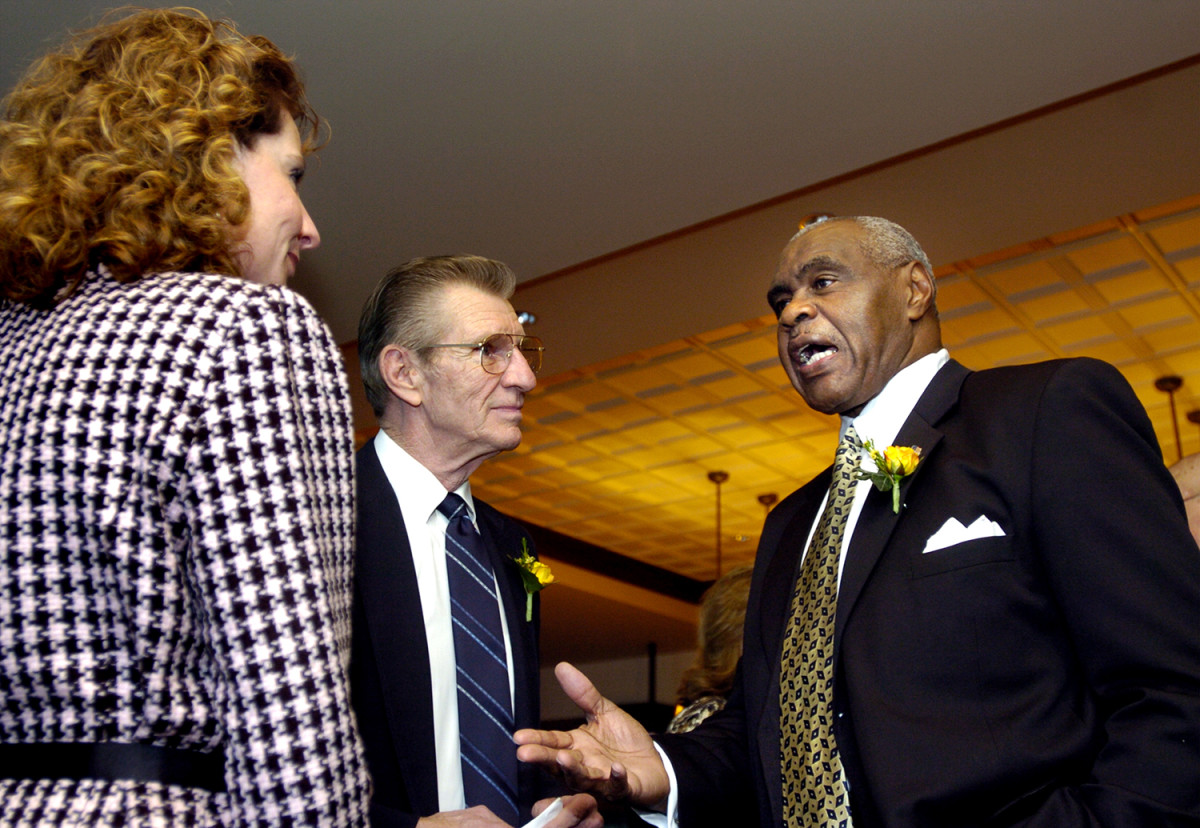
John Wooten
Longtime head of the Fritz Pollard Alliance, promoting diversity in coaching/front offices
While impressive, John Wooten’s playing career is not what makes him one of pro football’s most influential figures. From 1959 to ’67, he served as a guard for the Cleveland Browns and helped pave the way for Jim Brown to enjoy his legendary success. Wooten made two Pro Bowls and one All-Pro team. But his impact on the game extends far beyond the field.
Wooten has long been an activist for black rights and equality in sports, taking part in the “Ali Summit” in 1967 and continuing his advocacy through today. After his playing days he served as a sports agent before joining three different NFL teams as a lead scout or executive. Then in 2003 Wooten was named chairman of the newly formed Fritz Pollard Alliance, a position where his impact has been greatest.
At the time—and still—the league was facing a minority-hiring crisis as it related to head coaches and general managers. Wooten oversaw the Alliance for more than 15 years before his retirement this April. When the FPA was established, Tony Dungy and Herm Edwards were the lone minority coaches (Marvin Harris had been hired but had yet to coach in the league). Through his advocacy, Wooten helped push the NFL to expand its hiring practices while also serving as ostensible watchdog. His utility, though, was not limited to enforcement. Black coaches and executives across the league have used Wooten as a sounding board over the decades. The connections Wooten has facilitated for minority coaches may never be fully appreciated.
Question or comment? Email us at talkback@themmqb.com.
